1. Refer to the exhibit. What will Router1 do when it receives the data frame shown? (Choose three.)

A. Router1 will strip off the source MAC address and replace it with the MAC address 0000.0c36.6965.
B. Router1 will strip off the source IP address and replace it with the IP address 192.168.40.1.
C. Router1 will strip off the destination MAC address and replace it with the MAC address 0000.0c07.4320.
D. Router1 will strip off the destination IP address and replace it with the IP address of 192.168.40.1.
E. Router1 will forward the data packet out interface FastEthernet0/1.
F. Router1 will forward the data packet out interface FastEthernet0/2.Distance Vector use hop count, not link state
Answer: ACF
Explanation:
Remember, the source and destination MAC changes as each router hop along with the TTL being decremented but the source and destination IP address remain the same from source to destination.
2. Refer to the exhibit. Which three statements correctly describe Network Device A? (Choose three.

A. With a network wide mask of 255.255.255.128, each interface does not require an IP address.
B. With a network wide mask of 255.255.255.128, each interface does require an IP address on a unique IP subnet.
C. With a network wide mask of 255.255.255.0, must be a Layer 2 device for the PCs to communicate with each other.
D. With a network wide mask of 255.255.255.0, must be a Layer 3 device for the PCs to communicate with each other.
E. With a network wide mask of 255.255.254.0, each interface does not require an IP address.
Answer: BDE
Explanation:
If Subnet Mask is 255.255.255.128 the hosts vary from x.x.x.0 – x.x.x.127 & x.x.x.128-x.x.x.255,so the IP Addresses of 2 hosts fall in different subnets so each interface needs an IP an address so that they can communicate each other.
If Subnet Mask is 255.255.255.0 the 2 specified hosts fall in different subnets so they need a Layer 3 device to communicate.
If Subnet Mask is 255.255.254.0 the 2 specified hosts are in same subnet so are in network address and can be accommodated in same Layer 2 domain and can communicate with each other directly using the Layer 2 address.
3. Which layer in the OSI reference model is responsible for determining the availability of the receiving program and checking to see if enough resources exist for that communication?
A. transport
B. network
C. presentation
D. session
E. application
Answer: E
Explanation:
This question is to examine the OSI reference model. The Application layer is responsible for identifying and establishing the availability of the intended communication partner and determining whether sufficient resources for the intended communication exist.
4. Refer to the exhibit. Host A pings interface S0/0 on router 3. What is the TTL value for that ping?

A. 252
B. 253
C. 254
D. 255
Answer: B
Explanation:
From the CCNA ICND2 Exam book: “Routers decrement the TTL by 1 every time they forward a packet; if a router decrements the TTL to 0, it throws away the packet. This prevents packets from rotating forever.” I want to make it clear that before the router forwards a packet, the TTL is still remain the same. For example in the topology above, pings to S0/1 and S0/0 of Router 2 have the same TTL.
5. Which of the following describes the roles of devices in a WAN? (Choose three.)
A. A CSU/DSU terminates a digital local loop.
B. A modem terminates a digital local loop.
C. A CSU/DSU terminates an analog local loop.
D. A modem terminates an analog local loop.
E. A router is commonly considered a DTE device.
F. A router is commonly considered a DCE device.
Answer: ADE
Explanation:
The idea behind a WAN is to be able to connect two DTE networks together through a DCE network. The network’s DCE device (includes CSU/DSU) provides clocking to the DTE-connected interface (the router’s serial interface).

A modem modulates outgoing digital signals from a computer or other digital device to analog signals for a conventional copper twisted pair telephone line and demodulates the incoming analog signal and converts it to a digital signal for the digital device. A CSU/DSU is used between two digital lines – For more explanation of answer D, in telephony the local loop (also referred to as a subscriber line) is the physical link or circuit that connects from the demarcation point of the customer premises to the edge of the carrier or telecommunications service provider’s network. Therefore a modem terminates an analog local loop is correct.

6. Refer to the exhibit. Refer to the exhibit. After HostA pings HostB, which entry will be in the ARP cache of HostA to support this transmission?

A. 
B. 
C. 
D. 
E. 
F. 
Answer: A
Explanation:
When a host needs to reach a device on another subnet, the ARP cache entry will be that of the Ethernet address of the local router (default gateway) for the physical MAC address. The destination IP address will not change, and will be that of the remote host (HostB)
7. A network administrator is verifying the configuration of a newly installed host by establishing an FTP connection to a remote server. What is the highest layer of the protocol stack that the network administrator is using for this operation?
A. application
B. presentation
C. session
D. transport
E. internet
F. data link
Answer: A
Explanation:
FTP belongs to Application layer and it is also the highest layer of the OSI model
8. A network interface port has collision detection and carrier sensing enabled on a shared twisted pair network. From this statement, what is known about the network interface port?
A. This is a 10 Mb/s switch port.
B. This is a 100 Mb/s switch port.
C. This is an Ethernet port operating at half duplex.
D. This is an Ethernet port operating at full duplex.
E. This is a port on a network interface card in a PC.
Answer: C
Explanation:
Modern Ethernet networks built with switches and full-duplex connections no longer utilize CSMA/CD. CSMA/CD is only used in obsolete shared media Ethernet (which uses repeater or hub).
9. A receiving host computes the checksum on a frame and determines that the frame is damaged. The frame is then discarded. At which OSI layer did this happen?
A. session
B. transport
C. network
D. data link
E. physical
Answer: D
Explanation:
The Data Link layer provides the physical transmission of the data and handles error notification, network topology, and flow control. The Data Link layer formats the message into pieces, each called a data frame, and adds a customized header containing the hardware destination and source address. Protocols Data Unit (PDU) on Datalink layer is called frame. According to this question the frame is damaged and discarded which will happen at the Data Link layer.
10. Which of the following correctly describe steps in the OSI data encapsulation process? (Choose two.)
A. The transport layer divides a data stream into segments and may add reliability and flow control information.
B. The data link layer adds physical source and destination addresses and an FCS to the segment.
C. Packets are created when the network layer encapsulates a frame with source and destination host addresses and protocol-related control information.
D. Packets are created when the network layer adds Layer 3 addresses and control information to a segment.
E. The presentation layer translates bits into voltages for transmission across the physical link.
Answer: AD
Explanation:
The Application Layer (Layer 7) refers to communications services to applications and is the interface between the network and the application. Examples include. Telnet, HTTP, FTP, Internet browsers, NFS, SMTP gateways, SNMP, X.400 mail, and FTAM.
The Presentation Layer (Layer 6) defining data formats, such as ASCII text, EBCDIC text, binary, BCD, and JPEG. Encryption also is defined as a presentation layer service. Examples include. JPEG, ASCII, EBCDIC, TIFF, GIF, PICT, encryption, MPEG, and MIDI.
The Session Layer (Layer 5) defines how to start, control, and end communication sessions. This includes the control and management of multiple bidirectional messages so that the application can be notified if only some of a series of messages are completed. This allows the presentation layer to have a seamless view of an incoming stream of data. The presentation layer can be presented with data if all flows occur in some cases. Examples include. RPC, SQL, NFS, NetBios names, AppleTalk ASP, and DECnet SCP The Transport Layer (Layer 4) defines several functions, including the choice of protocols. The most important Layer 4 functions are error recovery and flow control. The transport layer may provide for retransmission, i.e., error recovery, and may use flow control to prevent unnecessary congestion by attempting to send data at a rate that the network can accommodate, or it might not, depending on the choice of protocols. Multiplexing of incoming data for different flows to applications on the same host is also performed. Reordering of the incoming data stream when packets arrive out of order is included. Examples include. TCP, UDP, and SPX.
The Network Layer (Layer 3) defines end-to-end delivery of packets and defines logical addressing to accomplish this. It also defines how routing works and how routes are learned; and how to fragment a packet into smaller packets to accommodate media with smaller maximum transmission unit sizes. Examples include. IP, IPX, AppleTalk DDP, and ICMP. Both IP and IPX define logical addressing, routing, the learning of routing information, and end-to-end delivery rules. The IP and IPX protocols most closely match the OSI network layer (Layer 3) and are called Layer 3 protocols because their functions most closely match OSI’s Layer 3. The Data Link Layer (Layer 2) is concerned with getting data across one particular link or medium.
The data link protocols define delivery across an individual link. These protocols are necessarily concerned with the type of media in use. Examples includE. IEEE 802.3/802.2, HDLC, Frame Relay, PPP, FDDI, ATM, and IEEE 802.5/802.2.
11. Refer to the graphic. Host A is communicating with the server. What will be the source MAC address of the frames received by Host A from the server?

A. the MAC address of router interface e0
B. the MAC address of router interface e1
C. the MAC address of the server network interface
D. the MAC address of host A
Answer: A
Explanation:
Whereas switches can only examine and forward packets based on the contents of the MAC header, routers can look further into the packet to discover the network for which a packet is destined. Routers make forwarding decisions based on the packet’s network-layer header (such as an IPX header or IP header). These network-layer headers contain source and destination network addresses. Local devices address packets to the router’s MAC address in the MAC header. After receiving the packets, the router must perform the following steps:
1. Check the incoming packet for corruption, and remove the MAC header . The router checks the packet for MAC-layer errors. The router then strips off the MAC header and examines the network- layer header to determine what to do with the packet.
2. Examine the age of the packet. The router must ensure that the packet has not come too far to be forwarded. For example, IPX headers contain a hop count. By default, 15 hops is the maximum number of hops (or routers) that a packet can cross. If a packet has a hop count of 15, the router discards the packet. IP headers contain a Time to Live (TTL) value. Unlike the IPX hop count, which increments as the packet is forwarded through each router, the IP TTL value decrements as the IP packet is forwarded through each router. If an IP packet has a TTL value of 1, the router discards the packet. A router cannot decrement the TTL value to 1 and then forward the packet.
3. Determine the route to the destination. Routers maintain a routing table that lists available networks, the direction to the desired network (the outgoing interface number), and the distance to those networks. After determining which direction to forward the packet, the router must build a new header. (If you want to read the IP routing tables on a Windows 95/98 workstation, type ROUTE PRINT in the DOS box.)
4. Build the new MAC header and forward the packet. Finally, the router builds a new MAC header for the packet. The MAC header includes the router’s MAC address and the final destination’s MAC address or the MAC address of the next router in the path.
12. Refer to the exhibit. What two results would occur if the hub were to be replaced with a switch that is configured with one Ethernet VLAN? (Choose two.)

A. The number of collision domains would remain the same.
B. The number of collision domains would decrease.
C. The number of collision domains would increase.
D. The number of broadcast domains would remain the same.
E. The number of broadcast domains would decrease.
F. The number of broadcast domains would increase.
Answer: CD
Explanation:
Basically, a collision domain is a network segment that allows normal network traffic to flow back and forth. In the old days of hubs, this meant you had a lot of collisions, and the old CSMA/CD would be working overtime to try to get those packets re-sent every time there was a collision on the wire (since ethernet allows only one host to be transmitting at once without there being a traffic jam). With switches, you break up collision domains by switching packets bound for other collision domains. These days, since we mostly use switches to connect computers to the network, you generally have one collision domain to a PC.
Broadcast domains are exactly what they imply: they are network segments that allow broadcasts to be sent across them. Since switches and bridges allow for broadcast traffic to go unswitched, broadcasts can traverse collision domains freely. Routers, however, don’t allow broadcasts through by default, so when a broadcast hits a router (or the perimeter of a VLAN), it doesn’t get forwarded. The simple way to look at it is this way: switches break up collision domains, while routers (and VLANs) break up collision domains and broadcast domains. Also, a broadcast domain can contain multiple collision domains, but a collision domain can never have more than one broadcast domain associated with it.
Collision Domain: A group of Ethernet or Fast Ethernet devices in a CSMA/CD LAN that are connected by repeaters and compete for access on the network. Only one device in the collision domain may transmit at any one time, and the other devices in the domain listen to the network in order to avoid data collisions. A collision domain is sometimes referred to as an Ethernet segment.
Broadcast Domain: Broadcasting sends a message to everyone on the local network (subnet). An example for Broadcasting would be DHCP Request from a Client PC. The Client is asking for a IP Address, but the client does not know how to reach the DHCP Server. So the client sends a DHCP Discover packet to EVERY PC in the local subnet (Broadcast). But only the DHCP Server will answer to the Request.
How to count them?
Broadcast Domain:
No matter how many hosts or devices are connected together, if they are connected with a repeater, hub, switch or bridge, all these devices are in ONE Broadcast domain (assuming a single VLAN). A Router is used to separate Broadcast-Domains (we could also call them Subnets – or call them VLANs).
So, if a router stands between all these devices, we have TWO broadcast domains.
Collision Domain:
Each connection from a single PC to a Layer 2 switch is ONE Collision domain. For example, if 5 PCs are connected with separate cables to a switch, we have 5 Collision domains. If this switch is connected to another switch or a router, we have one collision domain more. If 5 Devices are connected to a Hub, this is ONE Collision Domain. Each device that is connected to a Layer 1 device (repeater, hub) will reside in ONE single collision domain.
13. Which three statements accurately describe Layer 2 Ethernet switches? (Choose three.)
A. Spanning Tree Protocol allows switches to automatically share VLAN information.
B. Establishing VLANs increases the number of broadcast domains.
C. Switches that are configured with VLANs make forwarding decisions based on both Layer 2 and Layer 3 address information.
D. Microsegmentation decreases the number of collisions on the network.
E. In a properly functioning network with redundant switched paths, each switched segment will contain one root bridge with all its ports in the forwarding state. All other switches in that broadcast domain will have only one root port. F. If a switch receives a frame for an unknown destination, it uses ARP to resolve the address.
Answer: BDE
Explanation:
Microsegmentation is a network design (functionality) where each workstation or device on a network gets its own dedicated segment (collision domain) to the switch. Each network device gets the full bandwidth of the segment and does not have to share the segment with other devices. Microsegmentation reduces and can even eliminate collisions because each segment is its own collision domain -> .
Note: Microsegmentation decreases the number of collisions but it increases the number of collision domains.
14. Where does routing occur within the DoD TCP/IP reference model?
A. application
B. internet
C. network
D. transport
Answer: B
Explanation:
The picture below shows the comparison between TCP/IP model & OSI model. Notice that the Internet Layer of TCP/IP is equivalent to the Network Layer which is responsible for routing decision.

15. Refer to exhibit: Which destination addresses will be used by Host A to send data to Host C? (Choose two.)

A. the IP address of Switch 1
B. the MAC address of Switch 1
C. the IP address of Host C
D. the MAC address of Host C
E. the IP address of the router’s E0 interface
F. the MAC address of the router’s E0 interface
Answer: CF
Explanation:
While transferring data through many different networks, the source and destination IP addresses are not changed. Only the source and destination MAC addresses are changed. So in this case Host A will use the IP address of Host C and the MAC address of E0 interface to send data. When the router receives this data, it replaces the source MAC address with it own E1 interface’s MAC address and replaces the destination MAC address with Host C’s MAC address before sending to Host C .
16. For what two purposes does the Ethernet protocol use physical addresses? (Choose two.)
A. to uniquely identify devices at Layer 2
B. to allow communication with devices on a different network
C. to differentiate a Layer 2 frame from a Layer 3 packet
D. to establish a priority system to determine which device gets to transmit first
E. to allow communication between different devices on the same network
F. to allow detection of a remote device when its physical address is unknown
Answer: AE
Explanation:
Physical addresses or MAC addresses are used to identify devices at layer 2. MAC addresses are only used to communicate on the same network. To communicate on different network we have to use Layer 3 addresses (IP addresses) -> B is not correct.
Layer 2 frame and Layer 3 packet can be recognized via headers. Layer 3 packet also contains physical address -> On Ethernet, each frame has the same priority to transmit by default -> All devices need a physical address to identify itself. If not, they can not communicate ->
17. Refer to the exhibit. Based on the information given, which switch will be elected root bridge and why?

A. Switch A, because it has the lowest MAC address
B. Switch A, because it is the most centrally located switch
C. Switch B, because it has the highest MAC address
D. Switch C, because it is the most centrally located switch
E. Switch C, because it has the lowest priority
F. Switch D, because it has the highest priority
Answer: E
Explanation:
To elect the root bridge in the LAN, first check the priority value. The switch having the lowest priority will win the election process. If Priority Value is the same then it checks the MAC Address; the switch having the lowest MAC Address will become the root bridge. In this case, switch C has the lowest MAC Address so it becomes the root bridge.
18. Refer to the exhibit. Switch-1 needs to send data to a host with a MAC address of 00b0.d056.efa4. What will Switch-1 do with this data?

A. Switch-1 will drop the data because it does not have an entry for that MAC address.
B. Switch-1 will flood the data out all of its ports except the port from which the data originated.
C. Switch-1 will send an ARP request out all its ports except the port from which the data originated.
D. Switch-1 will forward the data to its default gateway.
Answer: B
Explanation:
This question tests the operating principles of the Layer 2 switch. Check the MAC address table of Switch1 and find that the MAC address of the host does not exist in the table. Switch1 will flood the data out all of its ports except the port from which the data originated to determine which port the host is located in.
Switches work as follows:
In output there is no MAC address of give host so switch floods to all ports except the source port.
19. What value is primarily used to determine which port becomes the root port on each nonroot switch in a spanning-tree topology?
A. path cost
B. lowest port MAC address
C. VTP revision number
D. highest port priority number
E. port priority number and MAC address
Answer: A
Explanation:
The path cost to the root bridge is the most important value to determine which port will become the root port on each non-root switch. In particular, the port with lowest cost to the root bridge will become root port (on non-root switch).
20. What is the function of the command switchport trunk native vlan 999 on a Cisco Catalyst switch?
A. It creates a VLAN 999 interface.
B. It designates VLAN 999 for untagged traffic.
C. It blocks VLAN 999 traffic from passing on the trunk.
D. It designates VLAN 999 as the default for all unknown tagged traffic.
Answer: B
Explanation:
Configuring the Native VLAN for Untagged Traffic A trunk port configured with 802.1Q tagging can receive both tagged and untagged traffic. By default, the switch forwards untagged traffic in the native VLAN configured for the port. The native VLAN is VLAN 1 by default.
21. Which two protocols are used by bridges and/or switches to prevent loops in a layer 2 network? (Choose two.)
A. 802.1d
B. VTP
C. 802.1q
D. STP
E. SAP
Answer: AD
Explanation:
This question is to examine the STP protocol.
STP (802.1d) is used to prevent Layer 2 loops.
802.1q is a Frame Relay protocol which belongs to VLAN.
SAP is a concept of the OSI model.
22. Which switch would STP choose to become the root bridge in the selection process?
A. 32768: 11-22-33-44-55-66
B. 32768: 22-33-44-55-66-77
C. 32769: 11-22-33-44-55-65
D. 32769: 22-33-44-55-66-78
Answer: A
23. A switch is configured with all ports assigned to vlan 2 with full duplex FastEthernet to segment existing departmental traffic. What is the effect of adding switch ports to a new VLAN on the switch?
A. More collision domains will be created.
B. IP address utilization will be more efficient.
C. More bandwidth will be required than was needed previously.
D. An additional broadcast domain will be created.
Answer: D
Explanation:
Each VLAN creates its own broadcast domain. Since this is a full duplex switch, each port is a separate collision domain.
24. What are three benefits of implementing VLANs? (Choose three.)
A. A higher level of network security can be reached by separating sensitive data traffic from other network traffic.
B. A more efficient use of bandwidth can be achieved allowing many physical groups to use the same network infrastructure.
C. A more efficient use of bandwidth can be achieved allowing many logical networks to use the same network infrastructure.
D. Broadcast storms can be mitigated by increasing the number of broadcast domains, thus reducing their size.
E. Broadcast storms can be mitigated by decreasing the number of broadcast domains, thus increasing their size.
F. VLANs make it easier for IT staff to configure new logical groups, because the VLANs all belong to the same broadcast domain.
G. Port-based VLANs increase switch-port use efficiency, thanks to 802.1Q trunks.
Answer: ACD
Explanation:
Benefits of VLANs
VLAN is a network structure which allows users to communicate while in different locations by sharing one multicast domain and a single broadcast. They provide numerous networking benefits and have become popular in the market. For instance, it helps reduce administrative costs when users are geographically dispersed.
1. Inexpensive
The popularity of VLANs is due to the fact that changes, adds, and moves can be attained simply by making necessary configurations on the VLAN port. Time-consuming, re-addressing, and host reconfigurations is now a thing of the past, because network configuration can be made at ease when need arises.
2. Better management
A VLAN typically solve the scalability issues that exist in a large network by breaking the main domain into several VLAN groups or smaller broadcast configurations, thereby encourage better control of multicast traffic as well as broadcast domains.
3. Improves network security
High-security can be positioned in different VLAN groups to ensure that non-members cannot receive their broadcasts. On the other hand, a router is added and workgroups relocated into centralized locations.
4. Enhances performance
A more efficient use of bandwidth can be achieved allowing many logical networks to use the same network infrastructure.
5. Segment multiple networks
VLANs are typically used to achieve multiple purposes. They are popularly used to reduce broadcast traffic. Each VLAN creates a separate, smaller broadcast domain.
6. Better administration
VLANs facilitate grouping of multiple geographical stations. When VLAN users move to another physical location, the network does not have to be configured.
25. Which IEEE standard protocol is initiated as a result of successful DTP completion in a switch over Fast Ethernet?
A. 802.3ad
B. 802.1w
C. 802.1D
D. 802.1Q
Answer: D
Explanation:
Dynamic Trunking Protocol (DTP) is a Cisco proprietary protocol for negotiating trunking on a link between two devices and for negotiating the type of trunking encapsulation (802.1Q) to be used.
26. Which of the following are benefits of VLANs? (Choose three.)
A. They increase the size of collision domains.
B. They allow logical grouping of users by function.
C. They can enhance network security.
D. They increase the size of broadcast domains while decreasing the number of collision domains.
E. They increase the number of broadcast domains while decreasing the size of the broadcast domains.
F. They simplify switch administration.
Answer: BCE
Explanation:
When using VLAN the number and size of collision domains remain the same -> VLANs allow to group users by function, not by location or geography -> . VLANs help minimize the incorrect configuration of VLANs so it enhances the security of the network -> . VLAN increases the size of broadcast domains but does not decrease the number of collision domains -> VLANs increase the number of broadcast domains while decreasing the size of the broadcast domains which increase the utilization of the links. It is also a big advantage of VLAN -> . VLANs are useful but they are more complex and need more administration ->
27. Refer to the exhibit. A technician has installed SwitchB and needs to configure it for remote access from the management workstation connected to SwitchA . Which set of commands is required to accomplish this task?

A. SwitchB(config)# interface FastEthernet 0/1
SwitchB(config-if)# ip address 192.168.8.252 255.255.255.0
SwitchB(config-if)# no shutdown
B. SwitchB(config)# interface vlan 1
SwitchB(config-if)# ip address 192.168.8.252 255.255.255.0
SwitchB(config-if)# ip default-gateway 192.168.8.254 255.255.255.0
SwitchB(config-if)# no shutdown
C. SwitchB(config)# ip default-gateway 192.168.8.254
SwitchB(config)# interface vlan 1
SwitchB(config-if)# ip address 192.168.8.252 255.255.255.0
SwitchB(config-if)# no shutdown
D. SwitchB(config)# ip default-network 192.168.8.254
SwitchB(config)# interface vlan 1
SwitchB(config-if)# ip address 192.168.8.252 255.255.255.0
SwitchB(config-if)# no shutdown
E. SwitchB(config)# ip route 192.168.8.254 255.255.255.0
SwitchB(config)# interface FastEthernet 0/1
SwitchB(config-if)# ip address 192.168.8.252 255.255.255.0
SwitchB(config-if)# no shutdown
Answer: C
Explanation:
To remote access to SwitchB, it must have a management IP address on a VLAN on that switch. Traditionally, we often use VLAN 1 as the management VLAN (but in fact it is not secure). In the exhibit, we can recognize that the Management Workstation is in a different subnet from the SwitchB. For intersubnetwork communication to occur, you must configure at least one default gateway. This default gateway is used to forward traffic originating from the switch only, not to forward traffic sent by devices connected to the switch.
28. In an Ethernet network, under what two scenarios can devices transmit? (Choose two.)
A. when they receive a special token
B. when there is a carrier
C. when they detect no other devices are sending
D. when the medium is idle
E. when the server grants access
Answer: CD
Explanation:
Ethernet network is a shared environment so all devices have the right to access to the medium. If more than one device transmits simultaneously, the signals collide and can not reach the destination. If a device detects another device is sending, it will wait for a specified amount of time before attempting to transmit. When there is no traffic detected, a device will transmit its message. While this transmission is occurring, the device continues to listen for traffic or collisions on the LAN. After the message is sent, the device returns to its default listening mode.
29. Which two states are the port states when RSTP has converged? (Choose two.)
A. discarding
B. listening
C. learning
D. forwarding
E. disabled
Answer: AD
Explanation:
http://www.cisco.com/en/US/tech/tk389/tk621/technologies_white_paper09186a0080094cfa.shtml #states
30. Which two commands can be used to verify a trunk link configuration status on a given Cisco switch interface? (Choose two.)
A. show interface trunk
B. show interface interface
C. show ip interface brief
D. show interface vlan
E. show interface switchport
Answer: AE
31. Which of the following statements describe the network shown in the graphic? (Choose two.)

A. There are two broadcast domains in the network.
B. There are four broadcast domains in the network.
C. There are six broadcast domains in the network.
D. There are four collision domains in the network.
E. There are five collision domains in the network.
F. There are seven collision domains in the network.
Answer: AF
Explanation:
Only router can break up broadcast domains so in the exhibit there are 2 broadcast domains: from e0 interface to the left is a broadcast domain and from e1 interface to the right is another
broadcast domain ->.
Both router and switch can break up collision domains so there is only 1 collision domain on the left of the router (because hub doesn’t break up collision domain) and there are 6 collision domains on the right of the router (1 collision domain from e1 interface to the switch + 5 collision domains for 5 PCs in Production) ->
32. Which command enables RSTP on a switch?
A. spanning-tree uplinkfast
B. spanning-tree mode rapid-pvst
C. spanning-tree backbonefast
D. spanning-tree mode mst
Answer: B
Explanation:
Ethernet network is a shared environment so all devices have the right to access to the medium. If more than one device transmits simultaneously, the signals collide and can not reach the destination. If a device detects another device is sending, it will wait for a specified amount of time before attempting to transmit.
When there is no traffic detected, a device will transmit its message. While this transmission is occurring, the device continues to listen for traffic or collisions on the LAN. After the message is sent, the device returns to its default listening mode.
33. Refer to the exhibit. All switch ports are assigned to the correct VLANs, but none of the hosts connected to SwitchA can communicate with hosts in the same VLAN connected to SwitchB. Based on the output shown, what is the most likely problem?

A. The access link needs to be configured in multiple VLANs.
B. The link between the switches is configured in the wrong VLAN.
C. The link between the switches needs to be configured as a trunk.
D. VTP is not configured to carry VLAN information between the switches.
E. Switch IP addresses must be configured in order for traffic to be forwarded between the switches.
Answer: C
Explanation:
In order to pass traffic from VLANs on different switches, the connections between the switches must be configured as trunk ports.
35. Refer to the exhibit. Given the output shown from this Cisco Catalyst 2950, what is the reason that interface FastEthernet 0/10 is not the root port for VLAN 2?

A. This switch has more than one interface connected to the root network segment in VLAN 2.
B. This switch is running RSTP while the elected designated switch is running 802.1d Spanning Tree.
C. This switch interface has a higher path cost to the root bridge than another in the topology.
D. This switch has a lower bridge ID for VLAN 2 than the elected designated switch.
Answer: C
Explanation:
Since the port is in the blocked status, we must assume that there is a shorter path to the root bridge elsewhere.
36. Why will a switch never learn a broadcast address?
A. Broadcasts only use network layer addressing.
B. A broadcast frame is never forwarded by a switch.
C. A broadcast address will never be the source address of a frame.
D. Broadcast addresses use an incorrect format for the switching table.
E. Broadcast frames are never sent to switches.
Answer: C
Explanation:
Switches dynamically learn MAC addresses based on the source MAC addresses that it sees, and since a broadcast is never the source, it will never learn the broadcast address.
37. Refer to the exhibit. Why has this switch not been elected the root bridge for VLAN1?

A. It has more than one interface that is connected to the root network segment.
B. It is running RSTP while the elected root bridge is running 802.1d spanning tree.
C. It has a higher MAC address than the elected root bridge.
D. It has a higher bridge ID than the elected root bridge.
Answer: D
Explanation:
The root bridge is determined by the lowest bridge ID, and this switch has a bridge ID priority of 32768, which is higher than the roots priority of 20481.
38. Which two link protocols are used to carry multiple VLANs over a single link? (Choose two.)
A. VTP
B. 802.1q
C. IGP
D. ISL
E. 802.3u
Answer: BD
Explanation:
Cisco switches can use two different encapsulation types for trunks, the industry standard 802.1q or the Cisco proprietary ISL. Generally, most network engineers prefer to use 802.1q since it is standards based and will interoperate with other vendors.
39. Assuming the default switch configuration, which VLAN range can be added, modified, and removed on a Cisco switch?
A. 1 through 1001
B. 2 through 1001
C. 1 through 1002
D. 2 through 1005
Answer: B
Explanation:
VLAN 1 is the default VLAN on Cisco switch. It always exists and can not be added, modified or
removed.
VLANs 1002-1005 are default VLANs for FDDI & Token Ring and they can’t be deleted or used
for Ethernet.
40. Which statement about VLAN operation on Cisco Catalyst switches is true?
A. When a packet is received from an 802.1Q trunk, the VLAN ID can be determined from the source MAC address and the MAC address table.
B. Unknown unicast frames are retransmitted only to the ports that belong to the same VLAN.
C. Broadcast and multicast frames are retransmitted to ports that are configured on different VLAN.
D. Ports between switches should be configured in access mode so that VLANs can span across the ports.
Answer: B
Explanation:
Each VLAN resides in its own broadcast domain, so incoming frames with unknown destinations are only transmitted to ports that reside in the same VLAN as the incoming frame.
41. Refer to the topology shown in the exhibit. Which ports will be STP designated ports if all the links are operating at the same bandwidth? (Choose three.)

A. Switch A – Fa0/0
B. Switch A – Fa0/1
C. Switch B – Fa0/0
D. Switch B – Fa0/1
E. Switch C – Fa0/0
F. Switch C – Fa0/1
Answer: BCD
Explanation:
This question is to check the spanning tree election problem.
1. First, select the root bridge, which can be accomplished by comparing the bridge ID, the smallest will be selected. Bridge-id= bridge priority + MAC address. The three switches in the figure all have the default priority, so we should compare the MAC address, it is easy to find that SwitchB is the root bridge.
2. Select the root port on the non-root bridge, which can be completed through comparing root path cost. The smallest will be selected as the root port.
3. Next, select the Designated Port. First, compare the path cost, if the costs happen to be the same, then compare the BID, still the smallest will be selected. Each link has a DP. Based on the exhibit above, we can find DP on each link. The DP on the link between SwitchA and SwitchC is SwitchA’Fa0/1, because it has the smallest MAC address.
42. Refer to the exhibit. How should the FastEthernet0/1 ports on the 2950 model switches that are shown in the exhibit be configured to allow connectivity between all devices?

A. The ports only need to be connected by a crossover cable.
B. SwitchX(config)# interface fastethernet 0/1
SwitchX(config-if)# switchport mode trunk
C. SwitchX(config)# interface fastethernet 0/1
SwitchX(config-if)# switchport mode access
SwitchX(config-if)# switchport access vlan 1
D. SwitchX(config)# interface fastethernet 0/1
SwitchX(config-if)# switchport mode trunk
SwitchX(config-if)# switchport trunk vlan 1
SwitchX(config-if)# switchport trunk vlan 10
SwitchX(config-if)# switchport trunk vlan 20
Answer: B
Explanation:
IN order for multiple VLANs to cross switches, the connection between the switches must be a trunk. The “switchport mode trunk” command is all that is needed, the individual VLANs should not be listed over that trunk interface.
43. Which three statements about RSTP are true? (Choose three.)
A. RSTP significantly reduces topology reconverging time after a link failure.
B. RSTP expands the STP port roles by adding the alternate and backup roles.
C. RSTP port states are blocking, discarding, learning, or forwarding.
D. RSTP provides a faster transition to the forwarding state on point-to-point links than STP does.
E. RSTP also uses the STP proposal-agreement sequence.
F. RSTP uses the same timer-based process as STP on point-to-point links.
Answer: ABD
Explanation:
One big disadvantage of STP is the low convergence which is very important in switched network. To overcome this problem, in 2001, the IEEE with document 802.1w introduced an evolution of the Spanning Tree Protocol: Rapid Spanning Tree Protocol (RSTP), which significantly reduces the convergence time after a topology change occurs in the network. While STP can take 30 to 50 seconds to transit from a blocking state to a forwarding state, RSTP is typically able to respond less than 10 seconds of a physical link failure.
RSTP works by adding an alternative port and a backup port compared to STP. These ports are allowed to immediately enter the forwarding state rather than passively wait for the network to converge.
RSTP bridge port roles:
* Root port – A forwarding port that is the closest to the root bridge in terms of path cost
* Designated port – A forwarding port for every LAN segment
* Alternate port – A best alternate path to the root bridge. This path is different than using the root port. The alternative port moves to the forwarding state if there is a failure on the designated port for the segment.
* Backup port – A backup/redundant path to a segment where another bridge port already connects. The backup port applies only when a single switch has two links to the same segment (collision domain). To have two links to the same collision domain, the switch must be attached to a hub.
* Disabled port – Not strictly part of STP, a network administrator can manually disable a port
44. Refer to the exhibit. A frame on VLAN 1 on switch S1 is sent to switch S2 where the frame is received on VLAN 2. What causes this behavior?

A. trunk mode mismatches
B. allowing only VLAN 2 on the destination
C. native VLAN mismatches
D. VLANs that do not correspond to a unique IP subnet
Answer: C
Explanation:
Untagged frames are encapsulated with the native VLAN. In this case, the native VLANs are different so although S1 will tag it as VLAN 1 it will be received by S2.
45. At which layer of the OSI model is RSTP used to prevent loops?
A. physical
B. data link
C. network
D. transport
Answer: B
Explanation:
RSTP and STP operate on switches and are based on the exchange of Bridge Protocol Data Units (BPDUs) between switches. One of the most important fields in BPDUs is the Bridge Priority in which the MAC address is used to elect the Root Bridge -> RSTP operates at Layer 2 ?Data Link layer -> .
QUESTION 46
What does a Layer 2 switch use to decide where to forward a received frame?
A. source MAC address
B. source IP address
C. source switch port
D. destination IP address
E. destination port address
F. destination MAC address
Answer: F
Explanation:
When a frame is received, the switch looks at the destination hardware address and finds the interface if it is in its MAC address table. If the address is unknown, the frame is broadcast on all interfaces except the one it was received on.
QUESTION 47
Refer to the exhibit. Which statement is true?

A. The Fa0/11 role confirms that SwitchA is the root bridge for VLAN 20.
B. VLAN 20 is running the Per VLAN Spanning Tree Protocol.
C. The MAC address of the root bridge is 0017.596d.1580.
D. SwitchA is not the root bridge, because not all of the interface roles are designated.
Answer: D
Explanation:
Only non-root bridge can have root port. Fa0/11 is the root port so we can confirm this switch is
not the root bridge ->
From the output we learn this switch is running Rapid STP, not PVST -> 0017.596d.1580 is the
MAC address of this switch, not of the root bridge. The MAC address of the root bridge is
0017.596d.2a00 ->
All of the interface roles of the root bridge are designated. SwitchA has one Root port and 1
Alternative port so it is not the root bridge.
QUESTION 48
Which two benefits are provided by creating VLANs? (Choose two.)
A. added security
B. dedicated bandwidth
C. provides segmentation
D. allows switches to route traffic between subinterfaces
E. contains collisions
Answer: AC
Explanation:
A VLAN is a switched network that is logically segmented on an organizational basis, by functions, project teams, or applications rather than on a physical or geographical basis.
Security:
VLANs also improve security by isolating groups. High-security users can be grouped into a VLAN, possible on the same physical segment, and no users outside that VLAN can communicate with them LAN Segmentation VLANs allow logical network topologies to overlay the physical switched infrastructure such that any arbitrary collection of LAN ports can be combined into an autonomous user group or community of interest. The technology logically segments the network into separate Layer 2 broadcast domains whereby packets are switched between ports designated to be within the same VLAN. By containing traffic originating on a particular LAN only to other LANs in the same VLAN, switched virtual networks avoid wasting bandwidth.
QUESTION 49
Which command can be used from a PC to verify the connectivity between hosts that connect through a switch in the same LAN?
A. pingaddress
B. tracertaddress
C. tracerouteaddress
D. arpaddress
Answer: A
Explanation:
ICMP pings are used to verify connectivity between two IP hosts. Traceroute is used to verify the router hop path traffic will take but in this case since the hosts are in the same LAN there will be no router hops involved.
QUESTION 50
Based on the network shown in the graphic. Which option contains both the potential networking problem and the protocol or setting that should be used to prevent the problem?

A. routing loops, hold down timers
B. switching loops, split horizon
C. routing loops, split horizon
D. switching loops, VTP
E. routing loops, STP
F. switching loops, STP
Answer: F
Explanation:
The Spanning-Tree Protocol (STP) prevents loops from being formed when switches or bridges are interconnected via multiple paths. Spanning-Tree Protocol implements the 802.1D IEEE algorithm by exchanging BPDU messages with other switches to detect loops, and then removes the loop by shutting down selected bridge interfaces. This algorithm guarantees that there is one and only one active path between two network devices.
QUESTION 51
Refer to the exhibit. Which two statements are true about interVLAN routing in the topology that is shown in the exhibit? (Choose two.)

A. Host E and host F use the same IP gateway address.
B. Router1 and Switch2 should be connected via a crossover cable.
C. Router1 will not play a role in communications between host A and host D
D. The FastEthernet 0/0 interface on Router1 must be configured with subinterfaces.
E. Router1 needs more LAN interfaces to accommodate the VLANs that are shown in the exhibit.
F. The FastEthernet 0/0 interface on Router1 and the FastEthernet 0/1 interface on Switch2 trunk ports must be configured using the same encapsulation type.
Answer: DF
QUESTION 52
Which two of these are characteristics of the 802.1Q protocol? (Choose two.)
A. It is used exclusively for tagging VLAN frames and does not address network reconvergence following switched network topology changes.
B. It modifies the 802.3 frame header, and thus requires that the FCS be recomputed.
C. It is a Layer 2 messaging protocol which maintains VLAN configurations across networks.
D. It includes an 8-bit field which specifies the priority of a frame.
E. It is a trunking protocol capable of carrying untagged frames.
Answer: BE
Explanation:
802.1Q protocol, or Virtual Bridged Local Area Networks protocol, mainly stipulates the realization of the VLAN. 802.1Q is a standardized relay method that inserts 4 bytes field into the original Ethernet frame and re-calculate the FCS. 802.1Q frame relay supports two types of frame: marked and non-marked. Non-marked frame carries no VLAN identification information.
QUESTION 53
Refer to the exhibit. Each of these four switches has been configured with a hostname, as well as being configured to run RSTP. No other configuration changes have been made. Which three of these show the correct RSTP port roles for the indicated switches and interfaces? (Choose three.)

A. SwitchA, Fa0/2, designated
B. SwitchA, Fa0/1, root
C. SwitchB, Gi0/2, root
D. SwitchB, Gi0/1, designated
E. SwitchC, Fa0/2, root
F. SwitchD, Gi0/2, root
Answer: ABF
Explanation:
The QUESTION says “no other configuration changes have been made” so we can understand these switches have the same bridge priority. Switch C has lowest MAC address so it will become root bridge and 2 of its ports (Fa0/1 & Fa0/2) will be designated ports. Because SwitchC is the root bridge so the 2 ports nearest SwitchC on SwitchA (Fa0/1) and SwitchD (Gi0/2) will be root ports.
Now we come to the most difficult part of this question: SwitchB must have a root port so which port will it choose? To answer this QUESTION we need to know about STP cost and port cost. In general, “cost” is calculated based on bandwidth of the link. The higher the bandwidth on a link, the lower the value of its cost. Below are the cost values you should memorize:

SwitchB will choose the interface with lower cost to the root bridge as the root port so we must calculate the cost on interface Gi0/1 & Gi0/2 of SwitchB to the root bridge. This can be calculated from the “cost to the root bridge” of each switch because a switch always advertises its cost to the root bridge in its BPDU. The receiving switch will add its local port cost value to the cost in the BPDU. One more thing to notice is that a root bridge always advertises the cost to the root bridge (itself) with an initial value of 0.
Now let’s have a look at the topology again

SwitchC advertises its cost to the root bridge with a value of 0. Switch D adds 4 (the cost value of 1Gbps link) and advertises this value (4) to SwitchB. SwitchB adds another 4 and learns that it can reach SwitchC via Gi0/1 port with a total cost of 8. The same process happens for SwitchA and SwitchB learns that it can reach SwitchC via Gi0/2 with a total cost of 23 -> Switch B chooses Gi0/1 as its root port ->
Now our last task is to identify the port roles of the ports between SwitchA & SwitchB. It is rather easy as the MAC address of SwitchA is lower than that of SwitchB so Fa0/2 of SwitchA will be designated port while Gi0/2 of SwitchB will be alternative port.
Below summaries all the port roles of these switches:

+ DP: Designated Port (forwarding state)
+ RP: Root Port (forwarding state)
QUESTION 54
What is one benefit of PVST+?
A. PVST+ supports Layer 3 load balancing without loops.
B. PVST+ reduces the CPU cycles for all the switches in the network.
C. PVST+ allows the root switch location to be optimized per VLAN.
D. PVST+ automatically selects the root bridge location, to provide optimized bandwidth usage.
Answer: C
Explanation:
The PVST+ provides Layer 2 load-balancing for the VLAN on which it runs. You can create different logical topologies by using the VLANs on your network to ensure that all of your links are used but that no one link is oversubscribed. Each instance of PVST+ on a VLAN has a single root switch. This root switch propagates the spanning-tree information associated with that VLAN to all other switches in the network. Because each switch has the same information about the network, this process ensures that the network topology is maintained and optimized per VLAN.
http://www.cisco.com/en/US/docs/switches/lan/catalyst3750x_3560x/software/release/12.2_55_se/configuration/guide/swstp.html
QUESTION 55
Refer to the exhibit. The network administrator normally establishes a Telnet session with the switch from host A . However, host A is unavailable. The administrator’s attempt to telnet to the switch from host B fails, but pings to the other two hosts are successful. What is the issue?

A. Host B and the switch need to be in the same subnet.
B. The switch interface connected to the router is down.
C. Host B needs to be assigned an IP address in VLAN 1.
D. The switch needs an appropriate default gateway assigned.
E. The switch interfaces need the appropriate IP addresses assigned.
Answer: D
Explanation:
Ping was successful form host B to other hosts because of intervlan routing configured on router. But to manage switch via telnet the VLAN32 on the switch needs to be configured interface vlan32 along with ip address and its appropriate default-gateway address. Since VLAN1 interface is already configure on switch Host A was able to telnet switch.
QUESTION 56
Which are valid modes for a switch port used as a VLAN trunk? (Choose three.)
A. transparent
B. auto
C. on
D. desirable
E. blocking
F. forwarding
Answer: BCD
QUESTION 57
Refer to the exhibit. Which switch provides the spanning-tree designated port role for the network segment that services the printers?

A. Switch1
B. Switch2
C. Switch3
D. Switch4
Answer: C
Explanation:
Printers are connected by hubs. Decide the switch that provides the spanning-tree designated port role between Switch3 and Switch4. They have the same priority 32768. Compare their MAC addresses. Switch3 with a smaller MAC address will provide a designated port for printers.
QUESTION 58
Refer to Exhibit. How many broadcast domains are shown in the graphic assuming only the default VLAN is configured on the switches?

A. one
B. two
C. six
D. twelve
Answer: A
Explanation:
Only router can break up broadcast domains but in this exhibit no router is used so there is only 1 broadcast domain.
For your information, there are 7 collision domains in this exhibit (6 collision domains between hubs & switches + 1 collision between the two switches).
QUESTION 59
Which three of these statements regarding 802.1Q trunking are correct? (Choose three.)
A. 802.1Q native VLAN frames are untagged by default.
B. 802.1Q trunking ports can also be secure ports.
C. 802.1Q trunks can use 10 Mb/s Ethernet interfaces.
D. 802.1Q trunks require full-duplex, point-to-point connectivity.
E. 802.1Q trunks should have native VLANs that are the same at both ends.
Answer: ACE
Explanation:
By default, 802.1Q trunk defined Native VLAN in order to forward unmarked frame. Switches can forward Layer 2 frame from Native VLAN on unmarked trunks port. Receiver switches will transmit all unmarked packets to Native VLAN. Native VLAN is the default VLAN configuration of port. Note for the 802.1Q trunk ports between two devices, the same Native VLAN configuration is required on both sides of the link. If the Native VLAN in 802.1Q trunk ports on same trunk link is properly configured, it could lead to layer 2 loops. The 802.1Q trunk link transmits VLAN information through Ethernet.
QUESTION 60
Refer to the exhibit. The output that is shown is generated at a switch. Which three statements are true? (Choose three.)

A. All ports will be in a state of discarding, learning, or forwarding.
B. Thirty VLANs have been configured on this switch.
C. The bridge priority is lower than the default value for spanning tree.
D. All interfaces that are shown are on shared media.
E. All designated ports are in a forwarding state.
F. This switch must be the root bridge for all VLANs on this switch.
Answer: ACE
Explanation:
From the output, we see that all ports are in Designated role (forwarding state). The command “show spanning-tree vlan 30 only shows us information about VLAN 30. We don’t know how many VLAN exists in this switch ->
The bridge priority of this switch is 24606 which is lower than the default value bridge priority 32768 -> .
All three interfaces on this switch have the connection type “p2p”, which means Point-to-point environment ?not a shared media >;
The only thing we can specify is this switch is the root bridge for VLAN 3o but we can not guarantee it is also the root bridge for other VLANs ->
QUESTION 61
Refer to the exhibit. At the end of an RSTP election process, which access layer switch port will assume the discarding role?

A. Switch3, port fa0/1
B. Switch3, port fa0/12
C. Switch4, port fa0/11
D. Switch4, port fa0/2
E. Switch3, port Gi0/1
F. Switch3, port Gi0/2
Answer: C
Explanation:
In this question, we only care about the Access Layer switches (Switch3 & 4). Switch 3 has a lower bridge ID than Switch 4 (because the MAC of Switch3 is smaller than that of Switch4) so both ports of Switch3 will be in forwarding state. The alternative port will surely belong to Switch4.
Switch4 will need to block one of its ports to avoid a bridging loop between the two switches. But how does Switch4 select its blocked port? Well, the answer is based on the BPDUs it receives from Switch3. A BPDU is superior than another if it has:
1. A lower Root Bridge ID
2. A lower path cost to the Root
3. A lower Sending Bridge ID
4. A lower Sending Port ID
These four parameters are examined in order. In this specific case, all the BPDUs sent by Switch3 have the same Root Bridge ID, the same path cost to the Root and the same Sending Bridge ID. The only parameter left to select the best one is the Sending Port ID (Port ID = port priority + port index). In this case the port priorities are equal because they use the default value, so Switch4 will compare port index values, which are unique to each port on the switch, and because Fa0/12 is inferior to Fa0/1, Switch4 will select the port connected with Fa0/1 (of Switch3) as its root port and block the other port -> Port fa0/11 of Switch4 will be blocked (discarding role).
QUESTION 62
Which term describes a spanning-tree network that has all switch ports in either the blocking or fowarding state?
A. converged
B. redundant
C. provisioned
D. spanned
Answer: A
Explanation:
Spanning Tree Protocol convergence (Layer 2 convergence) happens when bridges and switches have transitioned to either the forwarding or blocking state. When layer 2 is converged, root bridge is elected and all port roles (Root, Designated and Non-Designated) in all switches are selected.
QUESTION 63
What are the possible trunking modes for a switch port? (Choose three.)
A. transparent
B. auto
C. on
D. desirable
E. client
F. forwarding
Answer: BCD
QUESTION 64
Which two of these statements regarding RSTP are correct? (Choose two.)
A. RSTP cannot operate with PVST+.
B. RSTP defines new port roles.
C. RSTP defines no new port states.
D. RSTP is a proprietary implementation of IEEE 802.1D STP.
E. RSTP is compatible with the original IEEE 802.1D STP.
Answer: BE
Explanation:
When network topology changes, rapid spanning tree protocol (IEEE802.1W, referred to as RSTP) will speed up significantly the speed to re-calculate spanning tree. RSTP not only defines the role of other ports: alternative port and backup port, but also defines status of 3 ports:
discarding status, learning status, forwarding status. RSTP is 802.1D standard evolution, not revolution. It retains most of the parameters, and makes no changes.
QUESTION 65
Refer to the exhibit. Which two statements are true of the interfaces on Switch1? (Choose two.)

A. Multiple devices are connected directly to FastEthernet0/1.
B. A hub is connected directly to FastEthernet0/5.
C. FastEthernet0/1 is connected to a host with multiple network interface cards.
D. FastEthernet0/5 has statically assigned MAC addresses.
E. FastEthernet0/1 is configured as a trunk link.
F. Interface FastEthernet0/2 has been disabled.
Answer: BE
Explanation:
Carefully observe the information given after command show. Fa0/1 is connected to Switch2, seven MAC addresses correspond to Fa0/1, and these MAC are in different VLAN. From this we know that Fa0/1 is the trunk interface.
From the information given by show cdp neighbors we find that there is no Fa0/5 in CDP neighbor. However, F0/5 corresponds to two MAC addresses in the same VLAN. Thus we know that Fa0/5 is connected to a Hub.
Based on the output shown, there are multiple MAC addresses from different VLANs attached to the FastEthernet 0/1 interface. Only trunks are able to pass information from devices in multiple VLANs.
QUESTION 66
Three switches are connected to one another via trunk ports. Assuming the default switch configuration, which switch is elected as the root bridge for the spanning-tree instance of VLAN 1?
A. the switch with the highest MAC address
B. the switch with the lowest MAC address
C. the switch with the highest IP address
D. the switch with the lowest IP address
Answer: B
Explanation:
Each switch in your network will have a Bridge ID Priority value, more commonly referred to as a BID. This BID is a combination of a default priority value and the switch’s MAC address, with the priority value listed first. The lowest BID will win the election process.
For example, if a Cisco switch has the default priority value of 32,768 and a MAC address of 11- 22-33-44-55-66, the BID would be 32768:11-22-33-44-55-66. Therefore, if the switch priority is left at the default, the MAC address is the deciding factor in the root bridge election.
QUESTION 67
What are three advantages of VLANs? (Choose three.)
A. VLANs establish broadcast domains in switched networks.
B. VLANs utilize packet filtering to enhance network security.
C. VLANs provide a method of conserving IP addresses in large networks.
D. VLANs provide a low-latency internetworking alternative to routed networks.
E. VLANs allow access to network services based on department, not physical location.
F. VLANs can greatly simplify adding, moving, or changing hosts on the network.
Answer: AEF
Explanation:
VLAN technology is often used in practice, because it can better control layer2 broadcast to improve network security. This makes network more flexible and scalable. Packet filtering is a function of firewall instead of VLAN.
QUESTION 68
Which two benefits are provided by using a hierarchical addressing network addressing scheme? (Choose two.)
A. reduces routing table entries
B. auto-negotiation of media rates
C. efficient utilization of MAC addresses
D. dedicated communications between devices
E. ease of management and troubleshooting
Answer: AE
Explanation:
Here are some of the benefits of hierarchical addressing:
Reference: http://www.ciscopress.com/articles/article.asp?p=174107
QUESTION 69
What is the alternative notation for the IPv6 address B514:82C3:0000:0000:0029:EC7A:0000:EC72?
A. B514 : 82C3 : 0029 : EC7A : EC72
B. B514 : 82C3 :: 0029 : EC7A : EC72
C. B514 : 82C3 : 0029 :: EC7A : 0000 : EC72
D. B514 : 82C3 :: 0029 : EC7A : 0 : EC72
Answer: D
Explanation:
There are two ways that an IPv6 address can be additionally compressed: compressing leading zeros and substituting a group of consecutive zeros with a single double colon (::). Both of these can be used in any number of combinations to notate the same address. It is important to note that the double colon (::) can only be used once within a single IPv6 address notation. So, the extra 0’s can only be compressed once.
QUESTION 70
Refer to the diagram. All hosts have connectivity with one another. Which statements describe the addressing scheme that is in use in the network? (Choose three.)

A. The subnet mask in use is 255.255.255.192.
B. The subnet mask in use is 255.255.255.128.
C. The IP address 172.16.1.25 can be assigned to hosts in VLAN1
D. The IP address 172.16.1.205 can be assigned to hosts in VLAN1
E. The LAN interface of the router is configured with one IP address.
F. The LAN interface of the router is configured with multiple IP addresses.
Answer: BCF
Explanation:
The subnet mask in use is 255.255.255.128: This is subnet mask will support up to 126 hosts, which is needed.
The IP address 172.16.1.25 can be assigned to hosts in VLAN1: The usable host range in this subnet is 172.16.1.1-172.16.1.126
The LAN interface of the router is configured with multiple IP addresses: The router will need 2 subinterfaces for the single physical interface, one with an IP address that belongs in each VLAN.
QUESTION 71
Which two statements describe characteristics of IPv6 unicast addressing? (Choose two.)
A. Global addresses start with 2000::/3.
B. Link-local addresses start with FE00:/12.
C. Link-local addresses start with FF00::/10.
D. There is only one loopback address and it is ::1.
E. If a global address is assigned to an interface, then that is the only allowable address for the interface.
Answer: AD
Explanation:
Below is the list of common kinds of IPv6 addresses:

QUESTION 72
The network administrator has been asked to give reasons for moving from IPv4 to IPv6. What are two valid reasons for adopting IPv6 over IPv4? (Choose two.)
A. no broadcast
B. change of source address in the IPv6 header
C. change of destination address in the IPv6 header
D. Telnet access does not require a password
E. autoconfiguration
F. NAT
Answer: AE
Explanation:
IPv6 does not use broadcasts, and autoconfiguration is a feature of IPV6 that allows for hosts to automatically obtain an IPv6 address.
QUESTION 73
An administrator must assign static IP addresses to the servers in a network. For network 192.168.20.24/29, the router is assigned the first usable host address while the sales server is given the last usable host address. Which of the following should be entered into the IP properties box for the sales server?
A. IP address: 192.168.20.14
Subnet Mask: 255.255.255.248
Default Gateway: 192.168.20.9
B. IP address: 192.168.20.254
Subnet Mask: 255.255.255.0
Default Gateway: 192.168.20.1
C. IP address: 192.168.20.30
Subnet Mask: 255.255.255.248
Default Gateway: 192.168.20.25
D. IP address: 192.168.20.30
Subnet Mask: 255.255.255.240
Default Gateway: 192.168.20.17
E. IP address: 192.168.20.30
Subnet Mask: 255.255.255.240
Default Gateway: 192.168.20.25
Answer: C
Explanation:
For the 192.168.20.24/29 network, the usable hosts are 192.168.24.25 (router) ?192.168.24.30 (used for the sales server).
QUESTION 74
Which subnet mask would be appropriate for a network address range to be subnetted for up to eight LANs, with each LAN containing 5 to 26 hosts?
A. 0.0.0.240
B. 255.255.255.252
C. 255.255.255.0
D. 255.255.255.224
E. 255.255.255.240
Answer: D
Explanation:
For a class C network, a mask of 255.255.255.224 will allow for up to 8 networks with 32 IP addresses each (30 usable).
QUESTION 75
How many bits are contained in each field of an IPv6 address?
A. 24
B. 4
C. 8
D. 16
Answer: D
Explanation:
An IPv6 address is represented as eight groups of four hexadecimal digits, each group representing 16 bits (two octets). The groups are separated by colons (:). An example of an IPv6 address is 2001:0db8:85a3:0000:0000:8a2e:0370:7334.
QUESTION 76
What are three approaches that are used when migrating from an IPv4 addressing scheme to an IPv6 scheme. (Choose three.)
A. enable dual-stack routing
B. configure IPv6 directly
C. configure IPv4 tunnels between IPv6 islands
D. use proxying and translation to translate IPv6 packets into IPv4 packets
E. statically map IPv4 addresses to IPv6 addresses
F. use DHCPv6 to map IPv4 addresses to IPv6 addresses
Answer: ACD
Explanation:
Several methods are used terms of migration including tunneling, translators, and dual stack. Tunnels are used to carry one protocol inside another, while translators simply translate IPv6 packets into IPv4 packets. Dual stack uses a combination of both native IPv4 and IPv6. With dual stack, devices are able to run IPv4 and IPv6 together and if IPv6 communication is possible that is the preferred protocol. Hosts can simultaneously reach IPv4 and IPv6 content.
QUESTION 77
Refer to the exhibit. In this VLSM addressing scheme, what summary address would be sent from router A?

A. 172.16.0.0 /16
B. 172.16.0.0 /20
C. 172.16.0.0 /24
D. 172.32.0.0 /16
E. 172.32.0.0 /17
F. 172.64.0.0 /16
Answer: A
Explanation:
Router A receives 3 subnets: 172.16.64.0/18, 172.16.32.0/24 and 172.16.128.0/18. All these 3 subnets have the same form of 172.16.x.x so our summarized subnet must be also in that form -> Only A, B or .
The smallest subnet mask of these 3 subnets is /18 so our summarized subnet must also have its subnet mask equal or smaller than /18. -> Only answer A has these 2 conditions -> .
QUESTION 78
How is an EUI-64 format interface ID created from a 48-bit MAC address?
A. by appending 0xFF to the MAC address
B. by prefixing the MAC address with 0xFFEE
C. by prefixing the MAC address with 0xFF and appending 0xFF to it
D. by inserting 0xFFFE between the upper three bytes and the lower three bytes of the MAC address
E. by prefixing the MAC address with 0xF and inserting 0xF after each of its first three bytes
Answer: D
Explanation:
The modified EUI-64 format interface identifier is derived from the 48-bit link-layer (MAC) address by inserting the hexadecimal number FFFE between the upper three bytes (OUI field) and the lower three bytes (serial number) of the link layer address.
QUESTION 79
Refer to the exhibit. What is the most efficient summarization that R1 can use to advertise its networks to R2?

A. 172.1.0.0/22
B. 172.1.0.0/21
C. 172.1.4.0/22
D. 172.1.4.0/24
172.1.5.0/24
172.1.6.0/24
172.1.7.0/24
E. 172.1.4.0/25
172.1.4.128/25
172.1.5.0/24
172.1.6.0/24
172.1.7.0/24
Answer: C
Explanation:
The 172.1.4.0/22 subnet encompasses all routes from the IP range 172.1.4.0 ?172.1.7.255.
QUESTION 80
Which option is a valid IPv6 address?
A. 2001:0000:130F::099a::12a
B. 2002:7654:A1AD:61:81AF:CCC1
C. FEC0:ABCD:WXYZ:0067::2A4
D. 2004:1:25A4:886F::1
Answer: D
Explanation:
An IPv6 address is represented as eight groups of four hexadecimal digits, each group representing 16 bits (two octets). The groups are separated by colons (:). An example of an IPv6 address is 2001:0db8:85a3:0000:0000:8a2e:0370:7334. The leading 0’s in a group can be collapsed using ::, but this can only be done once in an IP address.
QUESTION 81
Which three are characteristics of an IPv6 anycast address? (Choose three.)
A. one-to-many communication model
B. one-to-nearest communication model
C. any-to-many communication model
D. a unique IPv6 address for each device in the group
E. the same address for multiple devices in the group
F. delivery of packets to the group interface that is closest to the sending device
Answer: BEF
Explanation:
A new address type made specifically for IPv6 is called the Anycast Address. These IPv6 addresses are global addresses, these addresses can be assigned to more than one interface unlike an IPv6 unicast address. Anycast is designed to send a packet to the nearest interface that is apart of that anycast group.
The sender creates a packet and forwards the packet to the anycast address as the destination address which goes to the nearest router. The nearest router or interface is found by using the metric of a routing protocol currently running on the network. However in a LAN setting the nearest interface is found depending on the order the neighbors were learned. The anycast packet in a LAN setting forwards the packet to the neighbor it learned about first.
QUESTION 82
A national retail chain needs to design an IP addressing scheme to support a nationwide network. The company needs a minimum of 300 sub-networks and a maximum of 50 host addresses per subnet. Working with only one Class B address, which of the following subnet masks will support an appropriate addressing scheme? (Choose two.)
A. 255.255.255.0
B. 255.255.255.128
C. 255.255.252.0
D. 255.255.255.224
E. 255.255.255.192
F. 255.255.248.0
Answer: BE
Explanation:
Subnetting is used to break the network into smaller more efficient subnets to prevent excessive rates of Ethernet packet collision in a large network. Such subnets can be arranged hierarchically, with the organization’s network address space (see also Autonomous System) partitioned into a tree-like structure. Routers are used to manage traffic and constitute borders between subnets. A routing prefix is the sequence of leading bits of an IP address that precede the portion of the address used as host identifier. In IPv4 networks, the routing prefix is often expressed as a “subnet mask”, which is a bit mask covering the number of bits used in the prefix. An IPv4 subnet mask is frequently expressed in quad-dotted decimal representation, e.g., 255.255.255.0 is the subnet mask for the 192.168.1.0 network with a 24-bit routing prefix (192.168.1.0/24).
QUESTION 83
Refer to the exhibit. A network administrator is adding two new hosts to Switch A . Which three values could be used for the configuration of these hosts? (Choose three.)

A. host A IP address: 192.168.1.79
B. host A IP address: 192.168.1.64
C. host A default gateway: 192.168.1.78
D. host B IP address: 192.168.1.128
E. host B default gateway: 192.168.1.129
F. host B IP address: 192.168.1.190
Answer: ACF
QUESTION 84
Which IPv6 address is the all-router multicast group?
A. FF02::1
B. FF02::2
C. FF02::3
D. FF02::4
Answer: B
Explanation:
Well-known IPv6 multicast addresses:
Address
Description
ff02::1
All nodes on the local network segment
ff02::2
All routers on the local network segment
QUESTION 85
Refer to the exhibit. Which address range efficiently summarizes the routing table of the addresses for router Main?
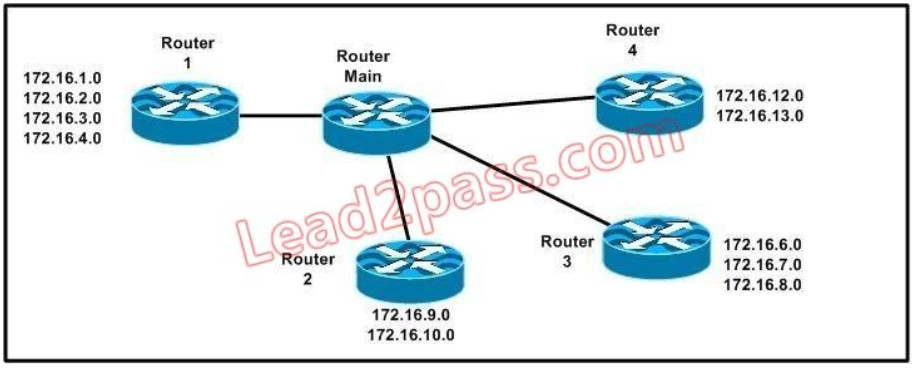
A. 172.16.0.0./21
B. 172.16.0.0./20
C. 172.16.0.0./16
D. 172.16.0.0/18
Answer: B
Explanation:
The 172.16.0.0./20 network is the best option as it includes all networks from 172.16.0.0 – 172.16.16.0 and does it more efficiently than the /16 and /18 subnets. The /21 subnet will not include all the other subnets in this one single summarized address.
QUESTION 86
Which IPv6 address is valid?
A. 2001:0db8:0000:130F:0000:0000:08GC:140B
B. 2001:0db8:0:130H::87C:140B
C. 2031::130F::9C0:876A:130B
D. 2031:0:130F::9C0:876A:130B
Answer: D
Explanation:
An IPv6 address is represented as eight groups of four hexadecimal digits, each group representing 16 bits (two octets). The groups are separated by colons (:). An example of an IPv6 address is 2001:0db8:85a3:0000:0000:8a2e:0370:7334. The leading 0’s in a group can be collapsed using ::, but this can only be done once in an IP address.
QUESTION 87
Which command can you use to manually assign a static IPv6 address to a router interface?
A. ipv6 autoconfig 2001:db8:2222:7272::72/64
B. ipv6 address 2001:db8:2222:7272::72/64
C. ipv6 address PREFIX_1 ::1/64
D. ipv6 autoconfig
Answer: B
Explanation:
To assign an IPv6 address to an interface, use the “ipv6 address” command and specify the IP address you wish to use.
QUESTION 88
Which of these represents an IPv6 link-local address?
A. FE80::380e:611a:e14f:3d69
B. FE81::280f:512b:e14f:3d69
C. FEFE:0345:5f1b::e14d:3d69
D. FE08::280e:611:a:f14f:3d69
Answer: A
Explanation:
In the Internet Protocol Version 6 (IPv6), the address block fe80::/10 has been reserved for linklocal unicast addressing. The actual link local addresses are assigned with the prefix fe80::/64.
They may be assigned by automatic (stateless) or stateful (e.g. manual) mechanisms.
QUESTION 89
The network administrator is asked to configure 113 point-to-point links. Which IP addressing scheme defines the address range and subnet mask that meet the requirement and waste the fewest subnet and host addresses?
A. 10.10.0.0/16 subnetted with mask 255.255.255.252
B. 10.10.0.0/18 subnetted with mask 255.255.255.252
C. 10.10.1.0/24 subnetted with mask 255.255.255.252
D. 10.10.0.0/23 subnetted with mask 255.255.255.252
E. 10.10.1.0/25 subnetted with mask 255.255.255.252
Answer: D
Explanation:
We need 113 point-to-point links which equal to 113 sub-networks < 128 so we need to borrow 7 bits (because 2^7 = 128).
The network used for point-to-point connection should be /30.
So our initial network should be 30 ?7 = 23.
So 10.10.0.0/23 is the correct answer.
You can understand it more clearly when writing it in binary form:
/23 = 1111 1111.1111 1110.0000 0000
/30 = 1111 1111.1111 1111.1111 1100 (borrow 7 bits)
QUESTION 90
A Cisco router is booting and has just completed the POST process. It is now ready to find and load an IOS image. What function does the router perform next?
A. It checks the configuration register.
B. It attempts to boot from a TFTP server.
C. It loads the first image file in flash memory.
D. It inspects the configuration file in NVRAM for boot instructions.
Answer: A
Explanation:
Default (normal) Boot SequencePower on Router – Router does POST – Bootstrap starts IOS load – Check configuration registerto see what mode the router should boot up in (usually 0x2102 to read startup-config in NVRAM / or 0x2142 to start in “setup-mode”) – check the startup-config file in NVRAM for boot-system commands – load IOS from Flash.
QUESTION 91
Refer to the exhibit. What is the meaning of the output MTU 1500 bytes?

A. The maximum number of bytes that can traverse this interface per second is 1500.
B. The minimum segment size that can traverse this interface is 1500 bytes.
C. The maximum segment size that can traverse this interface is 1500 bytes.
D. The minimum packet size that can traverse this interface is 1500 bytes.
E. The maximum packet size that can traverse this interface is 1500 bytes.
F. The maximum frame size that can traverse this interface is 1500 bytes.
Answer: E
Explanation:
The Maximum Transmission Unit (MTU) defines the maximum Layer 3 packet (in bytes) that the layer can pass onwards.
QUESTION 92
On a corporate network, hosts on the same VLAN can communicate with each other, but they are unable to communicate with hosts on different VLANs. What is needed to allow communication between the VLANs?
A. a router with subinterfaces configured on the physical interface that is connected to the switch
B. a router with an IP address on the physical interface connected to the switch
C. a switch with an access link that is configured between the switches
D. a switch with a trunk link that is configured between the switches
Answer: A
Explanation:
Different VLANs can’t communicate with each other , they can communicate with the help of Layer3 router. Hence , it is needed to connect a router to a switch , then make the sub-interface on the router to connect to the switch, establishing Trunking links to achieve communications of devices which belong to different VLANs.
When using VLANs in networks that have multiple interconnected switches, you need to use VLAN trunking between the switches. With VLAN trunking, the switches tag each frame sent between switches so that the receiving switch knows to what VLAN the frame belongs. End user devices connect to switch ports that provide simple connectivity to a single VLAN each. The attached devices are unaware of any VLAN structure.
By default, only hosts that are members of the same VLAN can communicate. To change this and allow inter-VLAN communication, you need a router or a layer 3 switch.
Here is the example of configuring the router for inter-vlan communication RouterA(config)#int f0/0.1
RouterA(config-subif)#encapsulation ?
dot1Q IEEE 802.1Q Virtual LAN
RouterA(config-subif)#encapsulation dot1Q or isl VLAN ID RouterA(config-subif)# ip address x.x.x.x y.y.y.y
QUESTION 93
Which command displays CPU utilization?
A. show protocols
B. show process
C. show system
D. show version
Answer: B
Explanation:
The “show process” (in fact, the full command is “show processes”) command gives us lots of information about each process but in fact it is not easy to read. Below shows the output of this command (some next pages are omitted)
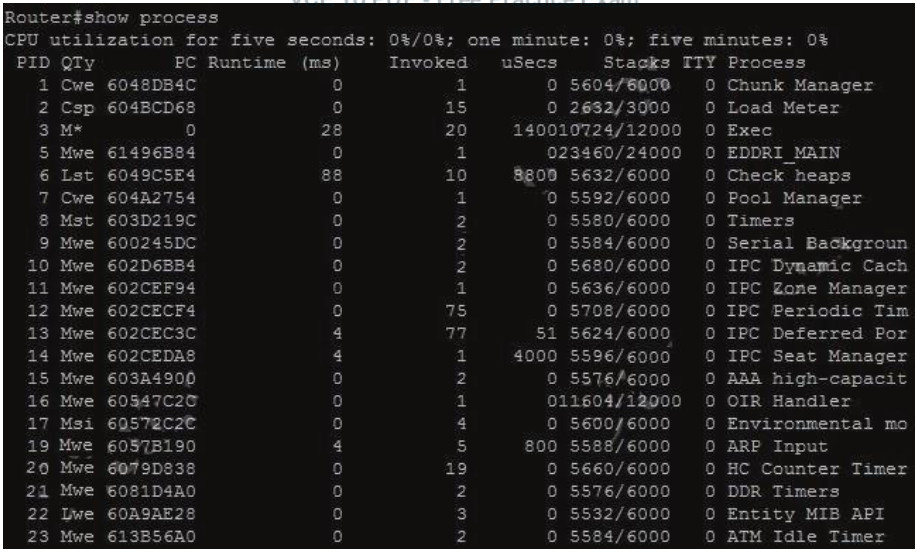
A more friendly way to check the CPU utilization is the command “show processes cpu history”, in which the total CPU usage on the router over a period of time: one minute, one hour, and 72 hours are clearly shown:
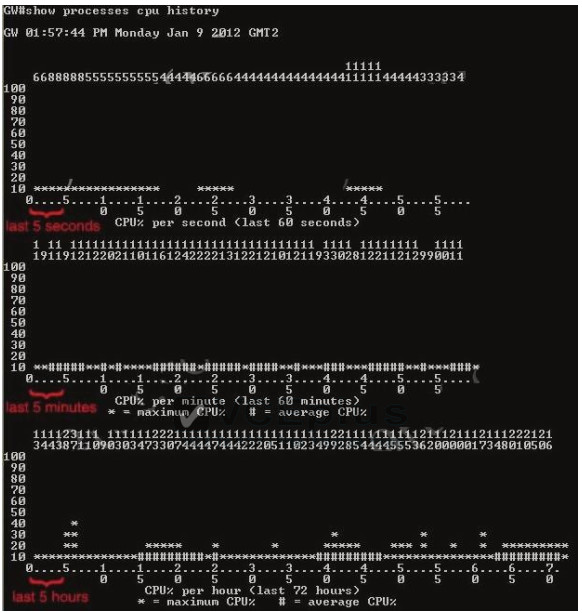
+ The Y-axis of the graph is the CPU utilization.+ The X-axis of the graph is the increment within the period displayed in the graph For example, from the last graph (last 72 hours) we learn that the highest CPU utilization within 72 hours is 37% about six hours ago.
QUESTION 94
What two things will a router do when running a distance vector routing protocol? (Choose two.)
A. Send periodic updates regardless of topology changes.
B. Send entire routing table to all routers in the routing domain.
C. Use the shortest-path algorithm to the determine best path.
D. Update the routing table based on updates from their neighbors.
E. Maintain the topology of the entire network in its database.
Answer: AD
Explanation:
Distance means how far and Vector means in which direction. Distance Vector routing protocols pass periodic copies of routing table to neighbor routers and accumulate distance vectors. In distance vector routing protocols, routers discover the best path to destination from each neighbor. The routing updates proceed step by step from router to router.
QUESTION 95
Which command is used to display the collection of OSPF link states?
A. show ip ospf link-state
B. show ip ospf lsa database
C. show ip ospf neighbors
D. show ip ospf database
Answer: D
Explanation:
The “show ip ospf database” command displays the link states. Here is an example:
Here is the lsa database on R2.
R2#show ip ospf database
OSPF Router with ID (2.2.2.2) (Process ID 1)
Router Link States (Area 0)
Link ID ADV Router Age Seq# Checksum Link count2.2.2.2 2.2.2.2 793 0x80000003 0x004F85
210.4.4.4 10.4.4.4 776 0x80000004 0x005643 1111.111.111.111 111.111.111.111 755
0x80000005 0x0059CA 2133.133.133.133 133.133.133.133 775 0x80000005 0x00B5B1 2 Net
Link States (Area 0)
Link ID ADV Router Age Seq# Checksum10.1.1.1 111.111.111.111 794 0x80000001
0x001E8B10.2.2.3 133.133.133.133 812 0x80000001 0x004BA910.4.4.1 111.111.111.111 755
0x80000001 0x007F1610.4.4.3 133.133.133.133 775 0x80000001 0x00C31F
QUESTION 96
Refer to the exhibit. The technician wants to upload a new IOS in the router while keeping the existing IOS. What is the maximum size of an IOS file that could be loaded if the original IOS is also kept in flash?

A. 3 MB
B. 4 MB
C. 5 MB
D. 7 MB
E. 8 MB
Answer: B
Explanation:
In this example, there are a total of 8 MB, but 3.8 are being used already, so another file as large as 4MB can be loaded in addition to the original file.
QUESTION 97
If IP routing is enabled, which two commands set the gateway of last resort to the default gateway? (Choose two.)
A. ip default-gateway 0.0.0.0
B. ip route 172.16.2.1 0.0.0.0 0.0.0.0
C. ip default-network 0.0.0.0
D. ip default-route 0.0.0.0 0.0.0.0 172.16.2.1
E. ip route 0.0.0.0 0.0.0.0 172.16.2.1
Answer: CE
Explanation:
Both the “ip default-network” and “ip route 0.0.0.0 0.0.0.0 (next hop)” commands can be used to set the default gateway in a Cisco router.
QUESTION 98
Refer to the exhibit. The two exhibited devices are the only Cisco devices on the network. The serial network between the two devices has a mask of 255.255.255.252. Given the output that is shown, what three statements are true of these devices? (Choose three.)
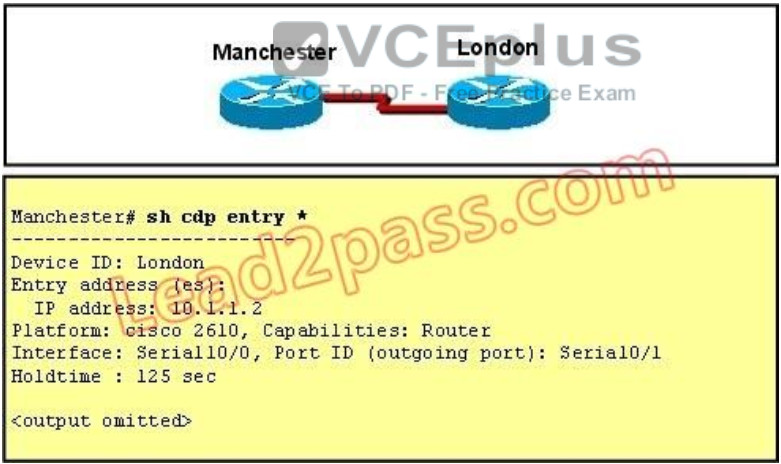
A. The Manchester serial address is 10.1.1.1.
B. The Manchester serial address is 10.1.1.2.
C. The London router is a Cisco 2610.
D. The Manchester router is a Cisco 2610.
E. The CDP information was received on port Serial0/0 of the Manchester router.
F. The CDP information was sent by port Serial0/0 of the London router.
Answer: ACE
Explanation:
From the output, we learn that the IP address of the neighbor router is 10.1.1.2 and the question stated that the subnet mask of the network between two router is 255.255.255.252. Therefore there are only 2 available hosts in this network (22 ?2 = 2). So we can deduce the ip address (of the serial interface) of Manchester router is 10.1.1.1 -> The platform of the neighbor router is cisco 2610, as shown in the output -> Maybe the most difficult choice of this QUESTION is the answer E or F. Please notice that “Interface” refers to the local port on the local router, in this case it is the port of Manchester router, and “Port ID (outgoing port)” refers to the port on the neighbor router.
QUESTION 99
Which parameter would you tune to affect the selection of a static route as a backup, when a dynamic protocol is also being used?
A. hop count
B. administrative distance
C. link bandwidth
D. link delay
E. link cost
Answer: B
Explanation:
By default the administrative distance of a static route is 1, meaning it will be preferred over all dynamic routing protocols. If you want to have the dynamic routing protocol used and have the static route be used only as a backup, you need to increase the AD of the static route so that it is higher than the dynamic routing protocol.
QUESTION 100
Refer to the exhibit. A network associate has configured OSPF with the command:
City(config-router)# network 192.168.12.64 0.0.0.63 area 0
After completing the configuration, the associate discovers that not all the interfaces are participating in OSPF. Which three of the interfaces shown in the exhibit will participate in OSPF according to this configuration statement? (Choose three.)
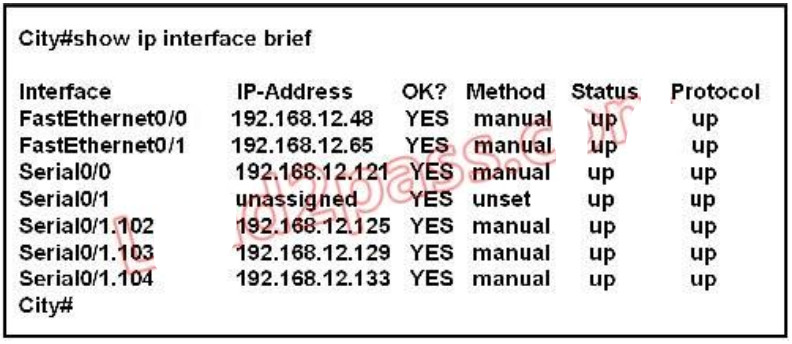
A. FastEthernet0 /0
B. FastEthernet0 /1
C. Serial0/0
D. Serial0/1.102
E. Serial0/1.103
F. Serial0/1.104
Answer: BCD
Explanation:
The “network 192.168.12.64 0.0.0.63 equals to network 192.168.12.64/26. This network has:
+ Increment: 64 (/26= 1111 1111.1111 1111.1111 1111.1100 0000) + Network address:
192.168.12.64
+ Broadcast address: 192.168.12.127
Therefore all interface in the range of this network will join OSPF.
QUESTION 101
Refer to the exhibit. The Lakeside Company has the internetwork in the exhibit. The administrator would like to reduce the size of the routing table on the Central router. Which partial routing table entry in the Central router represents a route summary that represents the LANs in Phoenix but no additional subnets?
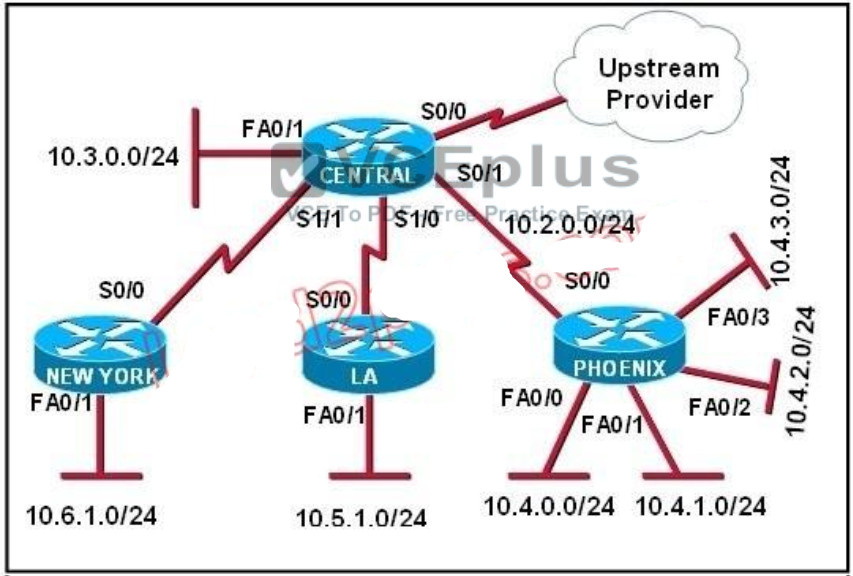
A. 10.0.0.0/22 is subnetted, 1 subnets
D 10.0.0.0 [90/20514560] via 10.2.0.2, 6w0d, Serial0/1
B. 10.0.0.0/28 is subnetted, 1 subnets
D 10.2.0.0 [90/20514560] via 10.2.0.2, 6w0d, Serial0/1
C. 10.0.0.0/30 is subnetted, 1 subnets
D 10.2.2.0 [90/20514560] via 10.2.0.2, 6w0d, Serial0/1
D. 10.0.0.0/22 is subnetted, 1 subnets
D 10.4.0.0 [90/20514560] via 10.2.0.2, 6w0d, Serial0/1
E. 10.0.0.0/28 is subnetted, 1 subnets
D 10.4.4.0 [90/20514560] via 10.2.0.2, 6w0d, Serial0/1
F. 10.0.0.0/30 is subnetted, 1 subnets
D 10.4.4.4 [90/20514560] via 10.2.0.2, 6w0d, Serial0/1
Answer: D
Explanation:
The 10.4.0.0/22 route includes 10.4.0.0/24, 10.4.1.0/24, 10.4.2.0/24 and 10.4.3.0/24 only.
QUESTION 102
Refer to the graphic. A static route to the 10.5.6.0/24 network is to be configured on the HFD router. Which commands will accomplish this? (Choose two.)
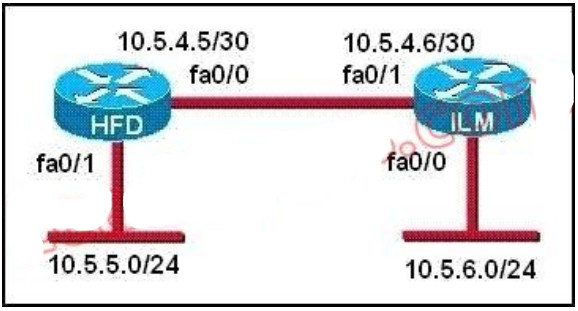
A. HFD(config)# ip route 10.5.6.0 0.0.0.255 fa0/0
B. HFD(config)# ip route 10.5.6.0 0.0.0.255 10.5.4.6
C. HFD(config)# ip route 10.5.6.0 255.255.255.0 fa0/0
D. HFD(config)# ip route 10.5.6.0 255.255.255.0 10.5.4.6
E. HFD(config)# ip route 10.5.4.6 0.0.0.255 10.5.6.0
F. HFD(config)# ip route 10.5.4.6 255.255.255.0 10.5.6.0
Answer: CD
Explanation:
The simple syntax of static route:
ip route destination-network-address subnet-mask {next-hop-IP-address | exit-interface} + destination-network-address: destination network address of the remote network + subnet mask:
subnet mask of the destination network + next-hop-IP-address: the IP address of the receiving interface on the next-hop router + exit-interface: the local interface of this router where the packets will go out In the statement “ip route 10.5.6.0 255.255.255.0 fa0/0:
+ 10.5.6.0 255.255.255.0: the destination network
+ fa0/0: the exit-interface
QUESTION 103
Before installing a new, upgraded version of the IOS, what should be checked on the router, and which command should be used to gather this information? (Choose two.)
A. the amount of available ROM
B. the amount of available flash and RAM memory
C. the version of the bootstrap software present on the router
D. show version
E. show processes
F. show running-config
Answer: BD
Explanation:
When upgrading new version of the IOS we need to copy the IOS to the Flash so first we have to check if the Flash has enough memory or not. Also running the new IOS may require more RAM than the older one so we should check the available RAM too. We can check both with the “show version” command.
QUESTION 104
Which command reveals the last method used to powercycle a router?
A. show reload
B. show boot
C. show running-config
D. show version
Answer: D
Explanation:
The “show version” command can be used to show the last method to powercycle (reset) a router
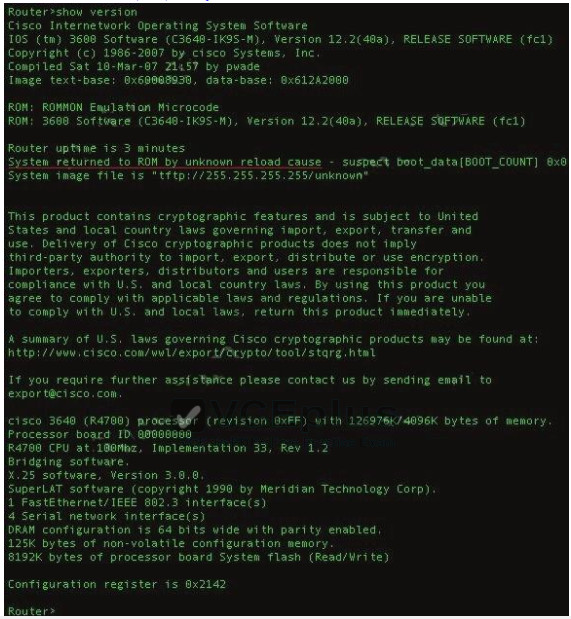
QUESTION 105
Which command would you use on a Cisco router to verify the Layer 3 path to a host?
A. tracert address
B. traceroute address
C. telnet address
D. ssh address
Answer: B
Explanation:
In computing, traceroute is a computer network diagnostic tool for displaying the route (path) and measuring transit delays of packets across an Internet Protocol (IP) network. The history of the route is recorded as the round-trip times of the packets received from each successive host (remote node) in the route (path); the sum of the mean times in each hop indicates the total time spent to establish the connection. Traceroute proceeds unless all (three) sent packets are lost more than twice, then the connection is lost and the route cannot be evaluated. Ping, on the other hand, only computes the final round-trip times from the destination point.
QUESTION 106
What information does a router running a link-state protocol use to build and maintain its topological database? (Choose two.)
A. hello packets
B. SAP messages sent by other routers
C. LSAs from other routers
D. beacons received on point-to-point links
E. routing tables received from other link-state routers
F. TTL packets from designated routers
Answer: AC
Explanation:
Neighbor discovery is the first step in getting a link state environment up and running. In keeping with the friendly neighbor terminology, a Hello protocol is used for this step. The protocol will define a Hello packet format and a procedure for exchanging the packets and processing the information the packets contain.
After the adjacencies are established, the routers may begin sending out LSAs. As the term flooding implies, the advertisements are sent to every neighbor. In turn, each received LSA is copied and forwarded to every neighbor except the one that sent the LSA.
QUESTION 107
Which statements describe the routing protocol OSPF? (Choose three.)
A. It supports VLSM.
B. It is used to route between autonomous systems.
C. It confines network instability to one area of the network.
D. It increases routing overhead on the network.
E. It allows extensive control of routing updates.
F. It is simpler to configure than RIP v2.
Answer: ACE
Explanation:
The OSPF protocol is based on link-state technology, which is a departure from the Bellman-Ford vector based algorithms used in traditional Internet routing protocols such as RIP. OSPF has introduced new concepts such as authentication of routing updates, Variable Length Subnet Masks (VLSM), route summarization, and so forth.
OSPF uses flooding to exchange link-state updates between routers. Any change in routing information is flooded to all routers in the network. Areas are introduced to put a boundary on the explosion of link-state updates. Flooding and calculation of the Dijkstra algorithm on a router is limited to changes within an area.
QUESTION 108
Refer to the exhibit. A network administrator configures a new router and enters the copy startupconfig running-config command on the router. The network administrator powers down the router and sets it up at a remote location. When the router starts, it enters the system configuration dialog as shown. What is the cause of the problem?

A. The network administrator failed to save the configuration.
B. The configuration register is set to 0x2100.
C. The boot system flash command is missing from the configuration.
D. The configuration register is set to 0x2102.
E. The router is configured with the boot system startup command.
Answer: A
Explanation:
The “System Configuration Dialog” appears only when no startup configuration file is found. The network administrator has made a mistake because the command “copy startup-config runningconfig” will copy the startup config (which is empty) over the running config (which is configured by the administrator). So everything configured was deleted. Note: We can tell the router to
ignore the start-up configuration on the next reload by setting the register to 0?142. This will make the “System Configuration Dialog” appear at the next reload.
QUESTION 109
Refer to the exhibit. Which WAN protocol is being used?
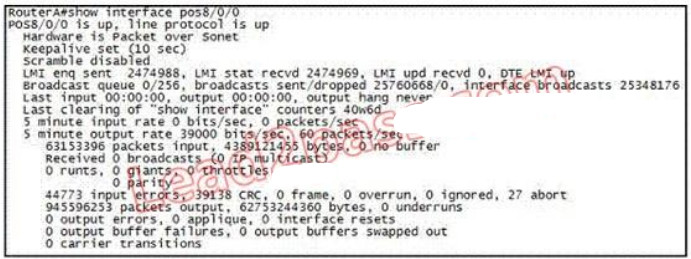
A. ATM
B. HDLC
C. Frame Relay
D. PPP
Answer: C
Explanation:
This QUESTION is to examine the show int command.
According to the information provided in the exhibit, we can know that the data link protocol used in this network is the Frame Relay protocol.
“LMI enq sent…”
QUESTION 110
What is the default administrative distance of OSPF?
A. 90
B. 100
C. 110
D. 120
Answer: C
Explanation:
Administrative distance is the feature that routers use in order to select the best path when there are two or more different routes to the same destination from two different routing protocols.
Administrative distance defines the reliability of a routing protocol. Each routing protocol is prioritized in order of most to least reliable (believable) with the help of an administrative distance value.
Default Distance Value Table This table lists the administrative distance default values of the protocols that Cisco supports:
Route Source
Default Distance Values
Connected interface
Static route
Enhanced Interior Gateway Routing Protocol (EIGRP) summary route External Border Gateway
Protocol (BGP)
Internal EIGRP
IGRP
OSPF
Intermediate System-to-Intermediate System (IS-IS)
Routing Information Protocol (RIP)
Exterior Gateway Protocol (EGP)
On Demand Routing (ODR)
External EIGRP
Internal BGP
Unknown*
QUESTION 111
Which characteristics are representative of a link-state routing protocol? (Choose three.)
A. provides common view of entire topology
B. exchanges routing tables with neighbors
C. calculates shortest path
D. utilizes event-triggered updates
E. utilizes frequent periodic updates
Answer: ACD
Explanation:
Each of routers running link-state routing protocol learns paths to all the destinations in its “area” so we can say although it is a bit unclear.
Link-state routing protocols generate routing updates only (not the whole routing table) when a change occurs in the network topology so Link-state routing protocol like OSPF uses Dijkstra algorithm to calculate the shortest path -> .
Unlike Distance vector routing protocol (which utilizes frequent periodic updates), link-state
routing protocol utilizes event-triggered updates (only sends update when a change occurs) ->
QUESTION 112
Refer to the exhibit. Based on the exhibited routing table, how will packets from a host within the 92.168.10.192/26 LAN be forwarded to 192.168.10.1?
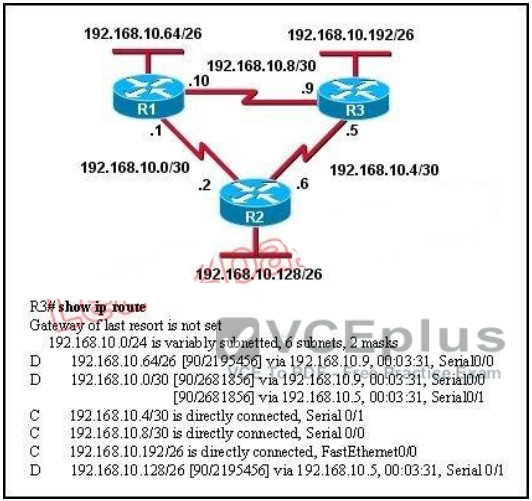
A. The router will forward packets from R3 to R2 to R1.
B. The router will forward packets from R3 to R1 to R2.
C. The router will forward packets from R3 to R2 to R1 AND from R3 to R1.
D. The router will forward packets from R3 to R1.
Answer: C
Explanation:
From the routing table we learn that network 192.168.10.0/30 is learned via 2 equal-cost paths (192.168.10.9 &192.168.10.5) -> traffic to this network will be load-balancing.
QUESTION 113
Refer to the exhibit. C-router is to be used as a “router-on-a-stick” to route between the VLANs.
All the interfaces have been properly configured and IP routing is operational. The hosts in the VLANs have been configured with the appropriate default gateway. What is true about this configuration?
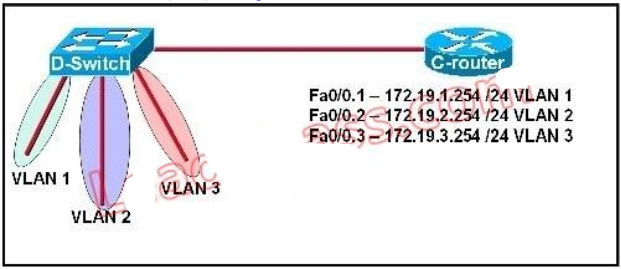
A. These commands need to be added to the configuration:
C-router(config)# router eigrp 123
C-router(config-router)# network 172.19.0.0
B. These commands need to be added to the configuration:
C-router(config)# router ospf 1
C-router(config-router)# network 172.19.0.0 0.0.3.255 area 0
C. These commands need to be added to the configuration:
C-router(config)# router rip
C-router(config-router)# network 172.19.0.0
D. No further routing configuration is required.
Answer: D
Explanation:
Since all the same router (C-router) is the default gateway for all three VLANs, all traffic destined to a different VLA will be sent to the C-router. The C-router will have knowledge of all three networks since they will appear as directly connected in the routing table. Since the C-router already knows how to get to all three networks, no routing protocols need to be configured.
QUESTION 114
Which command would you configure globally on a Cisco router that would allow you to view directly connected Cisco devices?
A. enable cdp
B. cdp enable
C. cdp run
D. run cdp
Answer: C
Explanation:
CDP is enabled on Cisco routers by default. If you prefer not to use the CDP capability, disable it with the no cdp run command. In order to reenable CDP, use the cdp run command in global configuration mode. The “cdp enable” command is an interface command, not global.
QUESTION 115
Refer to the exhibit. Why is flash memory erased prior to upgrading the IOS image from the TFTP server?
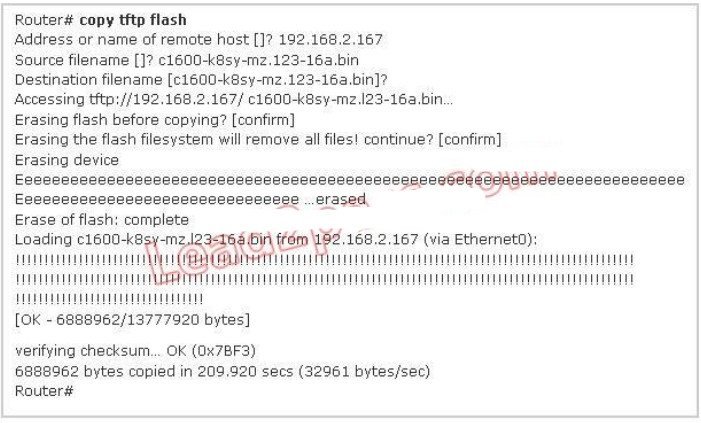
A. The router cannot verify that the Cisco IOS image currently in flash is valid.
B. Flash memory on Cisco routers can contain only a single IOS image.
C. Erasing current flash content is requested during the copy dialog.
D. In order for the router to use the new image as the default, it must be the only IOS image in flash.
Answer: C
Explanation:
During the copy process, the router asked “Erasing flash before copying? [confirm]” and the administrator confirmed (by pressing Enter) so the flash was deleted. Note: In this case, the flash has enough space to copy a new IOS without deleting the current one. The current IOS is deleted just because the administrator wants to do so. If the flash does not have enough space you will see an error message like this:
%Error copying tftp://192.168.2.167/ c1600-k8sy-mz.l23-16a.bin (Not enough space on device)
QUESTION 116
Refer to the exhibit. According to the routing table, where will the router send a packet destined for 10.1.5.65?
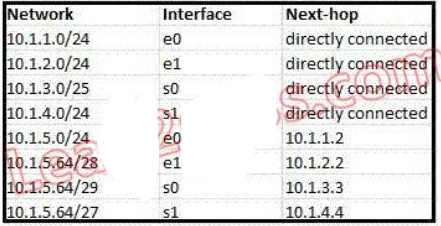
A. 10.1.1.2
B. 10.1.2.2
C. 10.1.3.3
D. 10.1.4.4
Answer: C
Explanation:
The destination IP address 10.1.5.65 belongs to 10.1.5.64/28, 10.1.5.64/29 & 10.1.5.64/27 subnets but the “longest prefix match” algorithm will choose the most specific subnet mask -> the prefix “/29 will be chosen to route the packet. Therefore the next-hop should be 10.1.3.3 -> .
QUESTION 117
Refer to the exhibit. Which address and mask combination represents a summary of the routes learned by EIGRP?
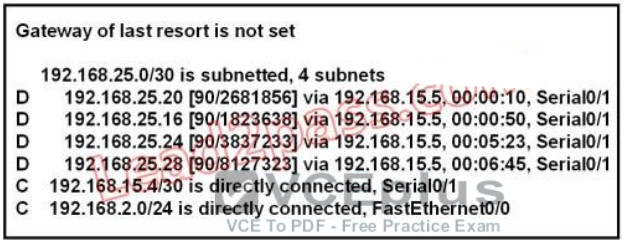
A. 192.168.25.0 255.255.255.240
B. 192.168.25.0 255.255.255.252
C. 192.168.25.16 255.255.255.240
D. 192.168.25.16 255.255.255.252
E. 192.168.25.28 255.255.255.240
F. 192.168.25.28 255.255.255.252
Answer: C
Explanation:
The binary version of 20 is 10100.
The binary version of 16 is 10000.
The binary version of 24 is 11000.
The binary version of 28 is 11100.
The subnet mask is /28. The mask is 255.255.255.240.
Note:
From the output above, EIGRP learned 4 routes and we need to find out the summary of them:
+ 192.168.25.16
+ 192.168.25.20
+ 192.168.25.24
+ 192.168.25.28
-> The increment should bE. 28 ?16 = 12 but 12 is not an exponentiation of 2 so we must choose 16 (24). Therefore the subnet mask is /28 (=1111 1111.1111 1111.1111 1111.11110000) = 255.255.255.240
So the best answer should be 192.168.25.16 255.255.255.240
QUESTION 118
Refer to the exhibit. Assuming that the entire network topology is shown, what is the operational status of the interfaces of R2 as indicated by the command output shown?
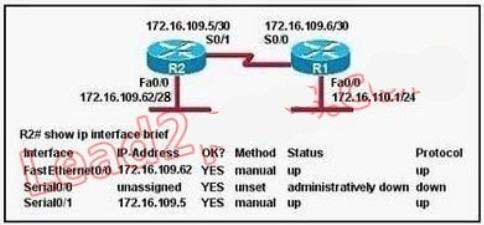
A. One interface has a problem.
B. Two interfaces have problems.
C. The interfaces are functioning correctly.
D. The operational status of the interfaces cannot be determined from the output shown.
Answer: C
Explanation:
The output shown shows normal operational status of the router’s interfaces. Serial0/0 is down because it has been disabled using the “shutdown” command.
QUESTION 119
Which two locations can be configured as a source for the IOS image in the boot system command? (Choose two.)
A. RAM
B. NVRAM
C. flash memory
D. HTTP server
E. TFTP server
F. Telnet server
Answer: CE
Explanation:
The following locations can be configured as a source for the IOS image:
1. + Flash (the default location)
2. + TFTP server
3. + ROM (used if no other source is found)
QUESTION 120
Refer to the exhibit. Given the output for this command, if the router ID has not been manually set, what router ID will OSPF use for this router?

A. 10.1.1.2
B. 10.154.154.1
C. 172.16.5.1
D. 192.168.5.3
Answer: C
Explanation:
The highest IP address of all loopback interfaces will be chosen -> Loopback 0 will be chosen as the router ID.
QUESTION 121
Which two statements describe the process identifier that is used in the command to configure OSPF on a router? (Choose two.)
Router(config)# router ospf 1
A. All OSPF routers in an area must have the same process ID
B. Only one process number can be used on the same router.
C. Different process identifiers can be used to run multiple OSPF processes
D. The process number can be any number from 1 to 65,535.
E. Hello packets are sent to each neighbor to determine the processor identifier.
Answer: CD
Explanation:
Multiple OSPF processes can be configured on a router using multiple process ID’s.
The valid process ID’s are shown below:
Edge-B(config)#router ospf ?
Process ID
QUESTION 122
Refer to the exhibit. What commands must be configured on the 2950 switch and the router to allow communication between host 1 and host 2? (Choose two.)
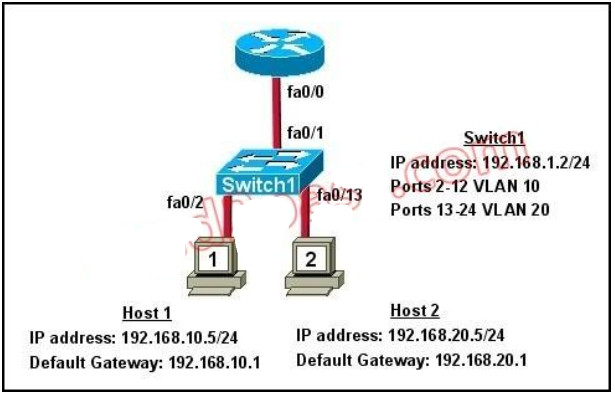
A. Router(config)# interface fastethernet 0/0
Router(config-if)# ip address 192.168.1.1 255.255.255.0
Router(config-if)# no shut down
B. Router(config)# interface fastethernet 0/0
Router(config-if)# no shut down
Router(config)# interface fastethernet 0/0.1
Router(config-subif)# encapsulation dot1q 10
Router(config-subif)# ip address 192.168.10.1 255.255.255.0
Router(config)# interface fastethernet 0/0.2
Router(config-subif)# encapsulation dot1q 20
Router(config-subif)# ip address 192.168.20.1 255.255.255.0
C. Router(config)# router eigrp 100
Router(config-router)# network 192.168.10.0
Router(config-router)# network 192.168.20.0
D. Switch1(config)# vlan database
Switch1(config-vlan)# vtp domain XYZ
Switch1(config-vlan)# vtp server
E. Switch1(config)# interface fastethernet 0/1
Switch1(config-if)# switchport mode trunk
F. Switch1(config)# interface vlan 1
Switch1(config-if)# ip default-gateway 192.168.1.1
Answer: BE
Explanation:
The router will need to use subinterfaces, where each subinterface is assigned a VLAN and IP address for each VLAN. On the switch, the connection to the router need to be configured as a trunk using the switchport mode trunk command and it will need a default gateway for VLAN 1.
QUESTION 123
Refer to the exhibit. For what two reasons has the router loaded its IOS image from the location that is shown? (Choose two.)
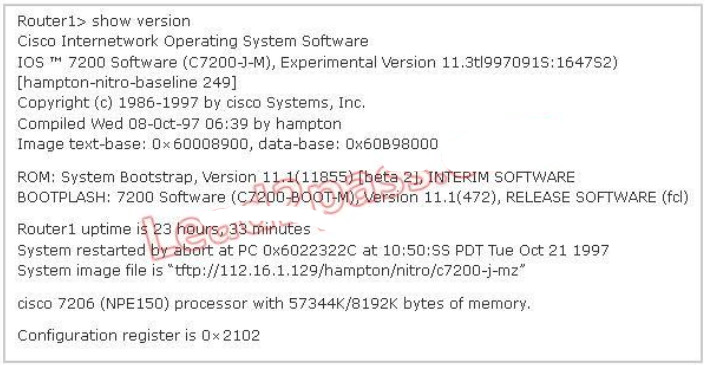
A. Router1 has specific boot system commands that instruct it to load IOS from a TFTP server.
B. Router1 is acting as a TFTP server for other routers.
C. Router1 cannot locate a valid IOS image in flash memory.
D. Router1 defaulted to ROMMON mode and loaded the IOS image from a TFTP server.
E. Cisco routers will first attempt to load an image from TFTP for management purposes.
Answer: AC
Explanation:
The loading sequence of CISCO IOS is as follows:
Booting up the router and locating the Cisco IOS
1. POST (power on self test)
2. Bootstrap code executed
3. Check Configuration Register value (NVRAM) which can be modified using the config-register command
0 = ROM Monitor mode
1 = ROM IOS
2 – 15 = startup-config in NVRAM
4. Startup-config filE. Check for boot system commands (NVRAM) If boot system commands in startup-config
a. Run boot system commands in order they appear in startup-config to locate the IOS b. [If boot system commands fail, use default fallback sequence to locate the IOS (Flash, TFTP, ROM)?]
If no boot system commands in startup-config use the default fallback sequence in locating the IOS:
a. Flash (sequential)
b. TFTP server (netboot)
c. ROM (partial IOS) or keep retrying TFTP depending upon router model
5. If IOS is loaded, but there is no startup-config file, the router will use the default fallback sequence for locating the IOS and then it will enter setup mode or the setup dialogue.
QUESTION 124
Refer to the exhibit. What can be determined about the router from the console output?

A. No configuration file was found in NVRAM.
B. No configuration file was found in flash.
C. No configuration file was found in the PCMCIA card.
D. Configuration file is normal and will load in 15 seconds.
Answer: A
Explanation:
When no startup configuration file is found in NVRAM, the System Configuration Dialog will appear to ask if we want to enter the initial configuration dialog or not.
QUESTION 125
Which three elements must be used when you configure a router interface for VLAN trunking? (Choose three.)
A. one physical interface for each subinterface
B. one IP network or subnetwork for each subinterface
C. a management domain for each subinterface
D. subinterface encapsulation identifiers that match VLAN tags
E. one subinterface per VLAN
F. subinterface numbering that matches VLAN tags
Answer: BDE
Explanation:
This scenario is commonly called a router on a stick. A short, well written article on this operation can be found here:
http://www.thebryantadvantage.com/RouterOnAStickCCNACertificationExamTutorial.htm
QUESTION 126
Which commands are required to properly configure a router to run OSPF and to add network 192.168.16.0/24 to OSPF area 0? (Choose two.)
A. Router(config)# router ospf 0
B. Router(config)# router ospf 1
C. Router(config)# router ospf area 0
D. Router(config-router)# network 192.168.16.0 0.0.0.255 0
E. Router(config-router)# network 192.168.16.0 0.0.0.255 area 0
F. Router(config-router)# network 192.168.16.0 255.255.255.0 area 0
Answer: BE
Explanation:
In the router ospf
command, the ranges from 1 to 65535 so o is an invalid number -> but To configure OSPF, we need a wildcard in the “network” statement, not a subnet mask. We also need to assgin an area to this process -> .
QUESTION 127
A router receives information about network 192.168.10.0/24 from multiple sources. What will the router consider the most reliable information about the path to that network?
A. a directly connected interface with an address of 192.168.10.254/24
B. a static route to network 192.168.10.0/24
C. a RIP update for network 192.168.10.0/24
D. an OSPF update for network 192.168.0.0/16
E. a default route with a next hop address of 192.168.10.1
F. a static route to network 192.168.10.0/24 with a local serial interface configured as the next hop Answer: A
Explanation:
When there is more than one way to reach a destination, it will choose the best one based on a couple of things. First, it will choose the route that has the longest match; meaning the most specific route. So, in this case the /24 routes will be chosen over the /16 routes. Next, from all the /24 routes it will choose the one with the lowest administrative distance. Directly connected routes have an AD of 1 so this will be the route chosen.
QUESTION 128
What is the default maximum number of equal-cost paths that can be placed into the routing table of a Cisco OSPF router?
A. 2
B. 4
C. 16
D. unlimited
Answer: B
Explanation:
maximum-paths (OSPF)
To control the maximum number of parallel routes that Open Shortest Path First (OSPF) can support, use the maximum-paths command.
Syntax Description
maximum
Maximum number of parallel routes that OSPF can install in a routing table. The range is from 1 to 16 routes.
Command Default
8 paths
QUESTION 129
Which command shows your active Telnet connections?
A. show cdp neigbors
B. show session
C. show users
D. show vty logins
Answer: B
Explanation:
The “show users” shows telnet/ssh connections to your router while “show sessions” shows telnet/ssh connections from your router (to other devices). The QUESTION asks about “your active
Telnet connections”, meaning connections from your router so the answer should be A.
QUESTION 130
Refer to the exhibit. What statement is true of the configuration for this network?
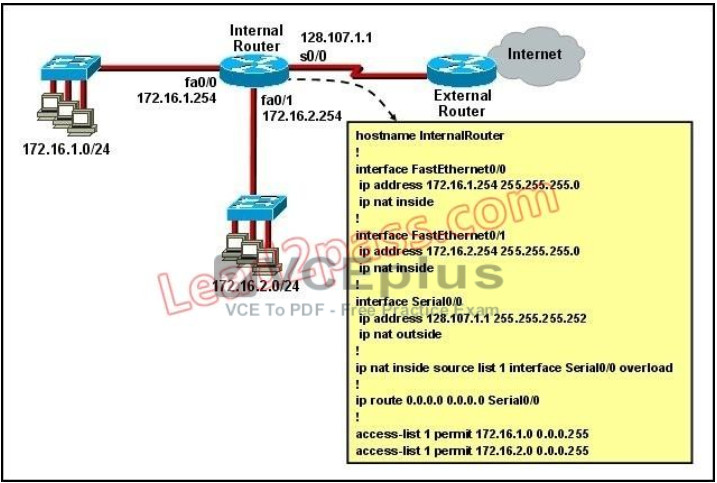
A. The configuration that is shown provides inadequate outside address space for translation of the number of inside addresses that are supported.
B. Because of the addressing on interface FastEthernet0/1, the Serial0/0 interface address will not support the NAT configuration as shown.
C. The number 1 referred to in the ip nat inside source command references access-list number 1.
D. ExternalRouter must be configured with static routes to networks 172.16.1.0/24 and 172.16.2.0/24.
Answer: C
Explanation:
The “list 1 refers to the access-list number 1.
QUESTION 131
Which type of EIGRP route entry describes a feasible successor?
A. a backup route, stored in the routing table
B. a primary route, stored in the routing table
C. a backup route, stored in the topology table
D. a primary route, stored in the topology table
Answer: C
Explanation:
EIGRP uses the Neighbor Table to list adjacent routers. The Topology Table list all the learned routers to destination whilst the Routing Table contains the best route to a destination, which is known as the Successor. The Feasible Successor is a backup route to a destination which is kept in the Topology Table.
QUESTION 132
Which statement describes the process of dynamically assigning IP addresses by the DHCP server?
A. Addresses are allocated after a negotiation between the server and the host to determine the length of the agreement.
B. Addresses are permanently assigned so that the hosts uses the same address at all times.
C. Addresses are assigned for a fixed period of time, at the end of the period, a new request for an address must be made.
D. Addresses are leased to hosts, which periodically contact the DHCP server to renew the lease.
Answer: D
Explanation:
The DHCP lifecycle consists of the following:
Release: The client may decide at any time that it no longer wishes to use the IP address it was assigned, and may terminate the lease, releasing the IP address.
QUESTION 133
What are two benefits of using NAT? (Choose two.)
A. NAT facilitates end-to-end communication when IPsec is enabled.
B. NAT eliminates the need to re-address all hosts that require external access.
C. NAT conserves addresses through host MAC-level multiplexing.
D. Dynamic NAT facilitates connections from the outside of the network.
E. NAT accelerates the routing process because no modifications are made on the packets.
F. NAT protects network security because private networks are not advertised.
Answer: BF
Explanation:
By not revealing the internal Ip addresses, NAT adds some security to the inside network -> F is correct.
NAT has to modify the source IP addresses in the packets -> E is not correct.
Connection from the outside of the network through a “NAT” network is more difficult than a more network because IP addresses of inside hosts are hidden -> C is not correct.
In order for IPsec to work with NAT we need to allow additional protocols, including Internet Key Exchange (IKE), Encapsulating Security Payload (ESP) and Authentication Header (AH) -> more complex -> A is not correct. By allocating specific public IP addresses to inside hosts, NAT eliminates the need to re-address the inside hosts -> B is correct. NAT does conserve addresses but not through host MAC-level multiplexing. It conserves addresses by allowing many private IP addresses to use the same public IP address to go to the Internet -> C is not correct.
QUESTION 134
On which options are standard access lists based?
A. destination address and wildcard mask
B. destination address and subnet mask
C. source address and subnet mask
D. source address and wildcard mask
Answer: D
Explanation:
Standard ACL’s only examine the source IP address/mask to determine if a match is made.
Extended ACL’s examine the source and destination address, as well as port information.
QUESTION 135
A network engineer wants to allow a temporary entry for a remote user with a specific username and password so that the user can access the entire network over the Internet. Which ACL can be used?
A. standard
B. extended
C. dynamic
D. reflexive
Answer: C
Explanation:
We can use a dynamic access list to authenticate a remote user with a specific username and password. The authentication process is done by the router or a central access server such as a TACACS+ or RADIUS server. The configuration of dynamic ACL can be read here: http://www.cisco.com/en/US/tech/tk583/tk822/technologies_tech_note09186a0080094524.shtml
QUESTION 136
How does a DHCP server dynamically assign IP addresses to hosts?
A. Addresses are permanently assigned so that the host uses the same address at all times.
B. Addresses are assigned for a fixed period of time. At the end of the period, a new request for an address must be made, and another address is then assigned.
C. Addresses are leased to hosts. A host will usually keep the same address by periodically contacting the DHCP server to renew the lease.
D. Addresses are allocated after a negotiation between the server and the host to determine the length of the agreement.
Answer: C
Explanation:
DHCP works in a client/server mode and operates like any other client/server relationship. When a PC connects to a DHCP server, the server assigns or leases an IP address to that PC. The PC connects to the network with that leased IP address until the lease expires. The host must contact the DHCP server periodically to extend the lease. This lease mechanism ensures that hosts that move or power off do not hold onto addresses that they do not need. The DHCP server returns these addresses to the address pool and reallocates them as necessary.
QUESTION 137
Refer to the exhibit. Which rule does the DHCP server use when there is an IP address conflict?

A. The address is removed from the pool until the conflict is resolved.
B. The address remains in the pool until the conflict is resolved.
C. Only the IP detected by Gratuitous ARP is removed from the pool.
D. Only the IP detected by Ping is removed from the pool.
E. The IP will be shown, even after the conflict is resolved.
Answer: A
Explanation:
An address conflict occurs when two hosts use the same IP address. During address assignment, DHCP checks for conflicts using ping and gratuitous ARP. If a conflict is detected, the address is removed from the pool. The address will not be assigned until the administrator resolves the conflict.
http://www.cisco.com/en/US/docs/ios/12_1/iproute/configuration/guide/1cddhcp.html
QUESTION 138
Which two tasks does the Dynamic Host Configuration Protocol perform? (Choose two.)
A. Set the IP gateway to be used by the network.
B. Perform host discovery used DHCPDISCOVER message.
C. Configure IP address parameters from DHCP server to a host.
D. Provide an easy management of layer 3 devices.
E. Monitor IP performance using the DHCP server.
F. Assign and renew IP address from the default pool.
Answer: CF
Explanation:
The Dynamic Host Configuration Protocol (DHCP) is a network protocol used to configure devices that are connected to a network (known as hosts) so they can communicate on that network using the Internet Protocol (IP). It involves clients and a server operating in a clientserver model. DHCP servers assigns IP addresses from a pool of addresses and also assigns other parameters such as DNS and default gateways to hosts.
QUESTION 140
When a DHCP server is configured, which two IP addresses should never be assignable to hosts? (Choose two.)
A. network or subnetwork IP address
B. broadcast address on the network
C. IP address leased to the LAN
D. IP address used by the interfaces
E. manually assigned address to the clients
F. designated IP address to the DHCP server
Answer: AB
Explanation:
Network or subnetwork IP address (for example 11.0.0.0/8 or 13.1.0.0/16) and broadcast address (for example 23.2.1.255/24) should never be assignable to hosts. When try to assign these addresses to hosts, you will receive an error message saying that they can’t be assignable.
QUESTION 141
Which two statements about static NAT translations are true? (Choose two.)
A. They allow connections to be initiated from the outside.
B. They require no inside or outside interface markings because addresses are statically defined.
C. They are always present in the NAT table.
D. They can be configured with access lists, to allow two or more connections to be initiated from the outside.
Answer: AC
Explanation:
Static NAT is to map a single outside IP address to a single inside IP address. This is typically done to allow incoming connections from the outside (Internet) to the inside. Since these are static, they are always present in the NAT table even if they are not actively in use.
QUESTION 142
Which statement about access lists that are applied to an interface is true?
A. You can place as many access lists as you want on any interface.
B. You can apply only one access list on any interface.
C. You can configure one access list, per direction, per Layer 3 protocol.
D. You can apply multiple access lists with the same protocol or in different directions.
Answer: C
Explanation:
We can have only 1 access list per protocol, per direction and per interface. It means:
+ We can not have 2 inbound access lists on an interface + We can have 1 inbound and 1 outbound access list on an interface
QUESTION 143
Which item represents the standard IP ACL?
A. access-list 110 permit ip any any
B. access-list 50 deny 192.168.1.1 0.0.0.255
C. access list 101 deny tcp any host 192.168.1.1
D. access-list 2500 deny tcp any host 192.168.1.1 eq 22
Answer: B
Explanation:
The standard access lists are ranged from 1 to 99 and from 1300 to 1999 so only access list 50 is a standard access list.
QUESTION 144
A network administrator is configuring ACLs on a Cisco router, to allow traffic from hosts on networks 192.168.146.0, 192.168.147.0, 192.168.148.0, and 192.168.149.0 only. Which two ACL statements, when combined, would you use to accomplish this task? (Choose two.)
A. access-list 10 permit ip 192.168.146.0 0.0.1.255
B. access-list 10 permit ip 192.168.147.0 0.0.255.255
C. access-list 10 permit ip 192.168.148.0 0.0.1.255
D. access-list 10 permit ip 192.168.149.0 0.0.255.255
E. access-list 10 permit ip 192.168.146.0 0.0.0.255
F. access-list 10 permit ip 192.168.146.0 255.255.255.0
Answer: AC
Explanation:
access-list 10 permit ip 192.168.146.0 0.0.1.255 will include the 192.168.146.0 and 192.168.147.0 subnets, while access-list 10 permit ip 192.168.148.0 0.0.1.255 will include
QUESTION 145
What can be done to secure the virtual terminal interfaces on a router? (Choose two.)
A. Administratively shut down the interface.
B. Physically secure the interface.
C. Create an access list and apply it to the virtual terminal interfaces with the access-group command.
D. Configure a virtual terminal password and login process.
E. Enter an access list and apply it to the virtual terminal interfaces using the access-class command.
Answer: DE
Explanation:
It is a waste to administratively shut down the interface. Moreover, someone can still access the virtual terminal interfaces via other interfaces ->
We can not physically secure a virtual interface because it is “virtual” -> To apply an access list to a virtual terminal interface we must use the “access-class” command. The “access-group” command is only used to apply an access list to a physical interface -> C is not correct.
The most simple way to secure the virtual terminal interface is to configure a username & password to prevent unauthorized login.
QUESTION 146
Which two commands correctly verify whether port security has been configured on port FastEthernet 0/12 on a switch? (Choose two.)
A. SW1#show port-secure interface FastEthernet 0/12
B. SW1#show switchport port-secure interface FastEthernet 0/12
C. SW1#show running-config
D. SW1#show port-security interface FastEthernet 0/12
E. SW1#show switchport port-security interface FastEthernet 0/12
Answer: CD
Explanation:
We can verify whether port security has been configured by using the “show running-config” or “show port-security interface ” for more detail. An example of the output of “show port-security interface ” command is shown below:
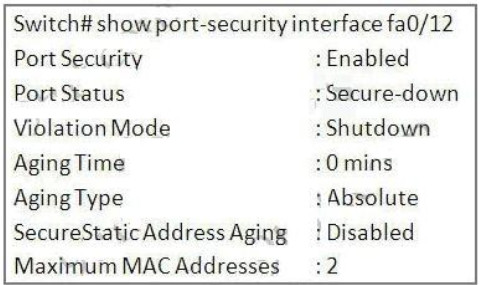
QUESTION 147
Refer to the exhibit. The following commands are executed on interface fa0/1 of 2950Switch.
2950Switch(config-if)# switchport port-security
2950Switch(config-if)# switchport port-security mac-address sticky
2950Switch(config-if)# switchport port-security maximum 1
The Ethernet frame that is shown arrives on interface fa0/1.
What two functions will occur when this frame is received by 2950Switch? (Choose two.)

A. The MAC address table will now have an additional entry of fa0/1 FFFF.FFFF.FFFF.
B. Only host A will be allowed to transmit frames on fa0/1.
C. This frame will be discarded when it is received by 2950Switch.
D. All frames arriving on 2950Switch with a destination of 0000.00aa.aaaa will be forwarded out fa0/1.
E. Hosts B and C may forward frames out fa0/1 but frames arriving from other switches will not be forwarded out fa0/1.
F. Only frames from source 0000.00bb.bbbb, the first learned MAC address of 2950Switch, will be forwarded out fa0/1.
Answer: BD
Explanation:
The configuration shown here is an example of port security, specifically port security using sticky addresses. You can use port security with dynamically learned and static MAC addresses to restrict a port’s ingress traffic by limiting the MAC addresses that are allowed to send traffic into the port. When you assign secure MAC addresses to a secure port, the port does not forward ingress traffic that has source addresses outside the group of defined addresses. If you limit the number of secure MAC addresses to one and assign a single secure MAC address, the device attached to that port has the full bandwidth of the port. Port security with sticky MAC addresses provides many of the same benefits as port security with static MAC addresses, but sticky MAC addresses can be learned dynamically. Port security with sticky MAC addresses retains dynamically learned MAC addresses during a link-down condition.
QUESTION 148
What will be the result if the following configuration commands are implemented on a Cisco switch?
Switch(config-if)# switchport port-security
Switch(config-if)# switchport port-security mac-address sticky
A. A dynamically learned MAC address is saved in the startup-configuration file.
B. A dynamically learned MAC address is saved in the running-configuration file.
C. A dynamically learned MAC address is saved in the VLAN database.
D. Statically configured MAC addresses are saved in the startup-configuration file if frames from that address are received.
E. Statically configured MAC addresses are saved in the running-configuration file if frames from that address are received.
Answer: B
Explanation:
In the interface configuration mode, the command switchport port-security mac-address sticky enables sticky learning. When entering this command, the interface converts all the dynamic secure MAC addresses to sticky secure MAC addresses.
QUESTION 149
The network administrator cannot connect to Switch1 over a Telnet session, although the hosts attached to Switch1 can ping the interface Fa0/0 of the router. Given the information in the graphic and assuming that the router and Switch2 are configured properly, which of the following commands should be issued on Switch1 to correct this problem?
A. Switch1(config)# line con0
Switch1(config-line)# password cisco
Switch1(config-line)#login
B. Switch1(config)# interface fa0/1
Switch1(config-if)# ip address 192.168.24.3 255.255.255.0
C. Switch1(config)# ip default-gateway 192.168.24.1
D. Switch1(config)# interface fa0/1
Switch1(config-if)# duplex full
Switch1(config-if)# speed 100
E. Switch1(config)# interface fa0/1
Switch1(config-if)# switchport mode trunk
Answer: C
Explanation:
Since we know hosts can reach the router through the switch, we know that connectivity, duplex.
Speed, etc. are good. However, for the switch itself to reach networks outside the local one, the ip default-gateway command must be used.
QUESTION 150
Refer to the exhibit. Which of these statements correctly describes the state of the switch once the boot process has been completed?
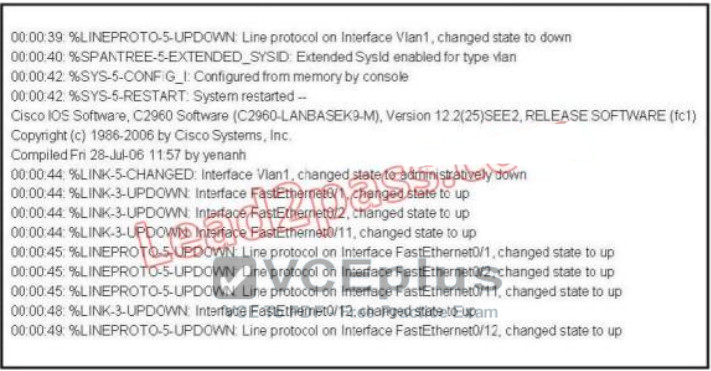
A. As FastEthernet0/12 will be the last to come up, it will be blocked by STP.
B. Remote access management of this switch will not be possible without configuration change.
C. More VLANs will need to be created for this switch.
D. The switch will need a different IOS code in order to support VLANs and STP.
Answer: B
Explanation:
Notice the line, which says “Interface VLAN1, changed state to administratively down”. This shows that VLAN1 is shut down. Hence remote management of this switch is not possible unless VLAN1 is brought back up. Since VLAN1 is the only interface shown in the output, you have to assume that no other VLAN interface has been configured with an IP Address.
QUESTION 151
Refer to exhibit. A network administrator cannot establish a Telnet session with the indicated router. What is the cause of this failure?
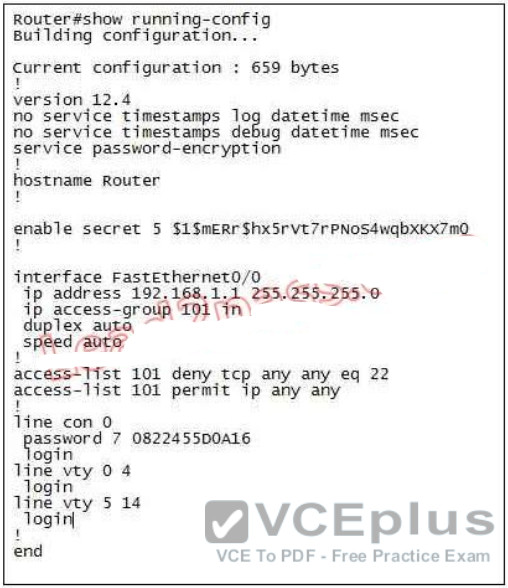
A. A Level 5 password is not set.
B. An ACL is blocking Telnet access.
C. The vty password is missing.
D. The console password is missing.
Answer: C
Explanation:
The login keyword has been set, but not password. This will result in the “password required, but none set” message to users trying to telnet to this router.
QUESTION 152
Refer to the exhibit. When running EIGRP, what is required for RouterA to exchange routing updates with RouterC?
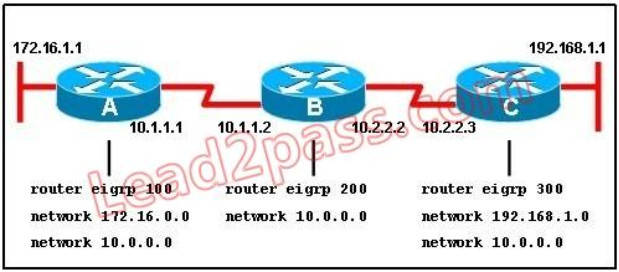
A. AS numbers must be changed to match on all the routers
B. Loopback interfaces must be configured so a DR is elected
C. The no auto-summary command is needed on Router A and Router C
D. Router B needs to have two network statements, one for each connected network
Answer: A
Explanation:
This QUESTION is to examine the understanding of the interaction between EIGRP routers. The following information must be matched so as to create neighborhood. EIGRP routers to establish, must match the following information:
1. AS Number;
2. K value.
QUESTION 153
A router has two Fast Ethernet interfaces and needs to connect to four VLANs in the local network. How can you accomplish this task, using the fewest physical interfaces and without decreasing network performance?
A. Use a hub to connect the four VLANS with a Fast Ethernet interface on the router.
B. Add a second router to handle the VLAN traffic.
C. Add two more Fast Ethernet interfaces.
D. Implement a router-on-a-stick configuration.
Answer: D
Explanation:
A router on a stick allows you to use sub-interfaces to create multiple logical networks on a single physical interface.
QUESTION 154
Users on the 172.17.22.0 network cannot reach the server located on the 172.31.5.0 network.
The network administrator connected to router Coffee via the console port, issued the show ip route command, and was able to ping the server.
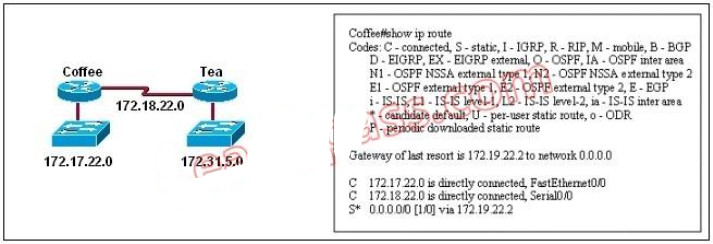
Based on the output of the show ip route command and the topology shown in the graphic, what is the cause of the failure?
A. The network has not fully converged.
B. IP routing is not enabled.
C. A static route is configured incorrectly.
D. The FastEthernet interface on Coffee is disabled.
E. The neighbor relationship table is not correctly updated.
F. The routing table on Coffee has not updated.
Answer: C
Explanation:
The default route or the static route was configured with incorrect next-hop ip address 172.19.22.2 The correct ip address will be 172.18.22.2 to reach server located on 172.31.5.0 network. Ip route 0.0.0.0 0.0.0.0 172.18.22.2
QUESTION 155
A network administrator is trying to add a new router into an established OSPF network. The networks attached to the new router do not appear in the routing tables of the other OSPF routers. Given the information in the partial configuration shown below, what configuration error is causing this problem?
Router(config)# router ospf 1
Router(config-router)# network 10.0.0.0 255.0.0.0 area 0
A. The process id is configured improperly.
B. The OSPF area is configured improperly.
C. The network wildcard mask is configured improperly.
D. The network number is configured improperly.
E. The AS is configured improperly.
F. The network subnet mask is configured improperly.
Answer: C
Explanation:
When configuring OSPF, the mask used for the network statement is a wildcard mask similar to an access list. In this specific example, the correct syntax would have been “network 10.0.0.0 0.0.0.255 area 0.”
QUESTION 156
Which Cisco Catalyst feature automatically disables the port in an operational PortFast upon receipt of a BPDU?
A. BackboneFast
B. UplinkFast
C. Root Guard
D. BPDU Guard
E. BPDU Filter
Answer: D
Explanation:
We only enable PortFast feature on access ports (ports connected to end stations). But if someone does not know he can accidentally plug that port to another switch and a loop may occur when BPDUs are being transmitted and received on these ports. With BPDU Guard, when a PortFast receives a BPDU, it will be shut down to prevent a loop.
QUESTION 157
When you are troubleshooting an ACL issue on a router, which command would you use to verify which interfaces are affected by the ACL?
A. show ip access-lists
B. show access-lists
C. show interface
D. show ip interface
E. list ip interface
Answer: D
Explanation:
Incorrect answer:
show ip access-lists does not show interfaces affected by an ACL.
QUESTION 158
Host 1 is trying to communicate with Host 2. The e0 interface on Router C is down. Which of the following are true? (Choose two.)
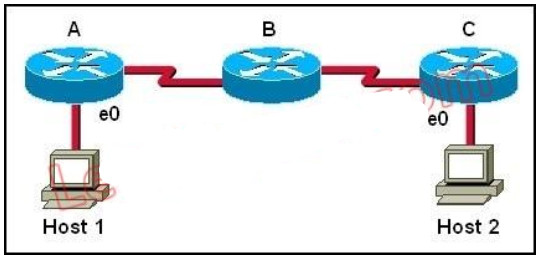
A. Router C will use ICMP to inform Host 1 that Host 2 cannot be reached.
B. Router C will use ICMP to inform Router B that Host 2 cannot be reached.
C. Router C will use ICMP to inform Host 1, Router A, and Router B that Host 2 cannot be reached.
D. Router C will send a Destination Unreachable message type.
E. Router C will send a Router Selection message type.
F. Router C will send a Source Quench message type.
Answer: AD
Explanation:
Host 1 is trying to communicate with Host 2. The e0 interface on Router C is down. Router C will send ICMP packets to inform Host 1 that Host 2 cannot be reached.
QUESTION 160
Cisco Catalyst switches CAT1 and CAT2 have a connection between them using ports FA0/13. An 802.1Q trunk is configured between the two switches. On CAT1, VLAN 10 is chosen as native, but on CAT2 the native VLAN is not specified. What will happen in this scenario?
A. 802.1Q giants frames could saturate the link.
B. VLAN 10 on CAT1 and VLAN 1 on CAT2 will send untagged frames.
C. A native VLAN mismatch error message will appear.
D. VLAN 10 on CAT1 and VLAN 1 on CAT2 will send tagged frames.
Answer: C
Explanation:
A “native VLAN mismatch” error will appear by CDP if there is a native VLAN mismatch on an 802.1Q link. “VLAN mismatch” can cause traffic from one vlan to leak into another vlan.
QUESTION 161
Refer to the exhibit. A network technician is asked to design a small network with redundancy.
The exhibit represents this design, with all hosts configured in the same VLAN. What conclusions can be made about this design?
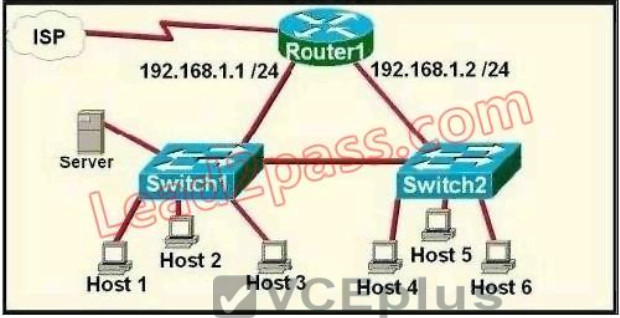
A. This design will function as intended.
B. Spanning-tree will need to be used.
C. The router will not accept the addressing scheme.
D. The connection between switches should be a trunk.
E. The router interfaces must be encapsulated with the 802.1Q protocol.
Answer: C
Explanation:
Each interface on a router must be in a different network. If two interfaces are in the same network, the router will not accept it and show error when the administrator assigns it.
QUESTION 162
Refer to the exhibit. A technician is troubleshooting host connectivity issues on the switches. The hosts in VLANs 10 and 15 on Sw11 are unable to communicate with hosts in the same VLANs on Sw12. Hosts in the Admin VLAN are able to communicate. The port-to-VLAN assignments are identical on the two switches. What could be the problem?
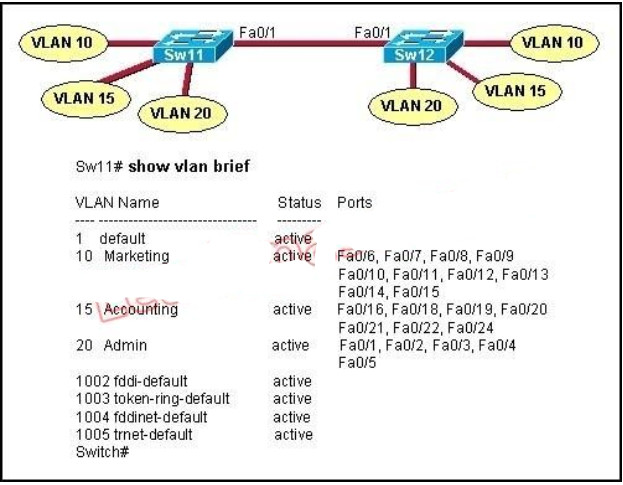
A. The Fa0/1 port is not operational on one of the switches.
B. The link connecting the switches has not been configured as a trunk.
C. At least one port needs to be configured in VLAN 1 for VLANs 10 and 15 to be able to communicate.
D. Port FastEthernet 0/1 needs to be configured as an access link on both switches.
E. A router is required for hosts on SW11 in VLANs 10 and 15 to communicate with hosts in the same VLAN on Sw12.
Answer: B
Explanation:
In order for hosts in the same VLAN to communicate with each other over multiple switches, those switches need to be configured as trunks on their connected interfaces so that they can pass traffic from multiple VLANs.
QUESTION 163
Refer to the exhibit. The Bigtime router is unable to authenticate to the Littletime router. What is the cause of the problem?

A. The usernames are incorrectly configured on the two routers.
B. The passwords do not match on the two routers.
C. CHAP authentication cannot be used on a serial interface.
D. The routers cannot be connected from interface S0/0 to interface S0/0.
E. With CHAP authentication, one router must authenticate to another router. The routers cannot be configured to authenticate to each other.
Answer: B
Explanation:
With CHAP authentication, the configured passwords must be identical on each router. Here, it is configured as little123 on one side and big123 on the other.
QUESTION 164
Refer to the exhibit. Given this output for SwitchC, what should the network administrator’s next action be?
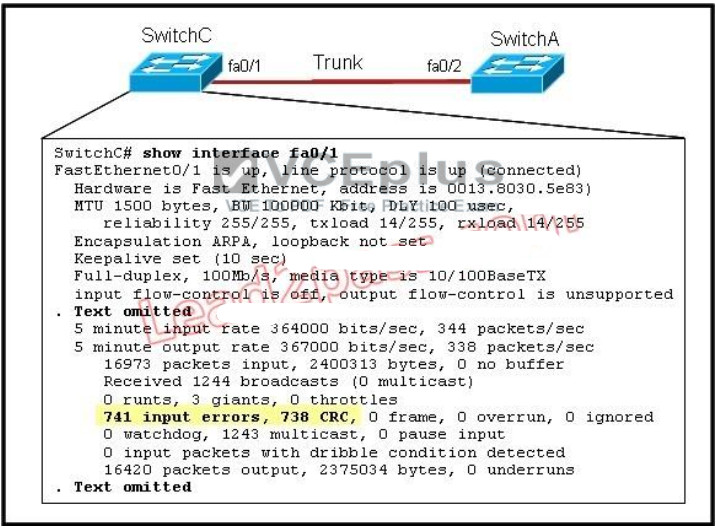
A. Check the trunk encapsulation mode for SwitchC’s fa0/1 port.
B. Check the duplex mode for SwitchC’s fa0/1 port.
C. Check the duplex mode for SwitchA’s fa0/2 port.
D. Check the trunk encapsulation mode for SwitchA’s fa0/2 port.
Answer: C
Explanation:
Here we can see that this port is configured for full duplex, so the next step would be to check the duplex setting of the port on the other switch. A mismatched trunk encapsulation would not result in input errors and CRC errors.
QUESTION 165
What will happen if a private IP address is assigned to a public interface connected to an ISP?
A. Addresses in a private range will be not be routed on the Internet backbone.
B. Only the ISP router will have the capability to access the public network.
C. The NAT process will be used to translate this address to a valid IP address.
D. A conflict of IP addresses happens, because other public routers can use the same range.
Answer: A
Explanation:
Private RFC 1918 IP addresses are meant to be used by organizations locally within their own network only, and can not be used globally for Internet use.
QUESTION 166
Refer to the exhibit. An attempt to deny web access to a subnet blocks all traffic from the subnet.
Which interface command immediately removes the effect of ACL 102?
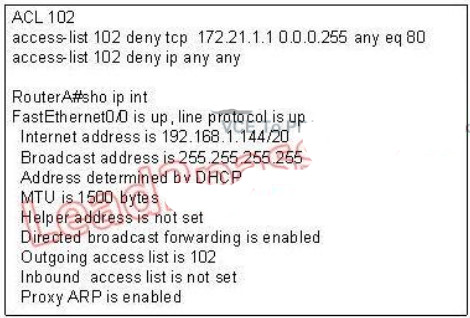
A. no ip access-class 102 in
B. no ip access-class 102 out
C. no ip access-group 102 in
D. no ip access-group 102 out
E. no ip access-list 102 in
Answer: D
Explanation:
Now let’s find out the range of the networks on serial link:
For the network 192.168.1.62/27:
Increment: 32
Network address: 192.168.1.32
Broadcast address: 192.168.1.63
For the network 192.168.1.65/27:
Increment: 32
Network address: 192.168.1.64
Broadcast address: 192.168.1.95
-> These two IP addresses don’t belong to the same network and they can’t see each other
QUESTION 167
Which router IOS commands can be used to troubleshoot LAN connectivity problems? (Choose three.)
A. ping
B. tracert
C. ipconfig
D. show ip route
E. winipcfg
F. show interfaces
Answer: ADF
Explanation:
Ping, show ip route, and show interfaces are all valid troubleshooting IOS commands. Tracert, ipconfig, and winipcfg are PC commands, not IOS.
QUESTION 168
A network administrator is troubleshooting the OSPF configuration of routers R1 and R2. The routers cannot establish an adjacency relationship on their common Ethernet link.
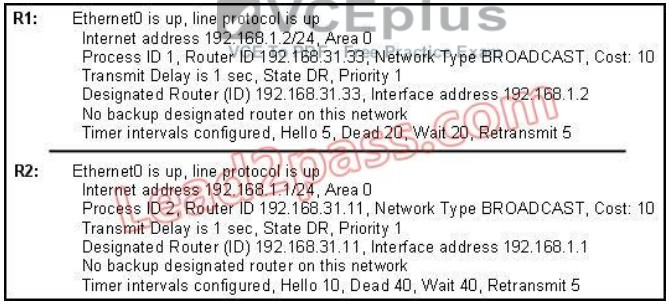
The graphic shows the output of the show ip ospf interface e0 command for routers R1 and R2. Based on the information in the graphic, what is the cause of this problem?
A. The OSPF area is not configured properly.
B. The priority on R1 should be set higher.
C. The cost on R1 should be set higher.
D. The hello and dead timers are not configured properly.
E. A backup designated router needs to be added to the network.
F. The OSPF process ID numbers must match.
Answer: D
Explanation:
In OSPF, the hello and dead intervals must match and here we can see the hello interval is set to 5 on R1 and 10 on R2. The dead interval is also set to 20 on R1 but it is 40 on R2.
QUESTION 169
In which circumstance are multiple copies of the same unicast frame likely to be transmitted in a switched LAN?
A. during high traffic periods
B. after broken links are re-established
C. when upper-layer protocols require high reliability
D. in an improperly implemented redundant topology
E. when a dual ring topology is in use
Answer: D
Explanation:
If we connect two switches via 2 or more links and do not enable STP on these switches then a loop (which creates multiple copies of the same unicast frame) will occur. It is an example of an improperly implemented redundant topology.
QUESTION 170
VLAN 3 is not yet configured on your switch. What happens if you set the switchport access vlan 3 command in interface configuration mode?
A. The command is rejected.
B. The port turns amber.
C. The command is accepted and the respective VLAN is added to vlan.dat.
D. The command is accepted and you must configure the VLAN manually.
Answer: C
Explanation:
The “switchport access vlan 3” will put that interface as belonging to VLAN 3 while also updated the VLAN database automatically to include VLAN 3.
QUESTION 171
A network administrator is troubleshooting an EIGRP problem on a router and needs to confirm the IP addresses of the devices with which the router has established adjacency. The retransmit interval and the queue counts for the adjacent routers also need to be checked. What command will display the required information?
A. Router# show ip eigrp adjacency
B. Router# show ip eigrp topology
C. Router# show ip eigrp interfaces
D. Router# show ip eigrp neighbors
Answer: D
Explanation:
Below is an example of the show ip eigrp neighbors command. The retransmit interval (Smooth Round Trip Timer – SRTT) and the queue counts (Q count, which shows the number of queued EIGRP packets) for the adjacent routers are listed:

QUESTION 172
Refer to the graphic. R1 is unable to establish an OSPF neighbor relationship with R3. What are possible reasons for this problem? (Choose two.)
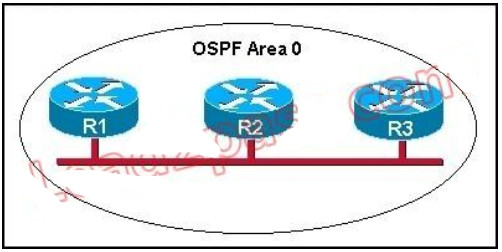
A. All of the routers need to be configured for backbone Area 1.
B. R1 and R2 are the DR and BDR, so OSPF will not establish neighbor adjacency with R3.
C. A static route has been configured from R1 to R3 and prevents the neighbor adjacency from being established.
D. The hello and dead interval timers are not set to the same values on R1 and R3.
E. EIGRP is also configured on these routers with a lower administrative distance.
F. R1 and R3 are configured in different areas.
Answer: DF
Explanation:
This QUESTION is to examine the conditions for OSPF to create neighborhood. So as to make the
two routers become neighbors, each router must be matched with the following items:
1. The area ID and its types;
2. Hello and failure time interval timer;
3. OSPF Password (Optional);
QUESTION 173
Refer to the exhibit. The network shown in the diagram is experiencing connectivity problems. Which of the following will correct the problems? (Choose two.)
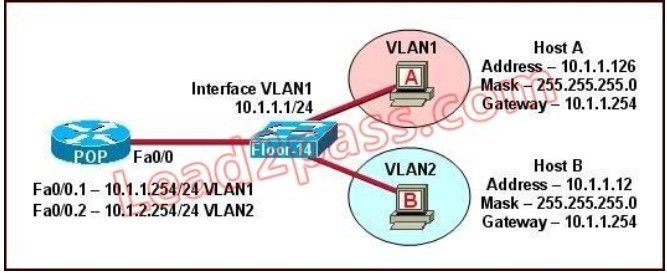
A. Configure the gateway on Host A as 10.1.1.1.
B. Configure the gateway on Host B as 10.1.2.254.
C. Configure the IP address of Host A as 10.1.2.2.
D. Configure the IP address of Host B as 10.1.2.2.
E. Configure the masks on both hosts to be 255.255.255.224.
F. Configure the masks on both hosts to be 255.255.255.240.
Answer: BD
Explanation:
The switch 1 is configured with two VLANs: VLAN1 and VLAN2. The IP information of member
Host A in VLAN1 is as follows:
Address : 10.1.1.126
Mask : 255.255.255.0
Gateway : 10.1.1.254
The IP information of member Host B in VLAN2 is as follows:
Address : 10.1.1.12
Mask : 255.255.255.0
Gateway : 10.1.1.254
The configuration of sub-interface on router 2 is as follows:
Fa0/0.1 — 10.1.1.254/24 VLAN1
Fa0/0.2 — 10.1.2.254/24 VLAN2
It is obvious that the configurations of the gateways of members in VLAN2 and the associated network segments are wrong. The layer3 addressing information of Host B should be modified as follows:
Address : 10.1.2.X
Mask : 255.255.255.0
QUESTION 174
Refer to the exhibit. A problem with network connectivity has been observed. It is suspected that the cable connected to switch port Fa0/9 on Switch1 is disconnected. What would be an effect of this cable being disconnected?
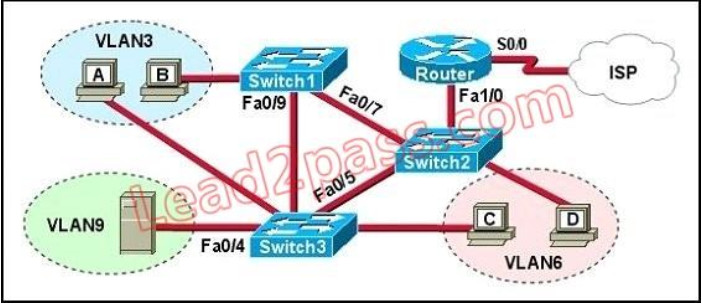
A. Host B would not be able to access the server in VLAN9 until the cable is reconnected.
B. Communication between VLAN3 and the other VLANs would be disabled.
C. The transfer of files from Host B to the server in VLAN9 would be significantly slower.
D. For less than a minute, Host B would not be able to access the server in VLAN9. Then normal network function would resume.
Answer: D
Explanation:
Spanning-Tree Protocol (STP) is a Layer 2 protocol that utilizes a special-purpose algorithm to discover physical loops in a network and effect a logical loop-free topology. STP creates a loopfree tree structure consisting of leaves and branches that span the entire Layer 2 network. The actual mechanics of how bridges communicate and how the STP algorithm works will be discussed at length in the following topics. Note that the terms bridge and switch are used interchangeably when discussing STP. In addition, unless otherwise indicated, connections between switches are assumed to be trunks.
QUESTION 175
Refer to the exhibit. HostA cannot ping HostB. Assuming routing is properly configured, what is the cause of this problem?
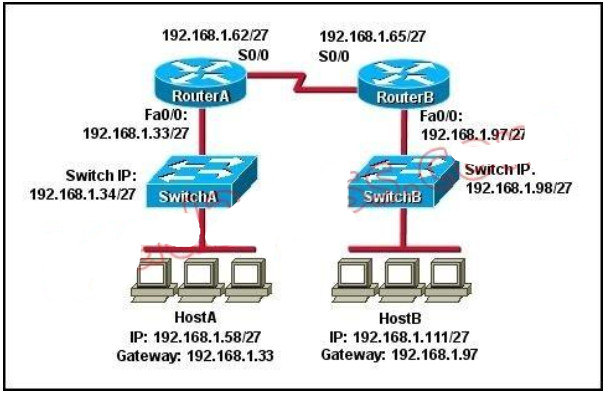
A. HostA is not on the same subnet as its default gateway.
B. The address of SwitchA is a subnet address.
C. The Fa0/0 interface on RouterA is on a subnet that can’t be used.
D. The serial interfaces of the routers are not on the same subnet.
E. The Fa0/0 interface on RouterB is using a broadcast address.
Answer: D
Explanation:
Now let’s find out the range of the networks on serial link:
For the network 192.168.1.62/27:
Increment: 32
Network address: 192.168.1.32
Broadcast address: 192.168.1.63
For the network 192.168.1.65/27:
Increment: 32
Network address: 192.168.1.64
Broadcast address: 192.168.1.95
-> These two IP addresses don’t belong to the same network and they can’t see each other
QUESTION 176
Which port state is introduced by Rapid-PVST?
A. learning
B. listening
C. discarding
D. forwarding
Answer: C
Explanation:
PVST+ is based on IEEE802.1D Spanning Tree Protocol (STP). But PVST+ has only 3 port states (discarding, learning and forwarding) while STP has 5 port states (blocking, listening, learning, forwarding and disabled). So discarding is a new port state in PVST+.
QUESTION 177
Refer to the exhibit. The two connected ports on the switch are not turning orange or green. What would be the most effective steps to troubleshoot this physical layer problem? (Choose three.)
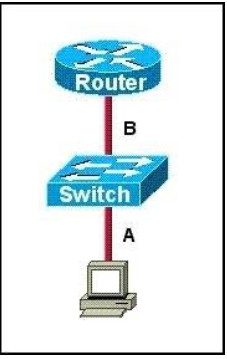
A. Ensure that the Ethernet encapsulations match on the interconnected router and switch ports.
B. Ensure that cables A and B are straight-through cables.
C. Ensure cable A is plugged into a trunk port.
D. Ensure the switch has power.
E. Reboot all of the devices.
F. Reseat all cables.
Answer: BDF
Explanation:
The ports on the switch are not up indicating it is a layer 1 (physical) problem so we should check cable type, power and how they are plugged in.
QUESTION 178
Refer to the exhibit. A network administrator attempts to ping Host2 from Host1 and receives the results that are shown. What is the problem?
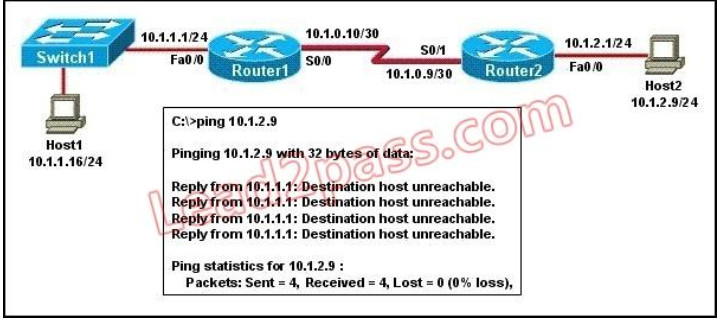
A. The link between Host1 and Switch1 is down.
B. TCP/IP is not functioning on Host1
C. The link between Router1 and Router2 is down.
D. The default gateway on Host1 is incorrect.
E. Interface Fa0/0 on Router1 is shutdown.
F. The link between Switch1 and Router1 is down.
Answer: C
Explanation:
Host1 tries to communicate with Host2. The message destination host unreachable from Router1 indicates that the problem occurs when the data is forwarded from Host1 to Host2. According to the topology, we can infer that The link between Router1 and Router2 is down.
QUESTION 179
Refer to the exhibit. Hosts in network 192.168.2.0 are unable to reach hosts in network 192.168.3.0. Based on the output from RouterA, what are two possible reasons for the failure? (Choose two.)
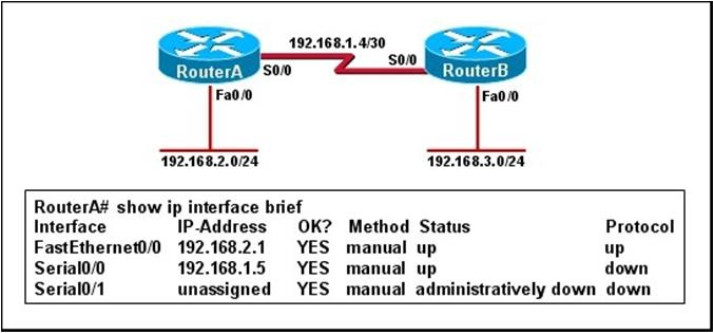
A. The cable that is connected to S0/0 on RouterA is faulty.
B. Interface S0/0 on RouterB is administratively down.
C. Interface S0/0 on RouterA is configured with an incorrect subnet mask.
D. The IP address that is configured on S0/0 of RouterB is not in the correct subnet.
E. Interface S0/0 on RouterA is not receiving a clock signal from the CSU/DSU.
F. The encapsulation that is configured on S0/0 of RouterB does not match the encapsulation that is configured on S0/0 of RouterA
Answer: EF
Explanation:
From the output we can see that there is a problem with the Serial 0/0 interface. It is enabled, but the line protocol is down. The could be a result of mismatched encapsulation or the interface not receiving a clock signal from the CSU/DSU.
QUESTION 180
Refer to the exhibit. An administrator pings the default gateway at 10.10.10.1 and sees the output as shown. At which OSI layer is the problem?

A. data link layer
B. application layer
C. access layer
D. session layer
E. network layer
Answer: E
Explanation:
The command ping uses ICMP protocol, which is a network layer protocol used to propagate control message between host and router. The command ping is often used to verify the network connectivity, so it works at the network layer.
QUESTION 181
Which statement is correct regarding the operation of DHCP?
A. A DHCP client uses a ping to detect address conflicts.
B. A DHCP server uses a gratuitous ARP to detect DHCP clients.
C. A DHCP client uses a gratuitous ARP to detect a DHCP server.
D. If an address conflict is detected, the address is removed from the pool and an administrator must resolve the conflict.
E. If an address conflict is detected, the address is removed from the pool for an amount of time configurable by the administrator.
F. If an address conflict is detected, the address is removed from the pool and will not be reused until the server is rebooted.
Answer: D
Explanation:
An address conflict occurs when two hosts use the same IP address. During address assignment, DHCP checks for conflicts using ping and gratuitous ARP. If a conflict is detected, the address is removed from the pool. The address will not be assigned until the administrator resolves the conflict.
http://www.cisco.com/en/US/docs/ios/12_1/iproute/configuration/guide/1cddhcp.html
QUESTION 182
Refer to the exhibit. Statements A, B, C, and D of ACL 10 have been entered in the shown order and applied to interface E0 inbound, to prevent all hosts (except those whose addresses are the first and last IP of subnet 172.21.1.128/28) from accessing the network. But as is, the ACL does not restrict anyone from the network. How can the ACL statements be re-arranged so that the system works as intended?
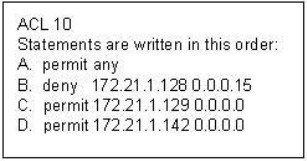
A. ACDB
B. BADC
C. DBAC
D. CDBA
Answer: D
Explanation:
Routers go line by line through an access list until a match is found and then will not look any further, even if a more specific of better match is found later on in the access list. So, it it best to begin with the most specific entries first, in this cast the two hosts in line C and D. Then, include the subnet (B) and then finally the rest of the traffic (A).
QUESTION 183
The output of the show frame-relay pvc command shows “PVC STATUS = INACTIVE”. What does this mean?
A. The PVC is configured correctly and is operating normally, but no data packets have been detected for more than five minutes.
B. The PVC is configured correctly, is operating normally, and is no longer actively seeking the address of the remote router.
C. The PVC is configured correctly, is operating normally, and is waiting for interesting traffic to trigger a call to the remote router.
D. The PVC is configured correctly on the local switch, but there is a problem on the remote end of the PVC.
E. The PVC is not configured on the local switch.
Answer: D
Explanation:
The PVC STATUS displays the status of the PVC. The DCE device creates and sends the report to the DTE devices. There are 4 statuses:
+ ACTIVE: the PVC is operational and can transmit data + INACTIVE: the connection from the local router to the switch is working, but the connection to the remote router is not available + DELETED: the PVC is not present and no LMI information is being received from the Frame Relay switch
+ STATIC: the Local Management Interface (LMI) mechanism on the interface is disabled (by using the “no keepalive” command). This status is rarely seen so it is ignored in some books.
QUESTION 184
Which command is used to enable CHAP authentication, with PAP as the fallback method, on a serial interface?
A. Router(config-if)# ppp authentication chap fallback ppp
B. Router(config-if)# ppp authentication chap pap
C. Router(config-if)# authentication ppp chap fallback ppp
D. Router(config-if)# authentication ppp chap pap
Answer: B
Explanation:
This command tells the router to first use CHAP and then go to PAP if CHAP isn’t available.
QUESTION 185
Which protocol is an open standard protocol framework that is commonly used in VPNs, to provide secure end-to-end communications?
A. RSA
B. L2TP
C. IPsec
D. PPTP
Answer: C
Explanation:
IPSec is a framework of open standards that provides data confidentiality, data integrity, and data authentication between participating peers at the IP layer. IPSec can be used to protect one or more data flows between IPSec peers.
QUESTION 186
At which layer of the OSI model does PPP perform?
A. Layer 2
B. Layer 3
C. Layer 4
D. Layer 5
Answer: A
Explanation:
The Point-to-Point Protocol (PPP) provides a standard method for transporting multi-protocol datagrams over point-to-point links. PPP was originally emerged as an encapsulation protocol for transporting IP traffic between two peers. It is a data link layer protocol (layer 2 in the OSI model)
QUESTION 187
The command frame-relay map ip 10.121.16.8 102 broadcast was entered on the router. Which of the following statements is true concerning this command?
A. This command should be executed from the global configuration mode.
B. The IP address 10.121.16.8 is the local router port used to forward data.
C. 102 is the remote DLCI that will receive the information.
D. This command is required for all Frame Relay configurations.
E. The broadcast option allows packets, such as RIP updates, to be forwarded across the PVC.
Answer: E
Explanation:
Broadcast is added to the configurations of the frame relay, so the PVC supports broadcast, allowing the routing protocol updates that use the broadcast update mechanism to be forwarded across itself.
QUESTION 188
Which two options are valid WAN connectivity methods? (Choose two.)
A. PPP
B. WAP
C. DSL
D. L2TPv3
E. Ethernet
Answer: AC
Explanation:
The Point-to-Point Protocol (PPP) provides a standard method for transporting multi-protocol datagrams over point-to-point links. PPP was originally emerged as an encapsulation protocol for transporting IP traffic between two peers. It is a data link layer protocol used for WAN connections.
DSL is also considered a WAN connection, as it can be used to connect networks, typically when used with VPN technology.
QUESTION 189
Which Layer 2 protocol encapsulation type supports synchronous and asynchronous circuits and has built-in security mechanisms?
A. HDLC
B. PPP
C. X.25
D. Frame Relay
Answer: B
Explanation:
PPP: Provides router-to-router and host-to-network connections over synchronous and asynchronous circuits. PPP was designed to work with several network layer protocols, including IP. PPP also has built-in security mechanisms, such as Password Authentication Protocol (PAP) and Challenge Handshake Authentication Protocol (CHAP).
QUESTION 190
Which encapsulation type is a Frame Relay encapsulation type that is supported by Cisco routers?
A. IETF
B. ANSI Annex D
C. Q9333-A Annex A
D. HDLC
Answer: A
Explanation:
Cisco supports two Frame Relay encapsulation types: the Cisco encapsulation and the IETF Frame Relay encapsulation, which is in conformance with RFC 1490 and RFC 2427. The former is often used to connect two Cisco routers while the latter is used to connect a Cisco router to a non-Cisco router. You can test with your Cisco router when typing the command Router(configif)# encapsulation frame-relay ? on a WAN link. Below is the output of this command (notice Cisco is the default encapsulation so it is not listed here, just press Enter to use it).

Note: Three LMI options are supported by Cisco routers are ansi, Cisco, and Q933a. They represent the ANSI Annex D, Cisco, and ITU Q933-A (Annex A) LMI types, respectively. HDLC is a WAN protocol same as Frame-Relay and PPP so it is not a Frame Relay encapsulation type.
QUESTION 191
RouterA is unable to reach RouterB. Both routers are running IOS version 12.0. After reviewing the command output and graphic, what is the most likely cause of the problem?

A. incorrect bandwidth configuration
B. incorrect LMI configuration
C. incorrect map statement
D. incorrect IP address
Answer: C
Explanation:
First we have to say this is an unclear QUESTION and it is wrong. The “frame-relay map ip” statement is correct thus none of the four answers above is correct. But we guess there is a typo in the output. Maybe the “ip address 172.16.100.2 255.255.0.0 command should be “ip address 172.16.100.1 255.255.0.0.
QUESTION 192
Refer to the exhibit. What is the meaning of the term dynamic as displayed in the output of the show frame-relay map command shown?

A. The Serial0/0 interface is passing traffic.
B. The DLCI 100 was dynamically allocated by the router.
C. The Serial0/0 interface acquired the IP address of 172.16.3.1 from a DHCP server.
D. The DLCI 100 will be dynamically changed as required to adapt to changes in the Frame Relay cloud.
E. The mapping between DLCI 100 and the end station IP address 172.16.3.1 was learned through Inverse ARP.
Answer: E
Explanation:
Inverse Address Resolution Protocol (Inverse ARP) was developed to provide a mechanism for dynamic DLCI to Layer 3 address maps. Inverse ARP works much the same way Address Resolution Protocol (ARP) works on a LAN. However, with ARP, the device knows the Layer 3 IP address and needs to know the remote data link MAC address. With Inverse ARP, the router knows the Layer 2 address which is the DLCI, but needs to know the remote Layer 3 IP address.
When using dynamic address mapping, Inverse ARP requests a next-hop protocol address for each active PVC. Once the requesting router receives an Inverse ARP response, it updates its DLCI-to-Layer 3 address mapping table. Dynamic address mapping is enabled by default for all protocols enabled on a physical interface. If the Frame Relay environment supports LMI autosensing and Inverse ARP, dynamic address mapping takes place automatically. Therefore, no static address mapping is required.
QUESTION 193
A network administrator needs to configure a serial link between the main office and a remote location. The router at the remote office is a non-Cisco router. How should the network administrator configure the serial interface of the main office router to make the connection?
A. Main(config)# interface serial 0/0
Main(config-if)# ip address 172.16.1.1 255.255.255.252
Main(config-if)# no shut
B. Main(config)# interface serial 0/0
Main(config-if)# ip address 172.16.1.1 255.255.255.252
Main(config-if)# encapsulation ppp
Main(config-if)# no shut
C. Main(config)# interface serial 0/0
Main(config-if)# ip address 172.16.1.1 255.255.255.252
Main(config-if)# encapsulation frame-relay
Main(config-if)# authentication chap
Main(config-if)# no shut
D. Main(config)# interface serial 0/0
Main(config-if)#ip address 172.16.1.1 255.255.255.252
Main(config-if)#encapsulation ietf
Main(config-if)# no shut
Answer: B
Explanation:
With serial point to point links there are two options for the encapsulation. The default, HDLC, is Cisco proprietary and works only with other Cisco routers. The other option is PPP which is standards based and supported by all vendors.
QUESTION 194
What are three reasons that an organization with multiple branch offices and roaming users might implement a Cisco VPN solution instead of point-to-point WAN links? (Choose three.)
A. reduced cost
B. better throughput
C. broadband incompatibility
D. increased security
E. scalability
F. reduced latency
Answer: ADE
Explanation:
IPsec offer a number of advantages over point to point WAN links, particularly when multiple locations are involved. These include reduced cost, increased security since all traffic is encrypted, and increased scalability as s single WAN link can be used to connect to all locations in a VPN, where as a point to point link would need to be provisioned to each location.
QUESTION 195
Which two statistics appear in show frame-relay map output? (Choose two.)
A. the number of BECN packets that are received by the router
B. the value of the local DLCI
C. the number of FECN packets that are received by the router
D. the status of the PVC that is configured on the router
E. the IP address of the local router
Answer: BD
Explanation:
Sample “show frame-relay map” output:
R1#sh frame mapSerial0/0 (up): ip 10.4.4.1 dlci 401(0x191,0x6410), dynamic,broadcast,, status
defined, activeSerial0/0 (up): ip 10.4.4.3 dlci 403(0x193,0x6430), dynamic,broadcast,, status
defined, activeSerial0/0 (up): ip 10.4.4.4 dlci 401(0x191,0x6410), static,CISCO, status defined,
active
QUESTION 196
Users have been complaining that their Frame Relay connection to the corporate site is very slow. The network administrator suspects that the link is overloaded.
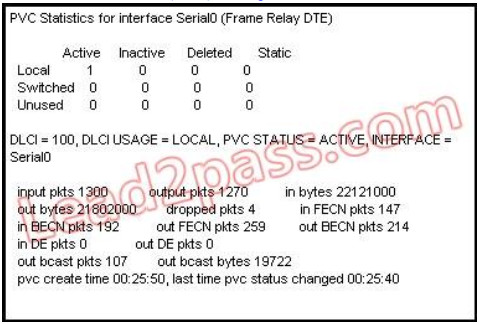
Based on the partial output of the Router# show frame relay pvc command shown in the graphic, which output value indicates to the local router that traffic sent to the corporate site is experiencing congestion?
A. DLCI = 100
B. last time PVC status changed 00:25:40
C. in BECN packets 192
D. in FECN packets 147
E. in DE packets 0
Answer: C
Explanation:
If device A is sending data to device B across a Frame Relay infrastructure and one of the intermediate Frame Relay switches encounters congestion, congestion being full buffers, oversubscribed port, overloaded resources, etc, it will set the BECN bit on packets being returned to the sending device and the FECN bit on the packets being sent to the receiving device.
QUESTION 197
Which command allows you to verify the encapsulation type (CISCO or IETF) for a Frame Relay link?
A. show frame-relay lmi
B. show frame-relay map
C. show frame-relay pvc
D. show interfaces serial
Answer: B
Explanation:
When connecting Cisco devices with non-Cisco devices, you must use IETF4 encapsulation on both devices. Check the encapsulation type on the Cisco device with the show frame-relay map exec command.
QUESTION 198
It has become necessary to configure an existing serial interface to accept a second Frame Relay virtual circuit. Which of the following procedures are required to accomplish this task? (Choose three.)
A. Remove the IP address from the physical interface.
B. Encapsulate the physical interface with multipoint PPP.
C. Create the virtual interfaces with the interface command.
D. Configure each subinterface with its own IP address.
E. Disable split horizon to prevent routing loops between the subinterface networks.
F. Configure static Frame Relay map entries for each subinterface network.
Answer: ACD
Explanation:
For multiple PVC’s on a single interface, you must use subinterfaces, with each subinterface configured for each PVC. Each subinterface will then have its own IP address, and no IP address will be assigned to the main interface.
QUESTION 199
What occurs on a Frame Relay network when the CIR is exceeded?
A. All TCP traffic is marked discard eligible.
B. All UDP traffic is marked discard eligible and a BECN is sent.
C. All TCP traffic is marked discard eligible and a BECN is sent.
D. All traffic exceeding the CIR is marked discard eligible.
Answer: D
Explanation:
Committed information rate (CIR): The minimum guaranteed data transfer rate agreed to by the Frame Relay switch. Frames that are sent in excess of the CIR are marked as discard eligible (DE) which means they can be dropped if the congestion occurs within the Frame Relay network.
Note: In the Frame Relay frame format, there is a bit called Discard eligible (DE) bit that is used to identify frames that are first to be dropped when the CIR is exceeded.
QUESTION 200
Which two statements about using the CHAP authentication mechanism in a PPP link are true? (Choose two.)
A. CHAP uses a two-way handshake.
B. CHAP uses a three-way handshake.
C. CHAP authentication periodically occurs after link establishment.
D. CHAP authentication passwords are sent in plaintext.
E. CHAP authentication is performed only upon link establishment.
F. CHAP has no protection from playback attacks.
Answer: BC
Explanation:
CHAP is an authentication scheme used by Point to Point Protocol (PPP) servers to validate the identity of remote clients. CHAP periodically verifies the identity of the client by using a three-way handshake. This happens at the time of establishing the initial link (LCP), and may happen again at any time afterwards. The verification is based on a shared secret (such as the client user’s password).
QUESTION 201
Refer to the exhibit. Which statement describes DLCI 17?
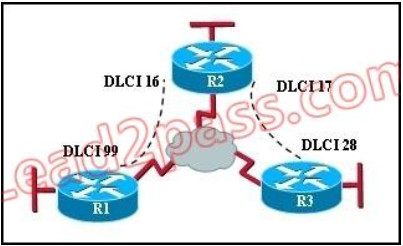
A. DLCI 17 describes the ISDN circuit between R2 and R3.
B. DLCI 17 describes a PVC on R2. It cannot be used on R3 or R1.
C. DLCI 17 is the Layer 2 address used by R2 to describe a PVC to R3.
D. DLCI 17 describes the dial-up circuit from R2 and R3 to the service provider.
Answer: C
Explanation:
DLCI-Data Link Connection Identifier Bits: The DLCI serves to identify the virtual connection so that the receiving end knows which information connection a frame belongs to. Note that this DLCI has only local significance. Frame Relay is strictly a Layer 2 protocol suite.
QUESTION 202
What is the result of issuing the frame-relay map ip 192.168.1.2 202 broadcast command?
A. defines the destination IP address that is used in all broadcast packets on DCLI 202
B. defines the source IP address that is used in all broadcast packets on DCLI 202
C. defines the DLCI on which packets from the 192.168.1.2 IP address are received
D. defines the DLCI that is used for all packets that are sent to the 192.168.1.2 IP address
Answer: D
Explanation:
This command identifies the DLCI that should be used for all packets destined to the 192.168.1.2 address. In this case, DLCI 202 should be used.
QUESTION 203
Which PPP subprotocol negotiates authentication options?
A. NCP
B. ISDN
C. SLIP
D. LCP
E. DLCI
Answer: D
Explanation:
The PPP Link Control Protocol (LCP) is documented in RFC 1661. LPC negotiates link and PPP parameters to dynamically configure the data link layer of a PPP connection. Common LCP options include the PPP MRU, the authentication protocol, compression of PPP header fields, callback, and multilink options.
QUESTION 204
What are two characteristics of Frame Relay point-to-point subinterfaces? (Choose two.)
A. They create split-horizon issues.
B. They require a unique subnet within a routing domain.
C. They emulate leased lines.
D. They are ideal for full-mesh topologies.
E. They require the use of NBMA options when using OSPF.
Answer: BC
Explanation:
Subinterfaces are used for point to point frame relay connections, emulating virtual point to point leased lines. Each subinterface requires a unique IP address/subnet. Remember, you can not assign multiple interfaces in a router that belong to the same IP subnet.
QUESTION 205
What command is used to verify the DLCI destination address in a Frame Relay static configuration?
A. show frame-relay pvc
B. show frame-relay lmi
C. show frame-relay map
D. show frame relay end-to-end
Answer: C
Explanation:
Sample “show frame-relay map” output:
R1#sh frame mapSerial0/0 (up): ip 10.4.4.1 dlci 401(0x191,0x6410), dynamic,broadcast,, status
defined, activeSerial0/0 (up): ip 10.4.4.3 dlci 403(0x193,0x6430), dynamic,broadcast,, status
defined, activeSerial0/0 (up): ip 10.4.4.4 dlci 401(0x191,0x6410), static,CISCO, status defined,
active
QUESTION 206
What is the purpose of Inverse ARP?
A. to map a known IP address to a MAC address
B. to map a known DLCI to a MAC address
C. to map a known MAC address to an IP address
D. to map a known DLCI to an IP address
E. to map a known IP address to a SPID
F. to map a known SPID to a MAC address
Answer: D
Explanation:
Dynamic address mapping relies on the Frame Relay Inverse Address Resolution Protocol (Inverse ARP), defined by RFC 1293, to resolve a next hop network protocol (IP) address to a local DLCI value. The Frame Relay router sends out Inverse ARP requests on its Frame Relay PVC to discover the protocol address of the remote device connected to the Frame Relay network. The responses to the Inverse ARP requests are used to populate an address-to-DLCI mapping table on the Frame Relay router or access server. The router builds and maintains this address-to- DLCI mapping table, which contains all resolved Inverse ARP requests, including both dynamic and static mapping entries.
QUESTION 207
Two routers named Atlanta and Brevard are connected via their serial interfaces as illustrated, but they are unable to communicate. The Atlanta router is known to have the correct configuration.
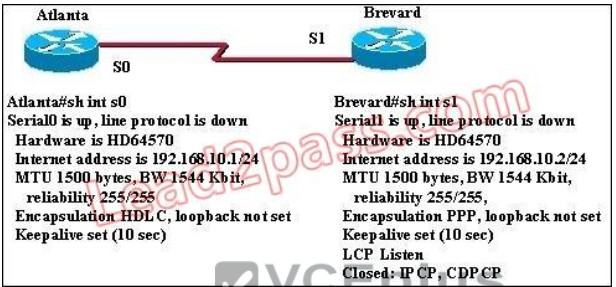
Given the partial configurations, identify the fault on the Brevard router that is causing the lack of connectivity.
A. incompatible IP address
B. insufficient bandwidth
C. incorrect subnet mask
D. incompatible encapsulation
E. link reliability too low
F. IPCP closed
Answer: D
Explanation:
The correct explanation should be that the Atlanta router is usng HDLC while the Brevard is using PPP. These need to match on both ends.
QUESTION 208
Refer to the exhibit. The company uses EIGRP as the routing protocol. What path will packets take from a host on the 192.168.10.192/26 network to a host on the LAN attached to router R1?
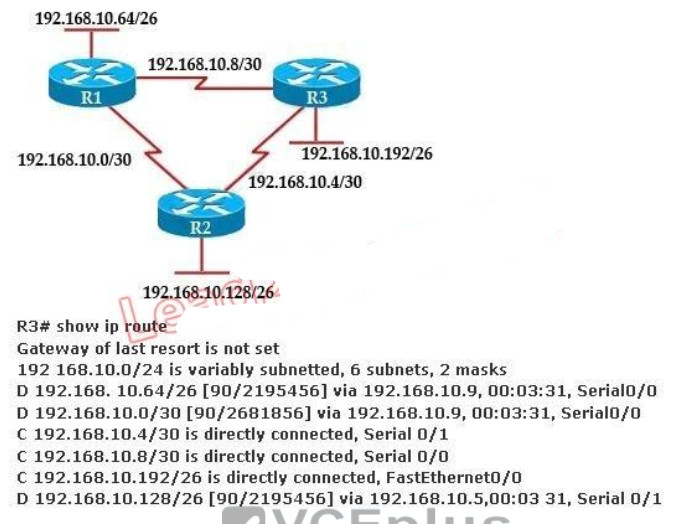
A. The path of the packets will be R3 to R2 to R1.
B. The path of the packets will be R3 to R1 to R2.
C. The path of the packets will be both R3 to R2 to R1 AND R3 to R1.
D. The path of the packets will be R3 to R1.
Answer: D
Explanation:
Host on the LAN attached to router R1 belongs to 192.168.10.64/26 subnet. From the output of the routing table of R3 we learn this network can be reach via 192.168.10.9, which is an IP address in 192.168.10.8/30 network (the network between R1 & R3) -> packets destined for 192.168.10.64 will be routed from R3 -> R1 -> LAN on R1.
QUESTION 209
How does using the service password-encryption command on a router provide additional security?
A. by encrypting all passwords passing through the router
B. by encrypting passwords in the plain text configuration file
C. by requiring entry of encrypted passwords for access to the device
D. by configuring an MD5 encrypted key to be used by routing protocols to validate routing exchanges
E. by automatically suggesting encrypted passwords for use in configuring the router
Answer: B
Explanation:
By using this command, all the (current and future) passwords are encrypted. This command is primarily useful for keeping unauthorized individuals from viewing your password in your configuration file
QUESTION 210
Refer to the exhibit. Switch port FastEthernet 0/24 on ALSwitch1 will be used to create an IEEE 802.1Q-compliant trunk to another switch. Based on the output shown, what is the reason the trunk does not form, even though the proper cabling has been attached?
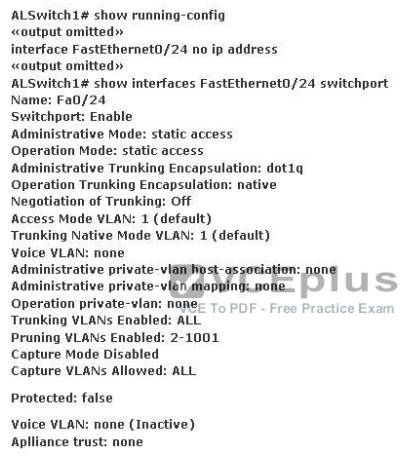
A. VLANs have not been created yet.
B. An IP address must be configured for the port.
C. The port is currently configured for access mode.
D. The correct encapsulation type has not been configured.
E. The no shutdown command has not been entered for the port.
Answer: C
Explanation:
According to the output shown the switchport (layer 2 Switching) is enabled and the port is in access mode. To make a trunk link the port should configured as a trunk port, not an access port, by using the following command:
(Config-if)#switchport mode trunk
QUESTION 211
Refer to the exhibit. In the Frame Relay network, which IP addresses would be assigned to the interfaces with point-to- point PVCs?
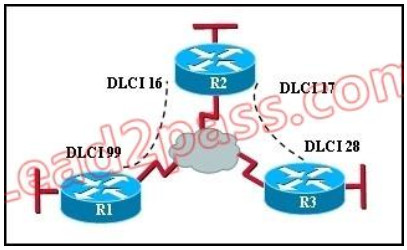
A. DLCI 16: 192.168.10.1 /24
DLCI 17: 192.168.10.1 /24
DLCI 99: 192.168.10.2 /24
DLCI 28: 192.168.10.3 /24
B. DLCI 16: 192.168.10.1 /24
DLCI 17: 192.168.11.1 /24
DLCI 99: 192.168.12.1 /24
DLCI 28: 192.168.13.1 /24
C. DLCI 16: 192.168.10.1 /24
DLCI 17: 192.168.11.1 /24
DLCI 99: 192.168.10.2 /24
DLCI 28: 192.168.11.2 /24
D. DLCI 16: 192.168.10.1 /24
DLCI 17: 192.168.10.2 /24
DLCI 99: 192.168.10.3 /24
DLCI 28: 192.168.10.4 /24
Answer: C
Explanation:
With point to point PVC, each connection needs to be in a separate subnet. The R2-R1 connection (DLCI 16 to 99) would have each router within the same subnet. Similarly, the R3-R1 connection would also be in the same subnet, but it must be in a different one than the R2-R1 connection.
QUESTION 212
Refer to the exhibit. A new subnet with 60 hosts has been added to the network. Which subnet address should this network use to provide enough usable addresses while wasting the fewest addresses?

A. 192.168.1.56/26
B. 192.168.1.56/27
C. 192.168.1.64/26
D. 192.168.1.64/27
Answer: C
Explanation:
A subnet with 60 host is 2*2*2*2*2*2 = 64 -2 == 62
6 bits needed for hosts part. Therefore subnet bits are 2 bits (8-6) in fourth octet.
8bits+ 8bits+ 8bits + 2bits = /26
/26 bits subnet is 24bits + 11000000 = 24bits + 192
256 -192 = 64
0 – 63
64 – 127
QUESTION 213
Refer to the exhibit. All of the routers in the network are configured with the ip subnet-zero command. Which network addresses should be used for Link A and Network A? (Choose two.)
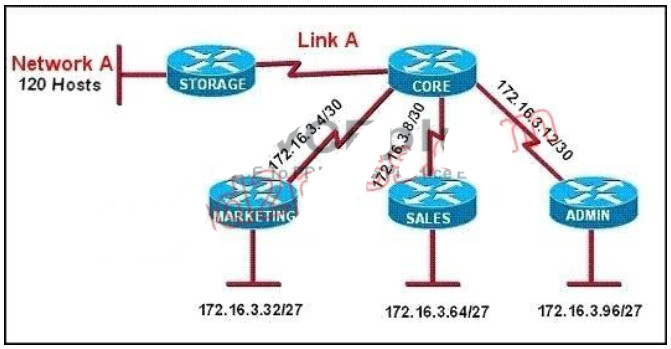
A. Network A – 172.16.3.48/26
B. Network A – 172.16.3.128/25
C. Network A – 172.16.3.192/26
D. Link A – 172.16.3.0/30
E. Link A – 172.16.3.40/30
F. Link A – 172.16.3.112/30
Answer: BD
Explanation:
Only a /30 is needed for the point to point link and sine the use of the ip subnet-zero was used, 172.16.3.0/30 is valid. Also, a /25 is required for 120 hosts and again 172.16.3.128/25 is the best, valid option.
QUESTION 214
A router has learned three possible routes that could be used to reach a destination network. One route is from EIGRP and has a composite metric of 20514560. Another route is from OSPF with a metric of 782. The last is from RIPv2 and has a metric of 4. Which route or routes will the router install in the routing table?
A. the OSPF route
B. the EIGRP route
C. the RIPv2 route
D. all three routes
E. the OSPF and RIPv2 routes
Answer: B
Explanation:
When one route is advertised by more than one routing protocol, the router will choose to use the routing protocol which has lowest Administrative Distance. The Administrative Distances of popular routing protocols are listed below:
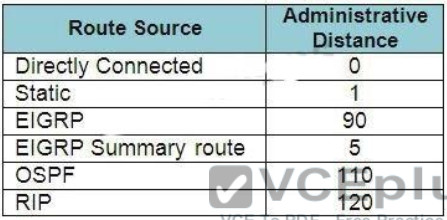
QUESTION 215
A network administrator needs to allow only one Telnet connection to a router. For anyone viewing the configuration and issuing the show run command, the password for Telnet access should be encrypted. Which set of commands will accomplish this task?
A. service password-encryption
access-list 1 permit 192.168.1.0 0.0.0.255
line vty 0 4
login
password cisco
access-class 1
B. enable password secret
line vty 0
login
password cisco
C. service password-encryption
line vty 1
login
password cisco
D. service password-encryption
line vty 0 4
login
password cisco
Answer: C
Explanation:
Only one VTY connection is allowed which is exactly what’s requested.
Incorrect Answer: command.
line vty0 4
would enable all 5 vty connections.
QUESTION 216
Refer to the exhibit. The speed of all serial links is E1 and the speed of all Ethernet links is 100 Mb/s. A static route will be established on the Manchester router to direct traffic toward the Internet over the most direct path available. What configuration on the Manchester router will establish a route toward the Internet for traffic that originates from workstations on the Manchester LAN?
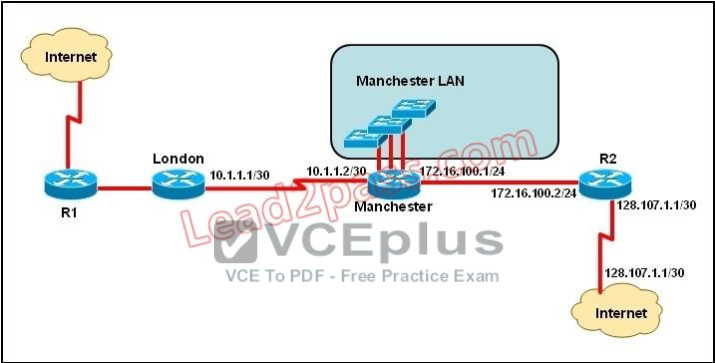
A. ip route 0.0.0.0 255.255.255.0 172.16.100.2
B. ip route 0.0.0.0 0.0.0.0 128.107.1.1
C. ip route 0.0.0.0 255.255.255.252 128.107.1.1
D. ip route 0.0.0.0 0.0.0.0 172.16.100.1
E. ip route 0.0.0.0 0.0.0.0 172.16.100.2
F. ip route 0.0.0.0 255.255.255.255 172.16.100.2
Answer: E
Explanation:
We use default routing to send packets with a remote destination network not in the routing table to the next-hop router. You should generally only use default routing on stub networks–those with only one exit path out of the network.
According to exhibit, all traffic towards Internet that originates from workstations should forward to Router R1.
Syntax for default route is:
ip route
QUESTION 217
Refer to the exhibit. The network administrator must establish a route by which London workstations can forward traffic to the Manchester workstations. What is the simplest way to accomplish this?
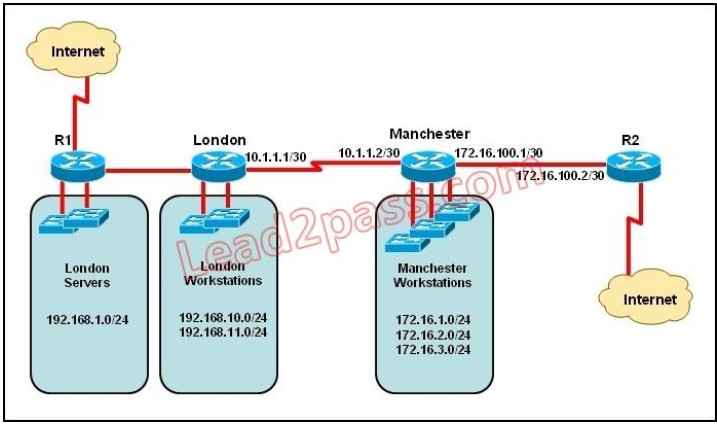
A. Configure a dynamic routing protocol on London to advertise all routes to Manchester.
B. Configure a dynamic routing protocol on London to advertise summarized routes to Manchester.
C. Configure a dynamic routing protocol on Manchester to advertise a default route to the London router.
D. Configure a static default route on London with a next hop of 10.1.1.1.
E. Configure a static route on London to direct all traffic destined for 172.16.0.0/22 to 10.1.1.2.
F. Configure Manchester to advertise a static default route to London.
Answer: E
Explanation:
This static route will allow for communication to the Manchester workstations and it is better to use this more specific route than a default route as traffic destined to the Internet will then not go out the London Internet connection.
QUESTION 218
Refer to the exhibit. The network administrator requires easy configuration options and minimal routing protocol traffic. What two options provide adequate routing table information for traffic that passes between the two routers and satisfy the requests of the network administrator? (Choose two.)
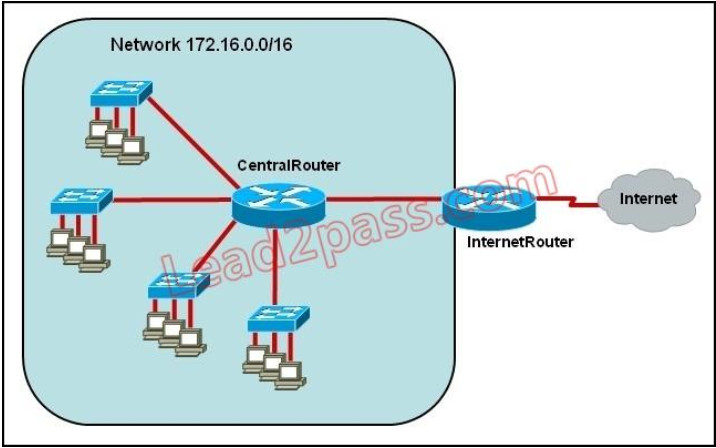
A. a dynamic routing protocol on InternetRouter to advertise all routes to CentralRouter.
B. a dynamic routing protocol on InternetRouter to advertise summarized routes to CentralRouter.
C. a static route on InternetRouter to direct traffic that is destined for 172.16.0.0/16 to CentralRouter.
D. a dynamic routing protocol on CentralRouter to advertise all routes to InternetRouter.
E. a dynamic routing protocol on CentralRouter to advertise summarized routes to InternetRouter.
F. a static, default route on CentralRouter that directs traffic to InternetRouter.
Answer: CF
Explanation:
The use of static routes will provide the necessary information for connectivity while producing no routing traffic overhead.
QUESTION 219
What is the effect of using the service password-encryption command?
A. Only the enable password will be encrypted.
B. Only the enable secret password will be encrypted.
C. Only passwords configured after the command has been entered will be encrypted.
D. It will encrypt the secret password and remove the enable secret password from the configuration.
E. It will encrypt all current and future passwords.
Answer: E
Explanation:
Enable vty, console, AUX passwords are configured on the Cisco device. Use the show run command to show most passwords in clear text. If the service password-encryption is used, all the passwords are encrypted. As a result, the security of device access is improved.
QUESTION 220
Refer to the exhibit. What is the effect of the configuration that is shown?
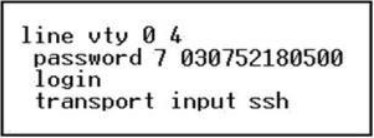
A. It configures SSH globally for all logins.
B. It tells the router or switch to try to establish an SSh connection first and if that fails to use Telnet.
C. It configures the virtual terminal lines with the password 030752180500.
D. It configures a Cisco network device to use the SSH protocol on incoming communications via the virtual terminal ports.
E. It allows seven failed login attempts before the VTY lines are temporarily shutdown.
Answer: D
Explanation:
Secure Shell (SSH) is a protocol which provides a secure remote access connection to network devices. Communication between the client and server is encrypted in both SSH version 1 and SSH version 2. If you want to prevent non-SSH connections, add the “transport input ssh” command under the lines to limit the router to SSH connections only. Straight (non-SSH) Telnets are refused. www.cisco.com/warp/public/707/ssh.shtml
QUESTION 221
Refer to the exhibit. What is the reason that the interface status is “administratively down, line protocol down”?

A. There is no encapsulation type configured.
B. There is a mismatch in encapsulation types.
C. The interface is not receiving any keepalives.
D. The interface has been configured with the shutdown command.
E. The interface needs to be configured as a DTE device.
F. The wrong type of cable is connected to the interface.
Answer: D
Explanation:
Interface can be enabled or disabled with shutdown/no shutdown command. If you interface is down, it will display administratively down status. You can bring up an interface having administratively down interface using no shutdown command.
QUESTION 222
Refer to the exhibit. A junior network administrator was given the task of configuring port security on SwitchA to allow only PC_A to access the switched network through port fa0/1. If any other device is detected, the port is to drop frames from this device. The administrator configured the interface and tested it with successful pings from PC_A to RouterA, and then observes the output from these two show commands. Which two of these changes are necessary for SwitchA to meet the requirements? (Choose two.)
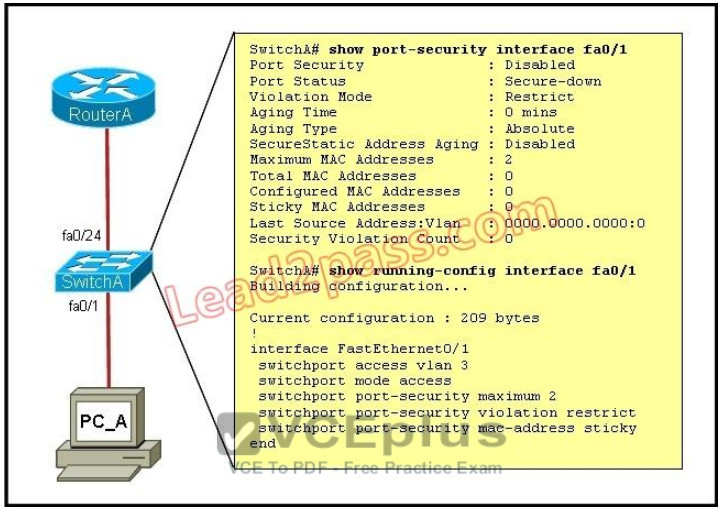
A. Port security needs to be globally enabled.
B. Port security needs to be enabled on the interface.
C. Port security needs to be configured to shut down the interface in the event of a violation.
D. Port security needs to be configured to allow only one learned MAC address.
E. Port security interface counters need to be cleared before using the show command.
F. The port security configuration needs to be saved to NVRAM before it can become active.
Answer: BD
Explanation:
From the output we can see that port security is disabled so this needs to be enabled. Also, the maximum number of devices is set to 2 so this needs to be just one if we want the single host to have access and nothing else.
QUESTION 223
Refer to the exhibit. When running OSPF, what would cause router A not to form an adjacency with router B?
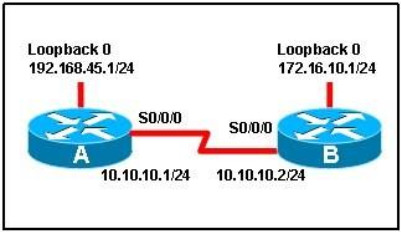
A. The loopback addresses are on different subnets.
B. The values of the dead timers on the routers are different.
C. Route summarization is enabled on both routers.
D. The process identifier on router A is different than the process identifier on router B.
Answer: B
Explanation:
To form an adjacency (become neighbor), router A & B must have the same Hello interval, Dead interval and AREA number.s
QUESTION 224
Which two of these statements are true of IPv6 address representation? (Choose two.)
A. There are four types of IPv6 addresses: unicast, multicast, anycast, and broadcast.
B. A single interface may be assigned multiple IPv6 addresses of any type.
C. Every IPv6 interface contains at least one loopback address.
D. The first 64 bits represent the dynamically created interface ID.
E. Leading zeros in an IPv6 16 bit hexadecimal field are mandatory.
Answer: BC
Explanation:
Leading zeros in IPv6 are optional do that 05C7 equals 5C7 and 0000 equals 0 -> D is not correct.
QUESTION 225
Which set of commands is recommended to prevent the use of a hub in the access layer?
A. switch(config-if)#switchport mode trunk
switch(config-if)#switchport port-security maximum 1
B. switch(config-if)#switchport mode trunk
switch(config-if)#switchport port-security mac-address 1
C. switch(config-if)#switchport mode access
switch(config-if)#switchport port-security maximum 1
D. switch(config-if)#switchport mode access
switch(config-if)#switchport port-security mac-address 1
Answer: C
Explanation:
This QUESTION is to examine the layer 2 security configuration. In order to satisfy the requirements of this question, you should perform the following configurations in the interface mode:
First, configure the interface mode as the access mode Second, enable the port security and set the maximum number of connections to 1.
QUESTION 226
What is known as “one-to-nearest” addressing in IPv6?
A. global unicast
B. anycast
C. multicast
D. unspecified address
Answer: B
Explanation:
IPv6 Anycast addresses are used for one-to-nearest communication, meaning an Anycast address is used by a device to send data to one specific recipient (interface) that is the closest out of a group of recipients (interfaces).
QUESTION 227
What is the first 24 bits in a MAC address called?
A. NIC
B. BIA
C. OUI
D. VAI
Answer: C
Explanation:
An Organizationally Unique Identifier (OUI) is a 24-bit number that uniquely identifies a vendor, manufacturer, or other organization globally or worldwide. They are used as the first 24 nits of the MAC address to uniquely identify a particular piece of equipment.
QUESTION 228
Refer to the exhibit. Which subnet mask will place all hosts on Network B in the same subnet with the least amount of wasted addresses?

A. 255.255.255.0
B. 255.255.254.0
C. 255.255.252.0
D. 255.255.248.0
Answer: B
Explanation:
310 hosts < 512 = 29 -> We need a subnet mask of 9 bits 0 -> 1111 1111.1111 1111.1111
1110.0000 0000 -> 255.255.254.0
QUESTION 229
Refer to the exhibit. What is the most appropriate summarization for these routes?
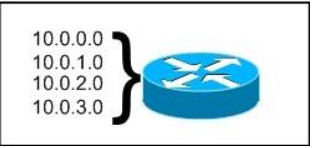
A. 10.0.0.0 /21
B. 10.0.0.0 /22
C. 10.0.0.0 /23
D. 10.0.0.0 /24
Answer: B
Explanation:
The 10.0.0.0/22 subnet mask will include the 10.0.0.0, 10.0.1.0, 10.0.2.0, and 10.0.3.0 networks, and only those four networks.
QUESTION 230
What is the difference between a CSU/DSU and a modem?
A. A CSU/DSU converts analog signals from a router to a leased line; a modem converts analog signals from a router to a leased line.
B. A CSU/DSU converts analog signals from a router to a phone line; a modem converts digital signals from a router to a leased line.
C. A CSU/DSU converts digital signals from a router to a phone line; a modem converts analog signals from a router to a phone line.
D. A CSU/DSU converts digital signals from a router to a leased line; a modem converts digital signals from a router to a phone line.
Answer: D
Explanation:
CSU/DSU is used to convert digital signals from a router to a network circuit such as a T1, while a modem is used to convert digital signals over a regular POTS line.
QUESTION 231
Which two are features of IPv6? (Choose two.)
A. anycast
B. broadcast
C. multicast
D. podcast
E. allcast
Answer: AC
Explanation:
IPv6 addresses are classified by the primary addressing and routing methodologies common in networkinG. unicast addressing, anycast addressing, and multicast addressing.
QUESTION 232
Which two are advantages of static routing when compared to dynamic routing? (Choose two.)
A. Configuration complexity decreases as network size increases.
B. Security increases because only the network administrator may change the routing table.
C. Route summarization is computed automatically by the router.
D. Routing tables adapt automatically to topology changes.
E. An efficient algorithm is used to build routing tables, using automatic updates.
F. Routing updates are automatically sent to neighbors.
G. Routing traffic load is reduced when used in stub network links.
Answer: BG
Explanation:
Since static routing is a manual process, it can be argued that it is more secure (and more prone to human errors) since the network administrator will need to make changes to the routing table directly. Also, in stub networks where there is only a single uplink connection, the load is reduced as stub routers just need a single static default route, instead of many routes that all have the same next hop IP address.
QUESTION 233
A network administrator needs to configure port security on a switch. Which two statements are true? (Choose two.)
A. The network administrator can apply port security to dynamic access ports.
B. The network administrator can apply port security to EtherChannels.
C. When dynamic MAC address learning is enabled on an interface, the switch can learn new addresses, up to the maximum defined.
D. The sticky learning feature allows the addition of dynamically learned addresses to the running configuration.
E. The network administrator can configure static secure or sticky secure MAC addresses in the voice VLAN.
Answer: CD
Explanation:
Follow these guidelines when configuring port security:
+ Port security can only be configured on static access ports, trunk ports, or 802.1Q tunnel ports.
+ A secure port cannot be a dynamic access port.
+ A secure port cannot be a destination port for Switched Port Analyzer (SPAN). + A secure port cannot belong to a Fast EtherChannel or Gigabit EtherChannel port group. + You cannot configure static secure or sticky secure MAC addresses on a voice VLAN. + When you enable port security on an interface that is also configured with a voice VLAN, you must set the maximum allowed secure addresses on the port to at least two. + If any type of port security is enabled on the access VLAN, dynamic port security is automatically enabled on the voice VLAN.
+ When a voice VLAN is configured on a secure port that is also configured as a sticky secure port, all addresses seen on the voice VLAN are learned as dynamic secure addresses, and all addresses seen on the access VLAN (to which the port belongs) are learned as sticky secure addresses.
+ The switch does not support port security aging of sticky secure MAC addresses.
+ The protect and restrict options cannot be simultaneously enabled on an interface.
http://www.cisco.com/en/US/docs/switches/lan/catalyst3550/software/release/12.1_19_ea1/configuration/guide/swtrafc.html
QUESTION 234
What are three features of the IPv6 protocol? (Choose three.)
A. optional IPsec
B. autoconfiguration
C. no broadcasts
D. complicated header
E. plug-and-play
F. checksums
Answer: BCE
Explanation:
An important feature of IPv6 is that it allows plug and play option to the network devices by allowing them to configure themselves independently. It is possible to plug a node into an IPv6 network without requiring any human intervention. This feature was critical to allow network connectivity to an increasing number of mobile devices. This is accomplished by autoconfiguration.
IPv6 does not implement traditional IP broadcast, i.e. the transmission of a packet to all hosts on the attached link using a special broadcast address, and therefore does not define broadcast addresses. In IPv6, the same result can be achieved by sending a packet to the link-local all nodes multicast group at address ff02::1, which is analogous to IPv4 multicast to address 224.0.0.1.
QUESTION 235
Which command enables IPv6 forwarding on a Cisco router?
A. ipv6 local
B. ipv6 host
C. ipv6 unicast-routing
D. ipv6 neighbor
Answer: C
Explanation:
to enable IPv6 routing on the Cisco router use the following command:
ipv6 unicast-routing
If this command is not recognized, your version of IOS does not support IPv6.
QUESTION 236
Which command encrypts all plaintext passwords?
A. Router# service password-encryption
B. Router(config)# password-encryption
C. Router(config)# service password-encryption
D. Router# password-encryption
Answer: C
Explanation:
The “service password-encryption” command allows you to encrypt all passwords on your router so they can not be easily guessed from your running-config. This command uses a very weak encryption because the router has to be very quickly decode the passwords for its operation.
It is meant to prevent someone from looking over your shoulder and seeing the password, that is all. This is configured in global configuration mode.
QUESTION 237
You have been asked to come up with a subnet mask that will allow all three web servers to be on the same network while providing the maximum number of subnets. Which network address and subnet mask meet this requirement?
A. 192.168.252.0 255.255.255.252
B. 192.168.252.8 255.255.255.248
C. 192.168.252.8 255.255.255.252
D. 192.168.252.16 255.255.255.240
E. 192.168.252.16 255.255.255.252
Answer: B
Explanation:
A subnet mask of 255.255.255.248 will allow for up to 6 hosts to reside in this network. A subnet mask of 255.255.255.252 will allow for only 2 usable IP addresses, since we can not use the network or broadcast address.
QUESTION 238
Given an IP address 172.16.28.252 with a subnet mask of 255.255.240.0, what is the correct network address?
A. 172.16.16.0
B. 172.16.0.0
C. 172.16.24.0
D. 172.16.28.0
Answer: A
Explanation:
For this example, the network range is 172.16.16.1 – 172.16.31.254, the network address is 172.16.16.0 and the broadcast IP address is 172.16.31.255.
QUESTION 239
Which IPv6 address is the equivalent of the IPv4 interface loopback address 127.0.0.1?
A. ::1
B. ::
C. 2000::/3
D. 0::/10
Answer: A
Explanation:
In IPv6 the loopback address is written as,
This is a 128bit number, with the first 127 bits being ‘0’ and the 128th bit being ‘1’. It’s just a single
address, so could also be written as ::1/128.
QUESTION 240
You are working in a data center environment and are assigned the address range 10.188.31.0/23. You are asked to develop an IP addressing plan to allow the maximum number of subnets with as many as 30 hosts each. Which IP address range meets these requirements?
A. 10.188.31.0/26
B. 10.188.31.0/25
C. 10.188.31.0/28
D. 10.188.31.0/27
E. 10.188.31.0/29
Answer: D
Explanation:
Each subnet has 30 hosts < 32 = 25 so we need a subnet mask which has at least 5 bit 0s -> /27.
Also the QUESTION requires the maximum number of subnets (which minimum the number of
hosts- per-subnet) so /27 is the best choice -> .
QUESTION 241
Which parameter or parameters are used to calculate OSPF cost in Cisco routers?
A. Bandwidth
B. Bandwidth and Delay
C. Bandwidth, Delay, and MTU
D. Bandwidth, MTU, Reliability, Delay, and Load
Answer: A
Explanation:
The well-known formula to calculate OSPF cost is Cost = 108 / Bandwidth
QUESTION 242
Why do large OSPF networks use a hierarchical design? (Choose three.)
A. to decrease latency by increasing bandwidth
B. to reduce routing overhead
C. to speed up convergence
D. to confine network instability to single areas of the network
E. to reduce the complexity of router configuration
F. to lower costs by replacing routers with distribution layer switches
Answer: BCD
Explanation:
OSPF implements a two-tier hierarchical routing model that uses a core or backbone tier known as area zero (0). Attached to that backbone via area border routers (ABRs) are a number of secondary tier areas. The hierarchical approach is used to achieve the following:
Rapid convergence because of link and/or switch failures
Deterministic traffic recovery
Scalable and manageable routing hierarchy, reduced routing overhead.
QUESTION 243
Drag and Drop Question

Answer:

QUESTION 244
Drag and Drop Question
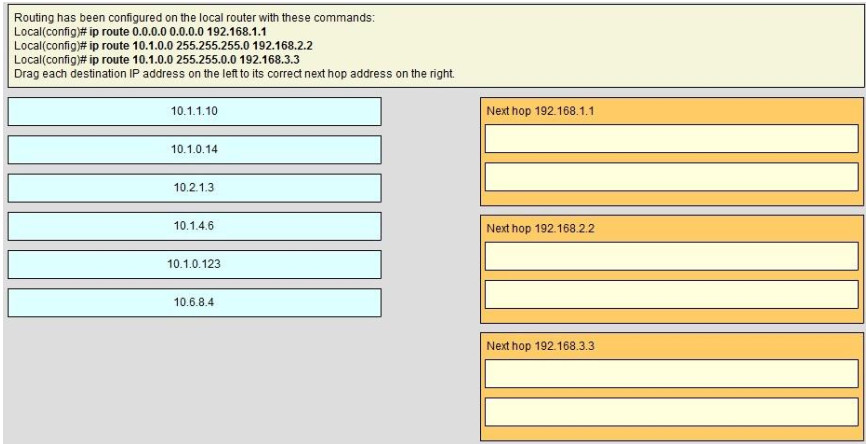
Answer:
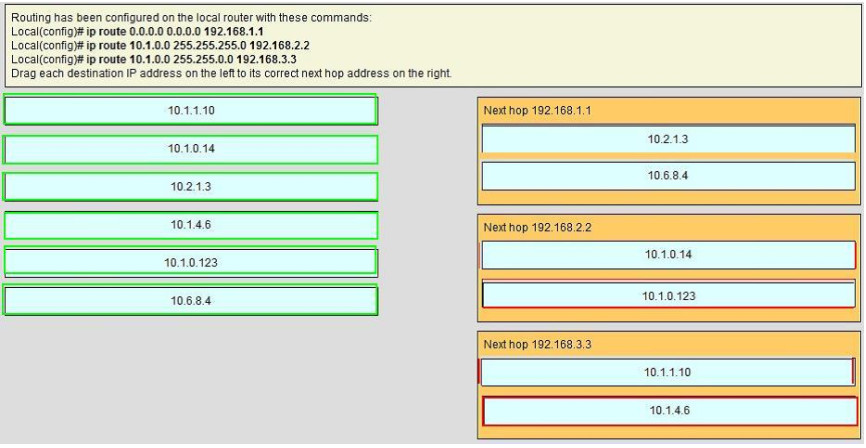
QUESTION 245
Drag and Drop Question

Answer:

QUESTION 246
Drag and Drop Question

Answer:

QUESTION 247
Drag and Drop Question
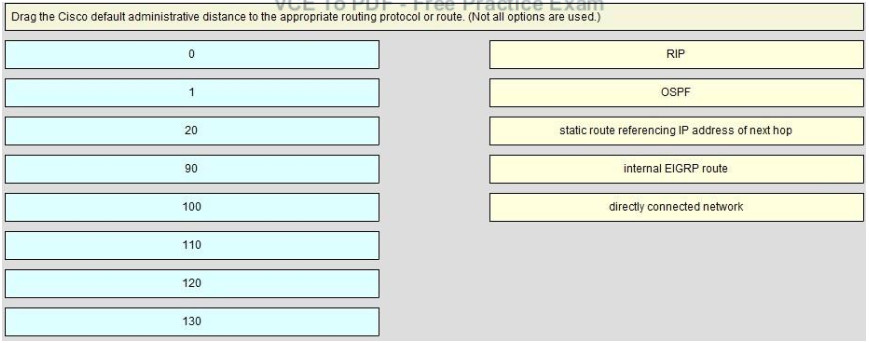
Answer:
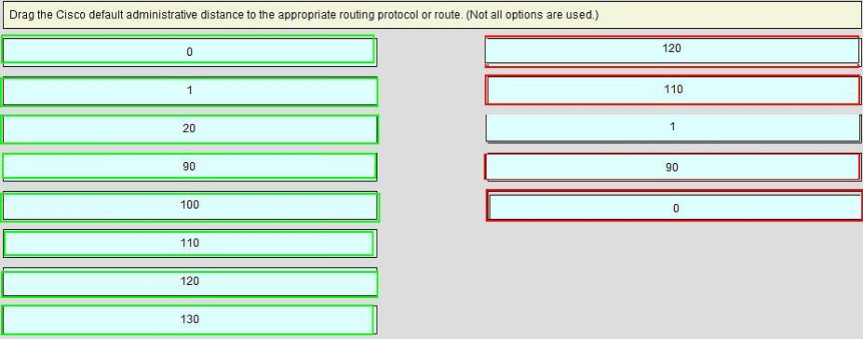
QUESTION 248
Drag and Drop Question
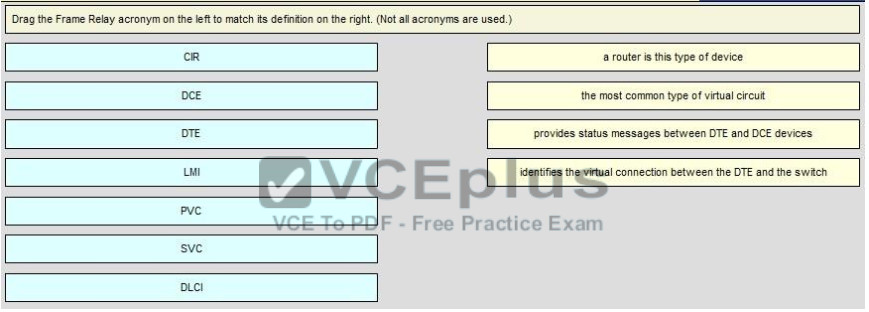
Answer:
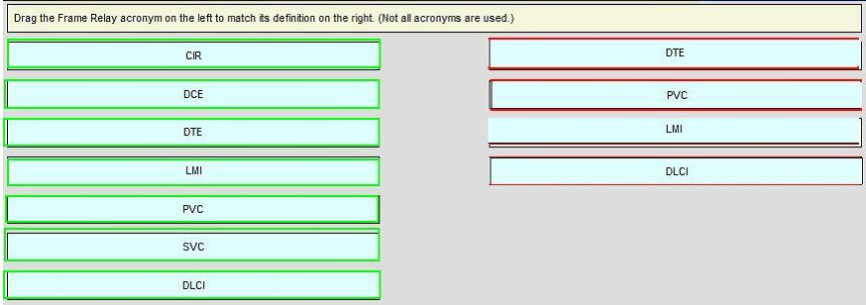
QUESTION 249
Drag and Drop Question

Answer:

QUESTION 250
Drag and Drop Question
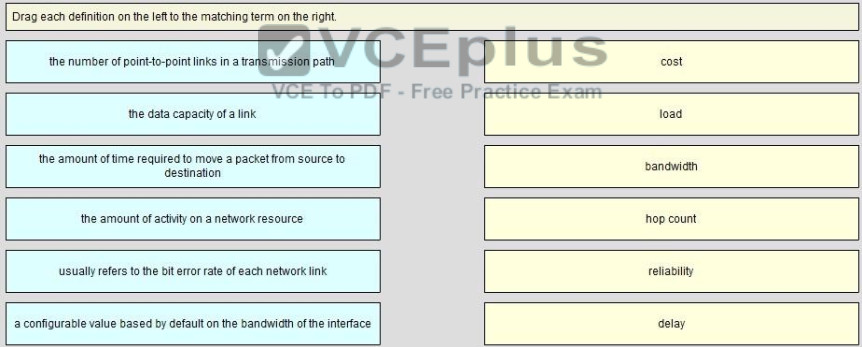
Answer:
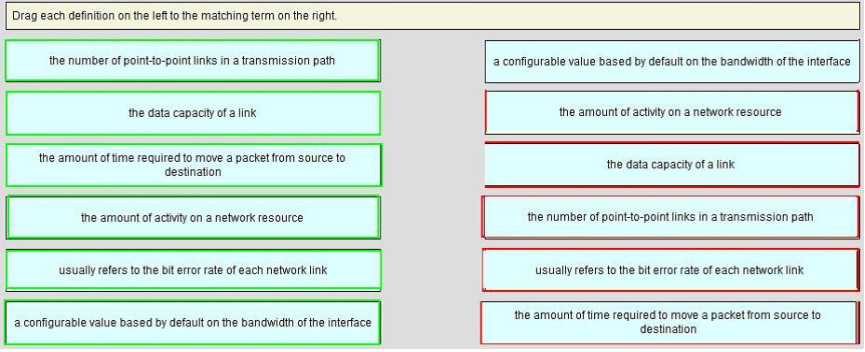
QUESTION 251
Drag and Drop Question
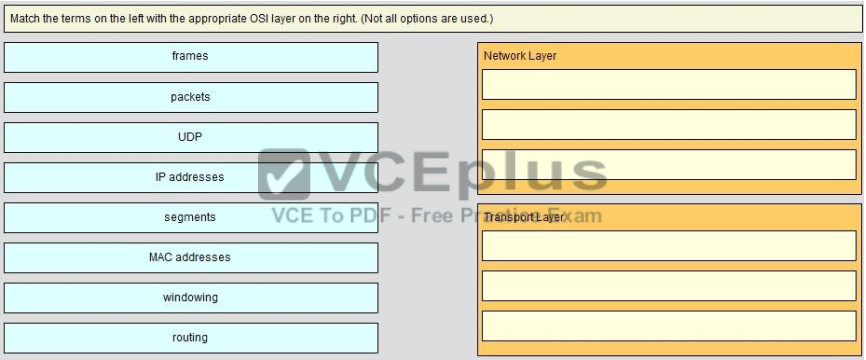
Answer:
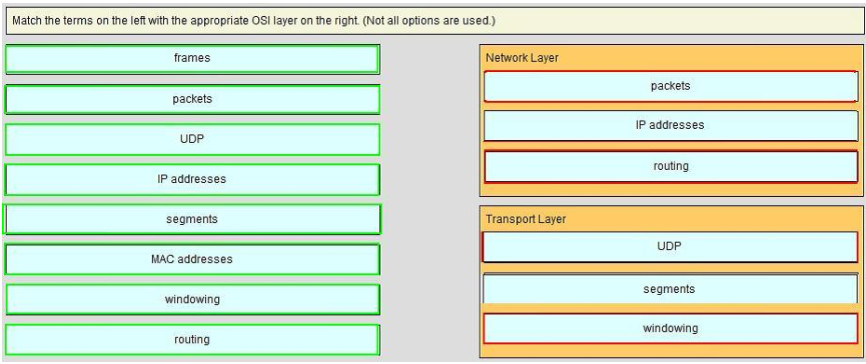
QUESTION 253
Drag and Drop Question
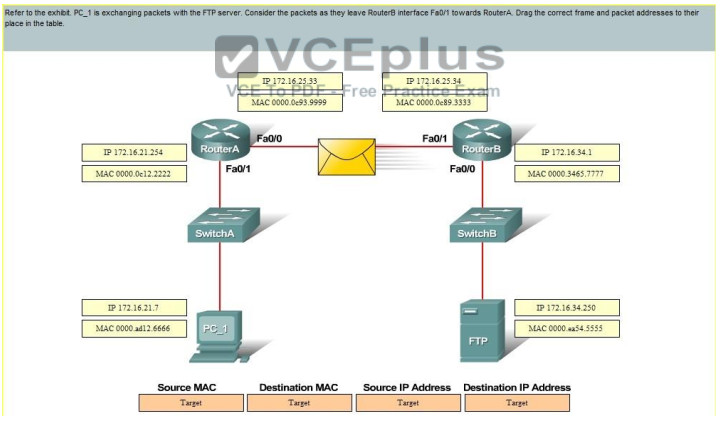
Answer:
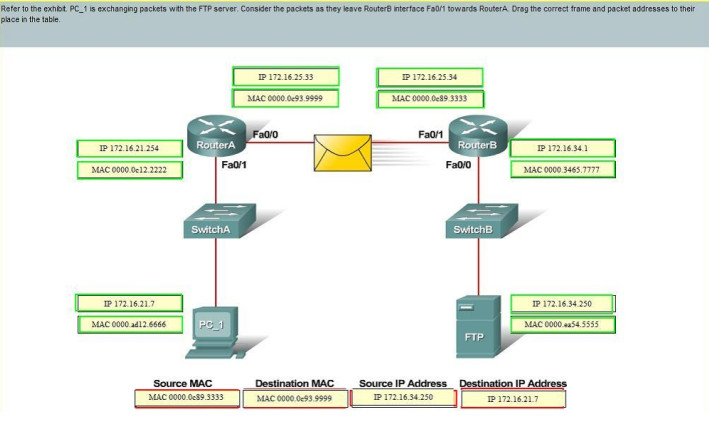
QUESTION 254
Drag and Drop Question
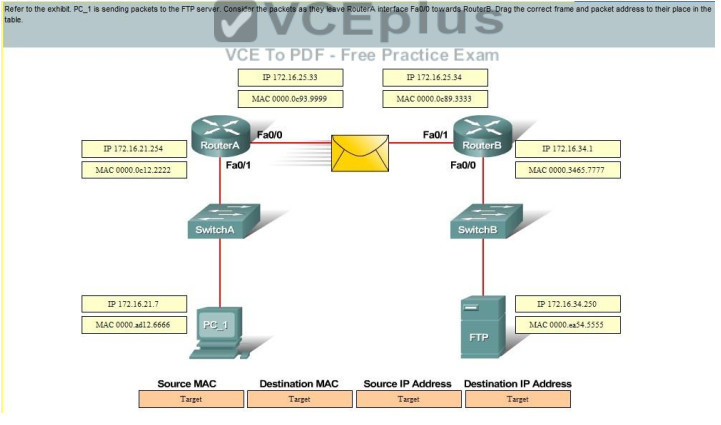
Answer:
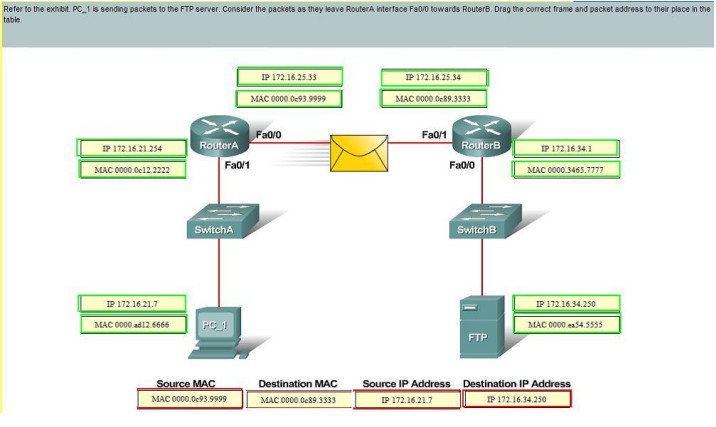
QUESTION 255
Drag and Drop Question
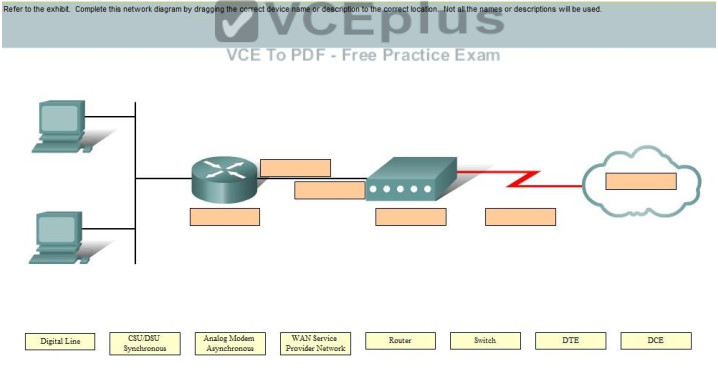
Answer:
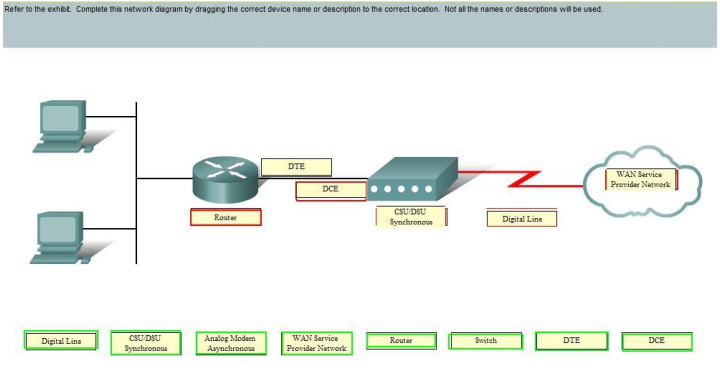
QUESTION 256
Hotspot Question
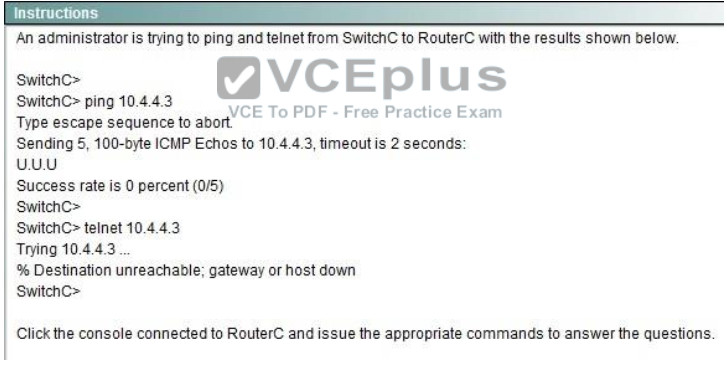
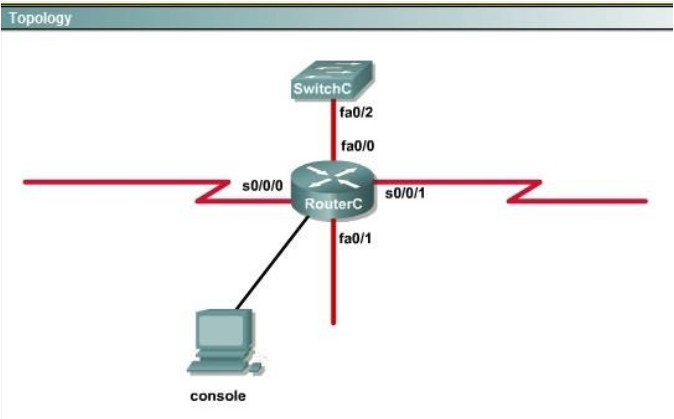
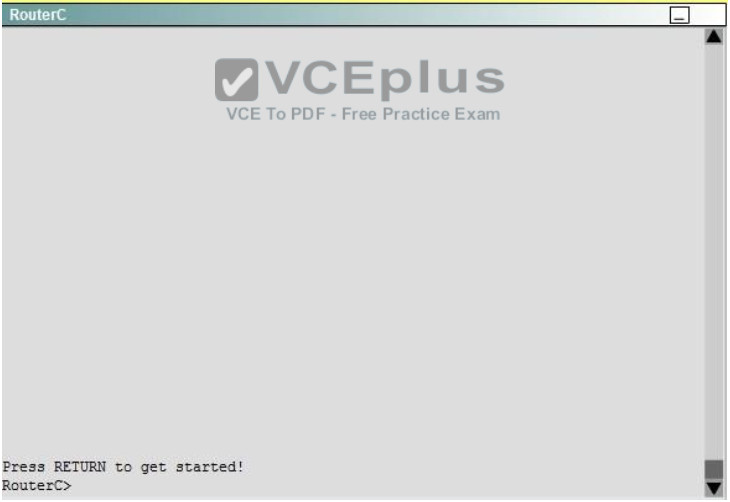
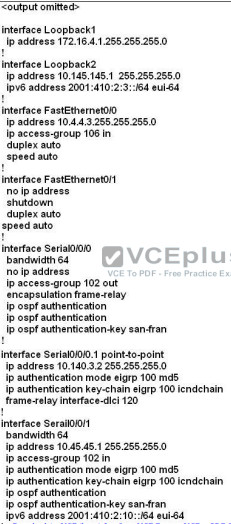
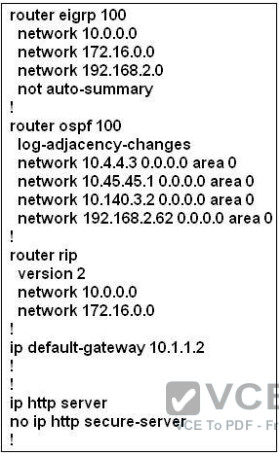
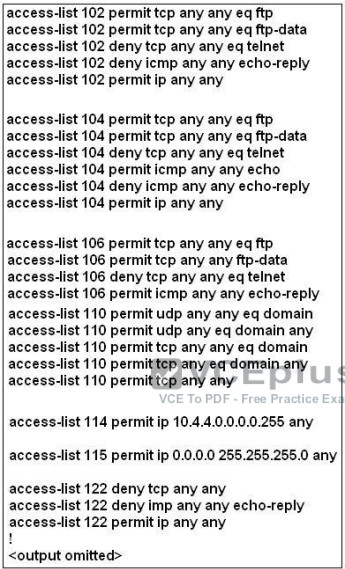
Which will fix the issue and allow ONLY ping to work while keeping telnet disabled?
A. Correctly assign an IP address to interface fa0/1.
B. Change the ip access-group command on fa0/0 from “in* to “our.
C. Remove access-group 106 in from interface fa0/0 and add access-group 115 in.
D. Remove access-group 102 out from interface s0/0/0 and add access-group 114 in
E. Remove access-group 106 in from interface fa0/0 and add access-group 104 in.
Answer: E
Explanation:
Let’s have a look at the access list 104:
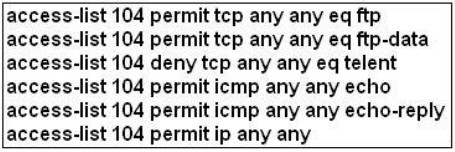
The QUESTION does not ask about ftp traffic so we don’t care about the two first lines. The 3rd line denies all telnet traffic and the 4th line allows icmp traffic to be sent (ping). Remember that the access list 104 is applied on the inbound direction so the 5th line “access-list 104 deny icmp any any echo-reply” will not affect our icmp traffic because the “echo-reply” message will be sent over the outbound direction.
QUESTION 257
Hotspot Question
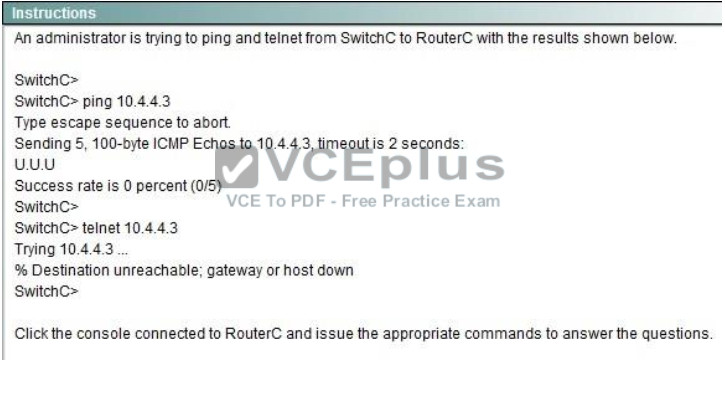
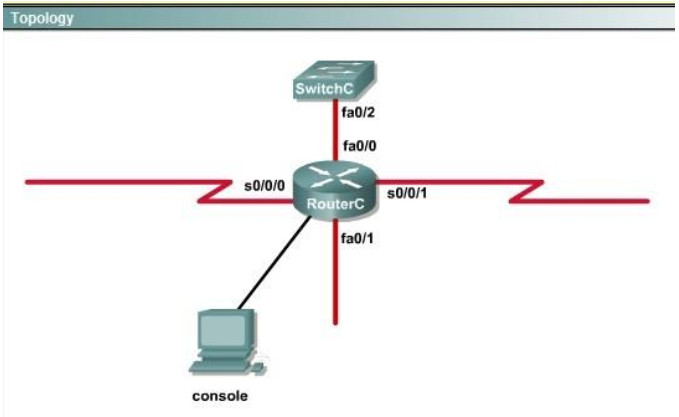
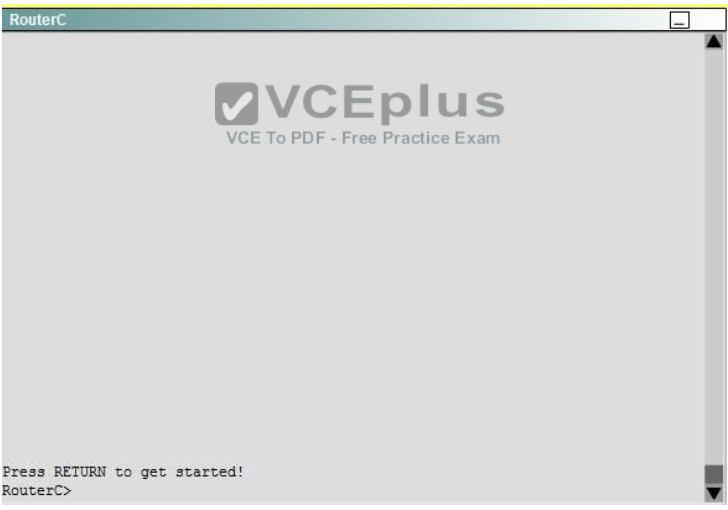
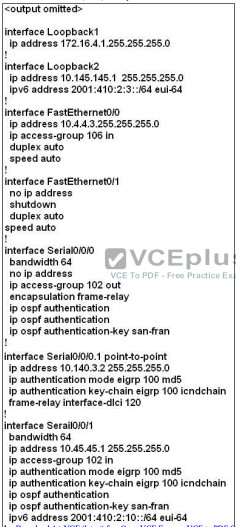
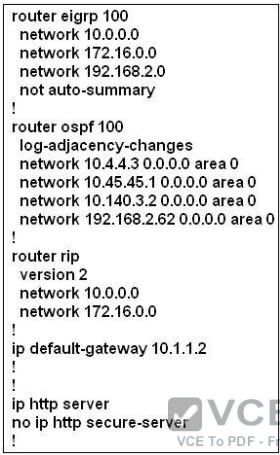
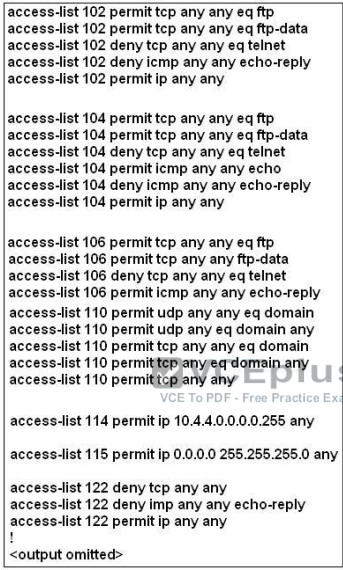
What would be the effect of issuing the command ip access-group 114 in to the fa0/0 interface?
A. Attempts to telnet to the router would fail.
B. It would allow all traffic from the 10.4.4.0 network.
C. IP traffic would be passed through the interface but TCP and UDP traffic would not.
D. Routing protocol updates for the 10.4.4.0 network would not be accepted from the fa0/0 interface.
Answer: B
Explanation:
From the output of access-list 114: access-list 114 permit ip 10.4.4.0 0.0.0.255 any we can easily understand that this access list allows all traffic (ip) from 10.4.4.0/24 network
QUESTION 258
Hotspot Question
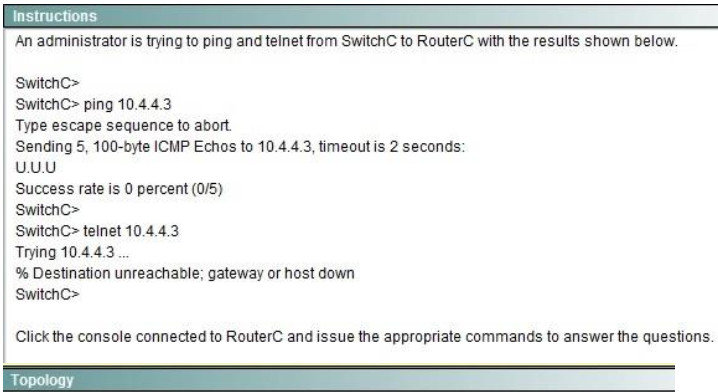
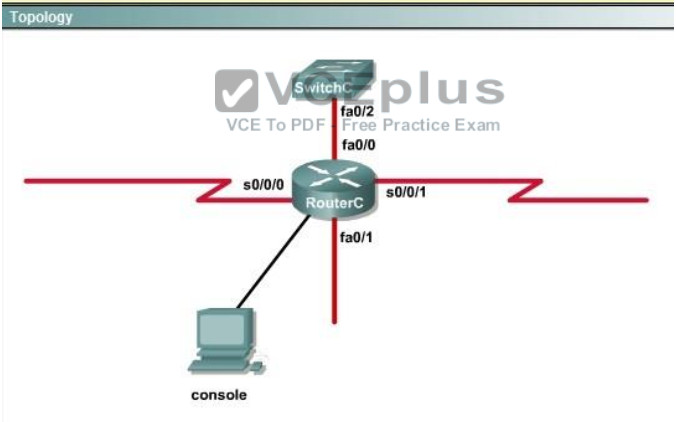
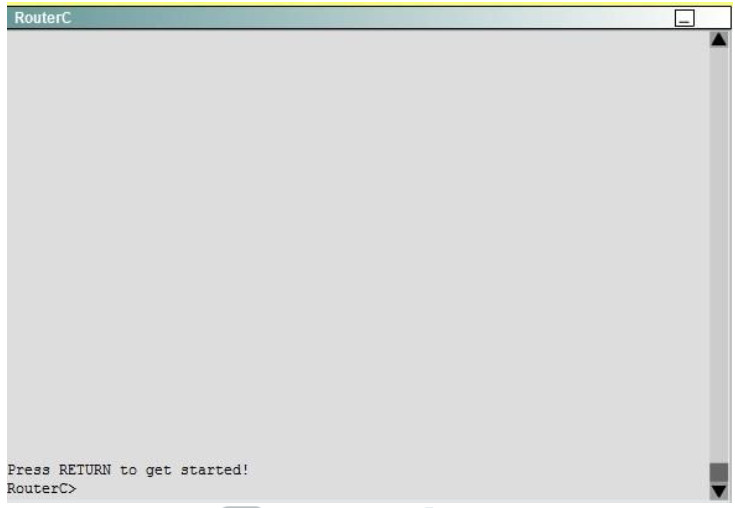
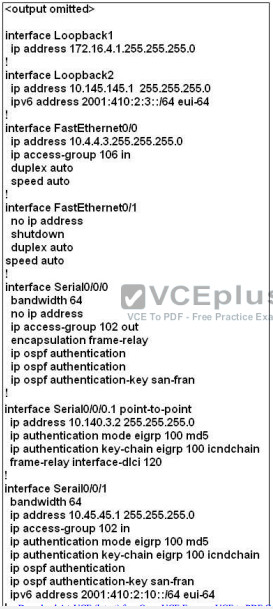
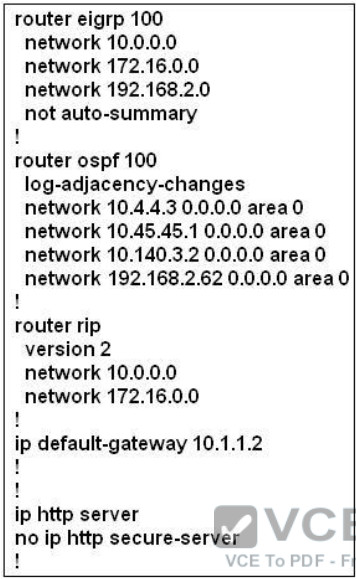
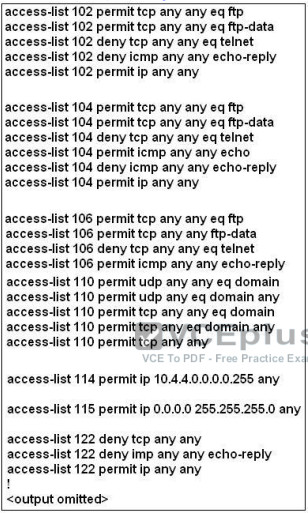
What would be the effect of Issuing the command ip access-group 115 in on the s0/0/1 interface?
A. No host could connect to RouterC through s0/0/1.
B. Telnet and ping would work but routing updates would fail.
C. FTP, FTP-DATA, echo, and www would work but telnet would fail.
D. Only traffic from the 10.4.4.0 network would pass through the interface.
Answer: A
Explanation:
First let’s see what was configured on interface S0/0/1:

QUESTION 259
Refer to the exhibit. Based on the information given, which switch will be elected root bridge and why?

A. Switch A, because it has the lowest MAC address
B. Switch A, because it is the most centrally located switch
C. Switch B, because it has the highest MAC address
D. Switch C, because it is the most centrally located switch
E. Switch C, because it has the lowest priority
F. Switch D, because it has the highest priority
Answer: E
QUESTION 267
In a switched environment, what does the IEEE 802.1Q standard describe?
A. the operation of VTP
B. a method of VLAN trunking
C. an approach to wireless LAN communication
D. the process for root bridge selection
E. VLAN pruning
Answer: B
Explanation:
A broadcast domain must sometimes exist on more than one switch in the network. To accomplish this, one switch must send frames to another switch and indicate which VLAN a particular frame belongs to. On Cisco switches, a trunk link is created to accomplish this VLAN identification. ISL and IEEE 802.1Q are different methods of putting a VLAN identifier in a Layer 2 frame. The IEEE 802.1Q protocol interconnects VLANs between multiple switches, routers, and servers. With 802.1Q, a network administrator can define a VLAN topology to span multiple physical devices.
Cisco switches support IEEE 802.1Q for FastEthernet and Gigabit Ethernet interfaces. An 802.1Q trunk link provides VLAN identification by adding a 4-byte tag to an Ethernet Frame as it leaves a trunk port.
QUESTION 268
What are three benefits of GLBP? (Choose three.)
A. GLBP supports up to eight virtual forwarders per GLBP group.
B. GLBP supports clear text and MD5 password authentication between GLBP group members.
C. GLBP is an open source standardized protocol that can be used with multiple vendors.
D. GLBP supports up to 1024 virtual routers.
E. GLBP can load share traffic across a maximum of four routers.
F. GLBP elects two AVGs and two standby AVGs for redundancy.
Answer: BDE
QUESTION 269
Which three statements about HSRP operation are true? (Choose three.)
A. The virtual IP address and virtual MA+K44C address are active on the HSRP Master router.
B. The HSRP default timers are a 3 second hello interval and a 10 second dead interval.
C. HSRP supports only clear-text authentication.
D. The HSRP virtual IP address must be on a different subnet than the routers’ interfaces on the same LAN.
E. The HSRP virtual IP address must be the same as one of the router’s interface addresses on the LAN.
F. HSRP supports up to 255 groups per interface, enabling an administrative form of load balancing.
Answer: ABF
Explanation:
The virtual MAC address of HSRP version 1 is 0000.0C07.ACxx, where xx is the HSRP group number in hexadecimal based on the respective interface. For example, HSRP group 10 uses the HSRP virtual MAC address of 0000.0C07.AC0A. HSRP version 2 uses a virtual MAC address of 0000.0C9F.FXXX (XXX: HSRP group in hexadecimal)
QUESTION 270
Which three statements about Syslog utilization are true? (Choose three.)
A. Utilizing Syslog improves network performance.
B. The Syslog server automatically notifies the network administrator of network problems.
C. A Syslog server provides the storage space necessary to store log files without using router disk space.
D. There are more Syslog messages available within Cisco IOS than there are comparable SNMP trap messages.
E. Enabling Syslog on a router automatically enables NTP for accurate time stamping.
F. A Syslog server helps in aggregation of logs and alerts.
Answer: CDF
QUESTION 271
A network administrator enters the following command on a router: logging trap 3. What are three message types that will be sent to the Syslog server? (Choose three.)
A. informational
B. emergency
C. warning
D. critical
E. debug
F. error
Answer: BDF
QUESTION 272
What is the default Syslog facility level?
A. local4
B. local5
C. local6
D. local7
Answer: D
QUESTION 273
What command instructs the device to timestamp Syslog debug messages in milliseconds?
A. service timestamps log datetime localtime
B. service timestamps debug datetime msec
C. service timestamps debug datetime localtime
D. service timestamps log datetime msec
Answer: B
Explanation:
The “service timestamps debug” command configures the system to apply a time stamp to debugging messages. The time-stamp format for datetime is MMM DD HH:MM:SS, where MMM is the month, DD is the date, HH is the hour (in 24-hour notation), MM is the minute, and SS is the second. With the additional keyword msec, the system includes milliseconds in the time stamp, in the format HH:DD:MM:SS.mmm, where .mmm is milliseconds
QUESTION 274
Refer to the exhibit. What is the cause of the Syslog output messages?

A. The EIGRP neighbor on Fa0/1 went down due to a failed link.
B. The EIGRP neighbor connected to Fa0/1 is participating in a different EIGRP process, causing the adjacency to go down.
C. A shut command was executed on interface Fa0/1, causing the EIGRP adjacency to go down.
D. Interface Fa0/1 has become error disabled, causing the EIGRP adjacency to go down.
Answer: C
QUESTION 275
What are three components that comprise the SNMP framework? (Choose three.)
A. MIB
B. agent
C. set
D. AES
E. supervisor
F. manager
Answer: ABF
QUESTION 276
What are three components that comprise the SNMP framework? (Choose three.)
A. MIB
B. agent
C. set
D. AES
E. supervisor
F. manager
Answer: ABF
QUESTION 277
What SNMP message alerts the manager to a condition on the network?
A. response
B. get
C. trap
D. capture
Answer: C
QUESTION 278
What authentication type is used by SNMPv2?
A. HMAC-MD5
B. HMAC-SHA
C. CBC-DES
D. community strings
Answer: D
QUESTION 279
Which three statements about the features of SNMPv2 and SNMPv3 are true? (Choose three.)
A. SNMPv3 enhanced SNMPv2 security features.
B. SNMPv3 added the Inform protocol message to SNMP.
C. SNMPv2 added the Inform protocol message to SNMP.
D. SNMPv3 added the GetBulk protocol messages to SNMP.
E. SNMPv2 added the GetBulk protocol message to SNMP.
F. SNMPv2 added the GetNext protocol message to SNMP.
Answer: ACE
QUESTION 280
What are three reasons to collect Netflow data on a company network? (Choose three.)
A. To identify applications causing congestion.
B. To authorize user network access.
C. To report and alert link up / down instances.
D. To diagnose slow network performance, bandwidth hogs, and bandwidth utilization.
E. To detect suboptimal routing in the network.
F. To confirm the appropriate amount of bandwidth that has been allocated to each Class of Service.
Answer: ADF
QUESTION 281
What Netflow component can be applied to an interface to track IPv4 traffic?
A. flow monitor
B. flow record
C. flow sampler
D. flow exporter
Answer: A
Explanation:
Flow monitors are the Flexible NetFlow component that is applied to interfaces to perform network traffic monitoring. Flow monitors consist of a record and a cache. You add the record to the flow monitor after you create the flow monitor. The flow monitor cache is automatically created at the time the flow monitor is applied to the first interface. Flow data is collected from the network traffic during the monitoring process based on the key and nonkey fields in the record, which is configured for the flow monitor and stored in the flow monitor cache.
For example, the following example creates a flow monitor named FLOW-MONITOR-1 and
enters Flexible NetFlow flow monitor configuration mode:
Router(config)# flow monitor FLOW-MONITOR-1
Router(config-flow-monitor)#
QUESTION 282
What Cisco IOS feature can be enabled to pinpoint an application that is causing slow network performance?
A. SNMP
B. Netflow
C. WCCP
D. IP SLA
Answer: B
QUESTION 283
What command visualizes the general NetFlow data on the command line?
A. show ip flow export
B. show ip flow top-talkers
C. show ip cache flow
D. show mls sampling
E. show mls netflow ip
Answer: C
Explanation:
The “show ip cache flow” command displays a summary of the NetFlow

QUESTION 284
What are three values that must be the same within a sequence of packets for Netflow to consider them a network flow? (Choose three.)
A. source IP address
B. source MAC address
C. egress interface
D. ingress interface
E. destination IP address
F. IP next-hop
Answer: ADE
QUESTION 285
Refer to the exhibit. A network administrator is configuring an EtherChannel between SW1 and SW2. The SW1 configuration is shown. What is the correct configuration for SW2?
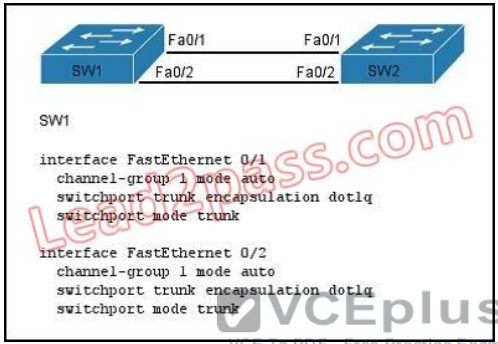
A. interface FastEthernet 0/1
channel-group 1 mode active
switchport trunk encapsulation dot1q
switchport mode trunk
interface FastEthernet 0/2
channel-group 1 mode active
switchport trunk encapsulation dot1q
switchport mode trunk
B. interface FastEthernet 0/1
channel-group 2 mode auto
switchport trunk encapsulation dot1q
switchport mode trunk
interface FastEthernet 0/2
channel-group 2 mode auto
switchport trunk encapsulation dot1q
switchport mode trunk
C. interface FastEthernet 0/1
channel-group 1 mode desirable
switchport trunk encapsulation dot1q
switchport mode trunk
interface FastEthernet 0/2
channel-group 1 mode desirable
switchport trunk encapsulation dot1q
switchport mode trunk
D. interface FastEthernet 0/1
channel-group 1 mode passive
switchport trunk encapsulation dot1q
switchport mode trunk
interface FastEthernet 0/2
channel-group 1 mode passive
switchport trunk encapsulation dot1q
switchport mode trunk
Answer: C
QUESTION 286
What are three factors a network administrator must consider before implementing Netflow in the network? (Choose three.)
A. CPU utilization
B. where Netflow data will be sent
C. number of devices exporting Netflow data
D. port availability
E. SNMP version
F. WAN encapsulation
Answer: ABC
QUESTION 287
Which two statements about the OSPF Router ID are true? (Choose two.)
A. It identifies the source of a Type 1 LSA.
B. It should be the same on all routers in an OSPF routing instance.
C. By default, the lowest IP address on the router becomes the OSPF Router ID.
D. The router automatically chooses the IP address of a loopback as the OSPF Router ID.
E. It is created using the MAC Address of the loopback interface.
Answer: AD
QUESTION 288
What parameter can be different on ports within an EtherChannel?
A. speed
B. DTP negotiation settings
C. trunk encapsulation
D. duplex
Answer: B
QUESTION 289
What are two benefits of using a single OSPF area network design? (Choose two.)
A. It is less CPU intensive for routers in the single area.
B. It reduces the types of LSAs that are generated.
C. It removes the need for virtual links.
D. It increases LSA response times.
E. It reduces the number of required OSPF neighbor adjacencies.
Answer: BC
QUESTION 290
Refer to the exhibit. What set of commands was configured on interface Fa0/3 to produce the given output?

A. interface FastEthernet 0/3
channel-group 1 mode desirable
switchport trunk encapsulation dot1q
switchport mode trunk
B. interface FastEthernet 0/3
channel-group 2 mode passive
switchport trunk encapsulation dot1q
switchport mode trunk
C. interface FastEthernet 0/3
channel-group 2 mode active
switchport trunk encapsulation dot1q
switchport mode trunk
D. interface FastEthernet 0/3
channel-group 2 mode on
switchport trunk encapsulation dot1q
switchport mode trunk
Answer: B
QUESTION 291
Refer to the exhibit. If the devices produced the given output, what is the cause of the EtherChannel problem?
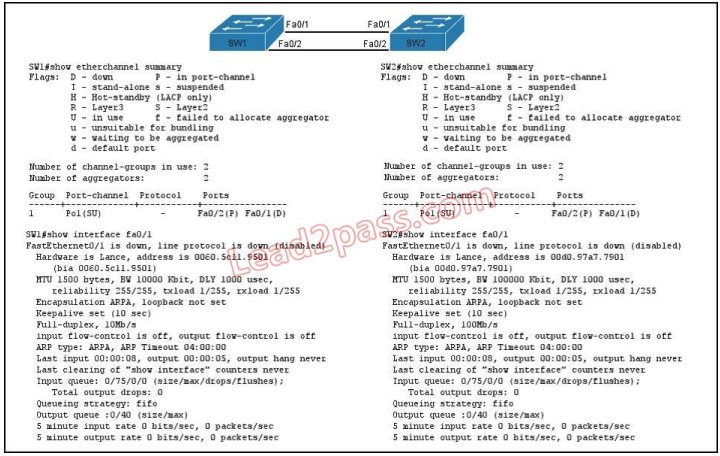
A. SW1’s Fa0/1 interface is administratively shut down.
B. There is an encapsulation mismatch between SW1’s Fa0/1 and SW2’s Fa0/1 interfaces.
C. There is an MTU mismatch between SW1’s Fa0/1 and SW2’s Fa0/1 interfaces.
D. There is a speed mismatch between SW1’s Fa0/1 and SW2’s Fa0/1 interfaces.
Answer: D
QUESTION 292
What are two enhancements that OSPFv3 supports over OSPFv2? (Choose two.)
A. It requires the use of ARP.
B. It can support multiple IPv6 subnets on a single link.
C. It supports up to 2 instances of OSPFv3 over a common link.
D. It routes over links rather than over networks.
Answer: BD
QUESTION 293
When a router undergoes the exchange protocol within OSPF, in what order does it pass through each state?
A. exstart state > loading state > exchange state > full state
B. exstart state > exchange state > loading state > full state
C. exstart state > full state > loading state > exchange state
D. loading state > exchange state > full state > exstart state
Answer: B
QUESTION 294
A network administrator creates a layer 3 EtherChannel, bundling four interfaces into channel group 1. On what interface is the IP address configured?
A. the port-channel 1 interface
B. the highest number member interface
C. all member interfaces
D. the lowest number member interface
Answer: A
QUESTION 295
Refer to the exhibit. If the router Cisco returns the given output and has not had its router ID set manually, what value will OSPF use as its router ID?
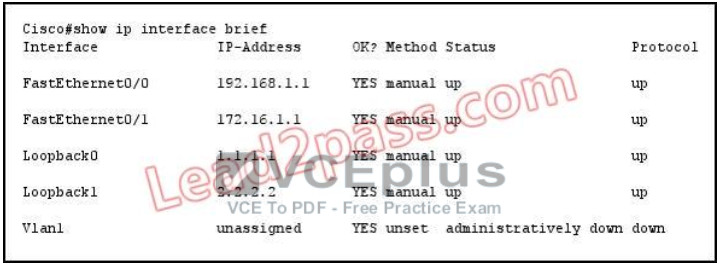
A. 192.168.1.1
B. 172.16.1.1
C. 1.1.1.1
D. 2.2.2.2
Answer: D
QUESTION 296
What command sequence will configure a router to run OSPF and add network 10.1.1.0 /24 to area 0?
A. router ospf area 0
network 10.1.1.0 255.255.255.0 area 0
B. router ospf
network 10.1.1.0 0.0.0.255
C. router ospf 1
network 10.1.1.0 0.0.0.255 area 0
D. router ospf area 0
network 10.1.1.0 0.0.0.255 area 0
E. router ospf
network 10.1.1.0 255.255.255.0 area 0
F. router ospf 1
network 10.1.1.0 0.0.0.255
Answer: C
QUESTION 297
What OSPF command, when configured, will include all interfaces into area 0?
A. network 0.0.0.0 255.255.255.255 area 0
B. network 0.0.0.0 0.0.0.0 area 0
C. network 255.255.255.255 0.0.0.0 area 0
D. network all-interfaces area 0
Answer: A
QUESTION 298
Which statement describes the process ID that is used to run OSPF on a router?
A. It is globally significant and is used to represent the AS number.
B. It is locally significant and is used to identify an instance of the OSPF database.
C. It is globally significant and is used to identify OSPF stub areas.
D. It is locally significant and must be the same throughout an area.
Answer: B
QUESTION 299
Which three are the components of SNMP? (Choose three)
A. MIB
B. SNMP Manager
C. SysLog Server
D. SNMP Agent
E. Set
Answer: ABD
Explanation:
SNMP is an application-layer protocol that provides a message format for communication between SNMP managers and agents. SNMP provides a standardized framework and a common language used for the monitoring and management of devices in a network.
The SNMP framework has three parts:
+ An SNMP manager
+ An SNMP agent
+ A Management Information Base (MIB)
The SNMP manager is the system used to control and monitor the activities of network hosts using SNMP. The most common managing system is called a Network Management System (NMS). The term NMS can be applied to either a dedicated device used for network management, or the applications used on such a device. A variety of network management applications are available for use with SNMP. These features range from simple command-line applications to feature-rich graphical user interfaces (such as the CiscoWorks2000 line of products).
The SNMP agent is the software component within the managed device that maintains the data for the device and reports these data, as needed, to managing systems. The agent and MIB reside on the routing device (router, access server, or switch). To enable the SNMP agent on a Cisco routing device, you must define the relationship between the manager and the agent.
The Management Information Base (MIB) is a virtual information storage area for network management information, which consists of collections of managed objects.
QUESTION 300
What are the Popular destinations for syslog messages to be saved?
A. Flash
B. The logging buffer .RAM
C. The console terminal
D. Other terminals
E. Syslog server
Answer: BCE
Explanation:
By default, switches send the output from system messages and debug privileged EXEC commands to a logging process. The logging process controls the distribution of logging messages to various destinations, such as the logging buffer (on RAM), terminal lines (console terminal), or a UNIX syslog server, depending on your configuration. The process also sends messages to the console.
Note: Syslog messages can be written to a file in Flash memory although it is not a popular place to use. We can configure this feature with the command logging file flash:filename.
QUESTION 301
Syslog was configured with a level 3 trap. Which 4 types of logs would be generated (choose four)
A. Emergencies
B. Alerts
C. Critical
D. Errors
E. Warnings
Answer: ABCD
Explanation:
The Message Logging is divided into 8 levels as listed below:
Level Keyword Description
0 emergencies System is unusable
1 alerts Immediate action is needed
2 critical Critical conditions exist
3 errors Error conditions exist
4 warnings Warning conditions exist
5 notification Normal, but significant, conditions exist 6 informational Informational messages
7 debugging Debugging messages
The highest level is level 0 (emergencies). The lowest level is level 7. If you specify a level with the “logging console level” command, that level and all the higher levels will be displayed. For example, by using the “logging console warnings” command, all the logging of emergencies, alerts, critical, errors, warnings will be displayed.
QUESTION 302
What are the benefit of using Netflow? (Choose three.)
A. Network, Application & User Monitoring
B. Network Planning
C. Security Analysis
D. Accounting/Billing
Answer: ACD
QUESTION 303
Which protocol can cause overload on a CPU of a managed device?
A. Netflow
B. WCCP
C. IP SLA
D. SNMP
Answer: D
Explanation:
Sometimes, messages like this might appear in the router console:
%SNMP-3-CPUHOG: Processing [chars] of [chars]
They mean that the SNMP agent on the device has taken too much time to process a request.
You can determine the cause of high CPU use in a router by using the output of the show process cpu command.
Note: A managed device is a part of the network that requires some form of monitoring and management (routers, switches, servers, workstations, printers…).
QUESTION 304
What are the three things that the Netflow uses to consider the traffic to be in a same flow?
A. IP address
B. Interface name
C. Port numbers
D. L3 protocol type
E. MAC address
Answer: ACD
Explanation:
What is an IP Flow?
Each packet that is forwarded within a router or switch is examined for a set of IP packet attributes. These attributes are the IP packet identity or fingerprint of the packet and determine if the packet is unique or similar to other packets. Traditionally, an IP Flow is based on a set of 5 and up to 7 IP packet attributes. IP Packet attributes used by NetFlow:
+ IP source address
+ IP destination address
+ Source port
+ Destination port
+ Layer 3 protocol type
+ Class of Service
+ Router or switch interface
QUESTION 305
What is the alert message generated by SNMP agents called ?
A. TRAP
B. INFORM
C. GET
D. SET
Answer: AB
Explanation:
A TRAP is a SNMP message sent from one application to another (which is typically on a remote host). Their purpose is merely to notify the other application that something has happened, has been noticed, etc. The big problem with TRAPs is that they’re unacknowledged so you don’t actually know if the remote application received your oh-so-important message to it. SNMPv2 PDUs fixed this by introducing the notion of an INFORM, which is nothing more than an acknowledged TRAP.
QUESTION 306
Which three features are added in SNMPv3 over SNMPv2?
A. Message Integrity
B. Compression
C. Authentication
D. Encryption
E. Error Detection
Answer: ACD
QUESTION 307
In a GLBP network, who is responsible for the arp request?
A. AVF
B. AVG
C. Active Router
D. Standby Router
Answer: B
QUESTION 308
What levels will be trapped if the administrator executes the command router(config)# logging trap 4 (Choose four) ?
A. Emergency
B. Notice
C. Alert
D. Error
E. Warning
Answer: ACDE
Explanation:
The Message Logging is divided into 8 levels as listed below:
Level Keyword Description
0 emergencies System is unusable
1 alerts Immediate action is needed
2 critical Critical conditions exist
3 errors Error conditions exist
4 warnings Warning conditions exist
5 notification Normal, but significant, conditions exist
6 informational Informational messages
7 debugging Debugging messages
If you specify a level with the “logging trap level” command, that level and all the higher levels will be logged.
For example, by using the “logging trap 4 command, all the logging of emergencies, alerts, critical, errors, warnings will be logged.
QUESTION 309
Hotspot Question
Refer to the topology. Your company has decided to connect the main office with three other remote branch offices using point-to-point serial links.
You are required to troubleshoot and resolve OSPF neighbor adjacency issues between the main office and the routers located in the remote branch offices.
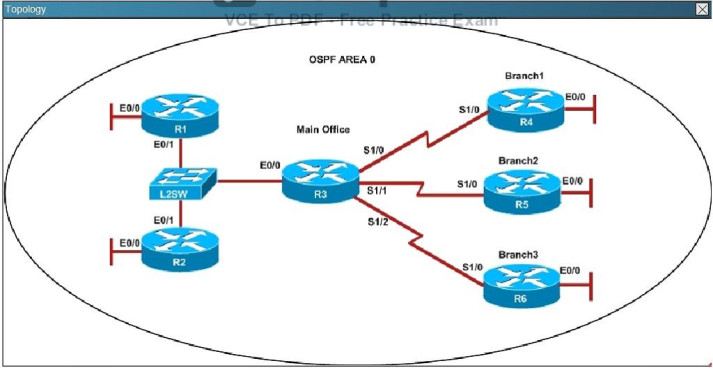
An OSPF neighbor adjacency is not formed between R3 in the main office and R4 in the Branchl office. What is causing the problem?
A. There is an area ID mismatch.
B. There is a Layer 2 issue; an encapsulation mismatch on serial links.
C. There is an OSPF hello and dead interval mismatch.
D. The R3 router ID is configured on R4.
Answer: A
Explanation:
A show running-config command on R3 and R4 shows that R4 is incorrectly configured for area
2:
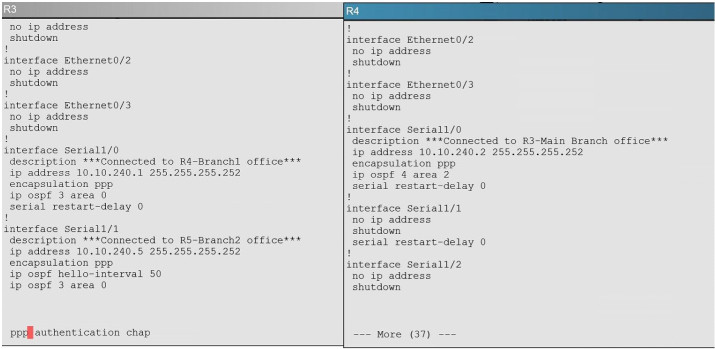
QUESTION 310
Hotspot Question
Refer to the topology. Your company has decided to connect the main office with three other remote branch offices using point-to-point serial links.
You are required to troubleshoot and resolve OSPF neighbor adjacency issues between the main office and the routers located in the remote branch offices.
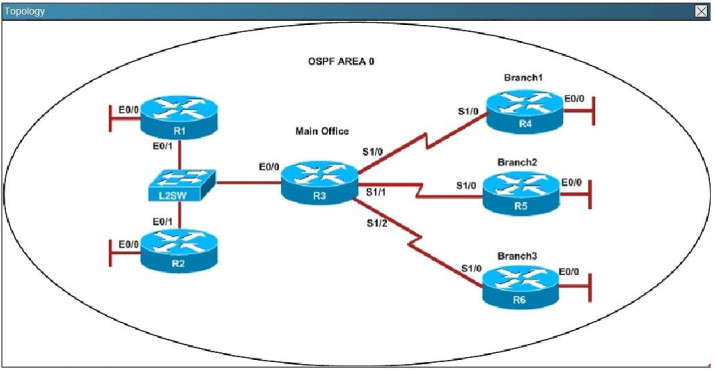
R1# show running-config interface Loopback0 description ***Loopback*** ip address 192.168.1.1 255.255.255.255 ip ospf 1 area 0 ! interface Ethernet0/0 description **Connected to R1-LAN** ip address 10.10.110.1 255.255.255.0 ip ospf 1 area 0 ! interface Ethernet0/1 description **Connected to L2SW** ip address 10.10.230.1 255.255.255.0 ip ospf hello-interval 25 ip ospf 1 area 0 ! log-adjacency-changes R2# show running-config R2 ! interface Loopback0 description **Loopback** ip address 192.168.2.2 255.255.255.255 ip ospf 2 area 0 ! interface Ethernet0/0 description **Connected to R2-LAN** ip address 10.10.120.1 255.255.255.0 ip ospf 2 area 0 ! interface Ethernet0/1 description **Connected to L2SW** ip address 10.10.230.2 255.255.255.0 ip ospf 2 area 0 ! router ospf 2 log-adjacency-changes R3# show running-config R3 username R6 password CISCO36 ! interface Loopback0 description **Loopback** ip address 192.168.3.3 255.255.255.255 ip ospf 3 area 0 ! interface Ethernet0/0 description **Connected to L2SW** ip address 10.10.230.3 255.255.255.0 ip ospf 3 area 0 ! interface Serial1/0 description **Connected to R4-Branch1 office** ip address 10.10.240.1 255.255.255.252 encapsulation ppp ip ospf 3 area 0 ! interface Serial1/1 description **Connected to R5-Branch2 office** ip address 10.10.240.5 255.255.255.252 encapsulation ppp ip ospf hello-interval 50 ip ospf 3 area 0 ! interface Serial1/2 description **Connected to R6-Branch3 office** ip address 10.10.240.9 255.255.255.252 encapsulation ppp ip ospf 3 area 0 ppp authentication chap ! router ospf 3 router-id 192.168.3.3 ! R4# show running-config R4 ! interface Loopback0 description **Loopback** ip address 192.168.4.4 255.255.255.255 ip ospf 4 area 2 ! interface Ethernet0/0 ip address 172.16.113.1 255.255.255.0 ip ospf 4 area 2 ! interface Serial1/0 description **Connected to R3-Main Branch office** ip address 10.10.240.2 255.255.255.252 encapsulation ppp ip ospf 4 area 2 ! router ospf 4 log-adjacency-changes R5# show running-config R5 ! interface Loopback0 description **Loopback** ip address 192.168.5.5 255.255.255.255 ip ospf 5 area 0 ! interface Ethernet0/0 ip address 172.16.114.1 255.255.255.0 ip ospf 5 area 0 ! interface Serial1/0 description **Connected to R3-Main Branch office** ip address 10.10.240.6 255.255.255.252 encapsulation ppp ip ospf 5 area 0 ! router ospf 5 log-adjacency-changes R6# show running-config R6 username R3 password CISCO36 ! interface Loopback0 description **Loopback** ip address 192.168.6.6 255.255.255.255 ip ospf 6 area 0 ! interface Ethernet0/0 ip address 172.16.115.1 255.255.255.0 ip ospf 6 area 0 ! interface Serial1/0 description **Connected to R3-Main Branch office** ip address 10.10.240.10 255.255.255.252 encapsulation ppp ip ospf 6 area 0 ppp authentication chap ! router ospf 6 router-id 192.168.3.3 !
An OSPF neighbor adjacency is not formed between R3 in the main office and R5 in the Branch2 office. What is causing the problem?
A. There is an area ID mismatch.
B. There is a PPP authentication issue; a password mismatch.
C. There is an OSPF hello and dead interval mismatch.
D. There is a missing network command in the OSPF process on R5.
Answer: C
Explanation:
The “show ip ospf interface command on R3 and R5 shows that the hello and dead intervals do not match. They are 50 and 200 on R3 and 10 and 40 on R5.
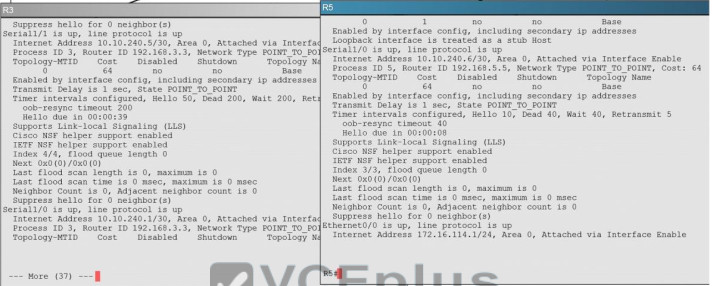
QUESTION 311
Hotspot Question:
Refer to the topology. Your company has decided to connect the main office with three other remote branch offices using point-to-point serial links.
You are required to troubleshoot and resolve OSPF neighbor adjacency issues between the main office and the routers located in the remote branch offices.
Use appropriate show commands to troubleshoot the issues and answer all four questions.
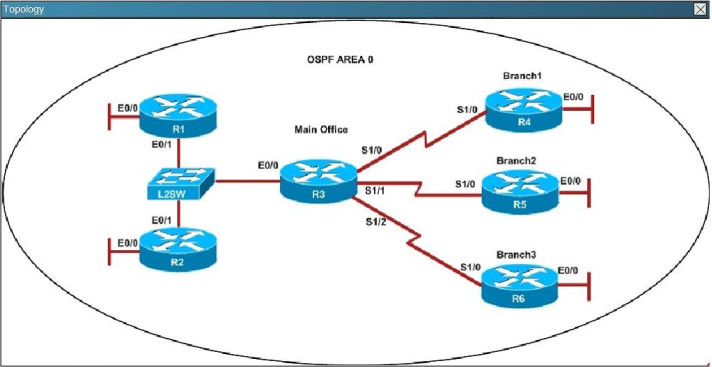
R1# show running-config interface Loopback0 description ***Loopback*** ip address 192.168.1.1 255.255.255.255 ip ospf 1 area 0 ! interface Ethernet0/0 description **Connected to R1-LAN** ip address 10.10.110.1 255.255.255.0 ip ospf 1 area 0 ! interface Ethernet0/1 description **Connected to L2SW** ip address 10.10.230.1 255.255.255.0 ip ospf hello-interval 25 ip ospf 1 area 0 ! log-adjacency-changes R2# show running-config R2 ! interface Loopback0 description **Loopback** ip address 192.168.2.2 255.255.255.255 ip ospf 2 area 0 ! interface Ethernet0/0 description **Connected to R2-LAN** ip address 10.10.120.1 255.255.255.0 ip ospf 2 area 0 ! interface Ethernet0/1 description **Connected to L2SW** ip address 10.10.230.2 255.255.255.0 ip ospf 2 area 0 ! router ospf 2 log-adjacency-changes R3# show running-config R3 username R6 password CISCO36 ! interface Loopback0 description **Loopback** ip address 192.168.3.3 255.255.255.255 ip ospf 3 area 0 ! interface Ethernet0/0 description **Connected to L2SW** ip address 10.10.230.3 255.255.255.0 ip ospf 3 area 0 ! interface Serial1/0 description **Connected to R4-Branch1 office** ip address 10.10.240.1 255.255.255.252 encapsulation ppp ip ospf 3 area 0 ! interface Serial1/1 description **Connected to R5-Branch2 office** ip address 10.10.240.5 255.255.255.252 encapsulation ppp ip ospf hello-interval 50 ip ospf 3 area 0 ! interface Serial1/2 description **Connected to R6-Branch3 office** ip address 10.10.240.9 255.255.255.252 encapsulation ppp ip ospf 3 area 0 ppp authentication chap ! router ospf 3 router-id 192.168.3.3 ! R4# show running-config R4 ! interface Loopback0 description **Loopback** ip address 192.168.4.4 255.255.255.255 ip ospf 4 area 2 ! interface Ethernet0/0 ip address 172.16.113.1 255.255.255.0 ip ospf 4 area 2 ! interface Serial1/0 description **Connected to R3-Main Branch office** ip address 10.10.240.2 255.255.255.252 encapsulation ppp ip ospf 4 area 2 ! router ospf 4 log-adjacency-changes R5# show running-config R5 ! interface Loopback0 description **Loopback** ip address 192.168.5.5 255.255.255.255 ip ospf 5 area 0 ! interface Ethernet0/0 ip address 172.16.114.1 255.255.255.0 ip ospf 5 area 0 ! interface Serial1/0 description **Connected to R3-Main Branch office** ip address 10.10.240.6 255.255.255.252 encapsulation ppp ip ospf 5 area 0 ! router ospf 5 log-adjacency-changes R6# show running-config R6 username R3 password CISCO36 ! interface Loopback0 description **Loopback** ip address 192.168.6.6 255.255.255.255 ip ospf 6 area 0 ! interface Ethernet0/0 ip address 172.16.115.1 255.255.255.0 ip ospf 6 area 0 ! interface Serial1/0 description **Connected to R3-Main Branch office** ip address 10.10.240.10 255.255.255.252 encapsulation ppp ip ospf 6 area 0 ppp authentication chap ! router ospf 6 router-id 192.168.3.3 !
R1 does not form an OSPF neighbor adjacency with R2. Which option would fix the issue?
A. R1 ethernetO/1 is shutdown. Configure no shutdown command.
B. R1 ethernetO/1 configured with a non-default OSPF hello interval of 25: configure no ip ospf hello-interval 25
C. R2 ethernetO/1 and R3 ethernetO/O are configured with a non-default OSPF hello interval of 25; configure no ip ospf hello-interval 25
D. Enable OSPF for R1 ethernetO/1; configure ip ospf 1 area 0 command under ethernetO/1
Answer: B
Explanation:
Looking at the configuration of R1, we see that R1 is configured with a hello interval of 25 on interface Ethernet 0/1 while R2 is left with the default of 10 (not configured).
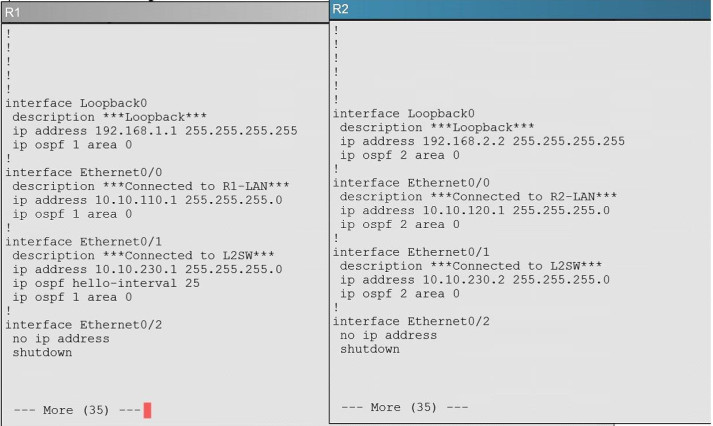
QUESTION 312
Hotspot Question
Refer to the topology. Your company has decided to connect the main office with three other remote branch offices using point-to-point serial links.
You are required to troubleshoot and resolve OSPF neighbor adjacency issues between the main office and the routers located in the remote branch offices.
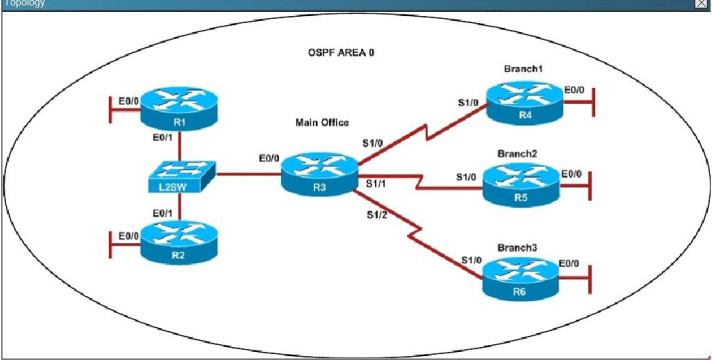
An OSPF neighbor adjacency is not formed between R3 in the main office and R6 in the Branch3 office. What is causing the problem?
A. There is an area ID mismatch.
B. There is a PPP authentication issue; the username is not configured on R3 and R6.
C. There is an OSPF hello and dead interval mismatch.
D. The R3 router ID is configured on R6.
Answer: D
Explanation:
Using the show running-config command we see that R6 has been incorrectly configured with the same router ID as R3 under the router OSPF process.
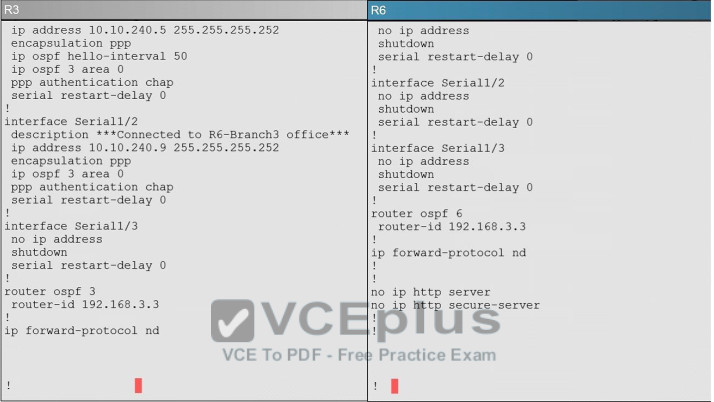
QUESTION 313
Hotspot Question
Refer to the topology. Your company has connected the routers R1. R2. and R3 with serial links.
R2 and R3 are connected to the switches SW1 and SW2, respectively. SW1 and SW2 are also connected to the routers R4 and R5.
The EIGRP routing protocol is configured.
You are required to troubleshoot and resolve the EIGRP issues between the various routers.
Use the appropriate show commands to troubleshoot the issues.
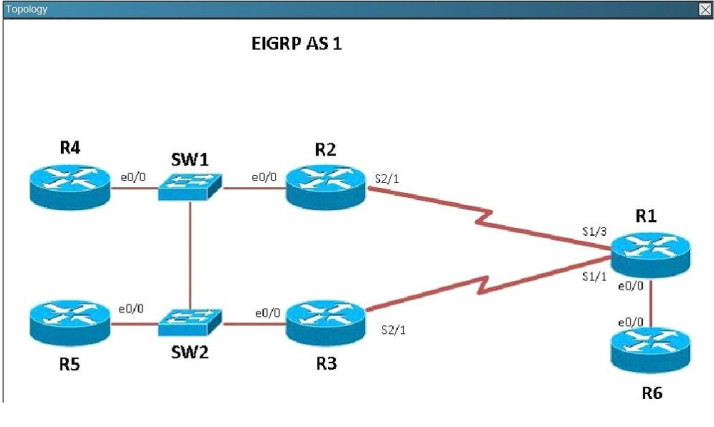
The loopback interfaces on R4 with the IP addresses of 10.4.4.4 /32, 10.4.4.5/32. and 10.4.4.6/32 are not appearing in the routing table of R5 Why are the interfaces missing?
A. The interfaces are shutdown, so they are not being advertised.
B. R4 has been incorrectly configured to be in another AS, so it does not peer with R5.
C. Automatic summarization is enabled, so only the 10.0.0.0 network is displayed.
D. The loopback addresses haven’t been advertised, and the network command is missing on R4.
Answer: B
Explanation:
For an EIGRP neighbor to form, the following must match:
– Neighbors must be in the same subnet- K values- AS numbers- Authentication method and key strings
Here, we see that R4 is configured for EIGRP AS 2, when it should be AS 1.
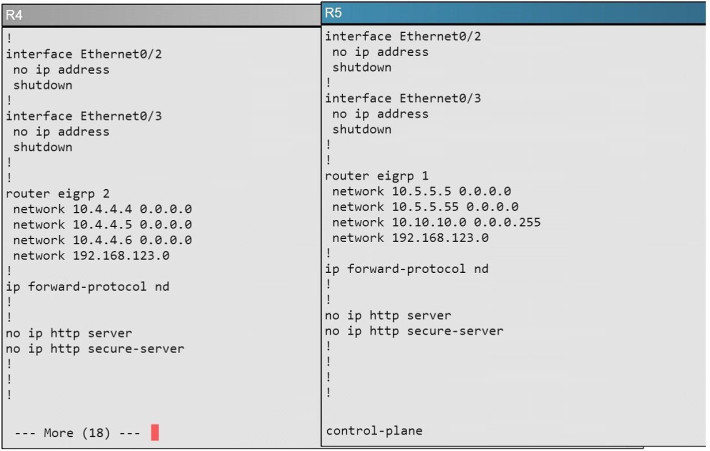
QUESTION 314
Hotspot Question
Refer to the topology. Your company has connected the routers R1. R2. and R3 with serial links.
R2 and R3 are connected to the switches SW1 and SW2, respectively. SW1 and SW2 are also
connected to the routers R4 and R5.
The EIGRP routing protocol is configured.
You are required to troubleshoot and resolve the EIGRP issues between the various routers.
Use the appropriate show commands to troubleshoot the issues.
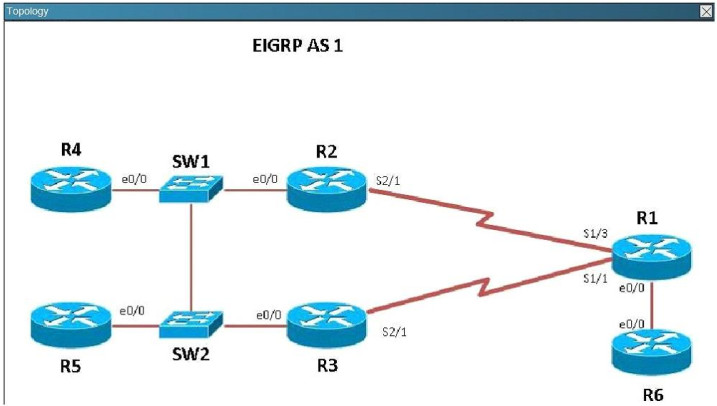
Which path does traffic take from R1 to R5?
A. The traffic goes through R2.
B. The traffic goes through R3.
C. The traffic is equally load-balanced over R2 and R3.
D. The traffic is unequally load-balanced over R2 and R3.
Answer: A
Explanation:
Using the “show ip int brief command” on R5 we can see the IP addresses assigned to this router. Then, using the “show ip route” command on R1 we can see that to reach 10.5.5.5 and 10.5.5.55 the preferred path is via Serial 1/3, which we see from the diagram is the link to R2.
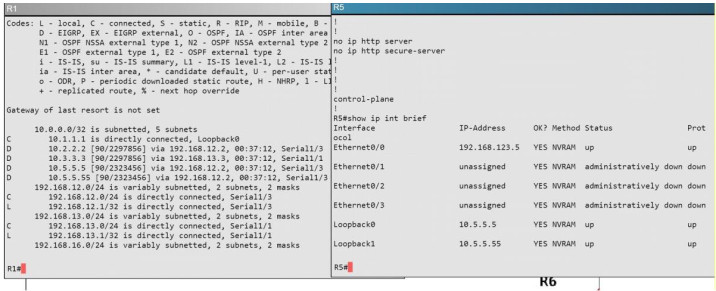
QUESTION 315
Hotspot Question
Refer to the topology. Your company has connected the routers R1. R2. and R3 with serial links.
R2 and R3 are connected to the switches SW1 and SW2, respectively. SW1 and SW2 are also connected to the routers R4 and R5.
The EIGRP routing protocol is configured.
You are required to troubleshoot and resolve the EIGRP issues between the various routers.
Use the appropriate show commands to troubleshoot the issues.
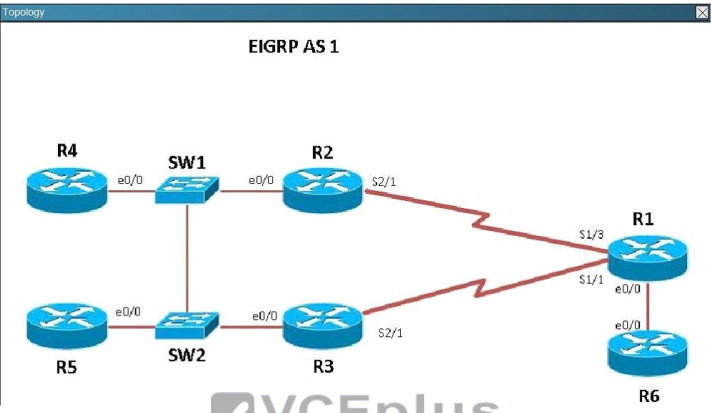
Router R6 does not form an EIGRP neighbor relationship correctly with router R1. What is the cause for this misconfiguration?
A. The K values mismatch.
B. The AS does not match.
C. The network command is missing.
D. The passive-interface command is enabled.
Answer: C
Explanation:
The link from R1 to R6 is shown below:
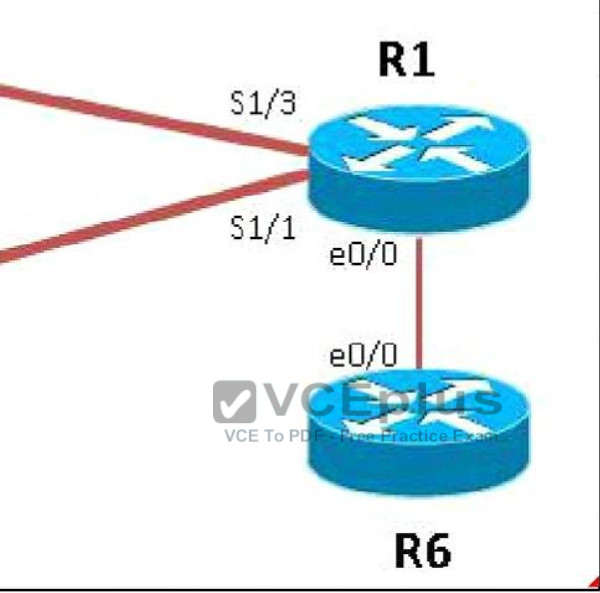
As you can see, they are both using e0/0. The IP addresses are in the 192.168.16.0 network:
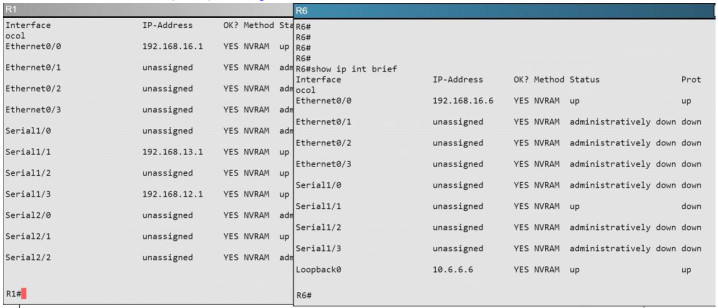
But when we look at the EIGRP configuration, the “network 192.168.16.0” command is missing on R6.
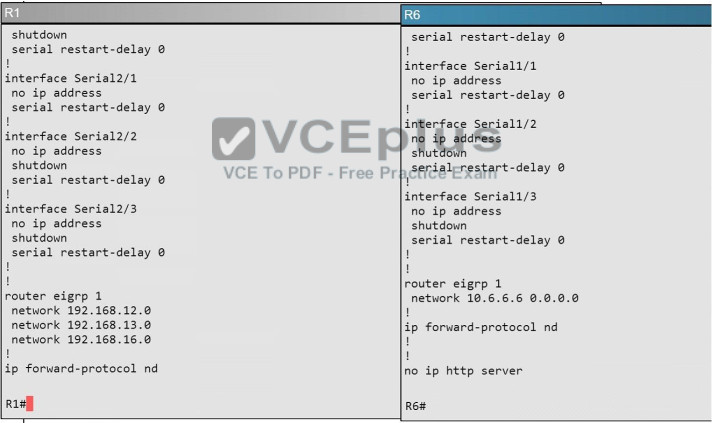
Study the following output taken on R1:
R1# Ping 10.5.5.55 source 10.1.1.1
Type escape sequence to abort.
Sending 5, 100-byte ICMP Echos to 10.5.5.55, timeout is 2 seconds:
Packet sent with a source address of 10.1.1.1
…….
Success rate is 0 percent (0/5)
QUESTION 316
Hotspot Question
Refer to the topology. Your company has connected the routers R1. R2. and R3 with serial links.
R2 and R3 are connected to the switches SW1 and SW2, respectively. SW1 and SW2 are also connected to the routers R4 and R5.
The EIGRP routing protocol is configured.
You are required to troubleshoot and resolve the EIGRP issues between the various routers.
Use the appropriate show commands to troubleshoot the issues.
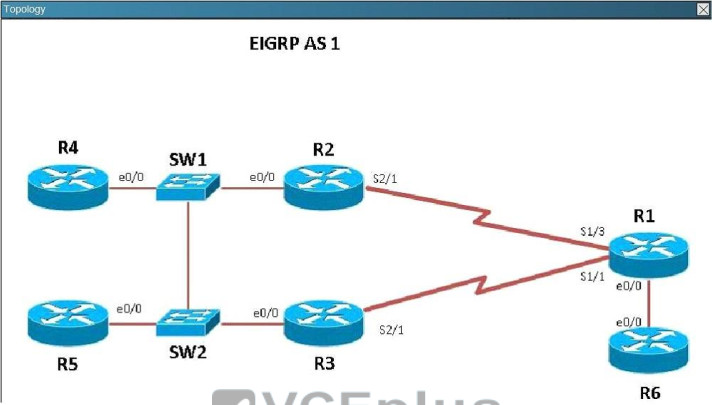
Why are the pings failing?
A. The network statement is missing on R5.
B. The loopback interface is shut down on R5.
C. The network statement is missing on R1.
D. The IP address that is configured on the Lo1 interface on R5 is incorrect.
Answer: C
Explanation:
R5 does not have a route to the 10.1.1.1 network, which is the loopback0 IP address of R1.
When looking at the EIGRP configuration on R1, we see that the 10.1.1.1 network statement is missing on R1.
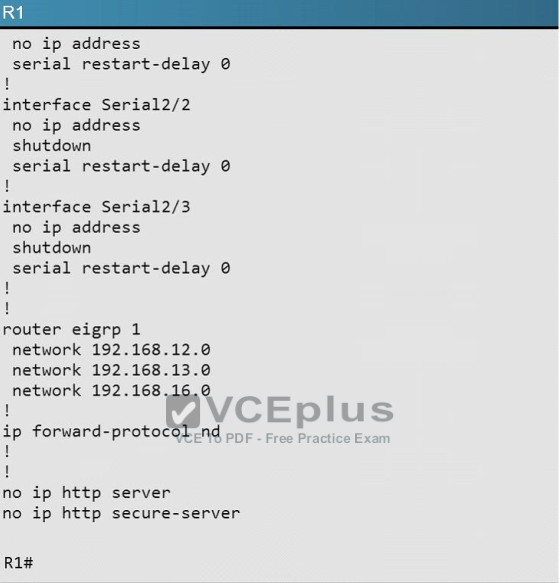
QUESTION 317
What is a valid HSRP virtual MAC address?
A. 0000.5E00.01A3
B. 0007.B400.AE01
C. 0000.0C07.AC15
D. 0007.5E00.B301
Answer: C
Explanation:
With HSRP, two or more devices support a virtual router with a fictitious MAC address and unique IP address. There are two version of HSRP.
+ With HSRP version 1, the virtual router’s MAC address is 0000.0c07.ACxx , in which xx is the HSRP group.
+ With HSRP version 2, the virtual MAC address if 0000.0C9F.Fxxx, in which xxx is the HSRP group.
Note: Another case is HSRP for IPv6, in which the MAC address range from 0005.73A0.0000 through 0005.73A0.0FFF.
QUESTION 318
In GLBP, which router will respond to client ARP requests?
A. The active virtual gateway will reply with one of four possible virtual MAC addresses.
B. All GLBP member routers will reply in round-robin fashion.
C. The active virtual gateway will reply with its own hardware MAC address.
D. The GLBP member routers will reply with one of four possible burned in hardware addresses.
Answer: A
Explanation:
One disadvantage of HSRP and VRRP is that only one router is in use, other routers must wait for the primary to fail because they can be used. However, Gateway Load Balancing Protocol (GLBP) can use of up to four routers simultaneously. In GLBP, there is still only one virtual IP address but each router has a different virtual MAC address. First a GLBP group must elect an Active Virtual Gateway (AVG). The AVG is responsible for replying ARP requests from hosts/clients. It replies with different virtual MAC addresses that correspond to different routers (known as Active Virtual Forwarders – AVFs) so that clients can send traffic to different routers in that GLBP group (load sharing).
QUESTION 319
Which statement describes VRRP object tracking?
A. It monitors traffic flow and link utilization.
B. It ensures the best VRRP router is the virtual router master for the group.
C. It causes traffic to dynamically move to higher bandwidth links.
D. It thwarts man-in-the-middle attacks.
Answer: B
Explanation:
Object tracking is the process of tracking the state of a configured object and uses that state to determine the priority of the VRRP router in a VRRP group
QUESTION 320
What is a global command?
A. a command that is set once and affects the entire router
B. a command that is implemented in all foreign and domestic IOS versions
C. a command that is universal in application and supports all protocols
D. a command that is available in every release of IOS, regardless of the version or deployment status
E. a command that can be entered in any configuration mode
Answer: A
Explanation:
When you enter global configuration mode and enter a command, it is applied to the running configuration file that is currently running in ram. The configuration of a global command affects the entire router. An example of a global command is one used for the hostname of the router.
QUESTION 321
An administrator is unsuccessful in adding VLAN 50 to a switch. While troubleshooting the problem, the administrator views the output of the show vtp status command, which is displayed in the graphic. What commands must be issued on this switch to add VLAN 50 to the database? (Choose two.)
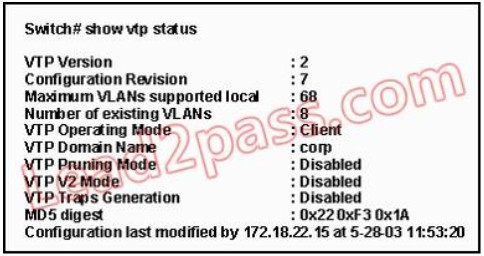
A. Switch(config-if)# switchport access vlan 50
B. Switch(vlan)# vtp server
C. Switch(config)# config-revision 20
D. Switch(config)# vlan 50 name Tech
E. Switch(vlan)# vlan 50
F. Switch(vlan)# switchport trunk vlan 50
Answer: BE
QUESTION 322
Which of the following IP addresses fall into the CIDR block of 115.64.4.0/22? (Choose three.)
A. 115.64.8.32
B. 115.64.7.64
C. 115.64.6.255
D. 115.64.3.255
E. 115.64.5.128
F. 115.64.12.128
Answer: BCE
QUESTION 323
Which of the following are types of flow control? (Choose three.)
A. buffering
B. cut-through
C. windowing
D. congestion avoidance
E. load balancing
Answer: ACD
QUESTION 324
Refer to the exhibit. After a RIP route is marked invalid on Router_1, how much time will elapse before that route is removed from the routing table?

A. 30 seconds
B. 60 seconds
C. 90 seconds
D. 180 seconds
E. 240 seconds
Answer: E
QUESTION 325
Refer to the exhibit. A network associate has configured the internetwork that is shown in the exhibit, but has failed to configure routing properly.

Which configuration will allow the hosts on the Branch LAN to access resources on the HQ LAN with the least impact on router processing and WAN bandwidth?
A. HQ(config)# ip route 192.168.1.0 255.255.255.0 192.168.2.5
Branch(config)# ip route 172.16.25.0 255.255.255.0 192.168.2.6
B. HQ(config)# router rip
HQ(config-router)# network 192.168.2.0
HQ(config-router)# network 172.16.0.0
Branch(config)# router rip
Branch(config-router)# network 192.168.1.0
Branch(config-router)# network 192.168.2.0
C. HQ(config)# router eigrp 56
HQ(config-router)# network 192.168.2.4
HQ(config-router)# network 172.16.25.0
Branch(config)# router eigrp 56
Branch(config-router)# network 192.168.1.0
Branch(config-router)# network 192.168.2.4
D. HQ(config)# router ospf 1
HQ(config-router)# network 192.168.2.4 0.0.0.3 area 0
HQ(config-router)# network 172.16.25.0 0.0.0.255 area 0
Branch(config)# router ospf 1
Branch(config-router)# network 192.168.1.0 0.0.0.255 area 0
Answer: A
QUESTION 326
Which additional configuration step is necessary in order to connect to an access point that has SSID broadcasting disabled?
A. Set the SSID value in the client software to public.
B. Configure open authentication on the AP and the client.
C. Set the SSID value on the client to the SSID configured on the AP.
D. Configured MAC address filtering to permit the client to connect to the AP.
Answer: C
QUESTION 327
What is one reason that WPA encryption is preferred over WEP?
A. A WPA key is longer and requires more special characters than the WEP key.
B. The access point and the client are manually configured with different WPA key values.
C. WPA key values remain the same until the client configuration is changed.
D. The values of WPA keys can change dynamically while the system is used.
Answer: D
QUESTION 328
All WAN links inside the ABC University network use PPP with CHAP for authentication security.
Which command will display the CHAP authentication process as it occur between two routers in the network?
A. show chap authentication
B. show interface serial0
C. debug ppp authentication
D. debug chap authentication
E. show ppp authentication chap
Answer: C
QUESTION 329
Refer to the exhibit. The network is converged. After link-state advertisements are received from Router_A, what information will Router_E contain in its routing table for the subnets 208.149.23.64 and 208.149.23.96?
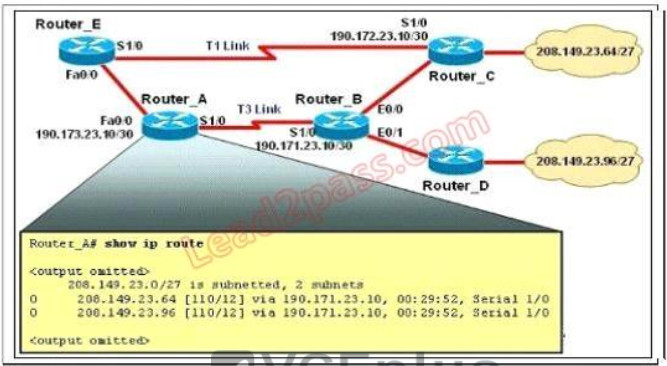
A. 208.149.23.64[110/13] via 190.173.23.10, 00:00:00:07, FastEthernet0/0
208.149.23.96[110/13] via 190.173.23.10, 00:00:00:16, FastEthernet0/0
B. 208.149.23.64[110/1] via 190.173.23.10, 00:00:00:07, Serial1/0
208.149.23.96[110/3] via 190.173.23.10, 00:00:00:16, FastEthernet0/0
C. 208.149.23.64[110/13] via 190.173.23.10, 00:00:00:07, Serial1/0
208.149.23.96[110/13] via 190.173.23.10, 00:00:00:16, Serial1/0
208.149.23.96[110/13] via 190.173.23.10, 00:00:00:16, FastEthernet0/0
D. 208.149.23.64[110/13] via 190.173.23.10, 00:00:00:07, Serial1/0
208.149.23.96[110/13] via 190.173.23.10, 00:00:00:16, Serial1/0
Answer: A
QUESTION 330
What are two characteristics of SSH? (Choose two.)
A. most common remote-access method
B. unsecured
C. encrypted
D. uses port 22
E. operates at the transport layer
Answer: DE
QUESTION 331
Refer to the exhibit. The access list has been configured on the S0/0 interface of router RTB in the outbound direction. Which two packets, if routed to the interface, will be denied? (Choose two.) access-list 101 deny tcp 192.168.15.32 0.0.0.15 any eq telnet access-list 101 permit ip any any
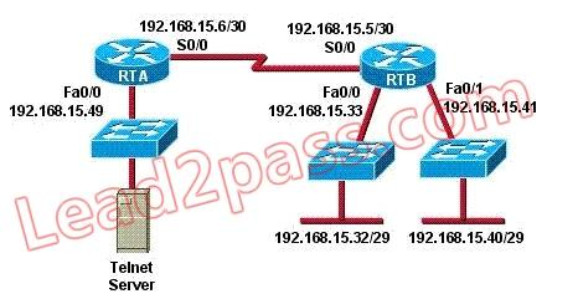
A. source ip address: 192.168.15.5; destination port: 21
B. source ip address:, 192.168.15.37 destination port: 21
C. source ip address:, 192.168.15.41 destination port: 21
D. source ip address:, 192.168.15.36 destination port: 23
E. source ip address: 192.168.15.46; destination port: 23
F. source ip address:, 192.168.15.49 destination port: 23
Answer: DE
QUESTION 332
Refer to the graphic. It has been decided that Workstation 1 should be denied access to Server1. Which of the following commands are required to prevent only Workstation 1 from accessing Server1 while allowing all other traffic to flow normally? (Choose two.)

A. RouterA(config)# interface fa0/0
RouterA(config-if)# ip access-group 101 out
B. RouterA(config)# interface fa0/0
RouterA(config-if)# ip access-group 101 in
C. RouterA(config)# access-list 101 deny ip host 172.16.161.150 host 172.16.162.163
RouterA(config)# access-list 101 permit ip any any
D. RouterA(config)# access-list 101 deny ip 172.16.161.150 0.0.0.255 172.16.162.163 0.0.0.0
RouterA(config)# access-list 101 permit ip any any
Answer: BC
QUESTION 333
An access list was written with the four statements shown in the graphic. Which single access list statement will combine all four of these statements into a single statement that will have exactly the same effect?

A. access-list 10 permit 172.29.16.0 0.0.0.255
B. access-list 10 permit 172.29.16.0 0.0.1.255
C. access-list 10 permit 172.29.16.0 0.0.3.255
D. access-list 10 permit 172.29.16.0 0.0.15.255
E. access-list 10 permit 172.29.0.0 0.0.255.255
Answer: C
QUESTION 334
A network administrator wants to add a line to an access list that will block only Telnet access by the hosts on subnet 192.168.1.128/28 to the server at 192.168.1.5. What command should be issued to accomplish this task?
A. access-list 101 deny tcp 192.168.1.128 0.0.0.15 192.168.1.5 0.0.0.0 eq 23
access-list 101 permit ip any any
B. access-list 101 deny tcp 192.168.1.128 0.0.0.240 192.168.1.5 0.0.0.0 eq 23
access-list 101 permit ip any any
C. access-list 1 deny tcp 192.168.1.128 0.0.0.255 192.168.1.5 0.0.0.0 eq 21
access-list 1 permit ip any any
D. access-list 1 deny tcp 192.168.1.128 0.0.0.15 host 192.168.1.5 eq 23
access-list 1 permit ip any any
Answer: A
QUESTION 335
As a network administrator, you have been instructed to prevent all traffic originating on the LAN from entering the R2 router.
Which the following command would implement the access list on the interface of the R2 router?

A. access-list 101 in
B. access-list 101 out
C. ip access-group 101 in
D. ip access-group 101 out
Answer: C
QUESTION 336
The access control list shown in the graphic has been applied to the Ethernet interface of router R1 using the ip access-group 101 in command.
Which of the following Telnet sessions will be blocked by this ACL? (Choose two.)
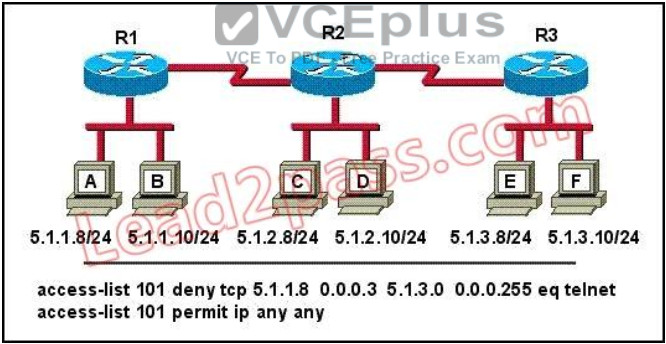
A. from host A to host 5.1.1.10
B. from host A to host 5.1.3.10
C. from host B to host 5.1.2.10
D. from host B to host 5.1.3.8
E. from host C to host 5.1.3.10
F. from host F to host 5.1.1.10
Answer: BD
QUESTION 337
The following access list below was applied outbound on the E0 interface connected to the 192.169.1.8/29 LAN: access-list 135 deny tcp 192.169.1.8 0.0.0.7 eq 20 any access-list 135 deny tcp 192.169.1.8 0.0.0.7 eq 21 any How will the above access lists affect traffic?
A. FTP traffic from 192.169.1.22 will be denied
B. No traffic, except for FTP traffic will be allowed to exit E0
C. FTP traffic from 192.169.1.9 to any host will be denied
D. All traffic exiting E0 will be denied
E. All FTP traffic to network 192.169.1.9/29 will be denied
Answer: D
QUESTION 338
The following configuration line was added to router R1 Access-list 101 permit ip 10.25.30.0 0.0.0.255 any. What is the effect of this access list configuration?
A. ermit all packets matching the first three octets of the source address to all destinations
B. permit all packet matching the last octet of the destination address and accept all source addresses
C. permit all packet matching the host bits in the source address to all destinations
D. permit all packet from the third subnet of the network address to all destinations
Answer: A
QUESTION 339
A default Frame Relay WAN is classified as what type of physical network?
A. point-to-point
B. broadcast multi-access
C. nonbroadcast multi-access
D. nonbroadcast multipoint
E. broadcast point-to-multipoint
Answer: C
QUESTION 340
Which of the following are key characteristics of PPP? (Choose three.)
A. can be used over analog circuits
B. maps Layer 2 to Layer 3 address
C. encapsulates several routed protocols
D. supports IP only
E. provides error correction
Answer: ACE
QUESTION 341
How should a router that is being used in a Frame Relay network be configured to avoid split horizon issues from preventing routing updates?
A. Configure a separate sub-interface for each PVC with a unique DLCI and subnet assigned to the sub-interface
B. Configure each Frame Relay circuit as a point-to-point line to support multicast and broadcast traffic
C. Configure many sub-interfaces on the same subnet
D. Configure a single sub-interface to establish multiple PVC connections to multiple remote router interfaces
Answer: A
QUESTION 342
The Frame Relay network in the diagram is not functioning properly. What is the cause of the problem?
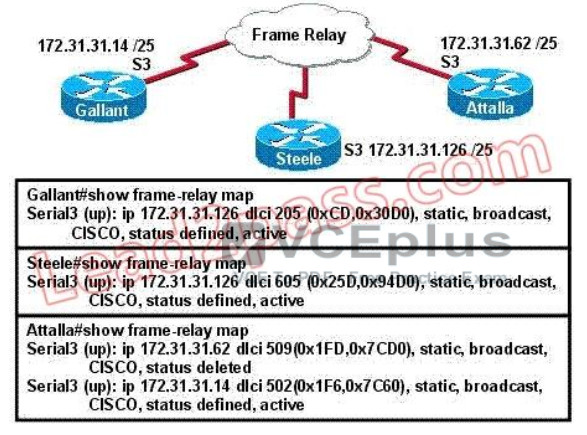
A. The Gallant router has the wrong LMI type configured
B. Inverse ARP is providing the wrong PVC information to the Gallant router
C. The S3 interface of the Steele router has been configured with the frame-relay encapsulation ietf command
D. The frame-relay map statement in the Attalla router for the PVC to Steele is not correct
E. The IP address on the serial interface of the Attalla router is configured incorrectly
Answer: D
QUESTION 343
As a CCNA candidate, you must have a firm understanding of the IPv6 address structure. Refer to IPv6 address, could you tell me how many bits are included in each filed?
A. 24
B. 4
C. 3
D. 16
Answer: D
QUESTION 344
Refer to the exhibit. How many broadcast domains exist in the exhibited topology?
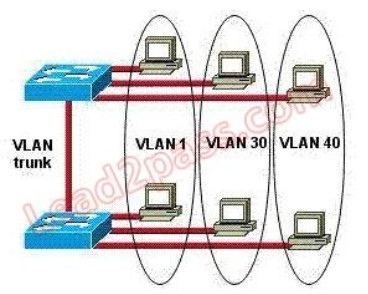
A. one
B. two
C. three
D. four
E. five
F. six
Answer: C
QUESTION 345
Refer to the exhibit. The network administrator has created a new VLAN on Switch1 and added host C and host D. The administrator has properly configured switch interfaces FastEthernet0/13 through FastEthernet0/14 to be members of the new VLAN. However, after the network administrator completed the configuration, host A could communicate with host B, but host A could not communicate with host C or host D. Which commands are required to resolve this problem?
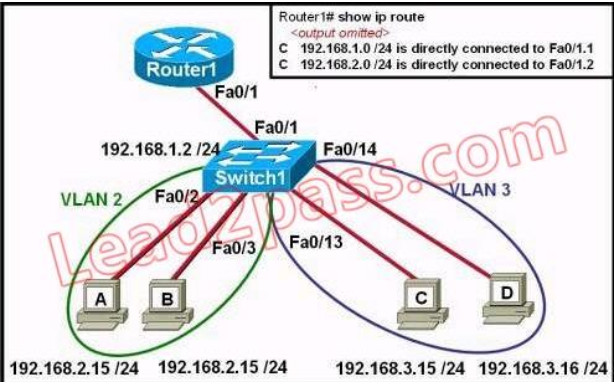
A. Router(config)# interface fastethernet 0/1.3
Router(config-if)# encapsulation dot1q 3
Router(config-if)# ip address 192.168.3.1 255.255.255.0
B. Router(config)# router rip
Router(config-router)# network 192.168.1.0
Router(config-router)# network 192.168.2.0
Router(config-router)# network192.168.3.0
C. Switch1# vlan database
Switch1(vlan)# vtp v2-mode
Switch1(vlan)# vtp domain cisco
Switch1(vlan)# vtp server
D. Switch1(config)# interface fastethernet 0/1
Switch1(config-if)# switchport mode trunk
Switch1(config-if)# switchport trunk encapsulation isl
Answer: A
QUESTION 346
On a network of one department, there are four PCs connected to a switch, as shown in the following figure: After the Switch1 restarts. Host A ( the host on the left ) sends the first frame to Host C (the host on the right). What the first thing should the switch do?
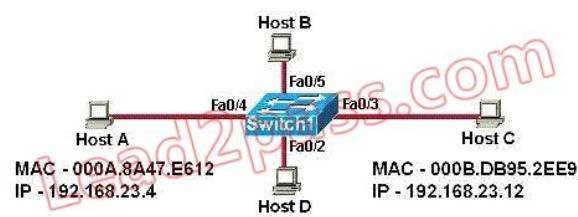
A. Switch1 will add 192.168.23.12 to the switching table.
B. Switch1 will add 192.168.23.4 to the switching table.
C. Switch1 will add 000A.8A47.E612 to the switching table.
D. None of the above
Answer: C
QUESTION 347
Refer to the exhibit. The network administrator is in a campus building distant from Building B. WANRouter is hosting a newly installed WAN link on interface S0/0. The new link is not functioning and the administrator needs to determine if the correct cable has been attached to the S0/0 interface. How can the administrator accurately verify the correct cable type on S0/0 in the most efficient manner?
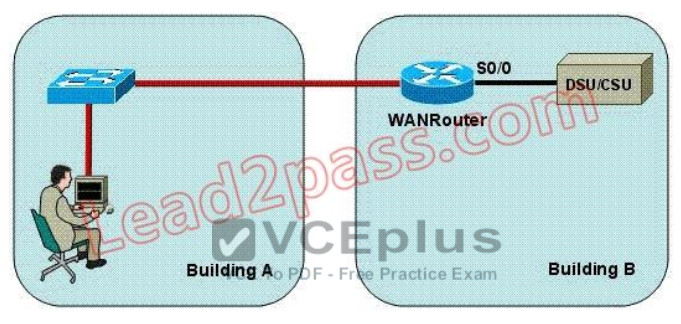
A. Telnet to WANRouter and execute the command show interfaces S0/0
B. Telnet to WANRouter and execute the command show processes S0/0
C. Telnet to WANRouter and execute the command show running-configuration
D. Telnet to WANRouter and execute the command show controller S0/0
E. Physically examine the cable between WANRouter S0/0 and the DCE.
F. Establish a console session on WANRouter and execute the command show interfaces S0/0
Answer: D
QUESTION 348
While troubleshooting a connectivity issue from a PC you obtain the following information:
Local PC IP address: 10.0.0.35/24
Default Gateway: 10.0.0.1
Remote Sever: 10.5.75.250/24
You then conduct the following tests from the local PC:
Ping 127.0.0.1 – Successful
Ping 10.0.0.35 – Successful
Ping 10.0.0.1 – Unsuccessful
Ping 10.5.75.250 – Unsuccessful

What is the underlying cause of this problem?
A. A remote physical layer problem exists.
B. The host NIC is not functioning.
C. TCP/IP has not been correctly installed on the host.
D. A local physical layer problem exists.
Answer: D
QUESTION 349
A network administrator is troubleshooting the OSPF configuration of routers R1 and R2. The routers cannot establish an adjacency relationship on their common Ethernet link. The graphic shows the output of the show ip ospf interface e0 command for routers R1 and R2.
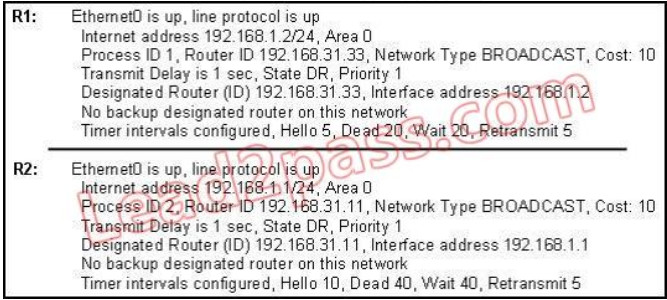
Based on the information in the graphic, what is the cause of this problem?
A. The OSPF area is not configured properly.
B. The priority on R1 should be set higher.
C. The cost on R1 should be set higher.
D. The hello and dead timers are not configured properly.
E. A backup designated router needs to be added to the network.
F. The OSPF process ID numbers must match.
Answer: D
QUESTION 350
This graphic shows the results of an attempt to open a Telnet connection to router ACCESS1 from router Remote27.
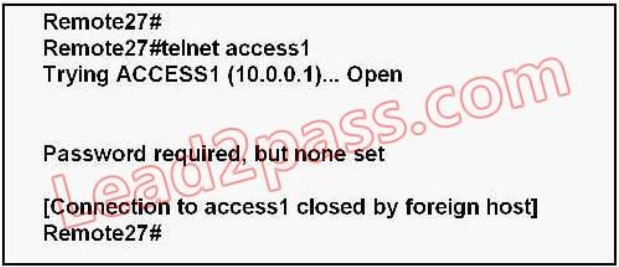
Which of the following command sequences will correct this problem?
A. ACCESS1(config)# line console 0
ACCESS1(config-line)# password cisco
B. Remote27(config)# line console 0
Remote27(config-line)# login
Remote27(config-line)# password cisco
C. ACCESS1(config)# line vty 0 4
ACCESS1(config-line)# login
ACCESS1(config-line)# password cisco
D. Remote27(config)# line vty 0 4
Remote27(config-line)# login
Remote27(config-line)# password cisco
E. ACCESS1(config)# enable password cisco
F. Remote27(config)# enable password cisco
Answer: C
QUESTION 351
When upgrading the IOS image, the network administrator receives the exhibited error message.
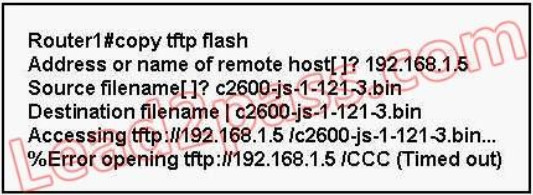
What could be the cause of this error?
A. The new IOS image is too large for the router flash memory.
B. The TFTP server is unreachable from the router.
C. The new IOS image is not correct for this router platform.
D. The IOS image on the TFTP server is corrupt.
E. There is not enough disk space on the TFTP server for the IOS image.
Answer: B
QUESTION 352
Refer to the exhibit, Host A pings interface S0/0 on router 3, what is the TTL value for that ping?
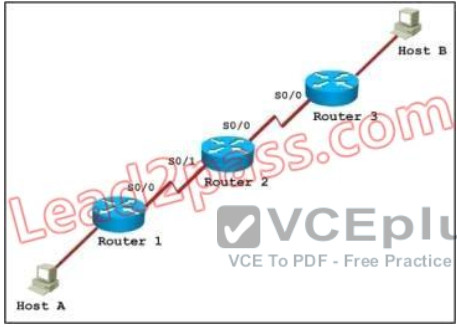
A. 253
B. 252
C. 255
D. 254
Answer: A
QUESTION 353
Which statement is true, as relates to classful or classless routing?
A. Automatic summarization at classful boundries can cause problems on discontinuous subnets
B. EIGRP and OSPF are classful routing protocols and summarize routes by default
C. RIPv1 and OSPF are classless routing protocols
D. Classful routing protocols send the subnet mask in routing updates
Answer: A
QUESTION 354
Refer to the exhibit. Why does the telnet connecting fail when a host attempts to connect a remote router?

A. No password was set for tty lines
B. No password was set for aux lines
C. No password was set for vty lines
D. No password was set for cty lines
Answer: C
QUESTION 355
Which name describes an IPV6 host-enable tunneling technique that uses IPV4 UDP,does not require dedicated gateway tunnels,and can pass through existing IPV4 NAT gateways?
A. dual stack
B. dynamic
C. Teredo
D. Manual 6to4
Answer: C
QUESTION 356
Which pairing reflects a correct protocol-and-metric relationship?
A. OSPF and mumber of hops and reliability
B. EIGRP and link cost
C. IS-IS and delay and reliability
D. RIPv2 and number of hops
Answer: D
QUESTION 357
Refer to the exhibit, The VLAN configuration of S1 is not being in this VTP enabled environment.
The VTP and uplink port configurations for each switch are displayed. Which two command sets,
if issued, resolve this failure and allow VTP to operate as expected?(choose two)
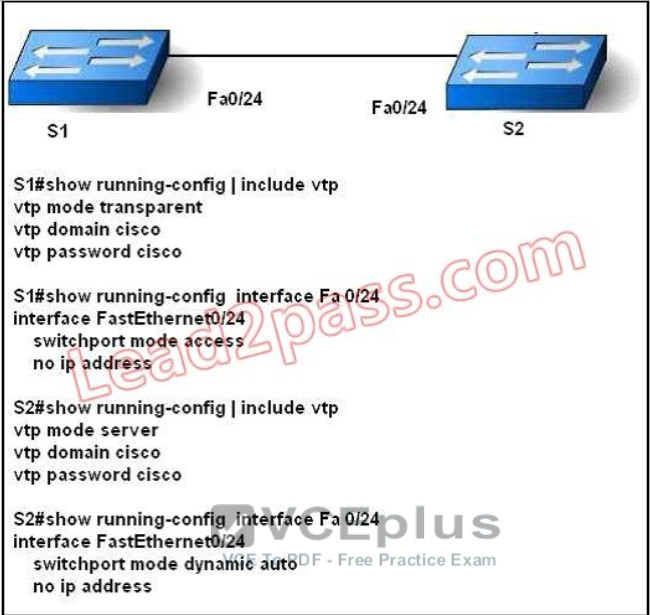
A. S2(config)#vtp mode transparent
B. S1(config)#vtp mode client
C. S2(config)#interface f0/24
S2(config-if)#switchport mode access
S2(config-if)#end
D. S2(config)#vtp mode client
E. S1(config)#interface f0/24
S1(config-if)#switchport mode trunk
S1(config-if)#end
Answer: BE
QUESTION 358
How are VTP advertisements delivered to switches across the network?
A. anycast frames
B. multicast frames
C. broadcast frames
D. unicast frames
Answer: B
QUESTION 359
Refer to the exhibit. What could be possible causes for the “Serial0/0 is down” interface status? (Choose two.)

A. A Layer 1 problem exists.
B. The bandwidth is set too low.
C. A protocol mismatch exists.
D. An incorrect cable is being used.
E. There is an incorrect IP address on the Serial 0/0 interface.
Answer: AD
QUESTION 360
Refer to the exhibit. Which two statements are true about the loopback address that is configured on RouterB? (Choose two.)
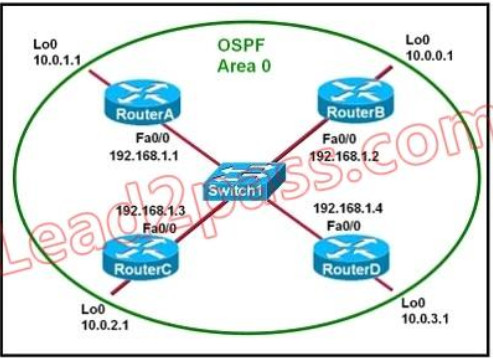
A. It ensures that data will be forwarded by RouterB.
B. It provides stability for the OSPF process on RouterB.
C. It specifies that the router ID for RouterB should be 10.0.0.1.
D. It decreases the metric for routes that are advertised from RouterB.
E. It indicates that RouterB should be elected the DR for the LAN.
Answer: BC
QUESTION 361
A network administrator is explaining VTP configuration to a new technician. What should the network administrator tell the new technician about VTP configuration? (Choose three.)
A. A switch in the VTP client mode cannot update its local VLAN database.
B. A trunk link must be configured between the switches to forward VTP updates.
C. A switch in the VTP server mode can update a switch in the VTP transparent mode.
D. A switch in the VTP transparent mode will forward updates that it receives to other switches.
E. A switch in the VTP server mode only updates switches in the VTP client mode that have a higher VTP revision number.
F. A switch in the VTP server mode will update switches in the VTP client mode regardless of the configured VTP domain membership.
Answer: ABD
QUESTION 362
Refer to the exhibit. Both switches are using a default configuration. Which two destination addresses will host 4 use to send data to host 1? (Choose two.)
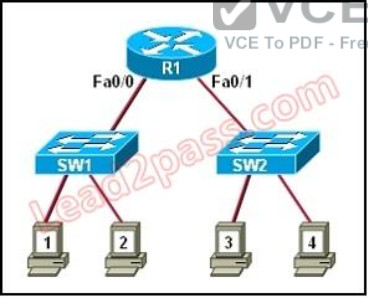
A. the IP address of host 1
B. the IP address of host 4
C. the MAC address of host 1
D. the MAC address of host 4
E. the MAC address of the Fa0/0 interface of the R1 router
F. the MAC address of the Fa0/1 interface of the R1 router
Answer: AF
QUESTION 363
What are two reasons a network administrator would use CDP? (Choose two.)
A. to verify the type of cable interconnecting two devices
B. to determine the status of network services on a remote device
C. to obtain VLAN information from directly connected switches
D. to verify Layer 2 connectivity between two devices when Layer 3 fails
E. to obtain the IP address of a connected device in order to telnet to the device
F. to determine the status of the routing protocols between directly connected routers
Answer: DE
QUESTION 364
Refer to the exhibit. The router has been configured with these commands:
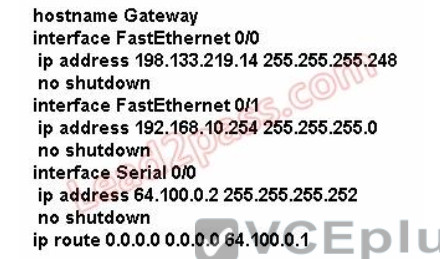
What are the two results of this configuration? (Choose two.)
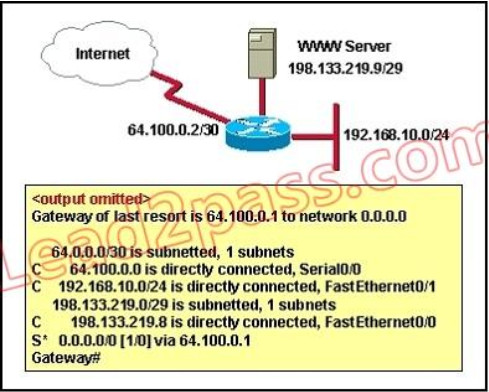
A. The default route should have a next hop address of 64.100.0.3.
B. Hosts on the LAN that is connected to FastEthernet 0/1 are using public IP addressing.
C. The address of the subnet segment with the WWW server will support seven more servers.
D. The addressing scheme allows users on the Internet to access the WWW server.
E. Hosts on the LAN that is connected to FastEthernet 0/1 will not be able to access the Internet without address translation.
Answer: DE
QUESTION 365
A company is installing IP phones. The phones and office computers connect to the same device. To ensure maximum throughput for the phone data, the company needs to make sure that the phone traffic is on a different network from that of the office computer data traffic. What is the best network device to which to directly connect the phones and computers, and what technology should be implemented on this device? (Choose two.)
A. hub
B. router
C. switch
D. STP
E. subinterfaces
F. VLAN
Answer: CF
QUESTION 366
What are two benefits of using VTP in a switching environment? (Choose two.)
A. It allows switches to read frame tags.
B. It allows ports to be assigned to VLANs automatically.
C. It maintains VLAN consistency across a switched network.
D. It allows frames from multiple VLANs to use a single interface.
E. It allows VLAN information to be automatically propagated throughout the switching environment.
Answer: CE
QUESTION 367
Which two statements are true about the command ip route 172.16.3.0 255.255.255.0 192.168.2.4? (Choose two.)
A. It establishes a static route to the 172.16.3.0 network.
B. It establishes a static route to the 192.168.2.0 network.
C. It configures the router to send any traffic for an unknown destination to the 172.16.3.0 network.
D. It configures the router to send any traffic for an unknown destination out the interface with the address 192.168.2.4.
E. It uses the default administrative distance.
F. It is a route that would be used last if other routes to the same destination exist.
Answer: AE
QUESTION 368
What are two advantages of Layer 2 Ethernet switches over hubs? (Choose two.)
A. decreasing the number of collision domains
B. filtering frames based on MAC addresses
C. allowing simultaneous frame transmissions
D. increasing the size of broadcast domains
E. increasing the maximum length of UTP cabling between devices
Answer: BC
QUESTION 369
Refer to the exhibit. A network associate needs to configure the switches and router in the graphic so that the hosts in VLAN3 and VLAN4 can communicate with the enterprise server in VLAN2. Which two Ethernet segments would need to be configured as trunk links? (Choose two.)
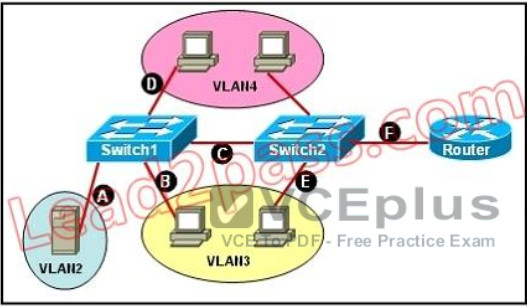
A. A
B. B
C. C
D. D
E. E
F. F
Answer: CF
QUESTION 370
Which two values are used by Spanning Tree Protocol to elect a root bridge? (Choose two.)
A. amount of RAM
B. bridge priority
C. IOS version
D. IP address
E. MAC address
F. speed of the links
Answer: BE
QUESTION 371
Refer to the exhibit. The networks connected to router R2 have been summarized as a 192.168.176.0/21 route and sent to R1. Which two packet destination addresses will R1 forward to R2? (Choose two.)
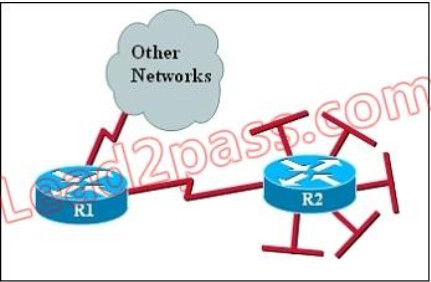
A. 192.168.194.160
B. 192.168.183.41
C. 192.168.159.2
D. 192.168.183.255
E. 192.168.179.4
F. 192.168.184.45
Answer: BE
QUESTION 372
Which three statements are typical characteristics of VLAN arrangements? (Choose three.)
A. A new switch has no VLANs configured.
B. Connectivity between VLANs requires a Layer 3 device.
C. VLANs typically decrease the number of collision domains.
D. Each VLAN uses a separate address space.
E. A switch maintains a separate bridging table for each VLAN.
F. VLANs cannot span multiple switches.
Answer: BDE
QUESTION 373
Refer to the exhibit. Which three statements are true about how router JAX will choose a path to the 10.1.3.0/24 network when different routing protocols are configured? (Choose three.)
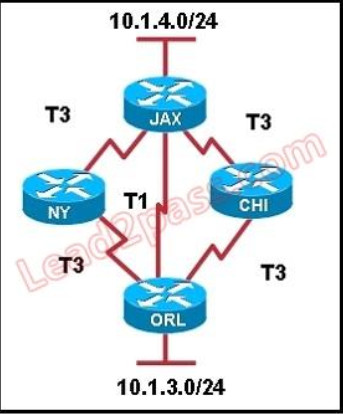
A. By default, if RIPv2 is the routing protocol, only the path JAX-ORL will be installed into the routing table.
B. The equal cost paths JAX-CHI-ORL and JAX- NY-ORL will be installed in the routing table if RIPv2 is the routing protocol.
C. When EIGRP is the routing protocol, only the path JAX-ORL will be installed in the routing table by default.
D. When EIGRP is the routing protocol, the equal cost paths JAX-CHI-ORL, and JAX-NY-ORL will be installed in the routing table by default.
E. With EIGRP and OSPF both running on the network with their default configurations, the EIGRP paths will be installed in the routing table.
F. The OSPF paths will be installed in the routing table, if EIGRP and OSPF are both running on the
network with their default configurations.
Answer: ADE
QUESTION 374
Refer to the exhibit. Which three statements correctly describe Network Device A? (Choose
three.)
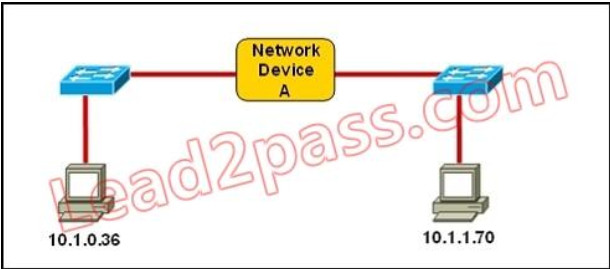
A. With a network wide mask of 255.255.255.128, each interface does not require an IP address.
B. With a network wide mask of 255.255.255.128, each interface does require an IP address on a unique IP subnet.
C. With a network wide mask of 255.255.255.0, must be a Layer 2 device for the PCs to communicate with each other.
D. With a network wide mask of 255.255.255.0, must be a Layer 3 device for the PCs to communicate with each other.
E. With a network wide mask of 255.255.254.0, each interface does not require an IP address.
Answer: BDE
QUESTION 375
Switch ports operating in which two roles will forward traffic according to the IEEE 802.1w standard? (Choose two.)
A. alternate
B. backup
C. designated
D. disabled
E. root
Answer: CE
QUESTION 376
Refer to the exhibit. Given the output shown from this Cisco Catalyst 2950, what is the most likely reason that interface FastEthernet 0/10 is not the root port for VLAN 2?

A. This switch has more than one interface connected to the root network segment in VLAN 2.
B. This switch is running RSTP while the elected designated switch is running 802.1d Spanning Tree.
C. This switch interface has a higher path cost to the root bridge than another in the topology.
D. This switch has a lower bridge ID for VLAN 2 than the elected designated switch.
Answer: C
QUESTION 377
Refer to the exhibit. This command is executed on 2960Switch:
2960Switch(config)# mac-address-table static 0000.00aa.aaaa vlan 10 interface fa0/1
Which two of these statements correctly identify results of executing the command? (Choose two.)
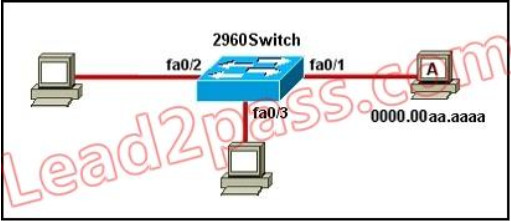
A. Port security is implemented on the fa0/1 interface.
B. MAC address 0000.00aa.aaaa does not need to be learned by this switch.
C. Only MAC address 0000.00aa.aaaa can source frames on the fa0/1 segment.
D. Frames with a Layer 2 source address of 0000.00aa.aaaa will be forwarded out fa0/1.
E. MAC address 0000.00aa.aaaa will be listed in the MAC address table for interface fa0/1 only.
Answer: BE
QUESTION 378
Which of the following describes the roles of devices in a WAN? (Choose three.)
A. A CSU/DSU terminates a digital local loop.
B. A modem terminates a digital local loop.
C. A CSU/DSU terminates an analog local loop.
D. A modem terminates an analog local loop.
E. A router is commonly considered a DTE device.
F. A router is commonly considered a DCE device.
Answer: ADE
QUESTION 379
What are two characteristics of Telnet? (Choose two.)
A. It sends data in clear text format.
B. It is no longer supported on Cisco network devices.
C. It is more secure than SSH.
D. It requires an enterprise license in order to be implemented.
E. It requires that the destination device be configured to support Telnet connections.
Answer: AE
QUESTION 380
What are two security appliances that can be installed in a network? (Choose two.)
A. ATM
B. IDS
C. IOS
D. IOX
E. IPS
F. SDM
Answer: BE
QUESTION 381
Assuming a subnet mask of 255.255.248.0, three of the following addresses are valid host addresses. Which are these addresses? (Choose three.)
A. 172.16.9.0
B. 172.16.8.0
C. 172.16.31.0
D. 172.16.20.0
Answer: ACD
QUESTION 382
Refer to the exhibit. A network technician is unable to ping from R1 to R2. What will help correct the problem?
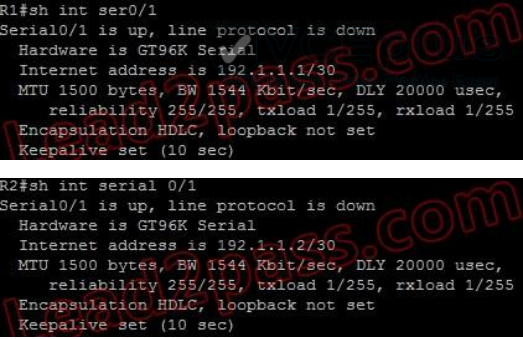
A. Ensure that the serial cable is correctly plugged in to the interfaces.
B. Apply the clock rate 56000 configuration command to the serial0/1 interface of R1.
C. Configure the serial0/1 interfaces on R1 and R2 with the no shutdown command.
D. Change the address of the serial0/1 interface of R1 to 192.1.1.4.
E. Change the subnet masks of both interfaces to 255.255.255.240.
Answer: A
QUESTION 383
Refer to the exhibit. Which two statements are true of the interface configuration? (Choose two.)
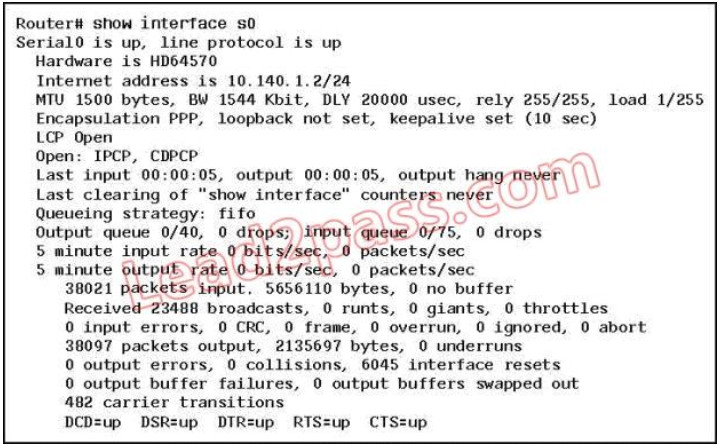
A. The encapsulation in use on this interface is PPP.
B. The default serial line encapsulation is in use on this interface.
C. The address mask of this interface is 255.255.255.0.
D. This interface is connected to a LAN.
E. The interface is not ready to forward packets.
Answer: AC
QUESTION 384
Refer to the exhibit. What does the address 192.168.2.167 represent?

A. the TFTP server from which the file startup-config is being transferred
B. the router from which the file startup-config is being transferred
C. the TFTP server from which the file router-confg is being transferred
D. the TFTP server to which the file router-confg is being transferred
E. the router to which the file router-confg is being transferred
F. the router to which the file startup-config is being transferred
Answer: D
QUESTION 385
Refer to the exhibit. A technician is troubleshooting a host connectivity problem. The host is unable to ping a server connected to Switch_A.
Based on the results of the testing, what could be the problem?
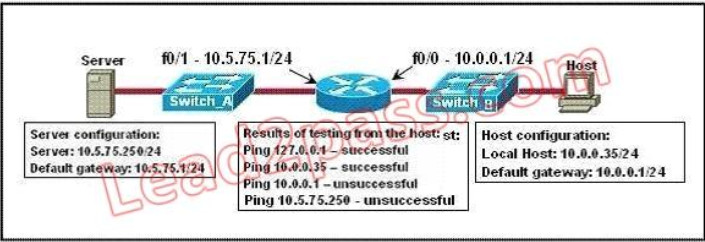
A. A remote physical layer problem exists.
B. The host NIC is not functioning.
C. TCP/IP has not been correctly installed on the host.
D. A local physical layer problem exists.
Answer: D
QUESTION 386
In which situation would the use of a static route be appropriate?
A. To configure a route to the first Layer 3 device on the network segment.
B. To configure a route from an ISP router into a corporate network.
C. To configure a route when the administrative distance of the current routing protocol is too low.
D. To reach a network is more than 15 hops away.
E. To provide access to the Internet for enterprise hosts.
Answer: B
QUESTION 387
An administrator issues the show ip interface s0/0 command and the output displays that interface Serial0/0 is up, line protocol is up What does “line protocol is up” specifically indicate about the interface?
A. The cable is attached properly.
B. CDP has discovered the connected device.
C. Keepalives are being received on the interface.
D. A carrier detect signal has been received from the connected device.
E. IP is correctly configured on the interface.
Answer: C
QUESTION 388
Which three statements are correct about RIP version 2? (Choose three)
A. It uses broadcast for its routing updates
B. It supports authentication
C. It is a classless routing protocol
D. It has a lower default administrative distance than RIP version 1
E. It has the same maximum hop count as version 1
F. It does not send the subnet mask un updates
Answer: BCE
QUESTION 389
How can an administrator determine if a router has been configured when it is first powered up?
A. A configured router prompts for a password.
B. A configured router goes to the privileged mode prompt.
C. An unconfigured router goes into the setup dialog.
D. An unconfigured router goes to the enable mode prompt.
Answer: C
QUESTION 390
Drag and Drop Question

Answer:

QUESTION 391
Drag and Drop Question
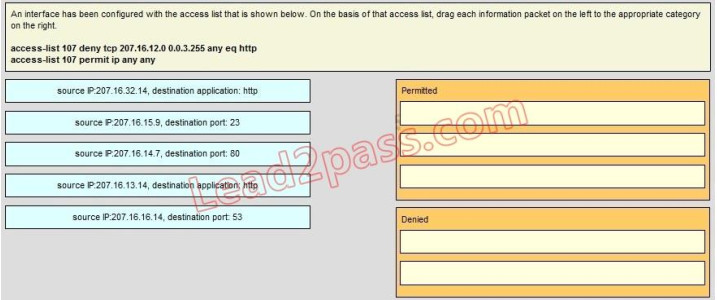
Answer:
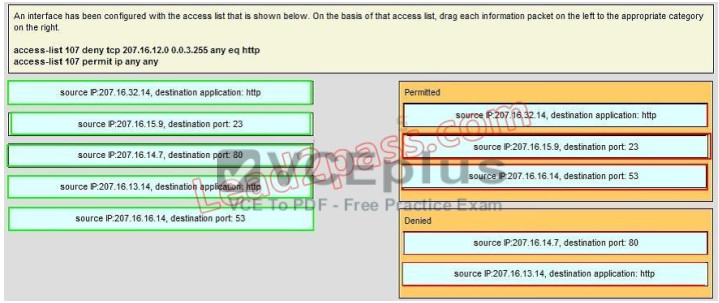
QUESTION 392
A network administrator receives an error message while trying to configure the Ethernet interface of a router with IP address 10.24.24.24/29. Which statement explains the reason for this issue?
A. This address is a broadcast address.
B. VLSM-capable routing protocols must be enabled first on the router.
C. The Ethernet interface is faulty.
D. This address is a network address.
Answer: D
QUESTION 393
Which address is the IPv6 all-RIP-routers multicast group address that is used by RIPng as the destination address for RIP updates?
A. FF02::9
B. FF02::6
C. FF05::101
D. FF02::A
Answer: A
QUESTION 394
If all OSPF routers in a single area are configured with the same priority value, what value does a router use for the OSPF router ID in the absence of a loopback interface?
A. the IP address of the first Fast Ethernet interface
B. the IP address of the console management interface
C. the highest IP address among its active interfaces
D. the lowest IP address among its active interfaces
E. the priority value until a loopback interface is configured
Answer: C
QUESTION 395
The OSPF Hello protocol performs which of the following tasks? (Choose two.)
A. It provides dynamic neighbor discovery.
B. It detects unreachable neighbors in 90 second intervals.
C. It maintains neighbor relationships.
D. It negotiates correctness parameters between neighboring interfaces.
E. It uses timers to elect the router with the fastest links as the designated router.
F. It broadcasts hello packets throughout the internetwork to discover all routers that are running OSPF.
Answer: AC
QUESTION 396
The network administrator of the Oregon router adds the following command to the router configuration: ip route 192.168.12.0 255.255.255.0 172.16.12.1. What are the results of adding this command? (Choose two.)
A. The command establishes a static route.
B. The command invokes a dynamic routing protocol for 192.168.12.0.
C. Traffic for network 192.168.12.0 is forwarded to 172.16.12.1.
D. Traffic for all networks is forwarded to 172.16.12.1.
E. This route is automatically propagated throughout the entire network.
F. Traffic for network 172.16.12.0 is forwarded to the 192.168.12.0 network.
Answer: AC
QUESTION 397
A network administrator is planning a network installation for a large organization. The design requires 100 separate subnetworks, so the company has acquired a Class B network address. What subnet mask will provide the 100 subnetworks required, if 500 usable host addresses are required per subnet?
A. 255.255.240.0
B. 255.255.248.0
C. 255.255.252.0
D. 255.255.254.0
E. 255.255.255.0
F. 255.255.255.192
Answer: D
QUESTION 398
Refer to Exhibit. Based on the network shown in the graphic which option contains both the potential networking problem and the protocol or setting that should be used to prevent the problem?
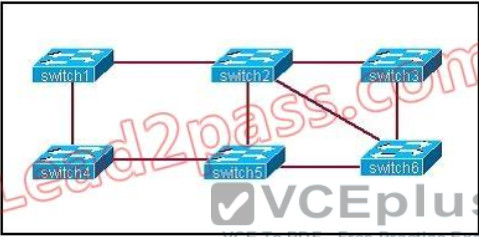
A. routing loops, hold down timers
B. switching loops, split horizon
C. routing loops, split horizon
D. switching loops, VTP
E. routing loops, STP
F. switching loops, STP
Answer: F
QUESTION 399
Which of the following services use UDP? (Choose three.)
A. Telnet
B. TFTP
C. SNMP
D. DNS
E. SMTP
F. HTTP
Answer: BCD
QUESTION 400
Refer to the exhibit. Which two statements are true based the output of the show frame-relay lmi command issued on the Branch router? (Choose two.)
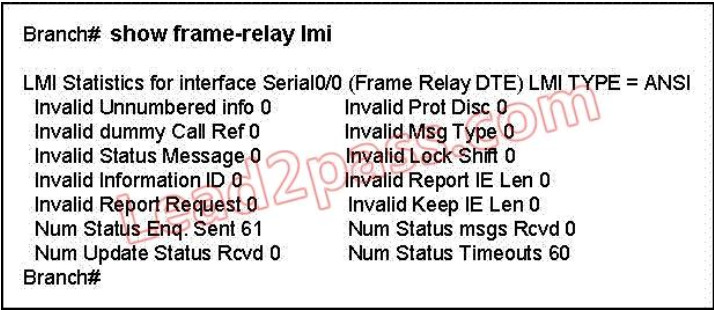
A. LMI messages are being sent on DLCI 1023.
B. The LMI exchange between the router and Frame Relay switch is functioning properly.
C. LMI messages are being sent on DLCI 0.
D. The Frame Relay switch is not responding to LMI requests from the router.
E. The router is providing a clock signal on Serial0/0 on the circuit to the Frame Relay switch.
F. Interface Serial0/0 is not configured to encapsulate Frame Relay.
Answer: CD
QUESTION 401
Hotspot Question
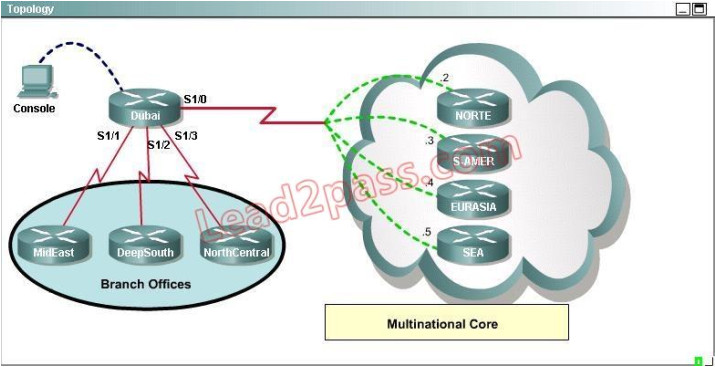
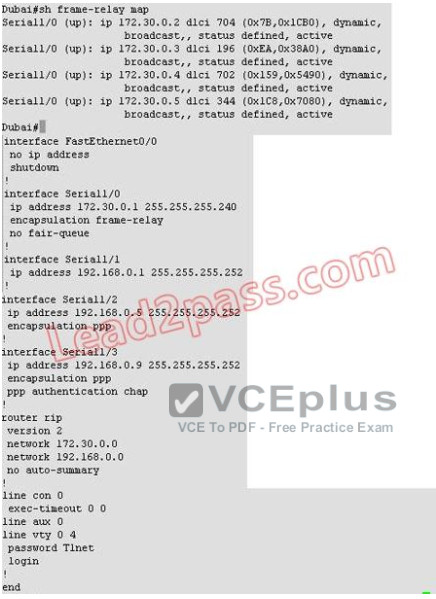

Answer: 702
Explanation:
The output of the above show command displays that the local DLCI number corresponding to
the sub-interface of s1/0 whose IP address is 172.30.0.4 is 702.


Answer: frame-relay map ip 172.30.0.3 196 broadcast
Explanation:
Based on the output of the command “show frame-relay map”, we know that DLCI mapped
to the router S-AMER is 196. (.3 In the above network topology, the complete Layer 3 IP address
is 172.30.0.3)

Answer: The serial connection to the MidEast branch office.
Explanation:
On the basis of the configuration on Dubai provided in the exhibit, we know that the encapsulation types of different interfaces are as follows:
Serial 1/0 : encapsulation frame-relay
Serial 1/2 and Serial 1/3 : both interfaces are encapsulated PPP
Serial 1/1: There is no related encapsulation information displayed, so
its default encapsulation type is HDLC .
Based on the network topology provided in the exhibit, the interface Serial 1/1 is connected to the router MidEast of the branch office, so the encapsulation type of the router MidEast is by default.
The default encapsulation on a serial interface is HDLC. The original HDLC encapsulation was defined by the International Organization for Standards (ISO), those same folks who developed the OSI model. The ISO version of HDLC had one shortcoming, however; it had no options to support multiple Layer 3 routed protocols. As a result, most vendors have created their own form of HDLC. Cisco is no exception because it has its own proprietary form of HDLC to support
various Layer 3 protocols such as IPX, IP, and AppleTalk.
The Serial connection to the Dubai branch office using the default encapsulation type. You can change using:
encapsulation command on interface

Answer: Enable
Explanation:
In the diagram, DeepSouth is connected to Dubai’s S1/2 interface and is configured as follows:
Interface Serial1/2
IP address 192.168.0.5 255.255.255.252
Encapsulalation PPP ; Encapsulation for this interface is PPP
Check out the following Cisco Link:
http://www.cisco.com/en/US/tech/tk713/tk507/technologies_configuration_example09186a00800 9 4333.shtml#configuringausernamedifferentfromtheroutersname
Here is a snipit of an example:
If Router 1 initiates a call to Router 2, Router 2 would challenge Router 1, but Router 1 would not challenge Router 2. This occurs because the ppp authentication chap callin command is configured on Router 1. This is an example of a unidirectional authentication. In this setup, the ppp chap hostname alias-r1 command is configured on Router 1. Router 1 uses “alias-r1” as its hostname for CHAP authentication instead of “r1.” The Router 2 dialer map name should match Router 1’s ppp chap hostname; otherwise, two B channels are established, one for each
direction.
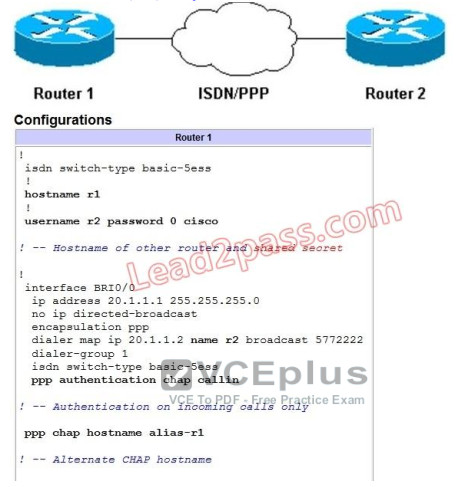
QUESTION 402
What are two recommended ways of protecting network device configuration files from outside network security threats? (Choose two.)
A. Allow unrestricted access to the console or VTY ports.
B. Use a firewall to restrict access from the outside to the network devices.
C. Always use Telnet to access the device command line because its data is automatically encrypted.
D. Use SSH or another encrypted and authenticated transport to access device configurations.
E. Prevent the loss of passwords by disabling password encryption.
Answer: BD
QUESTION 403
Hotspot Question
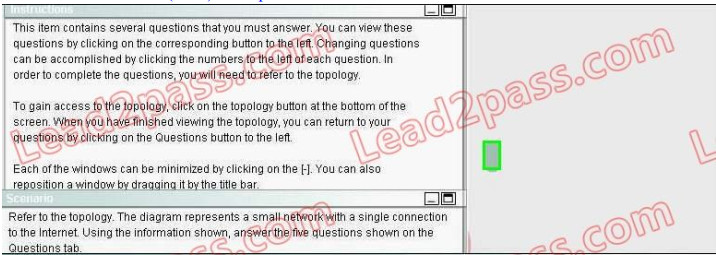
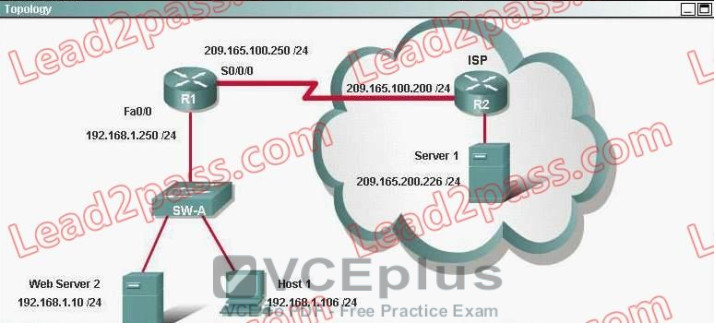

Answer: R1 will drop this packet because this is not a valid IP address.

Answer: ip route 0.0.0.0 0.0.0.0 s0/0/0
Explanation:
In order to allow the network of 192.168.1.0/24 to access Server 1, we need to establish a default
route. The format of this default route is as follows:
ip route prefix mask {ip-address interface-type interface-number [ipaddress]} [distance] [name]
[permanent track number] [tag tag]
Based on the request of this subject, we need to configure the correct route as follows:
ip route 0.0.0.0 0.0.0.0 s0/0/0
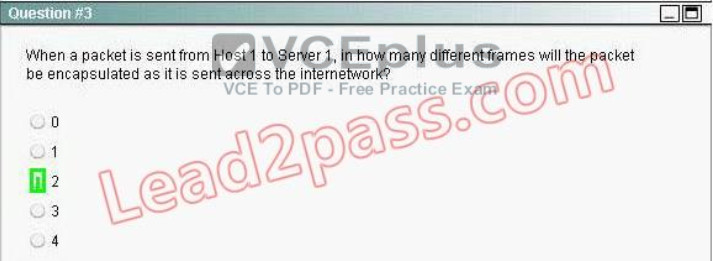
Answer: 3
Explanation:
We believe the correct answer is 3 because the packet will be encapsulated in one more frame
sent between routers R1 and R2. Source MAC is interface S0/0/0 on router R1 and destination is
the serialinterface on router R2.
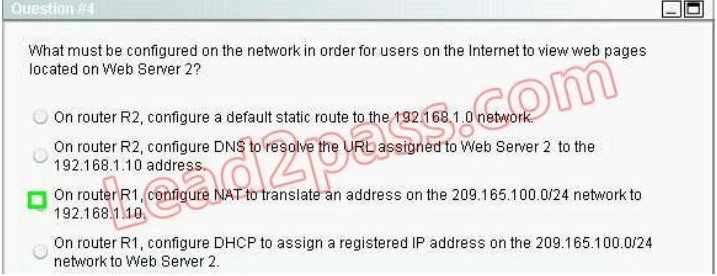
Answer: On router R1, configure NAT to translate an address on the 209.165.100.0/24 network to 192.168.1.10
Explanation:
In order to allow internet users to access Web Server 2, we need to configure NAT address translation on router R1.

Answer: 255.255.255.0
Explanation:
1. Based on the information provided in the exhibit, we know that the IP address of the interface Fa0/0 is 192.168.1.250/24, that is to say the subnet mask is 255.255.255.0??
2. When configuring the correct IP address and not wasting IP address, the network of 192.168.1.0 needs to contain the following three IP addresses of interfaces:
R1(fa 0/0) : 192.168.1.250
Host 1: 192.168.1.106/24
Web server 2: 192.168.1.10/24
The correct mask is 255.255.255.0.
QUESTION 404
Refer to the exhibit. The switches on a campus network have been interconnected as shown. All of the switches are running Spanning Tree Protocol with its default settings. Unusual traffic patterns are observed and it is discovered that Switch9 is the root bridge. Which change will ensure that Switch1 will be selected as the root bridge instead of Switch9?

A. Raise the bridge priority on Switch1.
B. Lower the bridge priority on Switch9.
C. Raise the bridge priority on Switch9.
D. Physically replace Switch9 with Switch1 in the topology.
E. Disable spanning tree on Switch9.
F. Lower the bridge priority on Switch1.
Answer: F
QUESTION 405
The Company WAN is migrating from RIPv1 to RIPv2. Which three statements are correct about RIP version 2? (Choose three)
A. It has the same maximum hop count as version 1.
B. It uses broadcasts for its routing updates.
C. It is a classless routing protocol.
D. It has a lower default administrative distance than RIP version 1.
E. It supports authentication.
F. It does not send the subnet mask in updates.
Answer: ACE
QUESTION 406
If a router has four interfaces and each interface is connected to four switches, how many broadcast domains are present on the router?
A. 1
B. 2
C. 4
D. 8
Answer: C
QUESTION 407
Which command can you use to set the hostname on a switch?
A. switch-mdf-c1(config)#hostname switch-mdf1
B. switch-mdf-c1>hostname switch-mdf1
C. switch-mdf-c1#hostname switch-mdf1
D. switch-mdf-c1(config-if)#hostname switch-mdf1
Answer: A
QUESTION 408
If the primary root bridge experiences a power loss, which switch takes over?
A. switch 0004.9A1A.C182
B. switch 00E0.F90B.6BE3
C. switch 00E0.F726.3DC6
D. switch 0040.0BC0.90C5
Answer: A
QUESTION 409
Which IPv6 header field is equivalent to the TTL?
A. Hop Limit
B. Flow Label
C. TTD
D. Hop Count
E. Scan Timer
Answer: A
QUESTION 410
Which two statements about the tunnel mode ipv6ip command are true? (Choose two.)
A. It enables the transmission of IPv6 packets within the configured tunnel.
B. It specifies IPv4 as the encapsulation protocol.
C. It specifies IPv6 as the encapsulation protocol.
D. It specifies IPv6 as the transport protocol.
E. It specifies that the tunnel is a Teredo tunnel.
Answer: AB
QUESTION 411
What is the correct routing match to reach 172.16.1.5/32?
A. 172.16.1.0/26
B. 172.16.1.0/25
C. 172.16.1.0/24
D. the default route
Answer: A
QUESTION 412
Which step in the router boot process searches for an IOS image to load into the router?
A. bootstrap
B. POST
C. mini-IOS
D. ROMMON mode
Answer: A
QUESTION 413
Which command can you enter to route all traffic that is destined for 192.168.0.0/20 to a specific interface?
A. router(config)#ip route 192.168.0.0 255.255.240.0 GigabitEthernet0/1
B. router(config)#ip route 0.0.0.0 255.255.255.0 GigabitEthernet0/1
C. router(config)#ip route 0.0.0.0 0.0.0.0 GigabitEthernet0/1
D. router(config)#ip route 192.168.0.0 255.255.255.0 GigabitEthernet0/1
Answer: A
QUESTION 414
Which technology allows a large number of private IP addresses to be represented by a smaller number of public IP addresses?
A. NAT
B. NTP
C. RFC 1631
D. RFC 1918
Answer: A
QUESTION 415
What is the effect of the overload keyword in a static NAT translation configuration?
A. It enables port address translation.
B. It enables the use of a secondary pool of IP addresses when the first pool is depleted.
C. It enables the inside interface to receive traffic.
D. It enables the outside interface to forward traffic.
Answer: A
QUESTION 416
Which protocol advertises a virtual IP address to facilitate transparent failover of a Cisco routing device?
A. FHRP
B. DHCP
C. RSMLT
D. ESRP
Answer: A
QUESTION 417
What are three broadband wireless technologies? (Choose three.)
A. WiMax
B. satellite Internet
C. municipal Wi-Fi
D. site-to-site VPN
E. DSLAM
F. CMTS
Answer: ABC
QUESTION 418
Which condition indicates that service password-encryption is enabled?
A. The local username password is encrypted in the configuration.
B. The enable secret is encrypted in the configuration.
C. The local username password is in clear text in the configuration.
D. The enable secret is in clear text in the configuration.
Answer: A
QUESTION 419
Which two spanning-tree port states does RSTP combine to allow faster convergence? (Choose two.)
A. blocking
B. listening
C. learning
D. forwarding
E. discarding
Answer: AB
QUESTION 420
Which technology can enable multiple VLANs to communicate with one another?
A. inter-VLAN routing using a Layer 3 switch
B. inter-VLAN routing using a Layer 2 switch
C. intra-VLAN routing using router on a stick
D. intra-VLAN routing using a Layer 3 switch
Answer: A
QUESTION 421
In which three ways is an IPv6 header simpler than an IPv4 header? (Choose three.)
A. Unlike IPv4 headers, IPv6 headers have a fixed length.
B. IPv6 uses an extension header instead of the IPv4 Fragmentation field.
C. IPv6 headers eliminate the IPv4 Checksum field.
D. IPv6 headers use the Fragment Offset field in place of the IPv4 Fragmentation field.
E. IPv6 headers use a smaller Option field size than IPv4 headers.
F. IPv6 headers use a 4-bit TTL field, and IPv4 headers use an 8-bit TTL field.
Answer: ABC
QUESTION 422
Which feature builds a FIB and an adjacency table to expedite packet forwarding?
A. Cisco Express Forwarding
B. process switching
C. fast switching
D. cut-through
Answer: A
QUESTION 423
What is the purpose of the POST operation on a router?
A. determine whether additional hardware has been added
B. locate an IOS image for booting
C. enable a TFTP server
D. set the configuration register
Answer: A
QUESTION 424
Which command can you enter to set the default route for all traffic to an interface?
A. router(config)#ip route 0.0.0.0 0.0.0.0 GigabitEthernet0/1
B. router(config)#ip route 0.0.0.0 255.255.255.255 GigabitEthernet0/1
C. router(config-router)#default-information originate
D. router(config-router)#default-information originate always
Answer: A
QUESTION 425
Which two types of NAT addresses are used in a Cisco NAT device? (Choose two.)
A. inside local
B. inside global
C. inside private
D. outside private
E. external global
F. external local
Answer: AB
QUESTION 426
What is the danger of the permit any entry in a NAT access list?
A. It can lead to overloaded resources on the router.
B. It can cause too many addresses to be assigned to the same interface.
C. It can disable the overload command.
D. It prevents the correct translation of IP addresses on the inside network.
Answer: A
QUESTION 427
Which protocol is the Cisco proprietary implementation of FHRP?
A. HSRP
B. VRRP
C. GLBP
D. CARP
Answer: A
QUESTION 428
Which two statements about late collisions are true? (Choose two.)
A. They may indicate a duplex mismatch.
B. By definition, they occur after the 512th bit of the frame has been transmitted.
C. They indicate received frames that did not pass the FCS match.
D. They are frames that exceed 1518 bytes.
E. They occur when CRC errors and interference occur on the cable.
Answer: AB
QUESTION 429
Which three characteristics are representative of a link-state routing protocol? (Choose three.)
A. provides common view of entire topology
B. exchanges routing tables with neighbors
C. calculates shortest path
D. utilizes event-triggered updates
E. utilizes frequent periodic updates
Answer: ACD
QUESTION 430
Refer to the exhibit. What is the effect of the given configuration?

A. It configures an inactive switch virtual interface.
B. It configures an active management interface.
C. It configures the native VLAN.
D. It configures the default VLAN.
Answer: A
QUESTION 431
Which command can you enter to view the ports that are assigned to VLAN 20?
A. Switch#show vlan id 20
B. Switch#show ip interface brief
C. Switch#show interface vlan 20
D. Switch#show ip interface vlan 20
Answer: A
QUESTION 432
If primary and secondary root switches with priority 16384 both experience catastrophic losses, which tertiary switch can take over?
A. a switch with priority 20480
B. a switch with priority 8192
C. a switch with priority 4096
D. a switch with priority 12288
Answer: A
QUESTION 433
Which two statements about IPv6 and routing protocols are true? (Choose two.)
A. Link-local addresses are used to form routing adjacencies.
B. OSPFv3 was developed to support IPv6 routing.
C. EIGRP, OSPF, and BGP are the only routing protocols that support IPv6.
D. Loopback addresses are used to form routing adjacencies.
E. EIGRPv3 was developed to support IPv6 routing.
Answer: AB
QUESTION 434
Which two features can dynamically assign IPv6 addresses? (Choose two.)
A. IPv6 stateless autoconfiguration
B. DHCP
C. NHRP
D. IPv6 stateful autoconfiguration
E. ISATAP tunneling
Answer: AB
QUESTION 435
Which command can you enter to configure a local username with an encrypted password and EXEC mode user privileges?
A. Router(config)#username jdone privilege 1 password 7 08314D5D1A48
B. Router(config)#username jdone privilege 1 password 7 PASSWORD1
C. Router(config)#username jdone privilege 15 password 0 08314D5D1A48
D. Router(config)#username jdone privilege 15 password 0 PASSWORD1
Answer: A
QUESTION 436
Which three commands can you use to set a router boot image? (Choose three.)
A. Router(config)# boot system flash c4500-p-mz.121-20.bin
B. Router(config)# boot system tftp c7300-js-mz.122-33.SB8a.bin
C. Router(config)#boot system rom c7301-advipservicesk9-mz.124-24.T4.bin
D. Router> boot flash:c180x-adventerprisek9-mz-124-6T.bin
E. Router(config)#boot flash:c180x-adventerprisek9-mz-124-6T.bin
F. Router(config)#boot bootldr bootflash:c4500-jk9s-mz.122-23f.bin
Answer: ABC
QUESTION 437
Which three statements about static routing are true? (Choose three.)
A. It uses consistent route determination.
B. It is best used for small-scale deployments.
C. Routing is disrupted when links fail.
D. It requires more resources than other routing methods.
E. It is best used for large-scale deployments.
F. Routers can use update messages to reroute when links fail.
Answer: ABC
QUESTION 438
Which type of address is the public IP address of a NAT device?
A. outside global
B. outside local
C. inside global
D. inside local
E. outside public
F. inside public
Answer: C
QUESTION 439
Which command can you enter to display the hits counter for NAT traffic?
A. show ip nat statistics
B. debug ip nat
C. show ip debug nat
D. clear ip nat statistics
Answer: A
QUESTION 440
Which standards-based First Hop Redundancy Protocol is a Cisco supported alternative to Hot Standby Router Protocol?
A. VRRP
B. GLBP
C. TFTP
D. DHCP
Answer: A
QUESTION 441
What are two reasons that duplex mismatches can be difficult to diagnose? (Choose two.)
A. The interface displays a connected (up/up) state even when the duplex settings are mismatched.
B. The symptoms of a duplex mismatch may be intermittent.
C. Autonegotiation is disabled.
D. Full-duplex interfaces use CSMA/CD logic, so mismatches may be disguised by collisions.
E. 1-Gbps interfaces are full-duplex by default.
Answer: AB
QUESTION 442
Which command can you execute to set the user inactivity timer to 10 seconds?
A. SW1(config-line)#exec-timeout 0 10
B. SW1(config-line)#exec-timeout 10
C. SW1(config-line)#absolute-timeout 0 10
D. SW1(config-line)#absolute-timeout 10
Answer: A
QUESTION 443
Which command sequence can you enter to create VLAN 20 and assign it to an interface on a switch?
A. Switch(config)#vlan 20
Switch(config)#Interface gig x/y
Switch(config-if)#switchport access vlan 20
B. Switch(config)#Interface gig x/y
Switch(config-if)#vlan 20
Switch(config-vlan)#switchport access vlan 20
C. Switch(config)#vlan 20
Switch(config)#Interface vlan 20
Switch(config-if)#switchport trunk native vlan 20
D. Switch(config)#vlan 20
Switch(config)#Interface vlan 20
Switch(config-if)#switchport access vlan 20
E. Switch(config)#vlan 20
Switch(config)#Interface vlan 20
Switch(config-if)#switchport trunk allowed vlan 20
Answer: A
QUESTION 444
Which spanning-tree protocol rides on top of another spanning-tree protocol?
A. MSTP
B. RSTP
C. PVST+
D. Mono Spanning Tree
Answer: A
QUESTION 445
Which two statements about IPv6 router advertisement messages are true? (Choose two.)
A. They use ICMPv6 type 134.
B. The advertised prefix length must be 64 bits.
C. The advertised prefix length must be 48 bits.
D. They are sourced from the configured IPv6 interface address.
E. Their destination is always the link-local address of the neighboring node.
Answer: AB
QUESTION 446
Which three statements about IPv6 prefixes are true? (Choose three.)
A. FF00:/8 is used for IPv6 multicast.
B. FE80::/10 is used for link-local unicast.
C. FC00::/7 is used in private networks.
D. 2001::1/127 is used for loopback addresses.
E. FE80::/8 is used for link-local unicast.
F. FEC0::/10 is used for IPv6 broadcast.
Answer: ABC
QUESTION 447
After you configure the Loopback0 interface, which command can you enter to verify the status of the interface and determine whether fast switching is enabled?
A. Router#show ip interface loopback 0
B. Router#show run
C. Router#show interface loopback 0
D. Router#show ip interface brief
Answer: A
QUESTION 448
Which three statements about link-state routing are true? (Choose three.)
A. Routes are updated when a change in topology occurs.
B. Updates are sent to a multicast address by default.
C. OSPF is a link-state protocol.
D. Updates are sent to a broadcast address.
E. RIP is a link-state protocol.
F. It uses split horizon.
Answer: ABC
QUESTION 449
Which NAT function can map multiple inside addresses to a single outside address?
A. PAT
B. SFTP
C. RARP
D. ARP
E. TFTP
Answer: A
QUESTION 450
What is the first step in the NAT configuration process?
A. Define inside and outside interfaces.
B. Define public and private IP addresses.
C. Define IP address pools.
D. Define global and local interfaces.
Answer: A
QUESTION 451
What are two requirements for an HSRP group? (Choose two.)
A. exactly one active router
B. one or more standby routers
C. one or more backup virtual routers
D. exactly one standby active router
E. exactly one backup virtual router
Answer: AB
QUESTION 452
Which two commands can you enter to verify that a configured NetFlow data export is operational? (Choose two.)
A. show ip flow export
B. show ip cache flow
C. ip flow ingress
D. ip flow egress
E. interface ethernet 0/0
F. ip flow-export destination
Answer: AB
QUESTION 453
What are three characteristics of satellite Internet connections? (Choose three.)
A. Their upload speed is about 10 percent of their download speed.
B. They are frequently used by rural users without access to other high-speed connections.
C. They are usually at least 10 times faster than analog modem connections.
D. They are usually faster than cable and DSL connections.
E. They require a WiMax tower within 30 miles of the user location.
F. They use radio waves to communicate with cellular phone towers.
Answer: ABC
QUESTION 455
Which command sets and automatically encrypts the privileged enable mode password?
A. Enable password c1sc0
B. Secret enable c1sc0
C. Password enable c1sc0
D. Enable secret c1sc0
Answer: D
QUESTION 456
The enable secret command is used to secure access to which CLI mode?
A. global configuration mode
B. privileged EXEC mode
C. user EXEC mode
D. auxiliary setup mode
Answer: B
QUESTION 457
The enable secret command is used to secure access to which CLI mode?
A. global configuration mode
B. privileged EXEC mode
C. user EXEC mode
D. auxiliary setup mode
Answer: B
QUESTION 458
Refer to the exhibit. What is the result of setting the no login command?
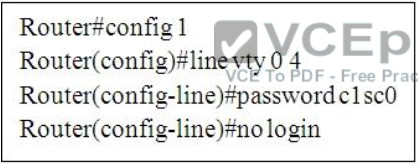
A. Telnet access is denied.
B. Telnet access requires a new password at the first login.
C. Telnet access requires a new password.
D. no password is required for telnet access.
Answer: D
QUESTION 459
Which option describes a difference between EIGRP for IPv4 and IPv6?
A. Only EIGRP for IPv6 advertises all connected networks.
B. Only EIGRP for IPv6 requires a router ID to be configured under the routing processC. AS numbers are configured in EIGRP but not in EIGRPv3.
D. Only EIGRP for IPv6 is enabled in the global configuration mode.
Answer: B
Explanation:
Router ID – Both EIGRP for IPv4 and EIGRP for IPv6 use a 32-bit number for the EIGRP router
ID. The 32-bit router ID is represented in dotted-decimal notation and is commonly referred to as an IPv4 address. If the EIGRP for IPv6 router has not been configured with an IPv4 address, the eigrp router-id command must be used to configure a 32-bit router ID. The process for determining the router ID is the same for both EIGRP for IPv4 and IPv6.
QUESTION 460
What is the best way to verify that a host has a path to other hosts in different networks?
A. Ping the loopback address.
B. Ping the default gateway.
C. Ping the local interface address.
D. Ping the remote network.
Answer: D
Explanation:
Ping is a tool that helps to verify IP-level connectivity; PathPing is a tool that detects packet loss over multiple-hop trips. When troubleshooting, the ping command is used to send an ICMP Echo Request to a target host name or IP address. Use Ping whenever you want to verify that a host computer can send IP packets to a destination host. You can also use the Ping tool to isolate network hardware problems and incompatible configurations. If you call ipconfig /all and receive a response, there is no need to ping the loopback address and your own IP address — Ipconfig has already done so in order to generate the report.
It is best to verify that a route exists between the local computer and a network host by first using ping and the IP address of the network host to which you want to connect. The command syntax is:
ping < IP address >
Perform the following steps when using Ping:
Ping the loopback address to verify that TCP/IP is installed and configured correctly on the local
computer.
ping 127.0.0.1
If the loopback step fails, the IP stack is not responding. This might be because the TCP drivers are corrupted, the network adapter might not be working, or another service is interfering with IP.
Ping the IP address of the local computer to verify that it was added to the network correctly. Note that if the routing table is correct, this simply forwards the packet to the loopback address of 127.0.0.1.
ping < IP address of local host >
Ping the IP address of the default gateway to verify that the default gateway is functioning and
that you can communicate with a local host on the local network.
ping < IP address of default gateway >
Ping the IP address of a remote host to verify that you can communicate through a router.
ping < IP address of remote host >
Ping the host name of a remote host to verify that you can resolve a remote host name.
ping < Host name of remote host >
Run a PathPing analysis to a remote host to verify that the routers on the way to the destination
are operating correctly.
pathping < IP address of remote host >
QUESTION 461
If host Z needs to send data through router R1 to a storage server, which destination MAC address does host Z use to transmit packets?
A. the host Z MAC address
B. the MAC address of the interface on R1 that connects to the storage server
C. the MAC address of the interface on R1 that connects to host Z
D. the MAC address of the storage server interface
Answer: C
QUESTION 462
Hotspot Questions
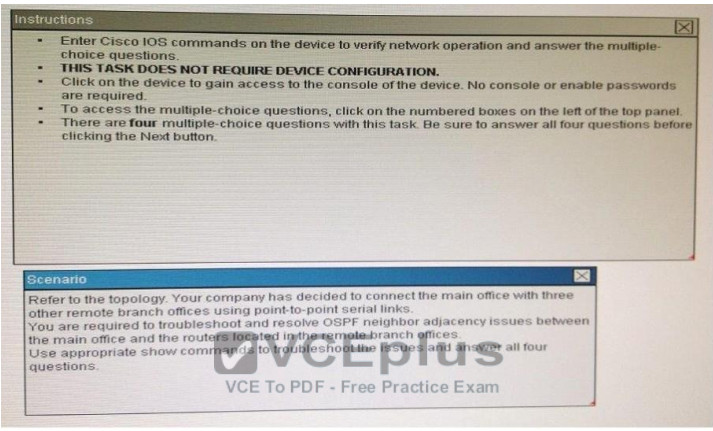
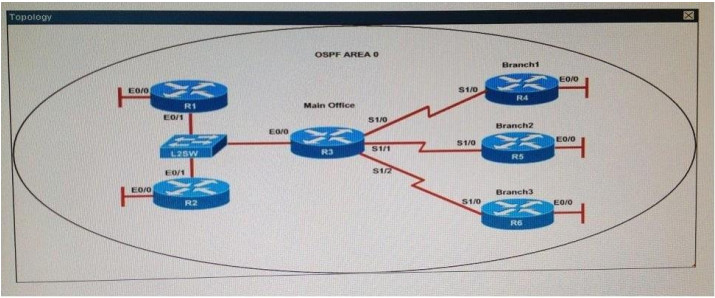
R1# show running-config interface Loopback0 description ***Loopback*** ip address 192.168.1.1 255.255.255.255 ip ospf 1 area 0 ! interface Ethernet0/0 description **Connected to R1-LAN** ip address 10.10.110.1 255.255.255.0 ip ospf 1 area 0 ! interface Ethernet0/1 description **Connected to L2SW** ip address 10.10.230.1 255.255.255.0 ip ospf hello-interval 25 ip ospf 1 area 0 ! log-adjacency-changes R2# show running-config R2 ! interface Loopback0 description **Loopback** ip address 192.168.2.2 255.255.255.255 ip ospf 2 area 0 ! interface Ethernet0/0 description **Connected to R2-LAN** ip address 10.10.120.1 255.255.255.0 ip ospf 2 area 0 ! interface Ethernet0/1 description **Connected to L2SW** ip address 10.10.230.2 255.255.255.0 ip ospf 2 area 0 ! router ospf 2 log-adjacency-changes R3# show running-config R3 username R6 password CISCO36 ! interface Loopback0 description **Loopback** ip address 192.168.3.3 255.255.255.255 ip ospf 3 area 0 ! interface Ethernet0/0 description **Connected to L2SW** ip address 10.10.230.3 255.255.255.0 ip ospf 3 area 0 ! interface Serial1/0 description **Connected to R4-Branch1 office** ip address 10.10.240.1 255.255.255.252 encapsulation ppp ip ospf 3 area 0 ! interface Serial1/1 description **Connected to R5-Branch2 office** ip address 10.10.240.5 255.255.255.252 encapsulation ppp ip ospf hello-interval 50 ip ospf 3 area 0 ! interface Serial1/2 description **Connected to R6-Branch3 office** ip address 10.10.240.9 255.255.255.252 encapsulation ppp ip ospf 3 area 0 ppp authentication chap ! router ospf 3 router-id 192.168.3.3 ! R4# show running-config R4 ! interface Loopback0 description **Loopback** ip address 192.168.4.4 255.255.255.255 ip ospf 4 area 2 ! interface Ethernet0/0 ip address 172.16.113.1 255.255.255.0 ip ospf 4 area 2 ! interface Serial1/0 description **Connected to R3-Main Branch office** ip address 10.10.240.2 255.255.255.252 encapsulation ppp ip ospf 4 area 2 ! router ospf 4 log-adjacency-changes R5# show running-config R5 ! interface Loopback0 description **Loopback** ip address 192.168.5.5 255.255.255.255 ip ospf 5 area 0 ! interface Ethernet0/0 ip address 172.16.114.1 255.255.255.0 ip ospf 5 area 0 ! interface Serial1/0 description **Connected to R3-Main Branch office** ip address 10.10.240.6 255.255.255.252 encapsulation ppp ip ospf 5 area 0 ! router ospf 5 log-adjacency-changes R6# show running-config R6 username R3 password CISCO36 ! interface Loopback0 description **Loopback** ip address 192.168.6.6 255.255.255.255 ip ospf 6 area 0 ! interface Ethernet0/0 ip address 172.16.115.1 255.255.255.0 ip ospf 6 area 0 ! interface Serial1/0 description **Connected to R3-Main Branch office** ip address 10.10.240.10 255.255.255.252 encapsulation ppp ip ospf 6 area 0 ppp authentication chap ! router ospf 6 router-id 192.168.3.3 !
An OSPF neighbor adjacency is not formed between R3 in the main office and R6 in the Branch3 office. What is causing the problem?
A. There is an area ID mismatch.
B. There is a PPP authentication issue; the username is not configured on R3 and R6.
C. There is an OSPF hello and dead interval mismatch.
D. The R3 router ID is configured on R6.
Answer: D
QUESTION 463
Hotspot Questions
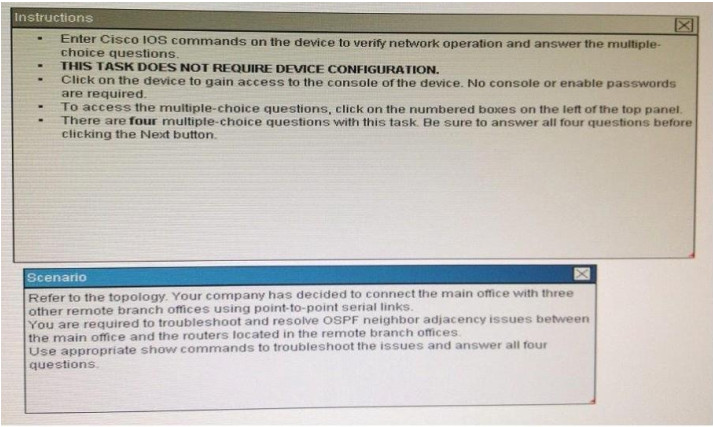
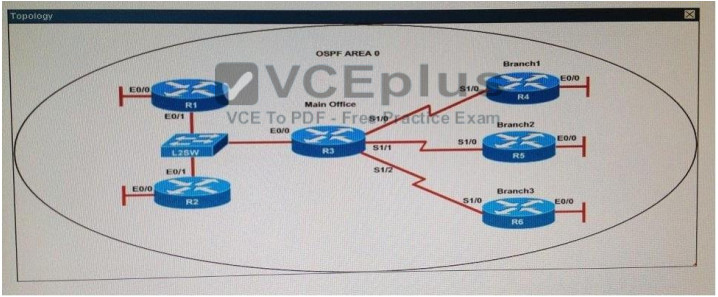
R1# show running-config
interface Loopback0
description ***Loopback***
ip address 192.168.1.1 255.255.255.255
ip ospf 1 area 0
!
interface Ethernet0/0
description **Connected to R1-LAN**
ip address 10.10.110.1 255.255.255.0
ip ospf 1 area 0
!
interface Ethernet0/1
description **Connected to L2SW**
ip address 10.10.230.1 255.255.255.0
ip ospf hello-interval 25
ip ospf 1 area 0
!
log-adjacency-changes
R2# show running-config
R2
!
interface Loopback0
description **Loopback**
ip address 192.168.2.2 255.255.255.255
ip ospf 2 area 0
!
interface Ethernet0/0
description **Connected to R2-LAN**
ip address 10.10.120.1 255.255.255.0
ip ospf 2 area 0
!
interface Ethernet0/1
description **Connected to L2SW**
ip address 10.10.230.2 255.255.255.0
ip ospf 2 area 0
!
router ospf 2
log-adjacency-changes
R3# show running-config
R3
username R6 password CISCO36
!
interface Loopback0
description **Loopback**
ip address 192.168.3.3 255.255.255.255
ip ospf 3 area 0
!
interface Ethernet0/0
description **Connected to L2SW**
ip address 10.10.230.3 255.255.255.0
ip ospf 3 area 0
!
interface Serial1/0
description **Connected to R4-Branch1 office**
ip address 10.10.240.1 255.255.255.252
encapsulation ppp
ip ospf 3 area 0
!
interface Serial1/1
description **Connected to R5-Branch2 office**
ip address 10.10.240.5 255.255.255.252
encapsulation ppp
ip ospf hello-interval 50
ip ospf 3 area 0
!
interface Serial1/2
description **Connected to R6-Branch3 office**
ip address 10.10.240.9 255.255.255.252
encapsulation ppp
ip ospf 3 area 0
ppp authentication chap
!
router ospf 3
router-id 192.168.3.3
!
R4# show running-config
R4
!
interface Loopback0
description **Loopback**
ip address 192.168.4.4 255.255.255.255
ip ospf 4 area 2
!
interface Ethernet0/0
ip address 172.16.113.1 255.255.255.0
ip ospf 4 area 2
!
interface Serial1/0
description **Connected to R3-Main Branch office**
ip address 10.10.240.2 255.255.255.252
encapsulation ppp
ip ospf 4 area 2
!
router ospf 4
log-adjacency-changes
R5# show running-config
R5
!
interface Loopback0
description **Loopback**
ip address 192.168.5.5 255.255.255.255
ip ospf 5 area 0
!
interface Ethernet0/0
ip address 172.16.114.1 255.255.255.0
ip ospf 5 area 0
!
interface Serial1/0
description **Connected to R3-Main Branch office**
ip address 10.10.240.6 255.255.255.252
encapsulation ppp
ip ospf 5 area 0
!
router ospf 5
log-adjacency-changes
R6# show running-config
R6
username R3 password CISCO36
!
interface Loopback0
description **Loopback**
ip address 192.168.6.6 255.255.255.255
ip ospf 6 area 0
!
interface Ethernet0/0
ip address 172.16.115.1 255.255.255.0
ip ospf 6 area 0
!
interface Serial1/0
description **Connected to R3-Main Branch office**
ip address 10.10.240.10 255.255.255.252
encapsulation ppp
ip ospf 6 area 0
ppp authentication chap
!
router ospf 6
router-id 192.168.3.3
!
An OSPF neighbor adjacency is not formed between R3 in the main office and R4 in the Branch1
office. What is causing the problem?
A. There is an area ID mismatch.
B. There is a Layer 2 issue; an encapsulation mismatch on serial links.
C. There is an OSPF hello and dead interval mismatch.
D. The R3 router ID is configured on R4.
Answer: A
QUESTION 466
Hotspot Questions
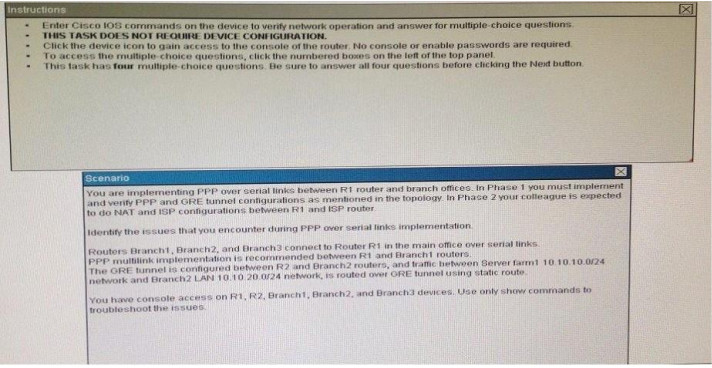
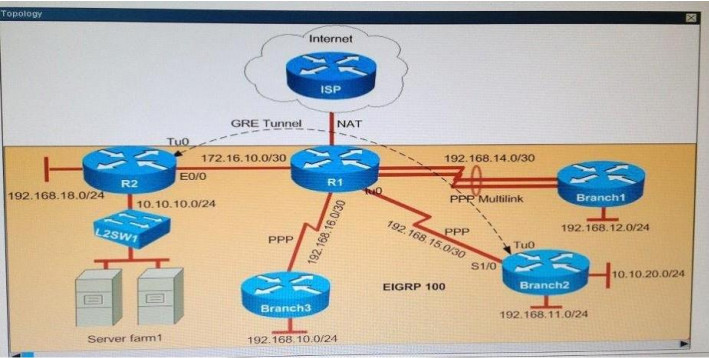
Why is the Branch2 network 10.1 0.20.0/24 unable to communicate with the Server farm1 network 10.1 0.10.0/24 over the GRE tunnel?
A. The GRE tunnel destination is not configured on the R2 router.
B. The GRE tunnel destination is not configured on the Branch2 router.
C. The static route points to the tunnel0 interface that is misconfigured on the Branch2 router.
D. The static route points to the tunnel0 interface that is misconfigured on the R2 router.
Answer: C
QUESTION 467
Hotspot Questions
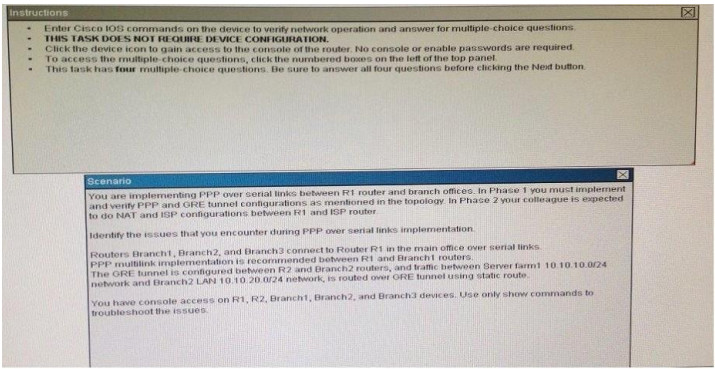
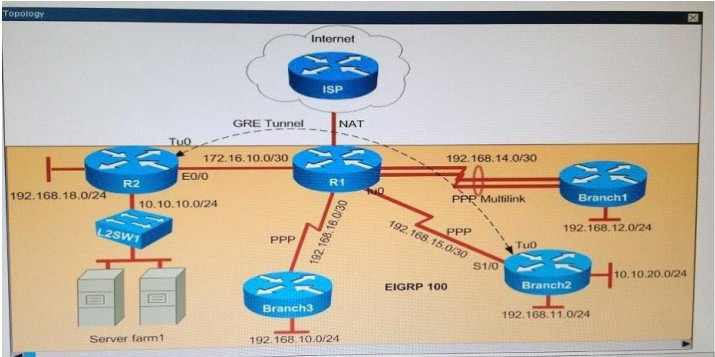
Why has the Branch3 router lost connectivity with R1? Use only show commands to troubleshoot because usage of the debug command is restricted on the Branch3 and R1 routers.
A. A PPP chap hostname mismatch is noticed between Branch3 and R1.
B. A PPP chap password mismatch is noticed between Branch3 and R1.
C. PPP encapsulation is not configured on Branch3.
D. The PPP chap hostname and PPP chap password commands are missing on the Branch3 router.
Answer: A
QUESTION 468
Hotspot Questions
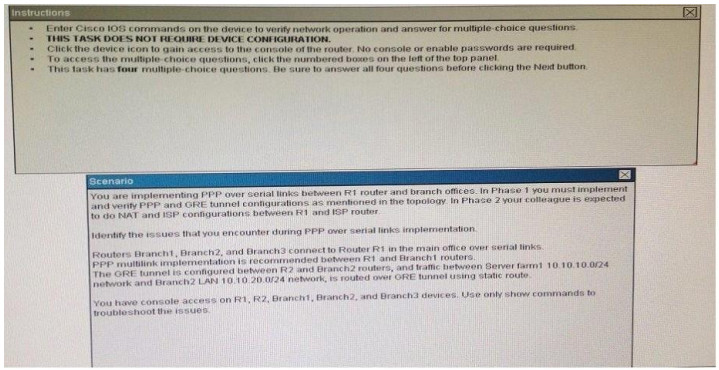
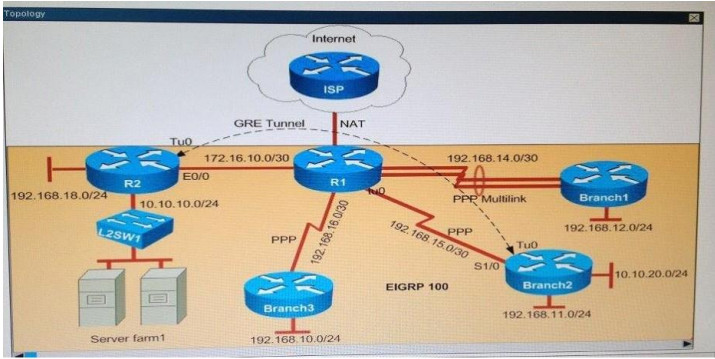
Which statement about the router configurations is correct?
A. PPP PAP is authentication configured between Branch2 and R1.
B. Tunnel keepalives are not configured for the tunnel0 interface on Branch2 and R2.
C. The Branch2 LAN network 192.168.11 0/24 is not advertised into the EIGRP network.
D. The Branch3 LAW network 192.168.10.0/24 is not advertised into the EIGRP network.
E. PPP CHAP is authentication configured between Branch1 and R1.
Answer: D
QUESTION 469
Hotspot Questions
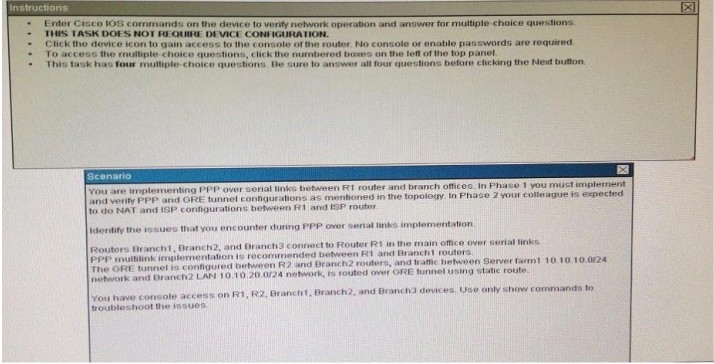
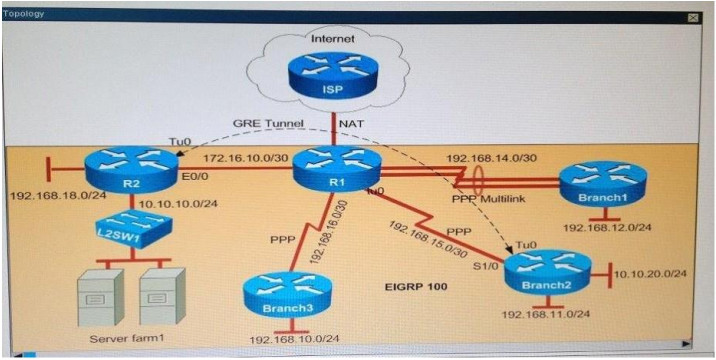
Why did Branch1 router lose WAN connectivity with R1 router?
A. The IP address is misconfigured on PPP multilink interface on the Branch1 router.
B. The PPP multilink group is
C. The PPP multilink group is misconfigured on the R1 serial interfaces.
D. The Branch1 serial interfaces are placed in a shutdown condition.
Answer: A
QUESTION 470
While you were troubleshooting a connection issue, a ping from one VLAN to another VLAN on the same switch failed. Which command verifies that IP routing is enabled on interfaces and the local VLANs are up?
A. show ip interface brief
B. show ip nat statistics
C. show ip statistics
D. show ip route
Answer: A
Explanation:
Initiate a ping from an end device in one VLAN to the interface VLAN on another VLAN in order to verify that the switch routes between VLANs. In this example, ping from VLAN 2 (10.1.2.1) to Interface VLAN 3 (10.1.3.1) or Interface VLAN 10 (10.1.10.1). If the ping fails, verify that IP routing is enabled and that the VLAN interfaces status is up with the show ip interface brief command.
QUESTION 471
Which statement about DTP is true?
A. It uses the native VLAN.
B. It negotiates a trunk link after VTP has been configured.
C. It uses desirable mode by default.
D. It sends data on VLAN 1.
Answer: D
Explanation:
Disabling Dynamic Trunking Protocol (DTP)
Cisco’s Dynamic Trunking Protocol can facilitate the automatic creation of trunks between two switches. When two connected ports are configured in dynamic mode, and at least one of the ports is configured as desirable, the two switches will negotiate the formation of a trunk across the link. DTP isn’t to be confused with VLAN Trunking Protocol (VTP), although the VTP domain does come into play.

DTP on the wire is pretty simple, essentially only advertising the VTP domain, the status of the interface, and it’s DTP type. These packets are transmitted in the native (or access) VLAN every 60 seconds both natively and with ISL encapsulation (tagged as VLAN 1) when DTP is enabled.
QUESTION 472
Which feature can you use to monitor traffic on a switch by replicating it to another port or ports
on the same switch?
A. copy run start
B. traceroute
C. the ICMP Echo IP SLA
D. SPAN
Answer: D
Explanation:
A source port, also called a monitored port, is a switched or routed port that you monitor for network traffic analysis. In a single local SPAN session or RSPAN source session, you can monitor source port traffic, such as received (Rx), transmitted (Tx), or bidirectional (both). The switch supports any number of source ports (up to the maximum number of available ports on the switch) and any number of source VLANs.
A source port has these characteristics:
It can be any port type, such as EtherChannel, Fast Ethernet, Gigabit Ethernet, and so forth.
It can be monitored in multiple SPAN sessions.
It cannot be a destination port.
Each source port can be configured with a direction (ingress, egress, or both) to monitor. For EtherChannel sources, the monitored direction applies to all physical ports in the group.
Source ports can be in the same or different VLANs. For VLAN SPAN sources, all active ports in the source VLAN are included as source ports.
QUESTION 473
Which two circumstances can cause collision domain issues on VLAN domain? (Choose two.)
A. duplex mismatches on Ethernet segments in the same VLAN
B. multiple errors on switchport interfaces
C. congestion on the switch inband path
D. a failing NIC in an end device
E. an overloaded shared segment
Answer: AC
Explanation:
Collision Domains
A collision domain is an area of a single LAN where end stations contend for access to the network because all end stations are connected to a shared physical medium. If two connected devices transmit onto the media at the same time, a collision occurs. When a collision occurs, a JAM signal is sent on the network, indicating that a collision has occurred and that devices should ignore any fragmented data associated with the collision. Both sending devices back off sending their data for a random amount and then try again if the medium is free for transmission.
Therefore, collisions effectively delay transmission of data, lowering the effective throughput available to a device. The more devices that are attached to a collision domain, the greater the the collision domain. Bridges and switches terminate the physical signal path of a collision domain, allowing you to segment separate collision domains, breaking them up into multiple smaller pieces to provide more bandwidth per user within the new collision domains formed.
QUESTION 474
What is a difference between TACACS+ and RADIUS in AAA?
A. Only TACACS+ allows for separate authentication.
B. Only RADIUS encrypts the entire access-request packet.
C. Only RADIUS uses TCP.
D. Only TACACS+ couples authentication and authorization.
Answer: A
Explanation: Authentication and Authorization
RADIUS combines authentication and authorization. The access-accept packets sent by the
RADIUS server to the client contain authorization information. This makes it difficult to decouple authentication and authorization.
TACACS+ uses the AAA architecture, which separates AAA. This allows separate authentication solutions that can still use TACACS+ for authorization and accounting. For example, with TACACS+, it is possible to use Kerberos authentication and TACACS+ authorization and accounting. After a NAS authenticates on a Kerberos server, it requests authorization information from a TACACS+ server without having to re-authenticate. The NAS informs the TACACS+ server that it has successfully authenticated on a Kerberos server, and the server then provides authorization information. During a session, if additional authorization checking is needed, the access server checks with a TACACS+ server to determine if the user is granted permission to use a particular command. This provides greater control over the commands that can be executed on the access server while decoupling from the authentication mechanism.
QUESTION 475
Which version of SNMP first allowed user-based access?
A. SNMPv3 with RBAC
B. SNMPv3
C. SNMPv1
D. SNMPv2
Answer: B
QUESTION 476
Which IEEE standard does PVST+ use to tunnel information?
A. 802.1x
B. 802 1q
C. 802.1w
D. 802.1s
Answer: B
QUESTION 477
Which option describes the purpose of traffic policing?
A. It prioritizes routing protocol traffic.
B. It remarks traffic that is below the CIR
C. It drops traffic that exceeds the CIR.
D. It queues and then transmits traffic that exceeds the CIR.
Answer: C
Explanation:
Traffic policing allows you to control the maximum rate of traffic transmitted or received on an interface. Traffic policing is often configured on interfaces at the edge of a network to limit traffic into or out of the network. In most Traffic Policing configurations, traffic that falls within the rate parameters is transmitted, whereas traffic that exceeds the parameters is dropped or transmitted with a different priority.
QUESTION 478
Which component of the Cisco SDN solution serves as the centralized management system?
A. Cisco OpenDaylight
B. Cisco ACI
C. Cisco APIC
D. Cisco IWAN
Answer: B
Explanation:
Cisco ACI is a comprehensive SDN architecture. This policy-based automation solution supports a business-relevant application policy language, greater scalability through a distributed enforcement system, and greater network visibility. These benefits are achieved through the storage, services, and security.
QUESTION 479
What are two drawbacks of implementing a link-state routing protocol? (Choose two.)
A. the sequencing and acknowledgment of link-state packets
B. the high volume of link-state advertisements in a converged network
C. the requirement for a hierarchical IP addressing scheme for optimal functionality
D. the high demand on router resources to run the link-state routing algorithm
E. the large size of the topology table listing all advertised routes in the converged network
Answer: CD
QUESTION 480
Which part of the PPPoE server configuration contains the information used to assign an IP address to a PPPoE client?
A. virtual-template interface
B. DHCP
C. dialer interface
D. AAA authentication
Answer: C
Explanation:
PPPoE is configured as a point to point connection between two Ethernet ports. As a tunneling protocol, PPPoE is used as an effective foundation for the transport of IP packets at the network layer. IP is overlaid over a PPP connection and uses PPP as a virtual dial up connection between
points on the network. From the user’s perspective, a PPPoE session is initiated by using connection software on the client machine or router. PPPoE session initiation involves the identification of the Media Access Control (MAC) address of the remote device. This process, also known as PPPoE discovery
QUESTION 481
Which process is associated with spanning-tree convergence?
A. determining the path cost
B. electing designated ports
C. learning the sender bridge ID
D. assigning the port ID
Answer: B
Explanation:
Spanning Tree Protocol (STP) convergence (Layer 2 convergence) happens when bridges and switches have transitioned to either the forwarding or blocking state. When layer 2 is converged, Root Switch is elected and Root Ports, Designated Ports and Non-Designated ports in all switches are selected. At Converged condition, the Root Ports and the Designated ports are in forwarding state, and all other ports are in blocking state.
QUESTION 482
Which option is the benefit of implementing an intelligent DNS for a cloud computing solution?
A. It reduces the need for a backup data center.
B. It can redirect user requests to locations that are using fewer network resources.
C. It enables the ISP to maintain DNS records automatically.
D. It eliminates the need for a GSS.
Answer: B
QUESTION 483
Which protocol supports sharing the VLAN configuration between two or more switches?
A. multicast
B. STP
C. VTP
D. split-horizon
Answer: C
Explanation:
“VTP allows a network manager to configure a switch so that it will propagate VLAN configurations to other switches in the network” VTP minimizes misconfigurations and configuration inconsistencies that can cause problems, such as duplicate VLAN names or incorrect VLAN-type specifications. VTP helps you simplify management of the VLAN database across multiple switches. VTP is a Cisco-proprietary protocol and is available on most of the Cisco switches.
QUESTION 484
How can you disable DTP on a switch port?
A. Configure the switch port as a trunk.
B. Add an interface on the switch to a channel group.
C. Change the operational mode to static access.
D. Change the administrative mode to access.
Answer: A
QUESTION 485
Which two components are used to identify a neighbor in a BGP configuration? (Choose two.)
A. autonomous system number
B. version number
C. router ID
D. subnet mask
E. IP address
Answer: AE
Explanation:
Use the show ip bgp neighbors (registered customers only) command to display information about the TCP and Border Gateway Protocol (BGP) connections and verify if the BGP peer is established. The output of the show ip bgp neighbors command below shows the BGP state as
‘Established’, which indicates that the BGP peer relationship has been established successfully.
R1-AGS# show ip bgp neighbors | include BGP
BGP neighbor is 10.10.10.2, remote AS 400, internal link BGP version 4, remote router ID 2.2.2.2
BGP state = Established, up for 00:04:20
BGP table version 1, neighbor version 1
R1-AGS#
The show ip bgp neighbors command has been used above with the modifier | include BGP. This makes the output more readable by filtering the the command output and displaying the relevant parts only.
In addition, the show ip bgp summary (registered customers only) command can also be used to display the status of all BGP connections, as shown below.
R1-AGS(9)# show ip bgp summary
BGP router identifier 10.1.1.2, local AS number 400 BGP table version is 1, main routing table version 1
Neighbor V AS MsgRcvd MsgSent TblVer InQ OutQ Up/Down State/PfxRcd 10.10.10.2 4 400 3 3 1 0 0 00:00:26 0
QUESTION 486
Which type of interface can negotiate an IP address for a PPPoE client?
A. Ethernet
B. dialer
C. serial
D. Frame Relay
Answer: B
QUESTION 487
What is the default VLAN on an access port?
A. 0
B. 1
C. 10
D. 1024
Answer: B
QUESTION 488
Which statement about QoS default behavior is true?
A. Ports are untrusted by default.
B. VoIP traffic is passed without being tagged.
C. Video traffic is passed with a well-known DSCP value of 46.
D. Packets are classified internally with an environment.
E. Packets that arrive with a tag are untagged at the edge of an administrative domain.
Answer: E
Explanation:
Frames received from users in the administratively-defined VLANs are classified or tagged for transmission to other devices. Based on rules that you define, a unique identifier (the tag) is inserted in each frame header before it is forwarded. The tag is examined and understood by each device before any broadcasts or transmissions to other switches, routers, or end stations. When the frame reaches the last switch or router, the tag is removed before the frame is sent to
the target end station. VLANs that are assigned on trunk or access ports without identification or a tag are called native or untagged frames. For IEEE 802.1Q frames with tag information, the priority value from the header frame is used. For native frames, the default priority of the input port is used. Each port on the switch has a single receive queue buffer (the ingress port) for incoming traffic. When an untagged frame arrives, it is assigned the value of the port as its port default priority. You assign this value by using the CLI or CMS. A tagged frame continues to use its assigned CoS value when it passes through the ingress port.
QUESTION 489
Refer to the exhibit. While troubleshooting a switch, you executed the show interface port-channel 1 etherchannel command and it returned this output. Which information is provided by the Load value?

A. the percentage of use of the link
B. the preference of the link
C. the session count of the link
D. the number source-destination pairs on the link
Answer: D
QUESTION 490
Which spanning-tree feature places a port immediately into a forwarding stated?
A. BPDU guard
B. PortFast
C. loop guard
D. UDLD
E. Uplink Fast
Answer: B
Explanation:
PortFast causes a switch or trunk port to enter the spanning tree forwarding state immediately, bypassing the listening and learning states. You can use PortFast on switch or trunk ports that are connected to a single workstation, switch, or server to allow those devices to connect to the network immediately, instead of waiting for the port to transition from the listening and learning states to the forwarding state.
QUESTION 491
Which protocol authenticates connected devices before allowing them to access the LAN?
A. 802.1d
B. 802.11
C. 802.1w
D. 802.1x
Answer: D
Explanation:
802.1X authentication involves three parties: a supplicant, an authenticator, and an authentication server. The supplicant is a client device (such as a laptop) that wishes to attach to the LAN/WLAN. The term ‘supplicant’ is also used interchangeably to refer to the software running on the client that provides credentials to the authenticator. The authenticator is a network device, such as an Ethernet switch or wireless access point; and the authentication server is typically a host running software supporting the RADIUS and EAP protocols.
The authenticator acts like a security guard to a protected network. The supplicant (i.e., client device) is not allowed access through the authenticator to the protected side of the network until the supplicant’s identity has been validated and authorized. An analogy to this is providing a valid visa at the airport’s arrival immigration before being allowed to enter the country. With 802.1X port-based authentication, the supplicant provides credentials, such as user name/password or digital certificate, to the authenticator, and the authenticator forwards the credentials to the authentication server for verification. If the authentication server determines the credentials are valid, the supplicant (client device) is allowed to access resources located on the protected side of the network.
QUESTION 492
Which identification number is valid for an extended ACL?
A. 1
B. 64
C. 99
D. 100
E. 299
F. 1099
Answer: D
QUESTION 493
Which two pieces of information are provided by the show controllers serial 0 command? (Choose two.)
A. the type of cable that is connected to the interface.
B. The uptime of the interface
C. the status of the physical layer of the interface
D. the full configuration of the interface
E. the interface’s duplex settings
Answer: AC
Explanation:
The show controller command provides hardware-related information useful to troubleshoot and diagnose issues with Cisco router interfaces. The Cisco 12000 Series uses a distributed architecture with a central command-line interface (CLI) at the Gigabit Route Processor (GRP) and a local CLI at each line card.
QUESTION 494
Which EIGRP for IPv6 command can you enter to view the link-local addresses of the neighbors of a device?
A. show ipv6 eigrp 20 interfaces
B. show ipv6 route eigrp
C. show ipv6 eigrp neighbors
D. show ip eigrp traffic
Answer: C
QUESTION 495
Which configuration can you apply to enable encapsulation on a subinterface?
A. interface FastEthernet 0/0
encapsulation dot1Q 30
ip address 10.1.1.30 255.255.255.0
B. interface FastEthernet 0/0.30
ip address 10.1.1.30 255.255.255.0
C. interface FastEthernet 0/0.30
description subinterface vlan 30
D. interface FastEthernet 0/0.30
encapsulation dot1Q 30
ip address 10.1.1.30 255.255.255.0
Answer: D
QUESTION 496
Which statement about slow inter VLAN forwarding is true?
A. The VLAN is experiencing slowness in the point-to-point collisionless connection.
B. The VLANs are experiencing slowness because multiple devices are connected to the same hub.
C. The local VLAN is working normally, but traffic to the alternate VLAN is forwarded slower than expected.
D. The entire VLAN is experiencing slowness.
E. The VLANs are experiencing slowness due to a duplex mismatch.
Answer: E
Explanation:
Common Causes of Slow IntraVLAN and InterVLAN Connectivity The symptoms of slow connectivity on a VLAN can be caused by multiple factors on different network layers. Commonly the network speed issue may be occurring on a lower level, but symptoms can be observed on a higher level as the problem masks itself under the term “slow VLAN”. To clarify, this document defines the following new terms: “slow collision domain”, “slow broadcast domain” (in other words, slow VLAN), and “slow interVLAN forwarding”. These are defined in the section Three Categories of Causes, below.
In the following scenario (illustrated in the network diagram below), there is a Layer 3 (L3) switch performing interVLAN routing between the server and client VLANs. In this failure scenario, one server is connected to a switch, and the port duplex mode is configured half- duplex on the server side and full-duplex on the switch side. This misconfiguration results in a packet loss and slowness, with increased packet loss when higher traffic rates occur on the link where the server is connected. For the clients who communicate with this server, the problem looks like slow interVLAN forwarding because they do not have a problem communicating to other devices or clients on the same VLAN. The problem occurs only when communicating to the server on a different VLAN. Thus, the problem occurred on a single collision domain, but is seen as slow interVLAN forwarding.
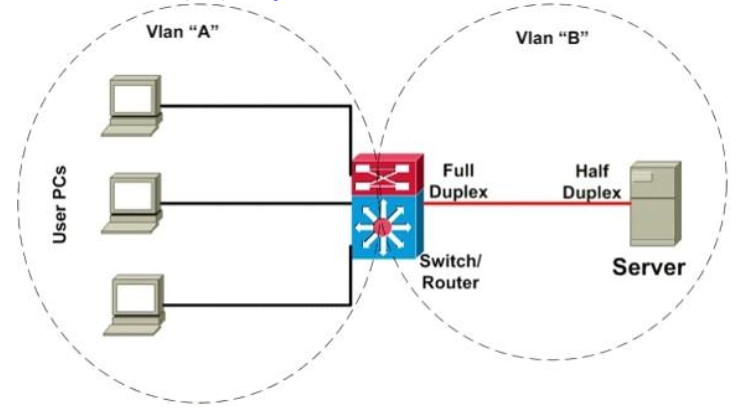
Three Categories of Causes
The causes of slowness can be divided into three categories, as follows:
Slow Collision Domain Connectivity
Collision domain is defined as connected devices configured in a half-duplex port configuration, connected to each other or a hub. If a device is connected to a switch port and full-duplex mode is configured, such a point-to-point connection is collisionless. Slowness on such a segment still can occur for different reasons.
Slow Broadcast Domain Connectivity (Slow VLAN)
Slow broadcast domain connectivity occurs when the whole VLAN (that is, all devices on the same VLAN) experiences slowness.
Slow InterVLAN Connectivity (Slow Forwarding Between VLANs) Slow interVLAN connectivity (slow forwarding between VLANs) occurs when there is no slowness on the local VLAN, but traffic needs to be forwarded to an alternate VLAN, and it is not forwarded at the expected rate.
Causes for Network Slowness
Packet Loss
In most cases, a network is considered slow when higher-layer protocols (applications) require extended time to complete an operation that typically runs faster. That slowness is caused by the loss of some packets on the network, which causes higher-level protocols like TCP or applications to time out and initiate retransmission.
Hardware Forwarding Issues With another type of slowness, caused by network equipment, forwarding (whether Layer 2 [L2] or L3) is performed slowly. This is due to a deviation from normal (designed) operation and switching to slow path forwarding. An example of this is when Multilayer Switching (MLS) on the switch forwards L3 packets between VLANs in the hardware, but due to misconfiguration, MLS is not functioning properly and forwarding is done by the router in the software (which drops the interVLAN forwarding rate significantly).
QUESTION 497
Which statement about the IP SLAs ICMP Echo operation is true?
A. The frequency of the operation .s specified in milliseconds.
B. It is used to identify the best source interface from which to send traffic.
C. It is configured in enable mode.
D. It is used to determine the frequency of ICMP packets.
Answer: D
Explanation:
This module describes how to configure an IP Service Level Agreements (SLAs) Internet Control Message Protocol (ICMP) Echo operation to monitor end-to-end response time between a Cisco router and devices using IPv4 or IPv6. ICMP Echo is useful for troubleshooting network connectivity issues. This module also demonstrates how the results of the ICMP Echo operation can be displayed and analyzed to determine how the network IP connections are performing.
ICMP Echo Operation
The ICMP Echo operation measures end-to-end response time between a Cisco router and any devices using IP. Response time is computed by measuring the time taken between sending an ICMP Echo request message to the destination and receiving an ICMP Echo reply. In the figure below ping is used by the ICMP Echo operation to measure the response time between the source IP SLAs device and the destination IP device. Many customers use IP SLAs ICMP-based operations, in-house ping testing, or ping-based dedicated probes for response time measurements.
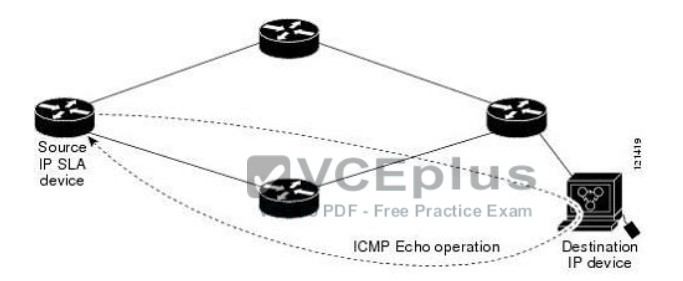
The IP SLAs ICMP Echo operation conforms to the same IETF specifications for ICMP ping testing and the two methods result in the same response times.
Configuring a Basic ICMP Echo Operation on the Source Device SUMMARY STEPS
1. enable
2. configure terminal
3. ip sla operation-number
4. icmp-echo {destination-ip-address | destination-hostname} [source-ip {ip-address | hostname} | source-interface interface-name]
5. frequency seconds 6. end
QUESTION 498
Which option describes how a switch in rapid PVST+ mode responds to a topology change?
A. It immediately deletes dynamic MAC addresses that were learned by all ports on the switch.
B. It sets a timer to delete all MAC addresses that were learned dynamically by ports in the same STP instance.
C. It sets a timer to delete dynamic MAC addresses that were learned by all ports on the switch.
D. It immediately deletes all MAC addresses that were learned dynamically by ports in the same
STP instance.
Answer: D
Explanation:
Rapid PVST+This spanning-tree mode is the same as PVST+ except that is uses a rapid convergence based on the IEEE 802.1w standard. To provide rapid convergence, the rapid PVST+ immediately deletes dynamically learned MAC address entries on a per-port basis upon receiving a topology change. By contrast, PVST+ uses a short aging time for dynamically learned MAC address entries.
The rapid PVST+ uses the same configuration as PVST+ (except where noted), and the switch needs only minimal extra configuration. The benefit of rapid PVST+ is that you can migrate a large PVST+ install base to rapid PVST+ without having to learn the complexities of the MSTP configuration and without having to reprovision your network. In rapid-PVST+ mode, each VLAN runs its own spanning-tree instance up to the maximum supported.
QUESTION 499
Which type of topology is required by DMVPN?
A. ring
B. full mesh
C. hub-and-spoke
D. partial mesh
Answer: C
QUESTION 500
Refer to the exhibit. Router edge-1 is unable to establish OSPF neighbor adjacency with router ISP-1. Which two configuration changes can you make on edge-1 to allow the two routers to establish adjacency? (Choose two.)
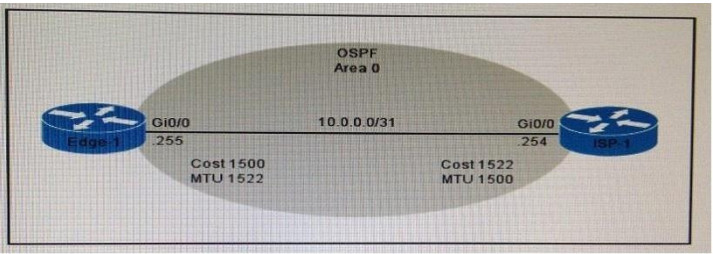
A. Set the subnet mask on edge-1 to 255 255.255.252.
B. Reduce the MTU on edge-1 to 1514.
C. Set the OSPF cost on edge-1 to 1522.
D. Reduce the MTU on edge-1 to 1500.
E. Configure the ip ospf mtu-ignore command on the edge-1 Gi0/0 interface.
Answer: DE
Explanation:
A situation can occur where the interface MTU is at a high value, for example 9000, while the real value of the size of packets that can be forwarded over this interface is 1500. If there is a mismatch on MTU on both sides of the link where OSPF runs, then the OSPF adjacency will not form because the MTU value is carried in the Database Description (DBD) packets and checked on the other side.
QUESTION 501
Which statement about switch access ports is true?
A. They drop packets with 802.1Q tags.
B. A VLAN must be assigned to an access port before it is created.
C. They can receive traffic from more than one VLAN with no voice support
D. By default, they carry traffic for VLAN 10.
Answer: A
Explanation:
“If an access port receives a packet with an 802.1Q tag in the header other than the access VLAN value, that port drops the packet without learning its MAC source address.”
QUESTION 502
Which option is a benefit of switch stacking?
A. It provides redundancy with no impact on resource usage.
B. It simplifies adding and removing hosts.
C. It supports better performance of high-needs applications.
D. It provides higher port density with better resource usage.
Answer: D
Explanation:
A stackable switch is a network switch that is fully functional operating standalone but which can also be set up to operate together with one or more other network switches, with this group of switches showing the characteristics of a single switch but having the port capacity of the sum of the combined switches.
QUESTION 503
What is the first step you perform to configure an SNMPv3 user?
A. Configure server traps.
B. Configure the server group.
C. Configure the server host.
D. Configure the remote engine ID.
Answer: B
Explanation:
The first task in configuring SNMPv3 is to define a view. To simplify things, we’ll create a view that allows access to the entire internet subtree: router(config)#snmp-server view readview internet included This command creates a view called readview. If you want to limit the view to the system tree, for example, replace internet with system. The included keyword states that the specified tree should be included in the view; use excluded if you wanted to exclude a certain subtree.
Next, create a group that uses the new view. The following command creates a group called readonly ; v3 means that SNMPv3 should be used. The auth keyword specifies that the entity should authenticate packets without encrypting them; read readview says that the view named readview should be used whenever members of the readonly group access the router. router(config)#snmp-server group readonly v3 auth read readview
QUESTION 504
Which statement about named ACLs is true?
A. They support standard and extended ACLs.
B. They are used to filter usernames and passwords for Telnet and SSH.
C. They are used to filter Layer 7 traffic.
D. They support standard ACLs only.
E. They are used to rate limit traffic destined to targeted networks.
Answer: A
Explanation:
Named Access Control Lists (ACLs) allows standard and extended ACLs to be given names instead of numbers. Unlike in numbered Access Control Lists (ACLs), we can edit Named Access Control Lists. Another benefit of using named access configuration mode is that you can add new statements to the access list, and insert them wherever you like. With the legacy syntax, you must delete the entire access list before reapplying it using the updated rules.
QUESTION 505
Which two switch states are valid for 802.1w? (Choose two.)
A. listening
B. backup
C. disabled
D. learning
E. discarding
Answer: DE
Explanation:
Port States
There are only three port states left in RSTP that correspond to the three possible operational states. The 802.1D disabled, blocking, and listening states are merged into a unique 802.1w discarding state.

QUESTION 506
Which statement about MPLS is true?
A. It operates in Layer 1.
B. It operates between Layer 2 and Layer 3.
C. It operates in Layer 3.
D. it operates in Layer 2.
Answer: B
Explanation:
MPLS belongs to the family of packet-switched networks. MPLS operates at a layer that is generally considered to lie between traditional definitions of OSI Layer 2 (data link layer) and Layer 3 (network layer), and thus is often referred to as a layer 2.5 protocol.
QUESTION 507
Which Cisco platform can verify ACLs?
A. Cisco Prime Infrastructure
B. Cisco Wireless LAN Controller
C. Cisco APIC-EM
D. Cisco IOS-XE
Answer: B
QUESTION 508
Which three options are the HSRP states for a router? (Choose three.)
A. initialize
B. learn
C. secondary
D. listen
E. speak
F. primary
Answer: BDE
Explanation:
HSRP States
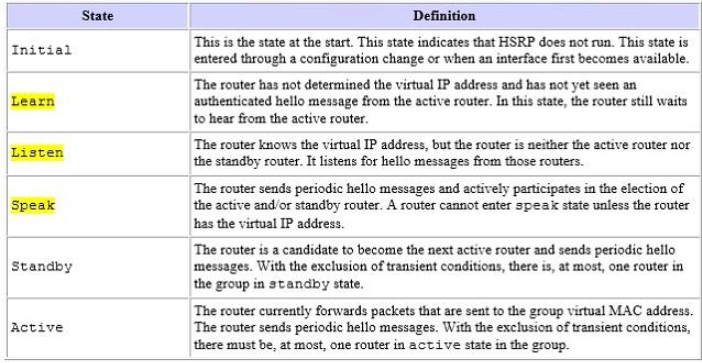
QUESTION 509
You enter the show ipv6 route command on an OSPF device and the device displays a route. Which conclusion can you draw about the environment?
A. OSPF is distributing IPv6 routes to BGP.
B. The router is designated as an ABR.
C. The router is designated as totally stubby.
D. OSPFv3 is in use.
Answer: A
QUESTION 510
Which NTP command configures the local device as an NTP reference clock source?
A. ntp peer
B. ntp broadcast
C. ntp master
D. ntp server
Answer: D
QUESTION 511
Which routing protocol has the smallest default administrative distance?
A. IBGP
B. OSPF
C. IS-IS
D. EIGRP
E. RIP
Answer: D
Explanation:
http://www.cisco.com/c/en/us/support/docs/ip/border-gateway-protocol-bgp/15986-admindistance.html
Default Distance Value TableThis table lists the administrative distance default values of the protocols that Cisco supports:
Route Source
Default Distance Values
Connected interface
Static route
Enhanced Interior Gateway Routing Protocol (EIGRP) summary route External Border Gateway
Protocol (BGP)
Internal EIGRP
IGRP
OSPF
Intermediate System-to-Intermediate System (IS-IS) Routing Information Protocol (RIP)
Exterior Gateway Protocol (EGP)
On Demand Routing (ODR)
External EIGRP
Internal BGP
Unknown*
QUESTION 512
Which statement about static routes is true?
A. The source interface can be configured to make routing decisions.
B. A subnet mask is entered for the next-hop address.
C. The subnet mask is 255.255 255.0 by default
D. The exit interface can be specified to indicate where the packets will be routed.
Answer: D
Explanation:
Static routing can be used to define an exit point from a router when no other routes are available or necessary. This is called a default route.
QUESTION 514
Which component of a routing table entry represents the subnet mask?
A. routing protocol code
B. prefix
C. metric
D. network mask
Answer: D
Explanation:
IP Routing Table Entry TypesAn entry in the IP routing table contains the following information in the order presented: Network ID. The network ID or destination corresponding to the route. The network ID can be class-based, subnet, or supernet network ID, or an IP address for a host route. Network Mask. The mask that is used to match a destination IP address to the network ID. Next Hop. The IP address of the next hop. Interface. An indication of which network interface is used to forward the IP packet. Metric. A number used to indicate the cost of the route so the best route among possible multiple routes to the same destination can be selected. A common use of the metric is to indicate the number of hops (routers crossed) to the network ID. Routing table entries can be used to store the following types of routes: irectly Attached Network IDs. Routes for network IDs that are directly attached. For directly attached networks, the Next Hop field can be blank or contain the IP address of the interface on that network.
Remote Network IDs. Routes for network IDs that are not directly attached but are available across other routers. For remote networks, the Next Hop field is the IP address of a local router in between the forwarding node and the remote network. Host Routes. A route to a specific IP address. Host routes allow routing to occur on a per- IP address basis. For host routes, the network ID is the IP address of the specified host and the network mask is 255.255.255.255. Default Route. The default route is designed to be used when a more specific network ID or host route is not found. The default route network ID is 0.0.0.0 with the network mask of 0.0.0.0.
QUESTION 515
When a router makes a routing decision for a packet that is received from one network and destined to another, which portion of the packet does if replace?
A. Layer 2 frame header and trailer
B. Layer 3 IP address
C. Layer 5 session
D. Layer 4 protocol
Answer: A
Explanation:
Router Switching Function (1.2.1.1)A primary function of a router is to forward packets toward their destination. This is accomplished by using a switching function, which is the process used by a router to accept a packet on one interface and forward it out of another interface. A key responsibility of the switching function is to encapsulate packets in the appropriate data link frame type for the outgoing data link.
NOTE:
In this context, the term “switching” literally means moving packets from source to destination and should not be confused with the function of a Layer 2 switch. After the router has determined the exit interface using the path determination function, the router must encapsulate the packet into the data link frame of the outgoing interface. What does a router do with a packet received from one network and destined for another network? The router performs the following three major
steps:
Step 1. De-encapsulates the Layer 3 packet by removing the Layer 2 frame header and trailer.
Step 2. Examines the destination IP address of the IP packet to find the best path in the routing table.
Step 3. If the router finds a path to the destination, it encapsulates the Layer 3 packet into a new
Layer 2 frame and forwards the frame out the exit interface.
QUESTION 516
On which type of device is every port in the same collision domain?
A. a router
B. a Layer 2 switch
C. a hub
Answer: C
Explanation:
Collision domainA collision domain is, as the name implies, a part of a network where packet collisions can occur. A collision occurs when two devices send a packet at the same time on the shared network segment. The packets collide and both devices must send the packets again, which reduces network efficiency. Collisions are often in a hub environment, because each port on a hub is in the same collision domain. By contrast, each port on a bridge, a switch or a router is in a separate collision domain.
QUESTION 517
Which statement about routing protocols is true?
A. Link-state routing protocols choose a path by the number of hops to the destination.
B. OSPF is a link-state routing protocol.
C. Distance-vector routing protocols use the Shortest Path First algorithm.
D. IS-IS is a distance-vector routing protocol.
Answer: A
Explanation:
Link State Routing Protocols
Link state protocols are also called shortest-path-first protocols. Link state routing protocols have a complete picture of the network topology. Hence they know more about the whole network than any distance vector protocol. Three separate tables are created on each link state routing enabled router. One table is used to hold details about directly connected neighbors, one is used to hold the topology of the entire internetwork and the last one is used to hold the actual routing table. Link state protocols send information about directly connected links to all the routers in the network. Examples of Link state routing protocols include OSPF – Open Shortest Path First and IS-IS – Intermediate System to Intermediate System. There are also routing protocols that are considered to be hybrid in the sense that they use aspects of both distance vector and link state protocols. EIGRP – Enhanced Interior Gateway Routing Protocol is one of those hybrid routing protocols.
QUESTION 518
Which technology supports the stateless assignment of IPv6 addresses?
A. DNS
B. DHCPv6
C. DHCP
D. autoconfiguration
Answer: B
Explanation:
DHCPv6 Technology Overview IPv6 Internet Address Assignment Overview IPv6 has been developed with Internet Address assignment dynamics in mind. Being aware that IPv6 Internet addresses are 128 bits in length and written in hexadecimals makes automation of address-assignment an important aspect within network design. These attributes make it inconvenient for a user to manually assign IPv6 addresses, as the format is not naturally intuitive to the human eye. To facilitate address assignment with little or no human intervention, several methods and technologies have been developed to automate the process of address and configuration parameter assignment to IPv6 hosts. The various IPv6 address assignment methods are as follows:
1. Manual Assignment
An IPv6 address can be statically configured by a human operator. However, manual assignment is quite open to errors and operational overhead due to the 128 bit length and hexadecimal attributes of the addresses, although for router interfaces and static network elements and resources this can be an appropriate solution.
2. Stateless Address Autoconfiguration (RFC2462)
Stateless Address Autoconfiguration (SLAAC) is one of the most convenient methods to assign Internet addresses to IPv6 nodes. This method does not require any human intervention at all from an IPv6 user. If one wants to use IPv6 SLAAC on an IPv6 node, it is important that this IPv6 node is connected to a network with at least one IPv6 router connected. This router is configured by the network administrator and sends out Router Advertisement announcements onto the link. These announcements can allow the on-link connected IPv6 nodes to configure themselves with IPv6 address and routing parameters, as specified in RFC2462, without further human intervention.
3. Stateful DHCPv6
The Dynamic Host Configuration Protocol for IPv6 (DHCPv6) has been standardized by the IETF through RFC3315. DHCPv6 enables DHCP servers to pass configuration parameters, such as IPv6 network addresses, to IPv6 nodes. It offers the capability of automatic allocation of reusable network addresses and additional configuration flexibility. This protocol is a stateful counterpart to “IPv6 Stateless Address Autoconfiguration” (RFC 2462), and can be used separately, or in addition to the stateless autoconfiguration to obtain configuration parameters.
4. DHCPv6-PD
DHCPv6 Prefix Delegation (DHCPv6-PD) is an extension to DHCPv6, and is specified in RFC3633. Classical DHCPv6 is typically focused upon parameter assignment from a DHCPv6 server to an IPv6 host running a DHCPv6 protocol stack. A practical example would be the stateful address assignment of “2001:db8::1” from a DHCPv6 server to a DHCPv6 client. DHCPv6-PD however is aimed at assigning complete subnets and other network and interface parameters from a DHCPv6-PD server to a DHCPv6-PD client. This means that instead of a single address assignment, DHCPv6-PD will assign a set of IPv6 “subnets”. An example could be the assignment of “2001:db8::/60” from a DHCPv6-PD server to a DHCPv6-PD client. This will allow the DHCPv6-PD client (often a CPE device) to segment the received address IPv6 address space, and assign it dynamically to its IPv6 enabled interfaces.
5. Stateless DHCPv6
Stateless DHCPv6 is a combination of “stateless Address Autoconfiguration” and “Dynamic Host Configuration Protocol for IPv6” and is specified by RFC3736. When using stateless- DHCPv6, a device will use Stateless Address Auto-Configuration (SLAAC) to assign one or more IPv6 addresses to an interface, while it utilizes DHCPv6 to receive “additional parameters” which may not be available through SLAAC. For example, additional parameters could include information such as DNS or NTP server addresses, and are provided in a stateless manner by DHCPv6. Using stateless DHCPv6 means that the DHCPv6 server does not need to keep track of any state
of assigned IPv6 addresses, and there is no need for state refreshment as result. On network media supporting a large number of hosts associated to a single DHCPv6 server, this could mean a significant reduction in DHCPv6 messages due to the reduced need for address state refreshments. From Cisco IOS 12.4(15)T onwards the client can also receive timing information, in addition to the “additional parameters” through DHCPv6. This timing information provides an indication to a host when it should refresh its DHCPv6 configuration data. This behavior (RFC4242) is particularly useful in unstable environments where changes are likely to occur.
QUESTION 519
Which feature allows a device to use a switch port that is configured for half-duplex to access the network?
A. CSMA/CD
B. IGMP
C. port security
D. split horizon
Answer: A
Explanation:
Ethernet began as a local area network technology that provided a half-duplex shared channel for stations connected to coaxial cable segments linked with signal repeaters. In this appendix, we take a detailed look at the half-duplex shared-channel mode of operation, and at the CSMA/CD mechanism that makes it work. In the original half-duplex mode, the CSMA/CD protocol allows a set of stations to compete for access to a shared Ethernet channel in a fair and equitable manner.
The protocol’s rules determine the behavior of Ethernet stations, including when they are allowed to transmit a frame onto a shared Ethernet channel, and what to do when a collision occurs. Today, virtually all devices are connected to Ethernet switch ports over full-duplex media, such as twisted-pair cables. On this type of connection, assuming that both devices can support the full-duplex mode of operation and that Auto-Negotiation (AN) is enabled, the AN protocol will automatically select the highest-performance mode of operation supported by the devices at each end of the link. That will result in full-duplex mode for the vast majority of Ethernet connections with modern interfaces that support full duplex and AN.
QUESTION 520
Which function enables an administrator to route multiple VLANs on a router?
A. IEEE 802 1X
B. HSRP
C. port channel
D. router on a stick
Answer: D
QUESTION 522
What is one requirement for interfaces to run IPv6?
A. An IPv6 address must be configured on the interface.
B. An IPv4 address must be configured.
C. Stateless autoconfiguration must be enabled after enabling IPv6 on the interface.
D. IPv6 must be enabled with the ipv6 enable command in global configuration mode.
Answer: A
Explanation:
To use IPv6 on your router, you must, at a minimum, enable the protocol and assign IPv6 addresses to your interfaces.
QUESTION 523
Which destination IP address can a host use to send one message to multiple devices across different subnets?
A. 172.20.1.0
B. 127.0.0.1
C. 192.168.0.119
D. 239.255.0.1
Answer: D
Explanation:
Multicast is a networking protocol where one host can send a message to a special multicast IP address and one or more network devices can listen for and receive those messages. Multicast works by taking advantage of the existing IPv4 networking infrastructure, and it does so in something of a weird fashion. As you read, keep in mind that things are a little confusing because multicast was “shoe-horned” in to an existing technology. For the rest of this article, let’s use the multicast IP address of 239.255.0.1. We’ll not worry about port numbers yet, but make a mental note that they are used in multicast. We’ll discuss that later.
QUESTION 524
Which MTU size can cause a baby giant error?
A. 1500
B. 9216
C. 1600
D. 1518
Answer: C
Explanation:
http://www.cisco.com/c/en/us/support/docs/switches/catalyst-4000-series-switches/29805- 175.html
QUESTION 525
Which entity assigns IPv6 addresses to end users?
A. ICANN
B. APNIC
C. RIR
D. ISPs
Answer: C
QUESTION 526
Which option is the default switch port port-security violation mode?
A. shutdown
B. protect
C. shutdown vlan
D. restrict
Answer: A
Explanation:
Shutdown–This mode is the default violation mode; when in this mode, the switch will automatically force the switchport into an error disabled (err-disable) state when a violation occurs. While in this state, the switchport forwards no traffic. The switchport can be brought out of this error disabled state by issuing the errdisable recovery cause CLI command or by disabling and reenabling the switchport. Shutdown VLAN–This mode mimics the behavior of the shutdown mode but limits the error disabled state the specific violating VLAN.
QUESTION 527
Which statement about the inside interface configuration in a NAT deployment is true?
A. It is defined globally
B. It identifies the location of source addresses for outgoing packets to be translated using access or route maps.
C. It must be configured if static NAT is used
D. It identifies the public IP address that traffic will use to reach the internet.
Answer: B
Explanation:
This module describes how to configure Network Address Translation (NAT) for IP address
conservation and how to configure inside and outside source addresses. This module also provides information about the benefits of configuring NAT for IP address conservation. NAT enables private IP internetworks that use nonregistered IP addresses to connect to the Internet. NAT operates on a device, usually connecting two networks, and translates the private (not globally unique) addresses in the internal network into legal addresses before packets are forwarded onto another network. NAT can be configured to advertise to the outside world only one address for the entire network. This ability provides additional security by effectively hiding the entire internal network behind that one address. NAT is also used at the enterprise edge to allow internal users access to the Internet and to allow Internet access to internal devices such as mail servers.
QUESTION 528
Which value is indicated by the next hop in a routing table?
A. preference of the route source
B. IP address of the remote router for forwarding the packets
C. how the route was learned
D. exit interface IP address for forwarding the packets
Answer: D
Explanation:
The routing table contains network/next hop associations. These associations tell a router that a particular destination can be optimally reached by sending the packet to a specific router that represents the “next hop” on the way to the final destination. The next hop association can also be the outgoing or exit interface to the final destination.
QUESTION 529
Which option is a valid hostname for a switch?
A. Switch-Cisco
B. Switch-Cisco!
C. SwitchCisco
D. SwitchCisc0
Answer: C
QUESTION 530
Which component of the routing table ranks routing protocols according to their preferences?
A. administrative distance
B. next hop
C. metric
D. routing protocol code
Answer: A
Explanation:
Administrative distance – This is the measure of trustworthiness of the source of the route. If a router learns about a destination from more than one routing protocol, administrative distance is compared and the preference is given to the routes with lower administrative distance. In other words, it is the believability of the source of the route.
QUESTION 531
Which statement about unicast frame forwarding on a switch is true?
A. The TCAM table stores destination MAC addresses
B. If the destination MAC address is unknown, the frame is flooded to every port that is configured in the same VLAN except on the port that it was received on.
C. The CAM table is used to determine whether traffic is permitted or denied on a switch
D. The source address is used to determine the switch port to which a frame is forwarded
Answer: B
QUESTION 532
Which statement about native VLAN traffic is true?
A. Cisco Discovery Protocol traffic travels on the native VLAN by default
B. Traffic on the native VLAN is tagged with 1 by default
C. Control plane traffic is blocked on the native VLAN.
D. The native VLAN is typically disabled for security reasons
Answer: B
QUESTION 533
Which route source code represents the routing protocol with a default administrative distance of 90 in the routing table?
A. S
B. E
C. D
D. R
E. O
Answer: C
Explanation:
SStatic
EEGP
DEIGRP
RRIP
OOSPF
Default Administrative distance of EIGRP protocol is 90 then answer is C.

Default Distance Value TableThis table lists the administrative distance default values of the protocols that Cisco supports:
Route Source
Default Distance Values
Connected interface
Static route
Enhanced Interior Gateway Routing Protocol (EIGRP) summary route External Border Gateway
Protocol (BGP)
Internal EIGRP
IGRP
OSPF
Intermediate System-to-Intermediate System (IS-IS) Routing Information Protocol (RIP)
Exterior Gateway Protocol (EGP)
On Demand Routing (ODR)
External EIGRP
Internal BGP
Unknown*
QUESTION 534
Refer to the exhibit. Which statement describes the effect of this configuration?

A. The VLAN 10 VTP configuration is displayed.
B. VLAN 10 spanning-tree output is displayed.
C. The VLAN 10 configuration is saved when the router exits VLAN configuration mode.
D. VLAN 10 is added to the VLAN database.
Answer: D
QUESTION 535
When enabled, which feature prevents routing protocols from sending hello messages on an
interface’?
A. virtual links
B. passive-interface
C. directed neighbors
D. OSPF areas
Answer: B
Explanation:
You can use the passive-interface command in order to control the advertisement of routing information. The command enables the suppression of routing updates over some interfaces while it allows updates to be exchanged normally over other interfaces. With most routing protocols, the passive-interface command restricts outgoing advertisements only.
But, when used with Enhanced Interior Gateway Routing Protocol (EIGRP), the effect is slightly different. This document demonstrates that use of the passive-interface command in EIGRP suppresses the exchange of hello packets between two routers, which results in the loss of their neighbor relationship. This stops not only routing updates from being advertised, but it also suppresses incoming routing updates. This document also discusses the configuration required in order to allow the suppression of outgoing routing updates, while it also allows incoming routing updates to be learned normally from the neighbor.
QUESTION 536
Which device allows users to connect to the network using a single or double radio?
A. access point
B. switch
C. wireless controller
D. firewall
Answer: A
QUESTION 538
By default, how many MAC addresses are permitted to be learned on a switch port with port security enabled?
A. 8
B. 2
C. 1
D. 0
Answer: C
QUESTION 539
Which statement about a router on a stick is true?
A. Its date plane router traffic for a single VI AN over two or more switches.
B. It uses multiple subinterfaces of a single interface to encapsulate traffic for different VLANs on the same subnet.
C. It requires the native VLAN to be disabled.
D. It uses multiple subinterfaces of a single interface to encapsulate traffic for different VLANs.
Answer: D
Explanation:
https://www.freeccnaworkbook.com/workbooks/ccna/configuring-inter-vlan-routing-router-on-astick
QUESTION 540
Which network topology allows all traffic to flow through a central hub?
A. bus
B. star
C. mesh
D. ring
Answer: B
QUESTION 541
Which NAT type is used to translate a single inside address to a single outside address?
A. dynamic NAT
B. NAT overload
C. PAT
D. static NAT
Answer: D
Explanation:
Network address translation (NAT) is the process of modifying IP address information in IP packet headers while in transit across a traffic routing device.
There are two different types of NAT:
NAT
PAT
QUESTION 542
What is the default lease time for a DHCP binding?
A. 24 hours
B. 12 hours
C. 48 hours
D. 36 hours
Answer: A
Explanation:
By default, each IP address assigned by a DHCP Server comes with a one- day lease, which is the amount of time that the address is valid. To change the lease value for an IP address, use the following command in DHCP pool configuration mode:
QUESTION 543
Which RFC was created to alleviate the depletion of IPv4 public addresses?
A. RFC 4193
B. RFC 1519
C. RFC 1518
D. RFC 1918
Answer: C
QUESTION 544
Which method does a connected trunk port use to tag VLAN traffic?
A. IEEE 802 1w
B. IEEE 802 1D
C. IEEE 802 1Q
D. IEEE 802 1p
Answer: C
Explanation:
http://www.cisco.com/c/en/us/support/docs/lan-switching/8021q/17056-741-4.html
QUESTION 545
Configuration of which option is required on a Cisco switch for the Cisco IP phone to work?
A. PortFast on the interface
B. the interface as an access port to allow the voice VLAN ID
C. a voice VLAN ID in interface and global configuration mode
D. Cisco Discovery Protocol in global configuration mode
Answer: B
Explanation:
Configure the Switch Port to Carry Both Voice and Data TrafficWhen you connect an IP phone to a switch using a trunk link, it can cause high CPU utilization in the switches. As all the VLANs for a particular interface are trunked to the phone, it increases the number of STP instances the switch has to manage. This increases the CPU utilization. Trunking also causes unnecessary broadcast / multicast / unknown unicast traffic to hit the phone link. In order to avoid this, remove the trunk configuration and keep the voice and access VLAN configured along with Quality of Service (QoS). Technically, it is still a trunk, but it is called a Multi-VLAN Access Port (MVAP).
Because voice and data traffic can travel through the same port, you should specify a different VLAN for each type of traffic. You can configure a switch port to forward voice and data traffic on different VLANs. Configure IP phone ports with a voice VLAN configuration. This configuration creates a pseudo trunk, but does not require you to manually prune the unnecessary VLANs.
The voice VLAN feature enables access ports to carry IP voice traffic from an IP phone. The voice VLAN feature is disabled by default. The Port Fast feature is automatically enabled when voice VLAN is configured. When you disable voice VLAN, the Port Fast feature is not automatically disabled.
QUESTION 546
Which NTP command configures the local device as an NTP reference clock source?
A. ntp peer
B. ntp broadcast
C. ntp master
D. ntp server
Answer: D
QUESTION 547
Which routing protocol has the smallest default administrative distance?
A. IBGP
B. OSPF
C. IS-IS
D. EIGRP
E. RIP
Answer: D
Explanation:
http://www.cisco.com/c/en/us/support/docs/ip/border-gateway-protocol-bgp/15986-admindistance.html
Default Distance Value TableThis table lists the administrative distance default values of the
protocols that Cisco supports:
Route Source
Default Distance Values
Connected interface
Static route
Enhanced Interior Gateway Routing Protocol (EIGRP) summary route External Border Gateway
Protocol (BGP)
Internal EIGRP
IGRP
OSPF
Intermediate System-to-Intermediate System (IS-IS) Routing Information Protocol (RIP)
Exterior Gateway Protocol (EGP)
On Demand Routing (ODR)
External EIGRP
Internal BGP
Unknown*
QUESTION 548
Which statement about static routes is true?
A. The source interface can be configured to make routing decisions.
B. A subnet mask is entered for the next-hop address.
C. The subnet mask is 255.255 255.0 by default
D. The exit interface can be specified to indicate where the packets will be routed.
Answer: D
Explanation:
Static routing can be used to define an exit point from a router when no other routes are available or necessary. This is called a default route.
QUESTION 549
Under which circumstance should a network administrator implement one-way NAT?
A. when the network must route UDP traffic
B. when traffic that originates outside the network must be routed to internal hosts
C. when traffic that originates inside the network must be routed to internal hosts
D. when the network has few public IP addresses and many private IP addresses require
outside access
Answer: B
Explanation:
NAT operation is typically transparent to both the internal and external hosts. Typically the internal host is aware of the true IP address and TCP or UDP port of the external host. Typically the NAT device may function as the default gateway for the internal host. However the external host is only aware of the public IP address for the NAT device and the particular port being used to communicate on behalf of a specific internal host.
NAT and TCP/UDP “Pure NAT”, operating on IP alone, may or may not correctly parse protocols that are totally concerned with IP information, such as ICMP, depending on whether the payload is interpreted by a host on the “inside” or “outside” of translation. As soon as the protocol stack is traversed, even with such basic protocols as TCP and UDP, the protocols will break unless NAT takes action beyond the network layer. IP packets have a checksum in each packet header, which provides error detection only for the header. IP datagrams may become fragmented and it is necessary for a NAT to reassemble these fragments to allow correct recalculation of higher-level checksums and correct tracking of which packets belong to which connection.
The major transport layer protocols, TCP and UDP, have a checksum that covers all the data they carry, as well as the TCP/UDP header, plus a “pseudo-header” that contains the source and destination IP addresses of the packet carrying the TCP/UDP header. For an originating NAT to pass TCP or UDP successfully, it must recompute the TCP/UDP header checksum based on the translated IP addresses, not the original ones, and put that checksum into the TCP/UDP header of the first packet of the fragmented set of packets. The receiving NAT must recompute the IP checksum on every packet it passes to the destination host, and also recognize and recompute the TCP/UDP header using the retranslated addresses and pseudo-header. This is not a completely solved problem. One solution is for the receiving NAT to reassemble the entire segment and then recompute a checksum calculated across all packets.
The originating host may perform Maximum transmission unit (MTU) path discovery to determine the packet size that can be transmitted without fragmentation, and then set the don’t fragment (DF) bit in the appropriate packet header field. Of course, this is only a one-way solution, because the responding host can send packets of any size, which may be fragmented before reaching the NAT.
QUESTION 552
On which type of device is every port in the same collision domain?
A. a router
B. a Layer 2 switch
C. a hub
Answer: C
Explanation:
Collision domainA collision domain is, as the name implies, a part of a network where packet collisions can occur. A collision occurs when two devices send a packet at the same time on the shared network segment. The packets collide and both devices must send the packets again, on a hub is in the same collision domain. By contrast, each port on a bridge, a switch or a router is in a separate collision domain.
Explanation:
Link State Routing Protocols Link state protocols are also called shortest-path-first protocols. Link state routing protocols have a complete picture of the network topology. Hence they know more about the whole network than any distance vector protocol. Three separate tables are created on each link state routing enabled router. One table is used to hold details about directly connected neighbors, one is used to hold the topology of the entire internetwork and the last one is used to hold the actual routing table. Link state protocols send information about directly connected links to all the routers in the network.
Examples of Link state routing protocols include OSPF – Open Shortest Path First and IS-IS – Intermediate System to Intermediate System. There are also routing protocols that are considered to be hybrid in the sense that they use aspects of both distance vector and link state protocols. EIGRP – Enhanced Interior Gateway Routing Protocol is one of those hybrid routing protocols.
QUESTION 556
Which function enables an administrator to route multiple VLANs on a router?
A. IEEE 802 1X
B. HSRP
C. port channel
D. router on a stick
Answer: D
QUESTION 557
Which dynamic routing protocol uses only the hop count to determine the best path to a destination?
A. IGRP
B. RIP
C. EIGRP
D. OSPF
Answer: C
QUESTION 561
Which entity assigns IPv6 addresses to end users?
A. ICANN
B. APNIC
C. RIR
D. ISPs
Answer: C
QUESTION 570
Refer to the exhibit. Which statement describes the effect of this configuration?

A. The VLAN 10 VTP configuration is displayed.
B. VLAN 10 spanning-tree output is displayed.
C. The VLAN 10 configuration is saved when the router exits VLAN configuration mode.
D. VLAN 10 is added to the VLAN database.
Answer: D
QUESTION 571
When enabled, which feature prevents routing protocols from sending hello messages on an interface’?
A. virtual links
B. passive-interface
C. directed neighbors
D. OSPF areas
Answer: B
Explanation:
You can use the passive-interface command in order to control the advertisement of routing information. The command enables the suppression of routing updates over some interfaces while it allows updates to be exchanged normally over other interfaces. With most routing protocols, the passive-interface command restricts outgoing advertisements only. But, when used with Enhanced Interior Gateway Routing Protocol (EIGRP), the effect is slightly different. This document demonstrates that use of the passive-interface command in EIGRP suppresses the exchange of hello packets between two routers, which results in the loss of their neighbor relationship. This stops not only routing updates from being advertised, but it also suppresses incoming routing updates. This document also discusses the configuration required in order to allow the suppression of outgoing routing updates, while it also allows incoming routing updates to be learned normally from the neighbor.
QUESTION 572
Which device allows users to connect to the network using a single or double radio?
A. access point
B. switch
C. wireless controller
D. firewall
Answer: A
QUESTION 573
Two hosts are attached to a switch with the default configuration. Which statement about the configuration is true?
A. IP routing must be enabled to allow the two hosts to communicate.
B. The two hosts are in the same broadcast domain.
C. The switch must be configured with a VLAN to allow the two hosts to communicate.
D. Port security prevents the hosts from connecting to the switch.
Answer: B
Explanation:
IP routing must be enables to allow the two hosts to communicate with each other with default configuration.
http://www.cisco.com/c/en/us/support/docs/lan-switching/inter-vlan-routing/41860-howto-L3-intervlanrouting.html
QUESTION 574
By default, how many MAC addresses are permitted to be learned on a switch port with port security enabled?
A. 8
B. 2
C. 1
D. 0
Answer: C
QUESTION 575
Which statement about a router on a stick is true?
A. Its date plane router traffic for a single VI AN over two or more switches.
B. It uses multiple subinterfaces of a single interface to encapsulate traffic for different VLANs on the same subnet.
C. It requires the native VLAN to be disabled.
D. It uses multiple subinterfaces of a single interface to encapsulate traffic for different VLANs.
Answer: D
Explanation:
https://www.freeccnaworkbook.com/workbooks/ccna/configuring-inter-vlan-routing-router-on-astick
QUESTION 576
Which network topology allows all traffic to flow through a central hub?
A. bus
B. star
C. mesh
D. ring
Answer: B
QUESTION 577
Which NAT type is used to translate a single inside address to a single outside address?
A. dynamic NAT
B. NAT overload
C. PAT
D. static NAT
Answer: D
Explanation:
Network address translation (NAT) is the process of modifying IP address information in IP packet headers while in transit across a traffic routing device. There are two different types of NAT:
NAT
PAT
QUESTION 578
What is the default lease time for a DHCP binding?
A. 24 hours
B. 12 hours
C. 48 hours
D. 36 hours
Answer: A
Explanation:
By default, each IP address assigned by a DHCP Server comes with a one- day lease, which is the amount of time that the address is valid. To change the lease value for an IP address, use the following command in DHCP pool configuration mode:
QUESTION 579
Which RFC was created to alleviate the depletion of IPv4 public addresses?
A. RFC 4193
B. RFC 1519
C. RFC 1518
D. RFC 1918
Answer: C
QUESTION 580
The left describes the types of cables, while the right describes the purposes of the cables. Drag the items on the left to the proper locations. (Not all items can be used.)
(THE COMMUNITY SHARED THAT THERE IS ANOTHER OPTION SO STUDY ALL OF WHAT THIS CABLES ARE FOR)

Select and Place:

Correct Answer:

581. Match the items on the left with appropriate OSI layer on the right. (Not all options are used.)

Select and Place:

Correct Answer:

QUESTION 581
Which interface counter can you use to diagnose a duplex mismatch problem?
A. no carrier
B. late collisions
C. giants
D. CRC errors
E. deferred
F. runts
Answer: B
QUESTION 582
Which feature can you implement to reserve bandwidth for VoIP calls across the call path?
A. PQ
B. CBWFQ
C. round robin
D. RSVP
Answer: D
583. When an interface is configured with PortFast BPDU guard, how does the interface respond when it receives a BPDU?
A. It continues operating normally.
B. It goes into a down/down state.
C. It becomes the root bridge for the configured VLAN.
D. It goes into an errdisable state.
Answer: D
584. What are three characteristics of the TCP protocol? (Choose three.)
A. It uses a single SYN-ACK message to establish a connection.
B. The connection is established before data is transmitted.
C. It ensures that all data is transmitted and received by the remote device.
D. It supports significantly higher transmission speeds than UDP.
E. It requires applications to determine when data packets must be retransmitted.
F. It uses separate SYN and ACK messages to establish a connection.
Answer: BCF
585. Which command can you enter to determine whether serial interface 0/2/0 has been configured using HDLC encapsulation?
A. router#show platform
B. router#show interfaces Serial 0/2/0
C. router#show ip interface s0/2/0
D. router#show ip interface brief
Answer: B
586. Which two statements about IPv4 multicast traffic are true? (Choose two.)
A. It burdens the source host without affecting remote hosts.
B. It uses a minimum amount of network bandwidth.
C. It is bandwidth-intensive.
D. It simultaneously delivers multiple streams of data.
E. It is the most efficient way to deliver data to multiple receivers.
Answer: DE
587. What are two benefits of private IPv4 IP addresses? (Choose two.)
A. They are routed the same as public IP addresses.
B. They are less costly than public IP addresses.
C. They can be assigned to devices without Internet connections.
D. They eliminate the necessity for NAT policies.
E. They eliminate duplicate IP conflicts.
Answer: BC
588. What is the authoritative source for an address lookup?
A. a recursive DNS search
B. the operating system cache
C. the ISP local cache
D. the browser cache
Answer: A
589. Which command can you enter to verify that a BGP connection to a remote device is established?
A. show ip bgp summary
B. show ip community-list
C. show ip bgp paths
D. show ip route
Answer: A
590. During which phase of PPPoE is PPP authentication performed?
A. the PPP Session phase
B. Phase 2
C. the Active Discovery phase
D. the Authentication phase
E. Phase 1
Answer: A
591. Which three circumstances can cause a GRE tunnel to be in an up/down state? (Choose three.)
A. The tunnel interface IP address is misconfigured.
B. The tunnel interface is down.
C. A valid route to the destination address is missing from the routing table.
D. The tunnel address is routed through the tunnel itself.
E. The ISP is blocking the traffic.
F. An ACL is blocking the outbound traffic.
Answer: BCD
592. Which two statements about using leased lines for your WAN infrastructure are true? (Choose two.)
A. Leased lines provide inexpensive WAN access.
B. Leased lines with sufficient bandwidth can avoid latency between endpoints.
C. Leased lines require little installation and maintenance expertise.
D. Leased lines provide highly flexible bandwidth scaling.
E. Multiple leased lines can share a router interface.
F. Leased lines support up to T1 link speeds.
Answer: CD
593. Which two statements about wireless LAN controllers are true? (Choose two.)
A. They can simplify the management and deployment of wireless LANs.
B. They rely on external firewalls for WLAN security.
C. They are best suited to smaller wireless networks.
D. They must be configured through a GUI over HTTP or HTTPS.
E. They can manage mobility policies at a systemwide level.
Answer: AE
594. Which two statements about northbound and southbound APIs are true? (Choose two.)
A. Only southbound APIs allow program control of the network.
B. Only northbound APIs allow program control of the network.
C. Only southbound API interfaces use a Service Abstraction Layer.
D. Only northbound API interfaces use a Service Abstraction Layer.
E. Both northbound and southbound API interfaces use a Service Abstraction Layer.
F. Both northbound and southbound APIs allow program control of the network.
Answer: BC
595. Which WAN topology is most appropriate for a centrally located server farm with several satellite branches?
A. star
B. hub and spoke
C. point-to-point
D. full mesh
Answer: B
Explanation/Reference:
In a Hub-and-spoke Site-to-Site Wide Area Network (WAN) network topology, one physical site act as Hub (Example, Main Office), while other physical sites act as spokes. Spoke sites are connected to each other via Hub site. In Huband-spoke Wide Area Network (WAN) topology, the network communication between two spokes always travels through the hub.
596. Which function allows EIGRP peers to receive notice of implementing topology changes?
A. successors
B. advertised changes
C. goodbye messages
D. expiration of the hold timer
Answer: C
597. If you configure syslog messages without specifying the logging trap level, which log messages will the router send?
A. informational messages only
B. warning and error conditions only
C. normal but significant conditions only
D. error conditions only
E. all levels except debugging
Answer: E
598. Which three options are benefits of using TACACS+ on a device? (Choose three)
A. It ensures that user activity is untraceable.
B. It provides a secure accounting facility on the device.
C. device-administration packets are encrypted in their entirely.
D. It allows the user to remotely access devices from other vendors.
E. It allows the users to be authenticated against a remote server.
F. It supports access-level authorization for commands.
Answer: CEF
Explanation/Reference:
http://tacacs.net/docs/TACACS_Advantages.pdf http://www.cisco.com/c/en/us/support/docs/security-vpn/remote-authentication-dial-user-serviceradius/13838- 10.html
599. What layer of the OSI Model is included in TCP/IP Model’s INTERNET layer?
A. Application
B. Session
C. Data Link
D. Presentation
E. Network
Answer: E
Explanation/Reference: NOT SURE ABOUT THE CHOICES. NOT SURE ABOUT THE QUESTION EITHER.
600. A security administrator wants to profile endpoints and gain visibility into attempted authentications. Which 802.1x mode allows these actions?
A. Monitor mode
B. High-Security mode
C. Low-impact mode
D. Closed mode
Answer: A
601. How to verify strong and secured SSH connection?
A. ssh -v 1 -l admin 10.1.1.1
B. ssh -v 2 -l admin 10.1.1.1
C. ssh -l admin 10.1.1.1
D. ssh –v 2 admin 10.1.1.1
Answer: B
Explanation/Reference: Sorry for the question but they said it was something like that.
602. Which statement about RADIUS security is true?
A. It supports EAP authentication for connecting to wireless networks.
B. It provides encrypted multiprotocol support.
C. Device-administration packets are encrypted in their entirety.
D. It ensures that user activity is fully anonymous.
Answer: A
603. If you are configuring syslog messages specifying ‘logging trap warning’, which log messages will the router send?
A. 0-4
B. 0-5
C. 0-2
D. 0-6
E. 0-1
Answer: A
Explanation/Reference:
0 emergencies System is unusable
1 alerts Immediate action is needed
2 critical Critical conditions exist
3 errors Error conditions exist
4 warnings Warning conditions exist
5 notification Normal, but significant, conditions exist
6 informational Informational messages
7 debugging Debugging messages
604. What is the correct command for floating static ipv6 route?
A. ipv6 route 2001:DB8::/32 serial 2/0 201
B. ipv6 route 2001:DB8::/32 serial 2/0 1
C. N/A
D. N/A
Answer: A
605. What is true about Ethernet? (Choose Two.)
A. 802.2 ProtocolB. 802.3 Protocol
C. 10BaseT half duplex
D. CSMA/CD Stops transmitting when congestion occurs
E. CSMA/CA Stops transmitting when congestion occurs
Answer: BD
Explanation/Reference:
http://www.ieee802.org/3/
CSMA/CD – It uses a carrier sensing scheme in which a transmitting station detects collisions by sensing transmissions from other stations while transmitting a frame. When this collision condition is detected, the station stops transmitting that frame.
606. What IP SLA ICMP Echo measures?
A. Packet loss
B. Congestion
C. Hop-by-hop “something”
D. -ANOTHER OPTION-
E. -ANOTHER OPTION-
Answer: A
Explanation/Reference:
There is no RRT (Round-trip time) in the choices @Mik said.
607. What are types of IPv6 static routes? (Choose Three.)
A. Recursive routes
B. Directly connected routes
C. Fully specified routes
D. Advertised routes
E. Virtual links
F. Redistributed routes
Answer: ABC
Explanation/Reference:
http://www.orbit-computer-solutions.com/ipv6-static-and-default-route-how-to-configure-ipv6-static-and-default-
route/
608. How to configure RIPv2? (Choose Two.)
A. Enable RIP
B. Connect RIP to WAN interfaceC. Enable auto-summary
D. Enable authentication
E. -ANOTHER OPTION-
Answer: AC
Section: (none)
Explanation
Explanation/Reference:
C because we can enable or disable auto-summary in rips.
609. What is the status of port-channel if LACP is misconfigured?
A. Forwarding
B. Enabled
C. Disabled
D. Errdisabled
Answer: C
610. What is true about DTP? (Choose Three.)
A. Layer 2 protocol
B. Layer 3 protocol
C. Proprietary protocol
D. enabled by default
E. disabled by default
Answer: ACD
Section: (none)
Explanation
Explanation/Reference:
https://en.wikipedia.org/wiki/Dynamic_Trunking_Protocol
611. How to create a trunk port and allow VLAN 20? (Choose Three.)
A. switchport trunk encapsulation dot1q
B. switchport mode trunk
C. switchport trunk allowed vlan 20
D. switchport trunk native vlan 20
E. -ANOTHER OPTION-
Answer: ABC
612. What 8-bit field exists in IP packet for QoS?
A. Tos Field
B. DSCP
C. IP Precedence
D. Cos
E. -ANOTHER OPTION-
Answer: A
Section: (none)
Explanation
Explanation/Reference:
http://flylib.com/books/2/686/1/html/2/images/1587051990/graphics/13fig01.gif
613. What feature uses a random time to re-sent a frame?
A. CSMA/CA
B. -ANOTHER OPTION-
C. -ANOTHER OPTION-
D. CSMA/CD
Answer: D
614. Which mode is compatible with Trunk, Access, and desirable ports?
A. Trunk Ports
B. Access Ports
C. Dynamic Auto
D. Dynamic Desirable
Answer: C
Section: (none)
Explanation
Explanation/Reference: The ‘dynamic auto’ will configure the port to accept incoming negotiation and will accept becoming either a trunk or an access port. Dynamic Auto allows the port to negotiate DTP (Dynamic Trunking Protocol) if the
other side is set to trunk or desirable. Otherwise it will become an access port.
615. If you configure syslog messages without specifying the logging trap level, which log messages will the router send?
A. 0-4
B. 0-5
C. 0-2
D. 0-6
E. 0-1
Answer: D
Section: (none)
Explanation
Explanation/Reference:
Router(config)# logging trap level – Specifies the kind of messages, by severity level, to be sent to the
syslog server. The default is informational (6) and lower ( 0 – 6). The possible values for level are as follows:
Emergency: 0
Alert: 1
Critical: 2
Error: 3
Warning: 4
Notice: 5
Informational: 6
Debug: 7
616. If there are 3 hosts connected in one port of a switch and two other hosts connected in another port, how may collision domains are present on the router?
A. 5
B. 2
C. 3
D. 4
Answer: B
617. What are three parts of an IPv6 global unicast address? (Choose three.)
A. an interface ID that is used to identify the local host on the network.
B. an interface ID that is used to identify the local network for a particular host.
C. a subnet ID that is used to identify networks inside of the local enterprise site
D. a global routing prefix that is used to identify the network portion of the address that has been provided by an ISP
E. a global routing prefix that is used to identify the portion of the network address provided by a local administrator
Answer: ACD
618. Which switching method duplicates the first six bytes of a frame before making a switching decision?
A. fragment-free switching
B. store-and-forward switching
C. cut-through switching
D. ASIC switching
Answer: C
619. Which logging command can enable administrators to correlate syslog messages with millisecond precision?
A. no logging console
B. logging buffered 4
C. no logging monitor
D. service timestamps log datetime mscec
E. logging host 10.2.0.21
Answer: D
620. Which command can you enter to determine whether a switch is operating in trunking mode?
A. show ip interface brief
B. show vlan
C. show interfaces
D. show interface switchport
Answer: D
621. In which two formats can the IPv6 address fd15:0db8:0000:0000:0700:0003:400F:572B be written? (Choose two.)
A. fd15:0db8:0000:0000:700:3:400F:527B
B. fd15::db8::700:3:400F:527B
C. fd15:db8:0::700:3:4F:527B
D. fd15:0db8::7:3:4F:527B
E. fd15:db8::700:3:400F:572B
Answer: AE
622. Which function of the IP SLAs ICMP jitter operation can you use to determine whether a VoIP issue is caused by excessive end-to-end time?
A. packet loss
B. jitter
C. successive packet loss
D. round-trip time latency
Answer: D
623. Refer to the exhibit. The network administrator normally establishes a Telnet session with the switch from host A. However, host A is unavailable. The administrator’s attempt to telnet to the switch from host В fails, but pings to the other two hosts are successful. What is the issue?

A. The switch interfaces need the appropriate IP addresses assigned.
B. Host В and the switch need to be in the same subnet.
C. The switch needs an appropriate default gateway assigned.
D. The switch interface connected to the router is down.
E. Host В needs to be assigned an IP address in VLAN 1.
Answer: C
624. Which condition does the err-disabled status indicate on an Ethernet interface?
A. There is a duplex mismatch.
B. The device at the other end of the connection is powered off.
C. The serial interface is disabled.
D. The interface is configured with the shutdown command.
E. Port security has disabled the interface.
F. The interface is fully functioning.
Answer: E
625. Which two correctly describe steps in the OSI data encapsulation process? (Choose two.)
A. The presentation layer translates bits into voltages for transmission across the physical link.
B. The data link layer adds physical source and destination addresses and an FCS to the segment.
C. Packets are created when the network layer adds Layer 3 addresses and control information to a segment.
D. Packets are created when the network layer encapsulates a frame with source and destination host addresses and protocol-related control information.
E. The transport layer divides a data stream into segments and may add reliability and flow control information.
Answer: CE
626. Which type of device can be replaced by the use of subinterfaces for VLAN routing
A. Layer 2 bridge
B. Layer 2 switch
C. Layer 3 switch
D. router
Answer: C
627. Which statement about LLDP is true?
A. It is a Cisco proprietary protocol.
B. It is configured in global configuration mode.
C. The LLDP update frequency is a fixed value.
D. It runs over the transport layer.
Answer: B
628. A network administrator is troubleshooting an EIGRP problem on a router and needs to confirm the IPaddresses of the devices with which the router has established adjacency. The retransmit interval and the queue counts for the adjacent routers also need to be checked. What command will display the required information?
A. Router# show ip eigrp neighbors
B. Router# show ip eigrp interfaces
C. Router# show ip eigrp adjacency
D. Router# show ip eigrp topology
Answer: A
629. Which command can you enter to display duplicate IP addresses that the DHCP server assigns?
A. show ip dhcp conflict 10.0.2.12
B. show ip dhcp database 10.0.2.12
C. show ip dhcp server statistics
D. show ip dhcp binding 10.0.2.12
Answer: A
630. Which three ports will be STP designated ports if all the links are operating at the same bandwidth? (Choose three.)
A. Switch B – Fа0/0
B. Switch A – Fa0/1C. Switch В – Fa0/l
D. Switch С – Fа0/1
E. Switch A – Fa0/0
F. Switch С – Fa0/0
Answer: ABC
631. Refer to the exhibit

The network administrator cannot connect to Switch 1 over a Telnet session, although the hosts attached to Switch1 can ping the interface Fa0/0 of the router. Given the information in the graphic and assuming that the router and Switch2 are configured properly, which of the following commands should be issued on Switch1 to correct this problem?
A. Switch1(config)# ip default-gateway 192.168.24.1
B. Switch1(config)# interface fa0/1Switch1(config-if)# switchport mode trunk
C. Switch1(config)# line con0Switch1(config-line)# password ciscoSwitch1(config-line)# login
D. Switch1(config)# interface fa0/1Switch1(config-if)# ip address 192.168.24.3 255.255.255.0E. Switch1(config)# interface fa0/1Switch1(config-if)# duplex fullSwitch1(confiq-if)# speed 100
Answer: A
632. Which command can you enter to verify that a 128-bit address is live and responding?
A. traceroute
B. telnet
C. ping
D. show ipv6
Answer: C
633. Drag and drop

Section: (none)
Explanation
Explanation/Reference:
FF02::1 ———— All Nodes (link-local)
FF02::5 ———— OSPFv3 Routers
FF02::6 ———— OSPFv3 Designated Routers
FF02::A ———— EIGRPv3 Routers
FF02::D ———— PIM Routers
FF05::2 ———— All Routers (site-local)
634

A. 10.0.0.0
B. 10.4.3.0
C. 172.15.4.0
D. 172.15.0.0
E. 192.168.4.0
F. 192.168.0.0
Answer: ADE
635. Which feature facilitate the tagging of a specific VLAN?
A. Routing
B. Hairpinning
C. Encapsulation
D. Switching
Answer: C
636. What does split horizon prevent?
A. routing loops, link state
B. routing loops, distance vector
C. switching loops, STP
D. switching loops, VTP
Answer: B
637. Which value to use in HSRP protocol election process ?
A. interface
B. virtual IP address
C. priority
D. router ID
Answer: C
638. Which of the following is needed to be enable back the role of active in HSRP?
A. prempt
B. priority
C. other options
D. other options
Answer: A
639. Which command is used to show the interface status of a router?
A. show interface status
B. show ip interface brief
C. show ip route
D. show interface
Answer: B
640. Which of the following privilege level is the most secured?
A. Level 0B. Level 1
C. Level 15
D. Level 16
Answer: C
641. Which IPV6 feature is supported in IPV4 but is not commonly used?
A. unicast
B. multicast
C. anycast
D. broadcast
Answer: C
642. Which two statements are true about IPv6 Unique Local Addresses? (Choose Two.)
A. It is the counterpart of IPv4 private addresses
B. It uses FC00::/7 as prefix
C. wrong
D. wrong
Answer: AB
643. Which range represents the standard access list?
A. 99
B. 150
C. 299
D. 2000
Answer: A
644. What to do when the router password was forgotten?
A. use default password cisco to reset
B. access router physically
C. use ssl/vpn
D. Type confreg 0x2142 at the rommon 1
Answer: D
645. What is true about Cisco Discovery Protocol?
A. it discovers the routers, switches and gateways.
B. it is network layer protocol
C. it is physical and data link layer protocol
D. it is proprietary protocol
Answer: D
646. Which of the following encrypts the traffic on a leased line?
A. telnet
B. ssh
C. vtp
D. vpn
E. dmvpn
Answer: B
647. How do you configure a hostname?
A. Router(config)#hostname R1
Answer: A
648. How do you maintain security in multiple websites?
A. vpn
B. dmvpn
C. other
D. other
Answer: A
649. interface fa0/0
ip address x.x.x.33 255.255.255.224
router bgp XXXneighbor x.x.x.x remote as x.x.x.x
You need to advertise the network of Int fa0/0.
A. x.x.x.32 mask 255.255.255.224
B. x.x.x.32 255.255.255.224
C. x.x.x.32 mask 0.0.0.31=
D. x.x.x.33 mask 255.255.255.224
Answer: A
650. What routing protocol use first-hand information?
A. link-state
B. distance-vector
C. path-vector
D. other
Answer: A
651. What field is consist of 6 bytes in the field identification frame in IEEE 802.1Q?
A. SA
B. DA
C. FCS
D. other
Answer: A
652. What is new in HSRPv2?
A. prempt
B. a greater number in hsrp group field
C. other
D. other
Answer: B
653. What’s are true about MPLS?
A. It use a label to separete traffic from several costumer
B. It use IPv4 IPv6
C. other
D. other
Answer: A
654. Which command is necessary to permit SSH or Telnet access to a cisco switch that is otherwise configured for these vty line protocols?
A. transport type all
B. transport output all
C. transport preferred all
D. transport input all
Answer: D
655. What should be part of a comprehensive network security plan?A. Allow users to develop their own approach to network security?
B. Physically secure network equipment from potential access by unauthorized individuals
C. Encourage users to use personal information in their passwords to minimize the likelihood of passwords
being forgotten
D. Delay deployment of software patches and updates until their effect on end-user equipment is well known
and widely reported
E. Minimize network overhead by deactivating automatic antivirus client updates
Answer: B
656. Which two Cisco IOS commands, used in troubleshooting, can enable debug output to a remote location? (Choose two.)
A. no logging console
B. logging host ip-address
C. terminal monitor
D. show logging | redirect flashioutput.txt
E. snmp-server enable traps syslog
Answer: BC
657. Which command is used to build DHCP pool?
A. ip dhcp pool DHCP
B. ip dhcp conflict
C. ip dhcp-server pool DHCP
D. ip dhcp-client pool DHCP
Answer: C
658. Which command can you enter to verify echo request and echo reply?
A. ping
B. traceroute
C. tracert
D. telnet
Answer: A
659. What is the two benefits of DHCP snooping? (Choose two.)
A. static reservation
B. DHCP reservation
C. prevent DHCP rouge server
D. prevent untrusted host and servers to connect
Answer: BD
660. What are the three major components of cisco network virtualization? (Choose Three.)
A. network access control
B. path isolation
C. virtual network services
D. policy enforcement
Answer: ABC
661. What is called when variance with two times of metric?A. unequal cost load balancing?
B. path selection
C. equal cost load balancing
D. other
Answer: A
662. Standard industrialized protocol of etherchannel?
A. LACP
B. PAGP
C. PRP
D. REP
Answer: A
663. Two features of the extended ping command? (Choose two.)
A. It can send a specific number of packet
B. It can send packet from specified interface of IP address
C. It can resolve the destination host name
D. It can ping multiple host at the same time
Answer: AB
664. What command is used to configure a switch as authoritative NTP server?
A. ntp master 3
B. ntp peer IP
C. ntp server IP
D. ntp source IP
Answer: A
665. Two statements about syslog loging?
A. Syslog logging is disabled by default
B. Messages are stored in the internal memory of device
C. Messages can be erased when device reboots
D. Messages are stored external to the device
E. other
F. other
Answer: AD
666. How to enable vlans automatically across multiple switches?
A. Configure VLAN
B. Confiture NTP
C. Configure each VLAN
D. Configure VTP
Answer: D
667. Which password types are encrypted?
A. SSH
B. Telnet
C. enable secret
D. enable password
Answer: C
668. What is the benefit of point-to-point leased line? (Choose two.)
A. Low cost
B. Full-mesh capability
C. Flexibillity of designD. Simply configuration
Answer: CD
669. What is the binary pattern of unique ipv6 unique local address?
A. 00000000
B. 11111100
C. 11111111
D. 11111101
Answer: B
670. Which statemnet about ACLs is true?
A. An ACL have must at least one permit action, else it just blocks all traffic.
B. ACLs go bottom-up through the entries looking for a match
C. An ACL has a an implicit permit at the end of ACL.
D. ACLs will check the packet against all entries looking for a match.
Answer: A
671. What are contained in layer 2 ethernet frame? (Choose Three.)
A. Preamble
B. TTL
C. Type/length
D. Frame check sequence
E. version
F. others
Answer: ACD
672. What utility is used for shadowed rules?
A. Create an action plan
B. Implement an action plan
C. Gather facts
D. others
Answer: B
QUESTION 673. What are the address that will show at the show ip route if we configure the above statements? (Choose Three)
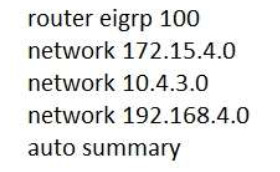
A. 10.0.0.0
B. 10.4.3.0
C. 172.15.4.0
D. 172.15.0.0
E. 192.168.4.0
F. 192.168.0.0
Correct Answer: ADE
QUESTION 674. Which utility can you use to determine whether a switch can send echo requests and replies?
A. ping
B. traceroute
C. ssh
D. telnet
Correct Answer: A
Explanation/Reference:
http://www.cisco.com/c/en/us/support/docs/ios-nx-os-software/ios-software-releases-121-mainline/12778-pingtraceroute.html
QUESTION 675. Which feature is config by setting a variance that is at least 2 times the metric?
A. unequal cost load balancing
B. path selection
C. equal cost load balancing
D. path count
Correct Answer: A
QUESTION 676. Describe the best way to troubleshoot and isolate a network problem?
A. Create an action plan
B. Implement an action plan
C. Gather the facts
D. Change on variable at a time
Correct Answer: A
Explanation/Reference:
http://www.cisco.com/en/US/docs/internetworking/troubleshooting/guide/tr1901.html
QUESTION 677. Under normal operations, cisco recommends that you configure switch ports on which vlan?
A. on the default vlan
B. on the management vlan
C. on the native vlan
D. on any vlan except the default vlan
Correct Answer: A
Explanation/Reference:
http://www.cisco.com/c/en/us/support/docs/switches/catalyst-6500-series-switches/24330-185.html
QUESTION 678. Which DTP switchport mode allow the port to create a trunk port if the the port is in trunk, dynamic auto and dynamic desirable mode?
A. Dynamic Auto
B. Dynamic Desirable
C. Access
D. Trunk
Correct Answer: A
Explanation/Reference:
http://bradhedlund.com/2007/11/27/switchport-configurations-explained/
QUESTION 679. In which byte of an IP packet can traffic be marked ?
A. the QoS byte
B. the CoS byte
C. the ToS byte
D. the DSCP byte
Correct Answer: D
Explanation/Reference:
http://www.cisco.com/c/en/us/support/docs/quality-of-service-qos/qos-packet-marking/10103-dscpvalues.html
QUESTION 680. Which command can you enter to route all traffic that is destined to 192.168.0.0/20 to a specific interface?
A. ip route 192.168.0.0 255.255.240.0 gi 0/1
B. ip route 192.168.0.0 255.255.255.0 gi 0/1
C. ip route 0.0.0.0 0.0.0.0 gi 0/1
D. ip route 0.0.0.0 255.255.255.0 gi 0/1
Correct Answer: A
QUESTION 681. Which two protocol can detect native vlan mismatch errors? (Choose two.)
A. CDP
B. VTP
C. DTP
D. STP
E. PAGP
Correct Answer: AB
QUESTION 682. Which three options are switchport config that can always avoid duplex mismatch error between the switches? (Choose Three)
A. set both side on auto-negotation.
B. set both sides on half-duplex
C. set one side auto and other side half-duplex
D. set both side of connection to full-duplex
E. set one side auto and other side on full-duplex
F. set one side full-duplex and other side half-duplex
Correct Answer: ABD
QUESTION 683. What are two benefits of Private IPv4 Addresses? (Choose two.)
A. they can be implemented without requiring admin to coordinate with IANA
B. they are managed by IANA
C. increase the flexibility of network design
D. provide network isloation from the internet
E. they are routable over internet
Correct Answer: AD
Explanation/Reference:
http://smallbusiness.chron.com/advantages-disadvantages-using-private-ip-address-space-46424.html
QUESTION 684. How many bits represent network id in a IPv6 address?
A. 32
B. 48
C. 64
D. 128
Correct Answer: C
Explanation/Reference:
http://networkengineering.stackexchange.com/QUESTIONs/30836/calculate-networking-bits-for-ipv6
64 bits for Nwtwork ID and 64 bits for Interface ID
64+64=128
QUESTION 685.(An image on exhibit) An interface which we have to determine from the routing the route learned by which routing protocol?
A. EIGRP
B. OSPF
C. RIP
D. BGP
Correct Answer: A
QUESTION 686. How many usable host are there per subnet if you have the address of 192.168.10.0 with a subnet mask of 255.255.255.240?
A. 4
B. 8
C. 16
D. 14
Correct Answer: D
QUESTION 687. What interconnection cable can you use when you use a MDI connection?
A. cut-through
B. straight-through
C. crossover
D. rollover
Correct Answer: C
Download PDF:
https://drive.google.com/file/d/0B5dAW5uMiHtiSlM4bmcwcnBBYm8/view?usp=sharing

Hi Guys, It would be great if somebody can answer my questions.
Is this a real exam questions and answers for ccna ?
I am looking for ICND1 final exam question answer. If anybody has that please comment it here.
Thanks in advance
Have u a quiz for ccent ? and thank you , if not , how could you help me to well revise for the exam
These are all answers for ccna certification ??
do you have the latest one that I can study
Can you upload this in a file like pfd please?
Thank you for posting this!!! Lots to study wish me luck! :)
q6 > isnt’t D the answer, and not A? arp -a on a host computer doesen’t return IPs from another network, just local, multicast, broadcast.
Question 537
B is the correct answer, not A. Default configuration suggests there is no other vlan but vlan1 configured. So both ends are on the same broadcast domain.
The switch doesn’t need to have ip routing enabled because it’s the default configuration. Not to mention it never said it was a L3 Switch
Question 330
C and D are the correct answers. SSH provides encryption unlike telnet with the clear text connection. SSH operates at the Session Layer in the OSI model not the Transport Layer.
Question 517
Same as 553, correct is B not A. Distance Vector use hop count, not link state.
Fixed, thanks u :)
Question 553
Correct answer is B not A. Distance Vector use hop count, not link state.
Lots of graphics are missing, may you fix that?
Thank you